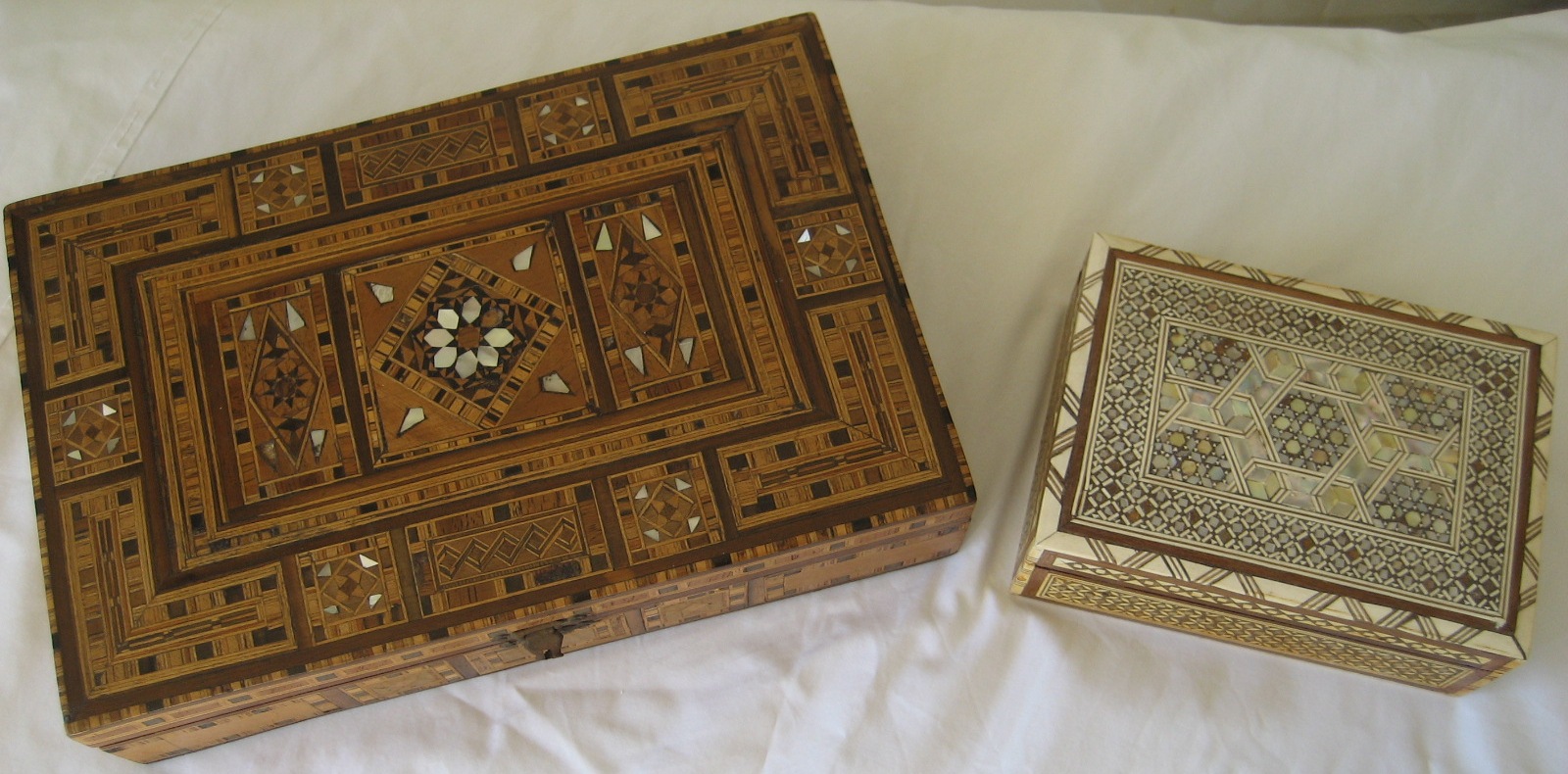Rafael Tufiño is one of the central figures in the history of
20th Century Puerto Rican art. A versatile artist in many
media, Tufiño has been a major force in
founding and
furthering modern Puerto Rican art, both on the island and
in the Caribbean diaspora. The painting below is a large drawing (20 in. by
24 in.) of one of his former wives with her cat made in 1967.
It is inscribed “A mi querido amigo Jean-Claude G. Zamor en
muestra de
nuestra
larga amistad. Rafael Tufiñ0”.
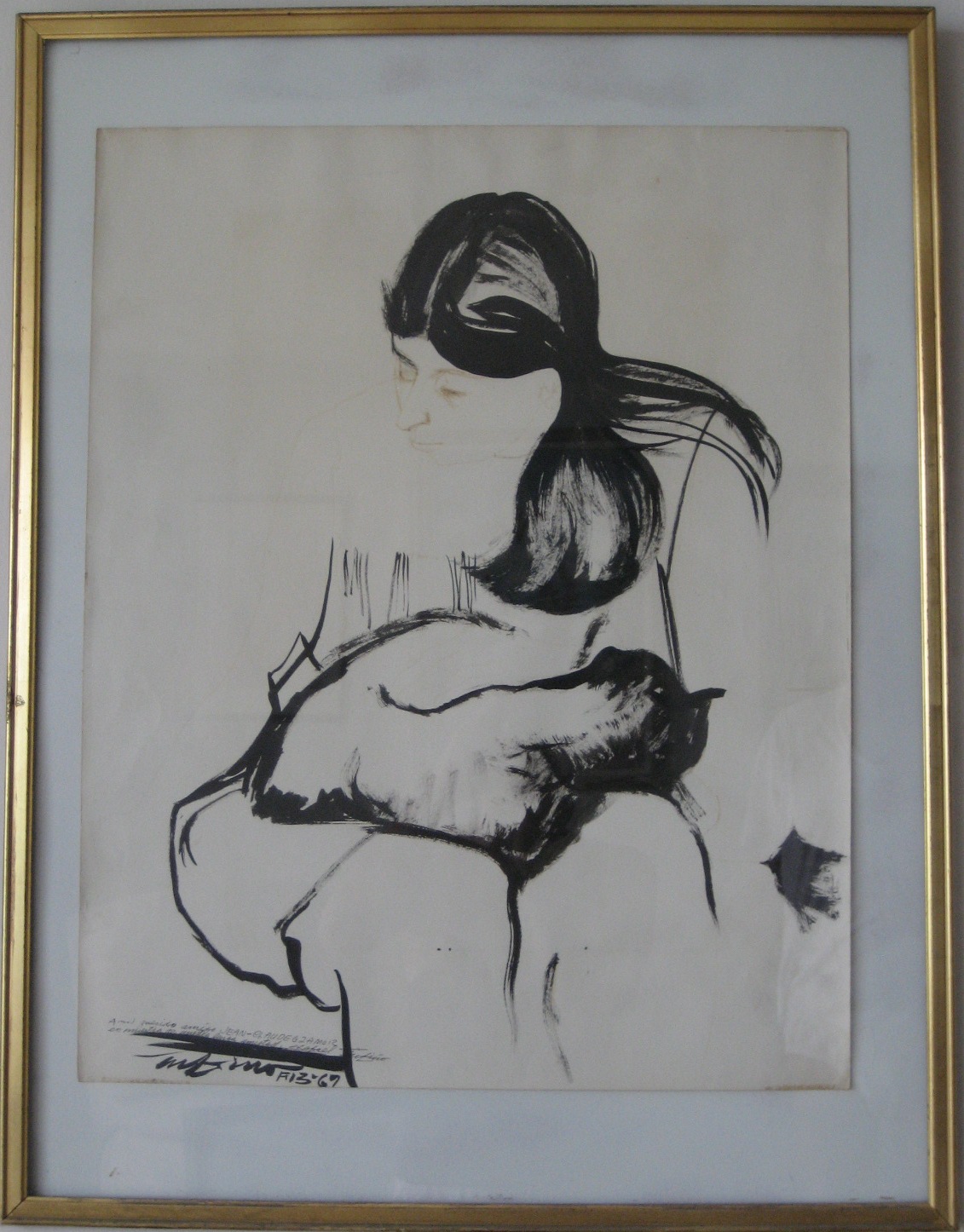
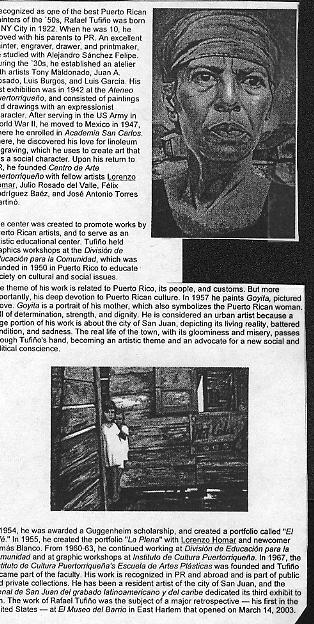
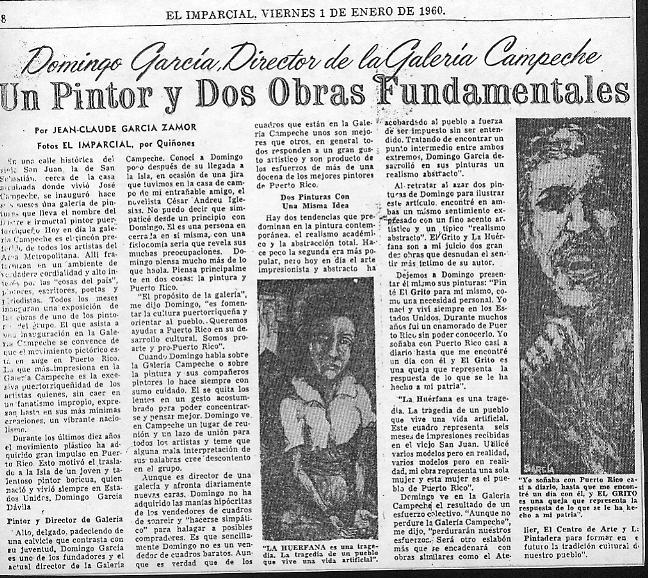
The four paintings below are from
an outstanding Puerto Rican artist, Espiñeira. Tempera, 8 in. X 24 in.
each.
They were made in 1948.
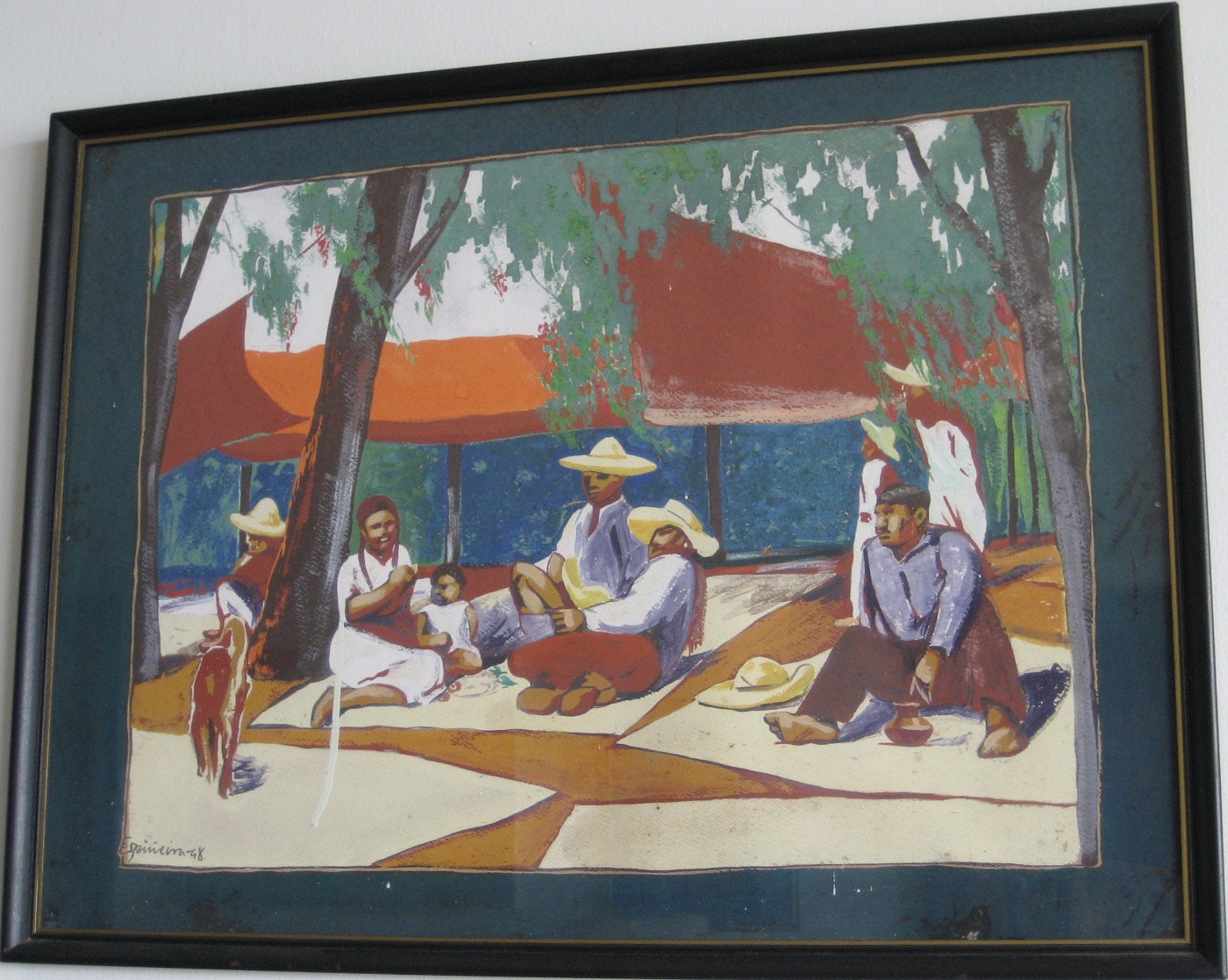
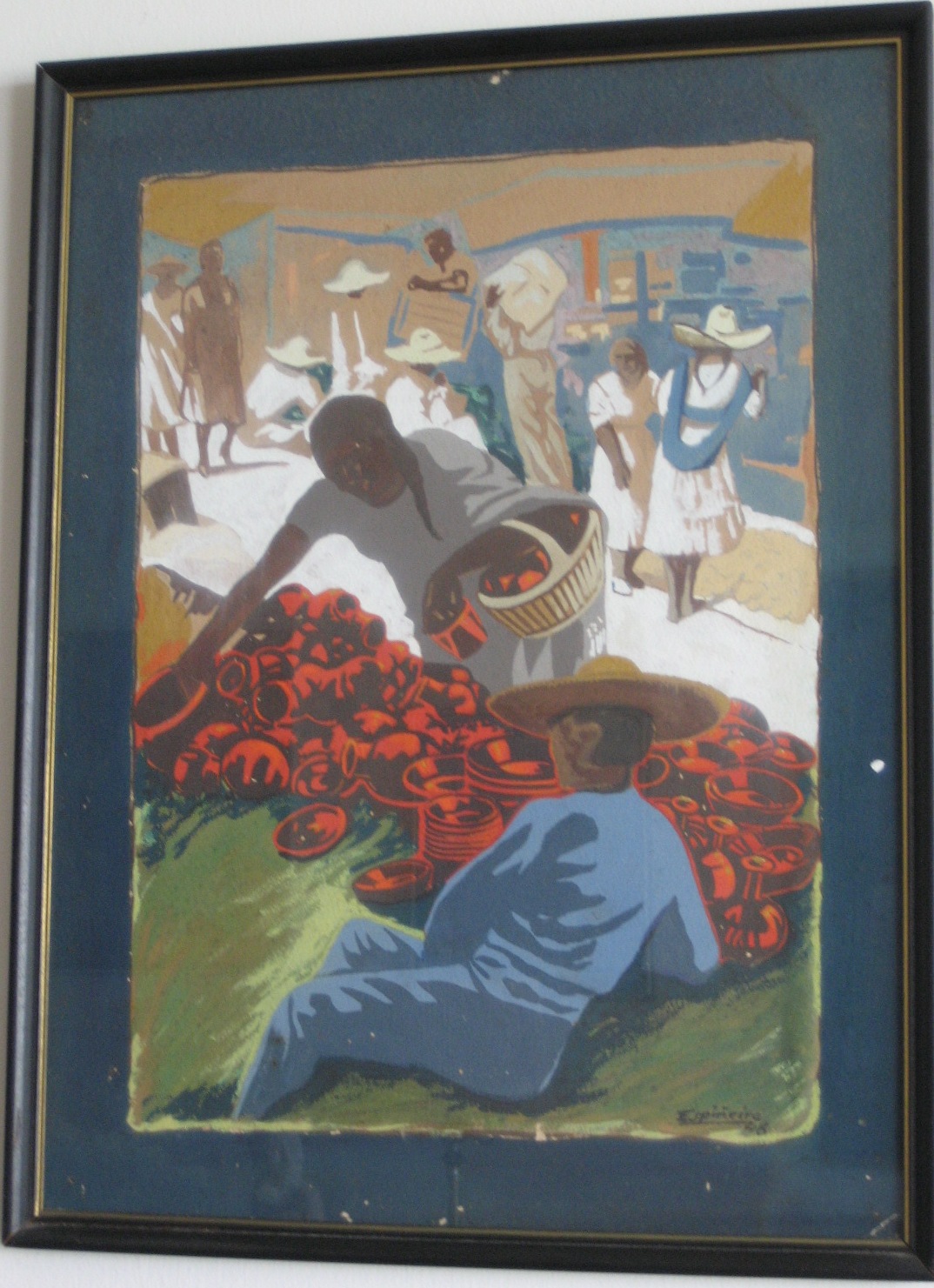
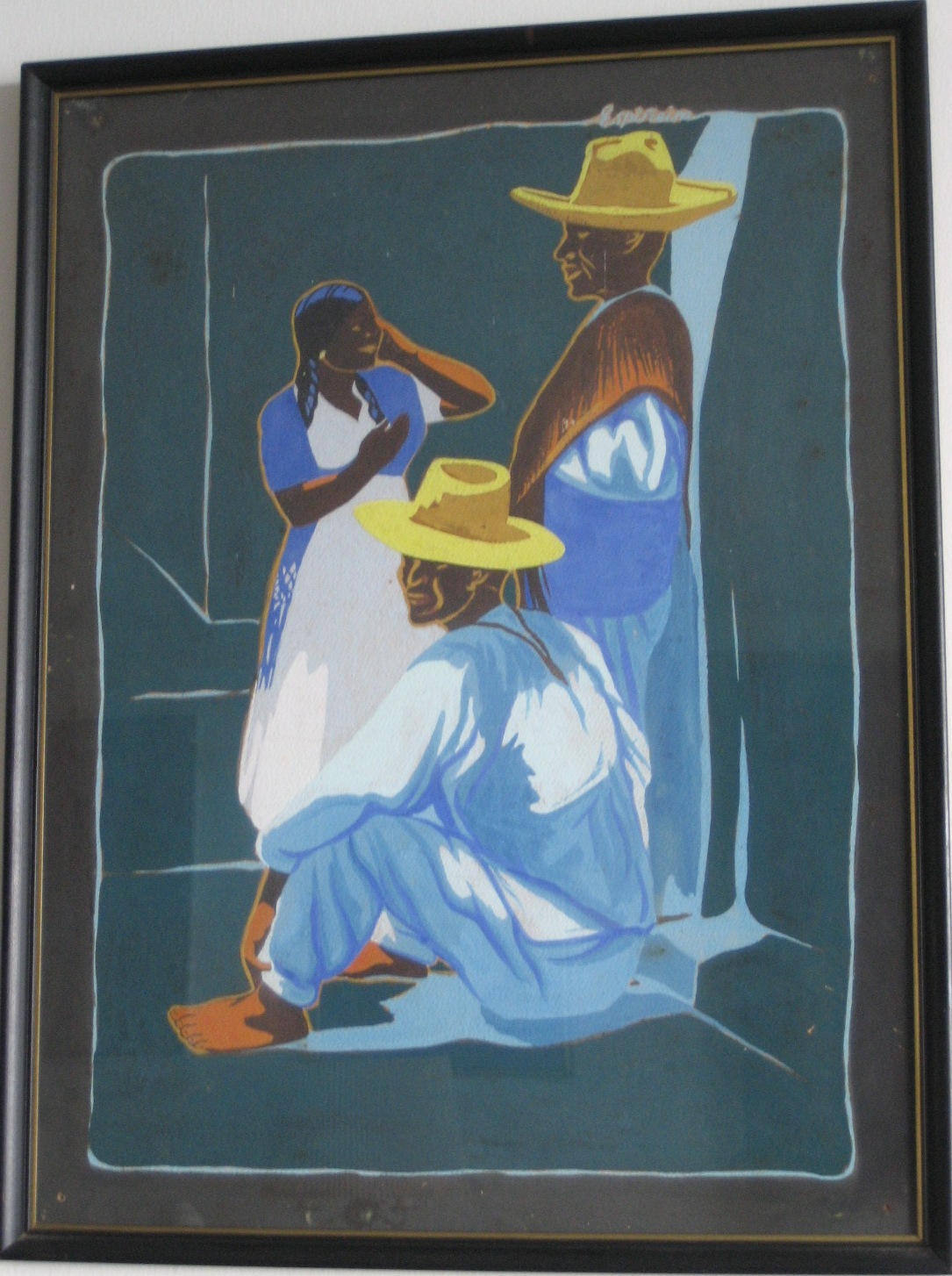
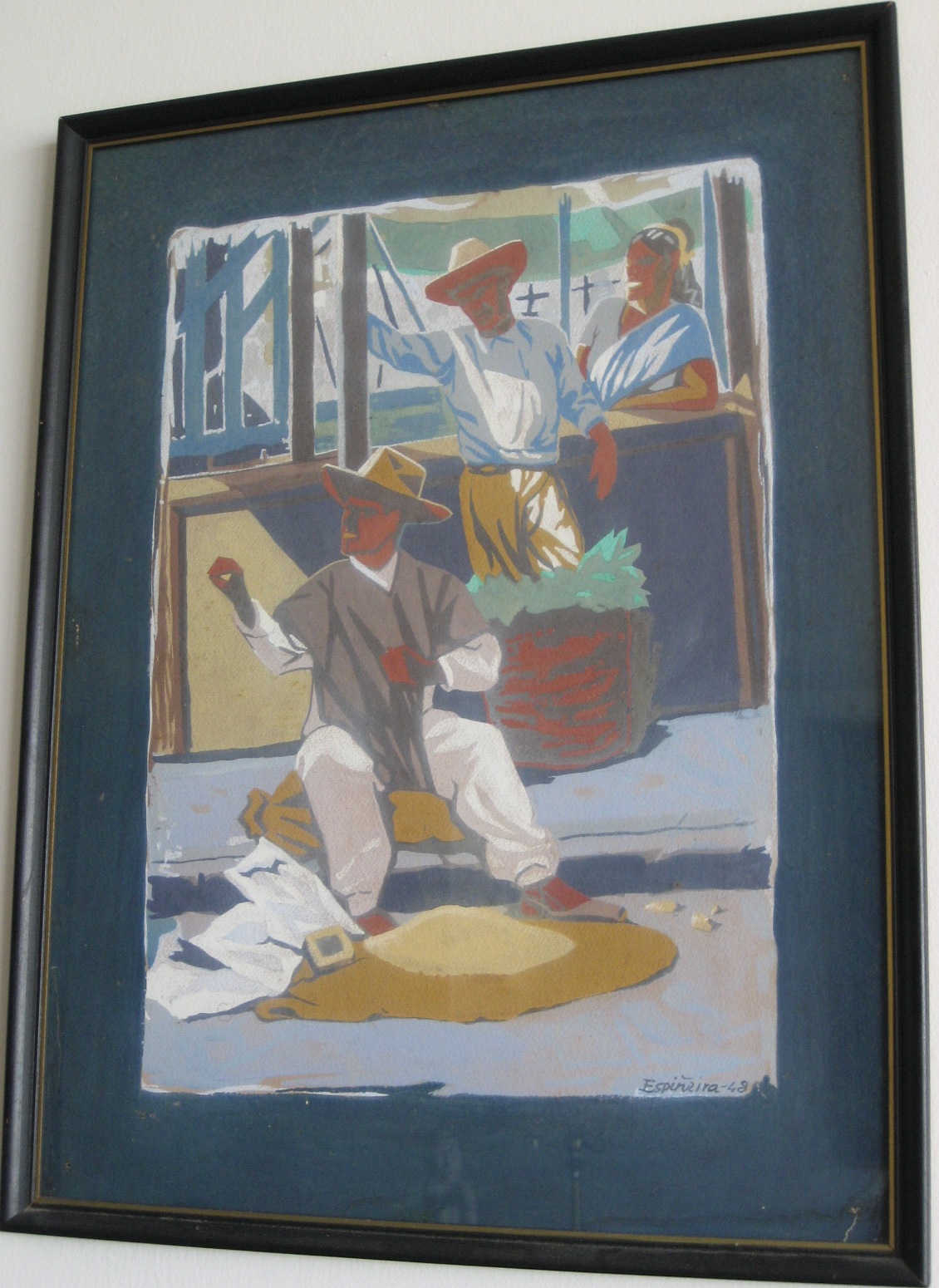
CARLOS PEROT, oil on canvas painted in 1971, 18
in. by 24 in (below). He has been recognized as one of the best sea-scape
painter of Chile (see article below). He died in 2002.
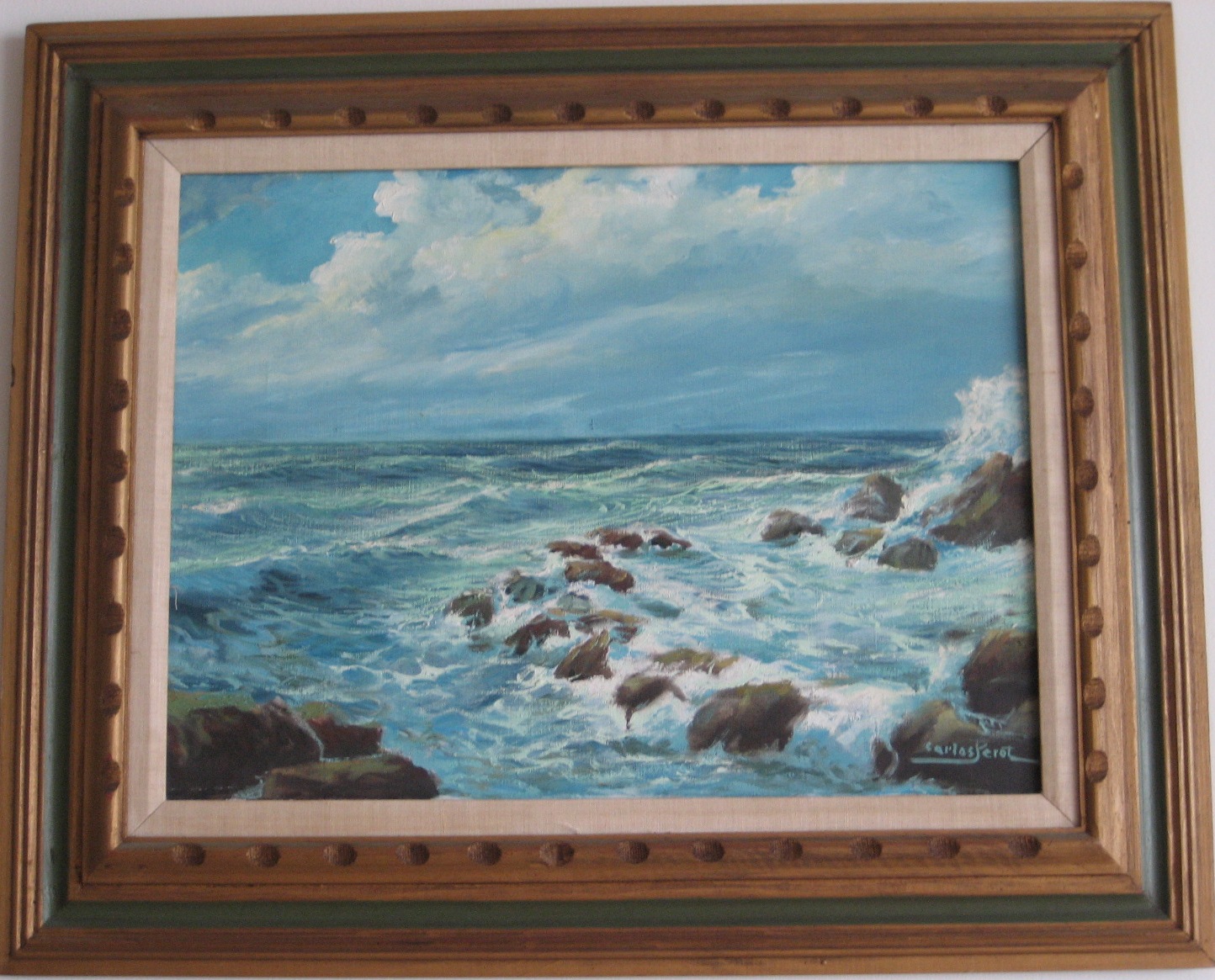
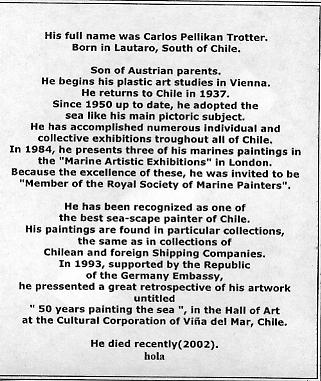
LOBOS A. FARO, an outstanding artist from Chile.
Oil on canvas painted in 1971, 20 in. by 28 in. (below)

The following is a watercolor by an artist from Peru,
made in 1974 , 8 ½ in. by 11 in. Bought in Mexico in 1979.
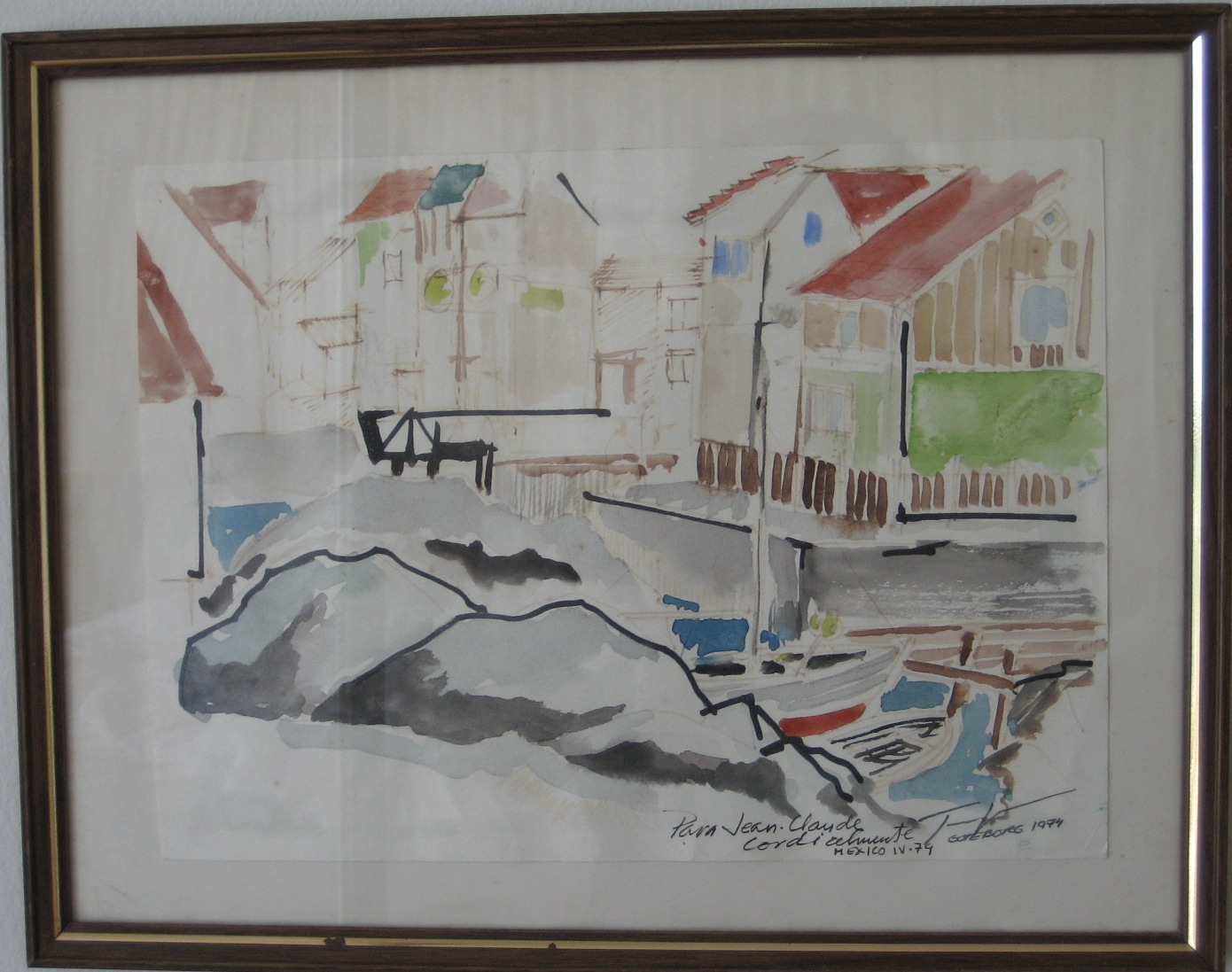
LLOYD van
PITTERSON, Jamaican artist, oil on canvas, 20 in. by 24 in., painted in
1970 (see painting below). Van Pitterson became famous when Nelson Rockefeller, then Vice
President of the United States, an avid collector of Latin American and
Caribbean art, visited Jamaica in the 1960s and bought one of his
paintings for his collection.
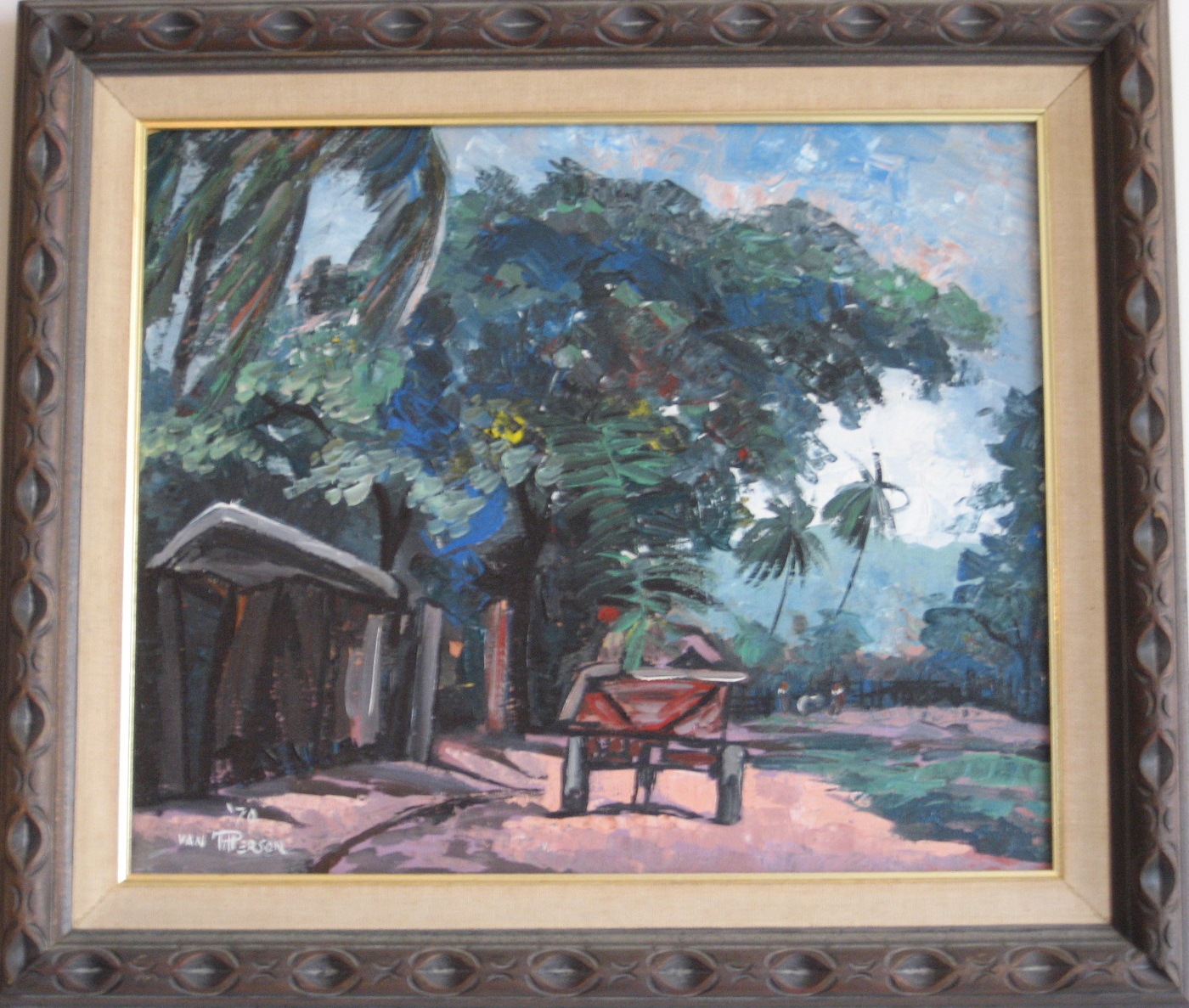
These following two outstanding paintings were purchased
in van Pitterson’s art gallery in Kingston, Jamaica, in the mid-1970s.
van Pitterson helped me select them.
The first is a large (24 in. by 36 in.)oil on
canvas by Reynolds. The second is a small (8 in. by 10 in.) oil on
canvas by Noel.
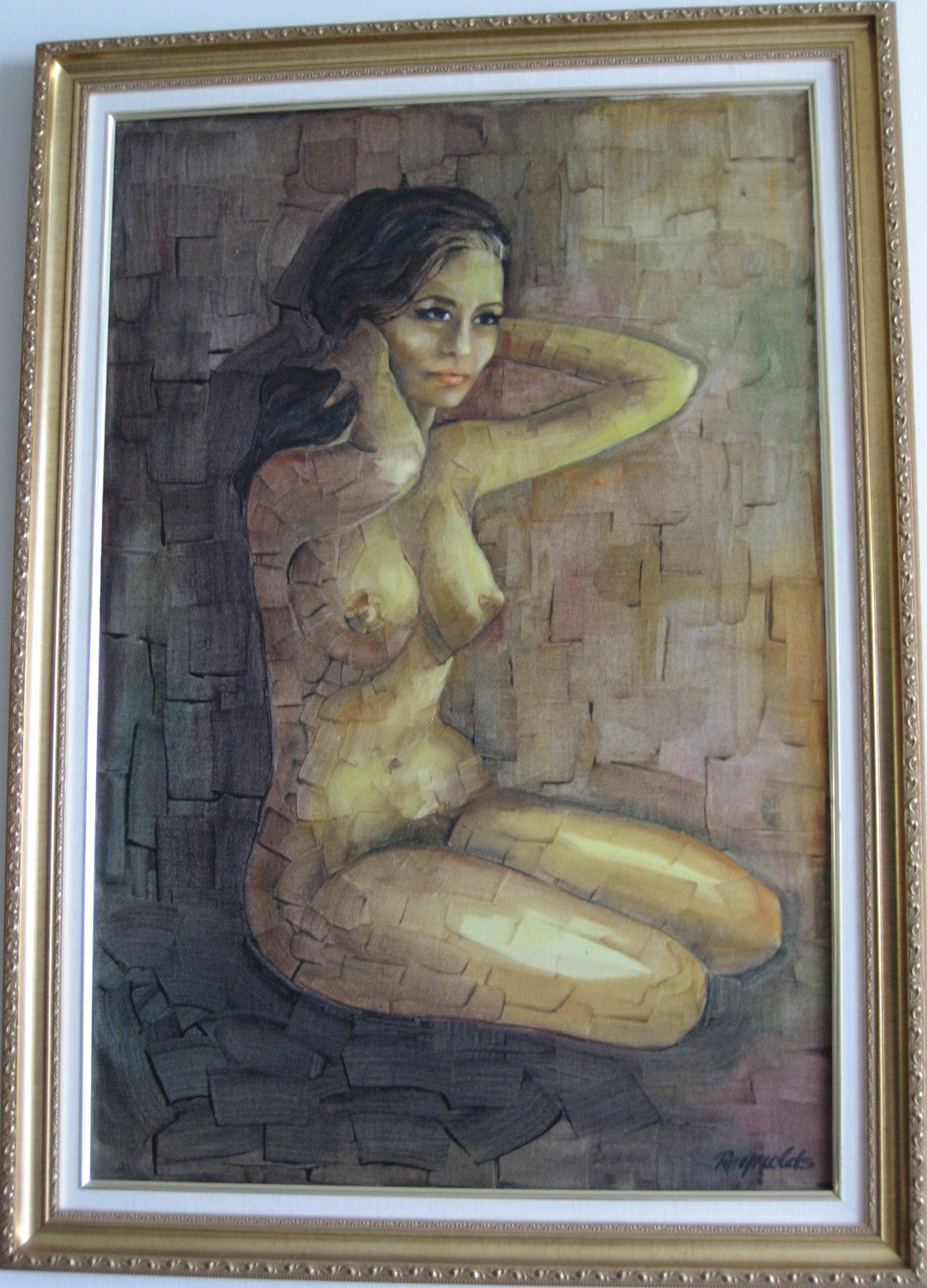
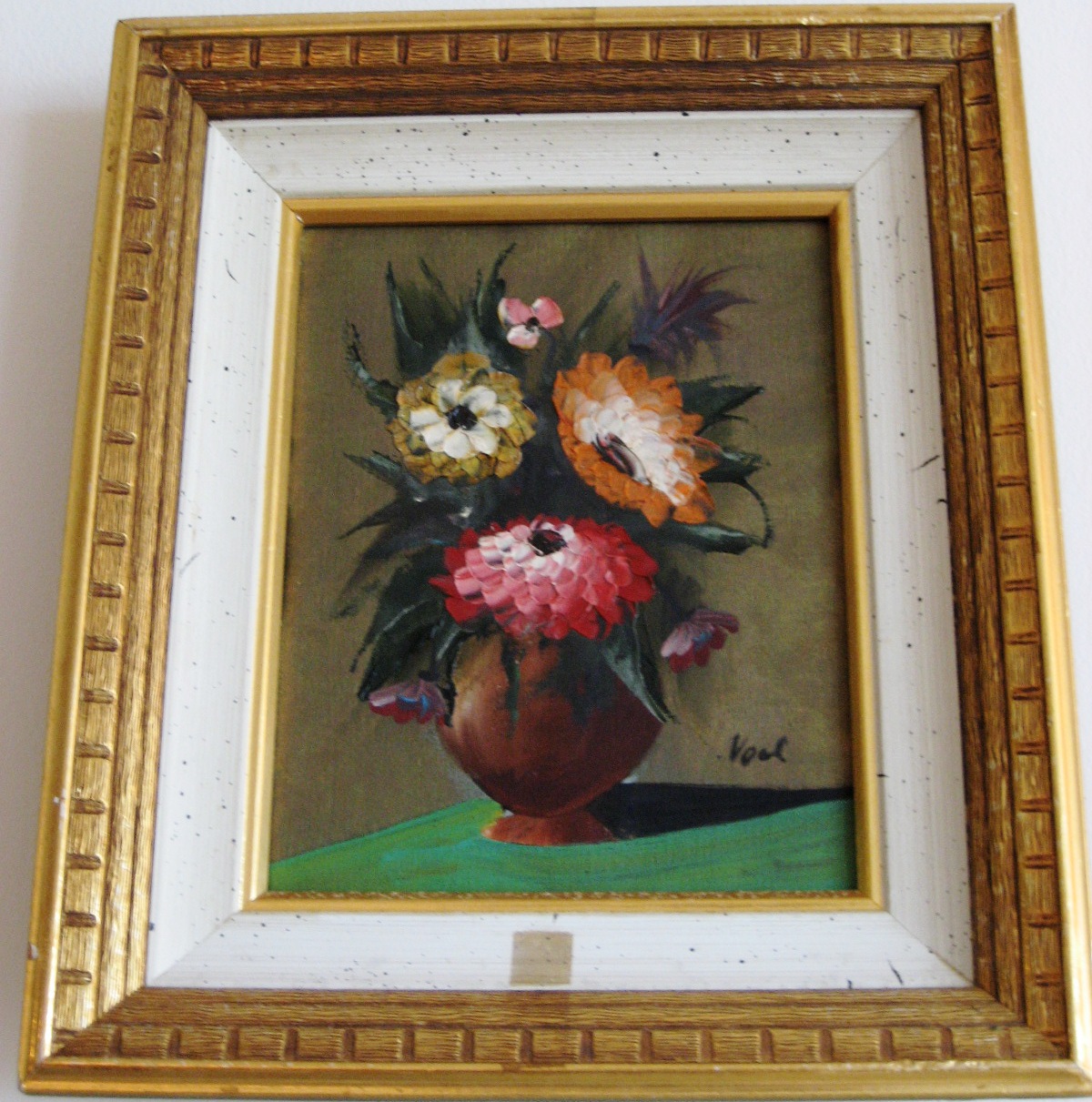
The following painting is by Brazilian artist
VICENTE CARNEIRO, oil on canvas, 20 in. by 24 in. Painted in the late
1960s. I bought it in the 1970s in Washington, D.C.
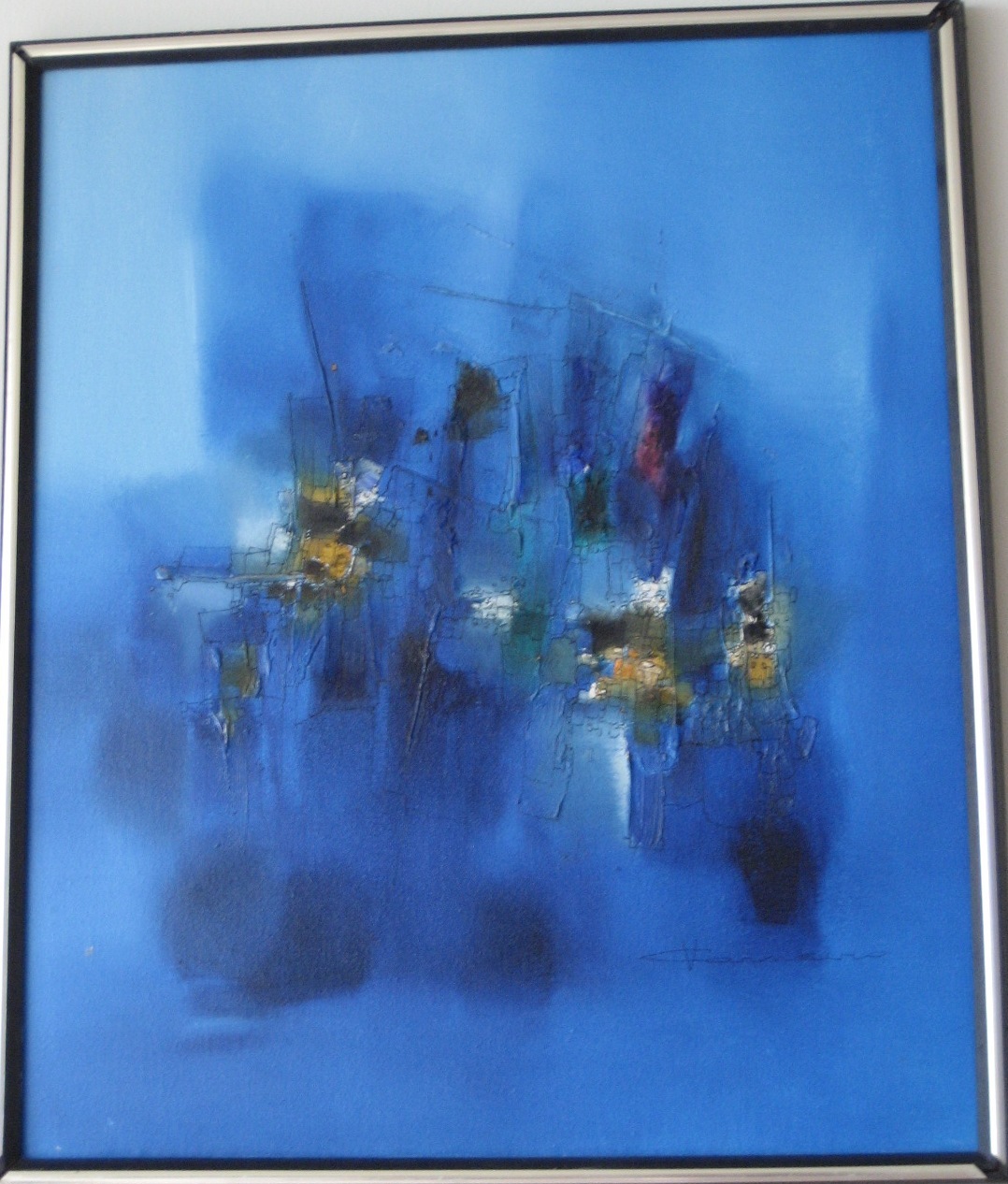
Of the following two paintings, the one on the
left is
an extraordinary 20 in. by 24 in. oil on burlap by a Brazilian painter
shows life in one of Rio de Janeiro’s slums (favelas). It was
painted in 1985.
The second painting is by Brazilian artist
Danubic, woodcut, 10 in. by 20 in. This remarkable work was presented
to me by staff members of the newspaper Jornal do Brazil, in Rio
de Janeiro after I spent two years in Rio with a post-doctoral
Fellowship funded by Ford Foundation.
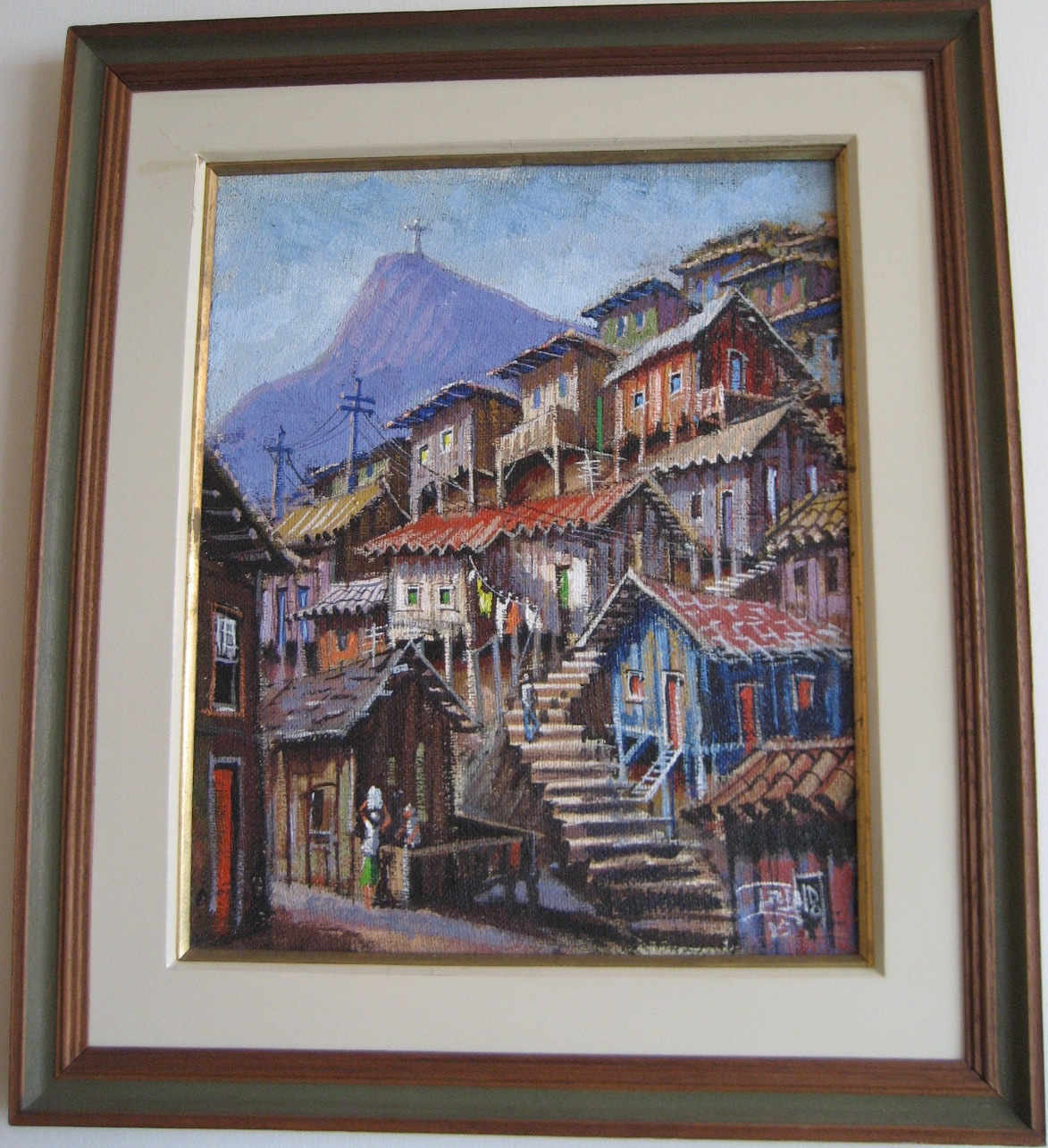
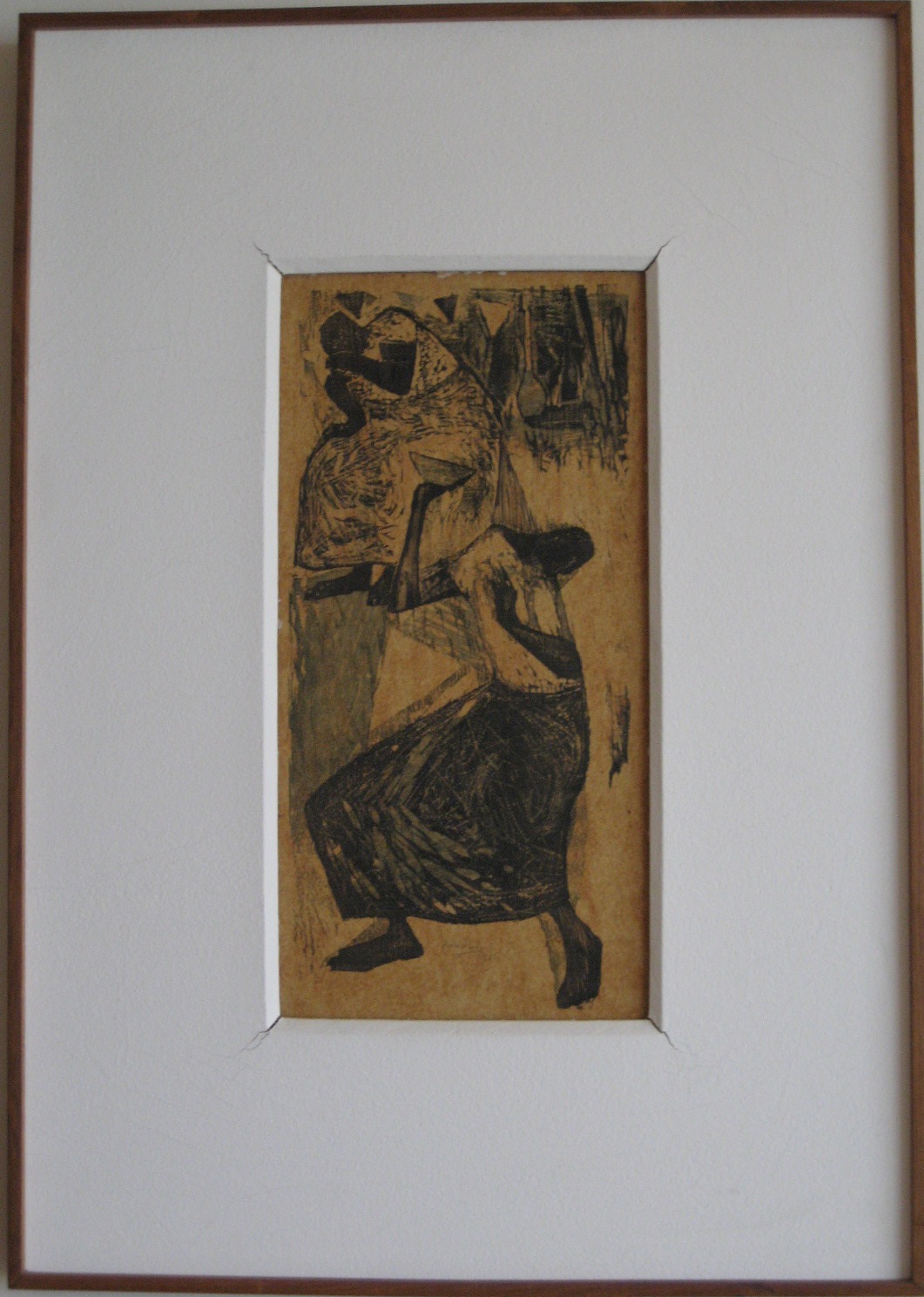
Below are three “Ink on paper” by a Brazilian artist, 18
in. by 24 in. each. They were made in 1969.

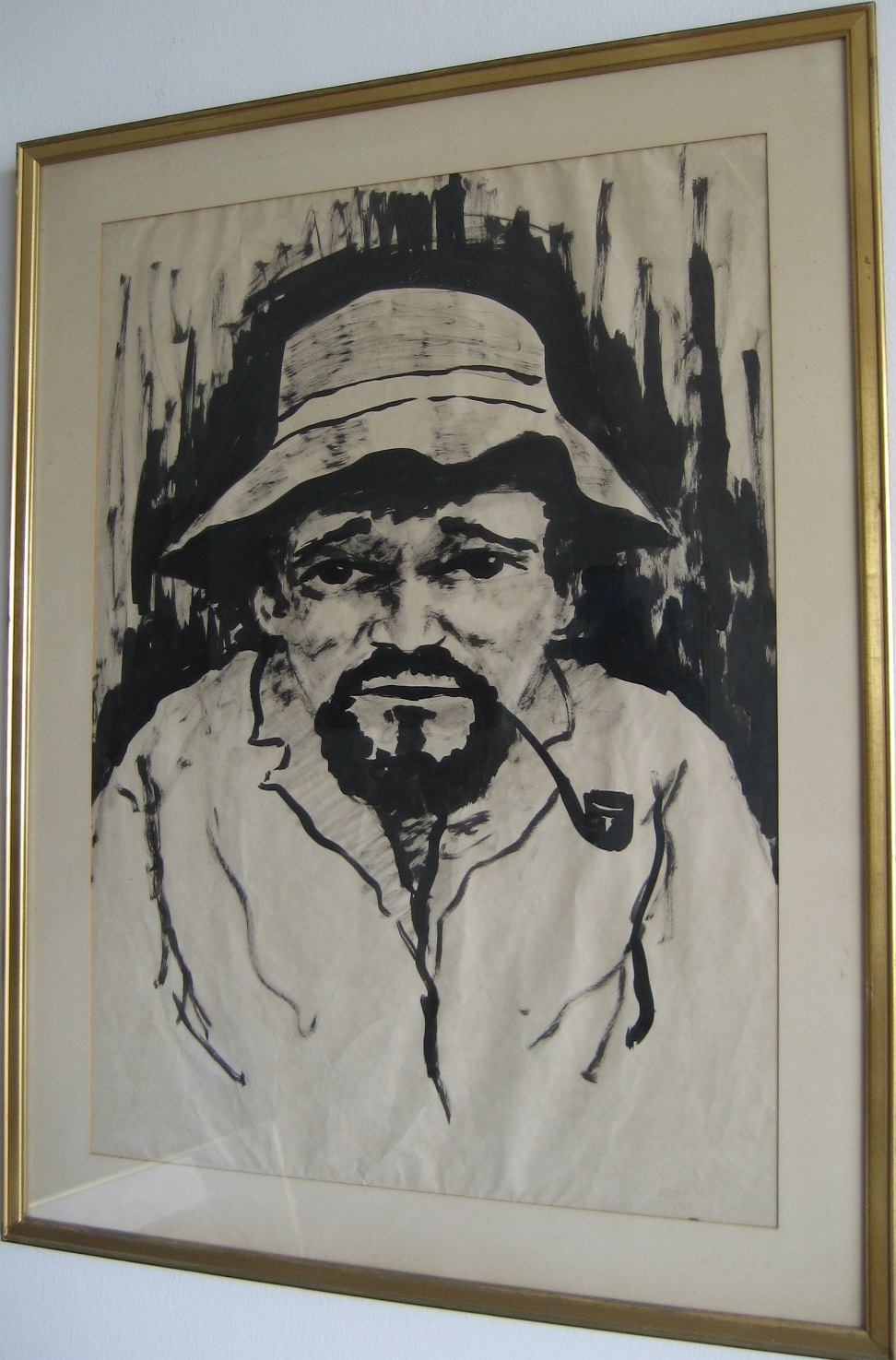
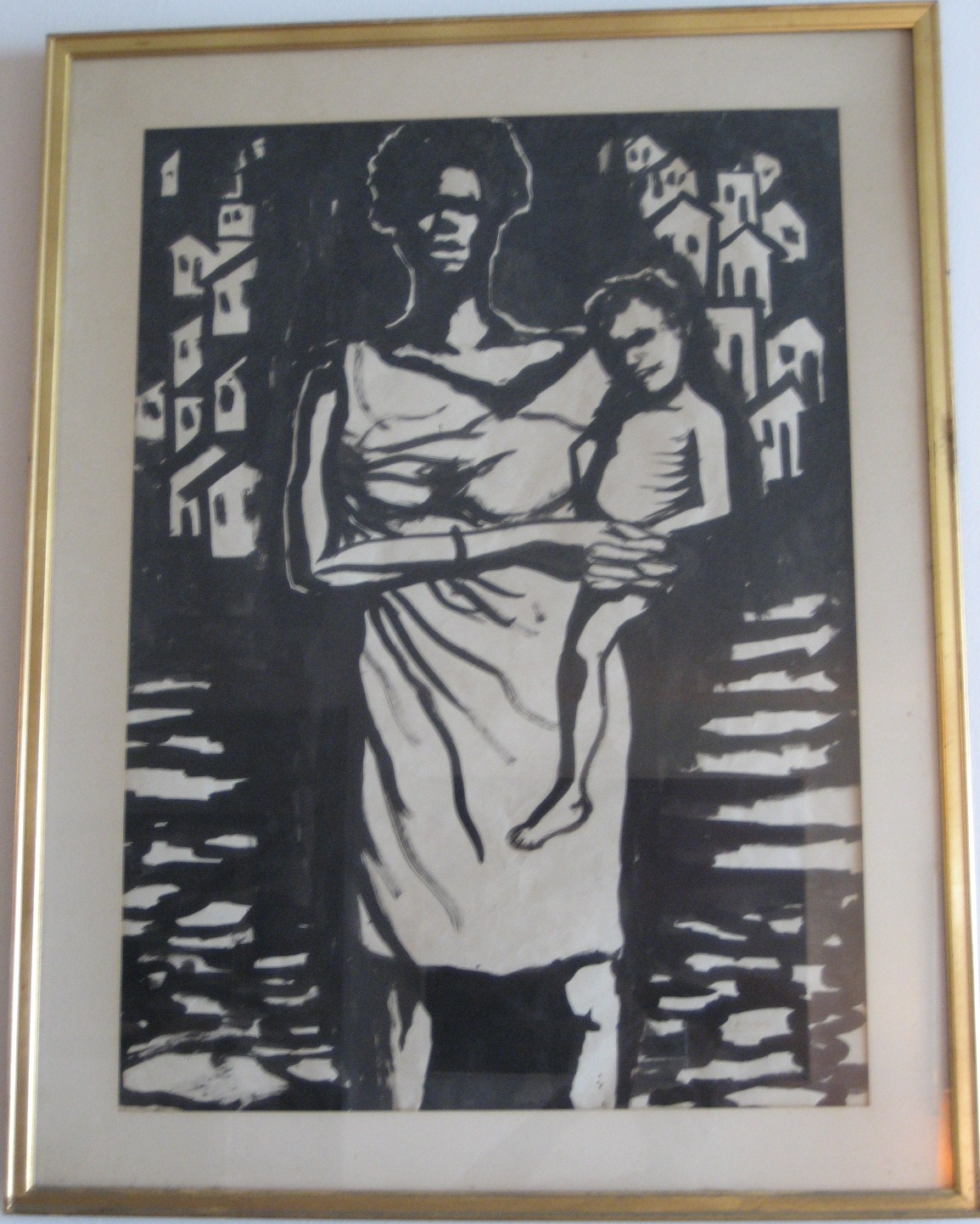
CLAUDIA LEIGUARDA, artist from Argentina,
lithograph A/P (artist proof). 10 in. by 18 in., 1973 (below). It was bought in
Washington D.C. at a show by the artist at the Inter-American
Development Bank.
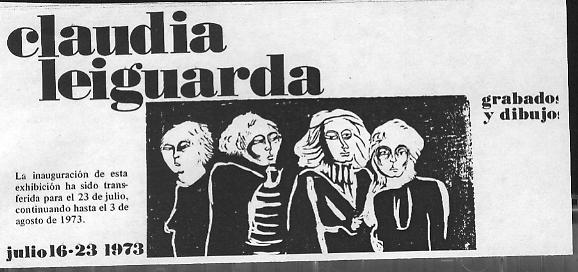
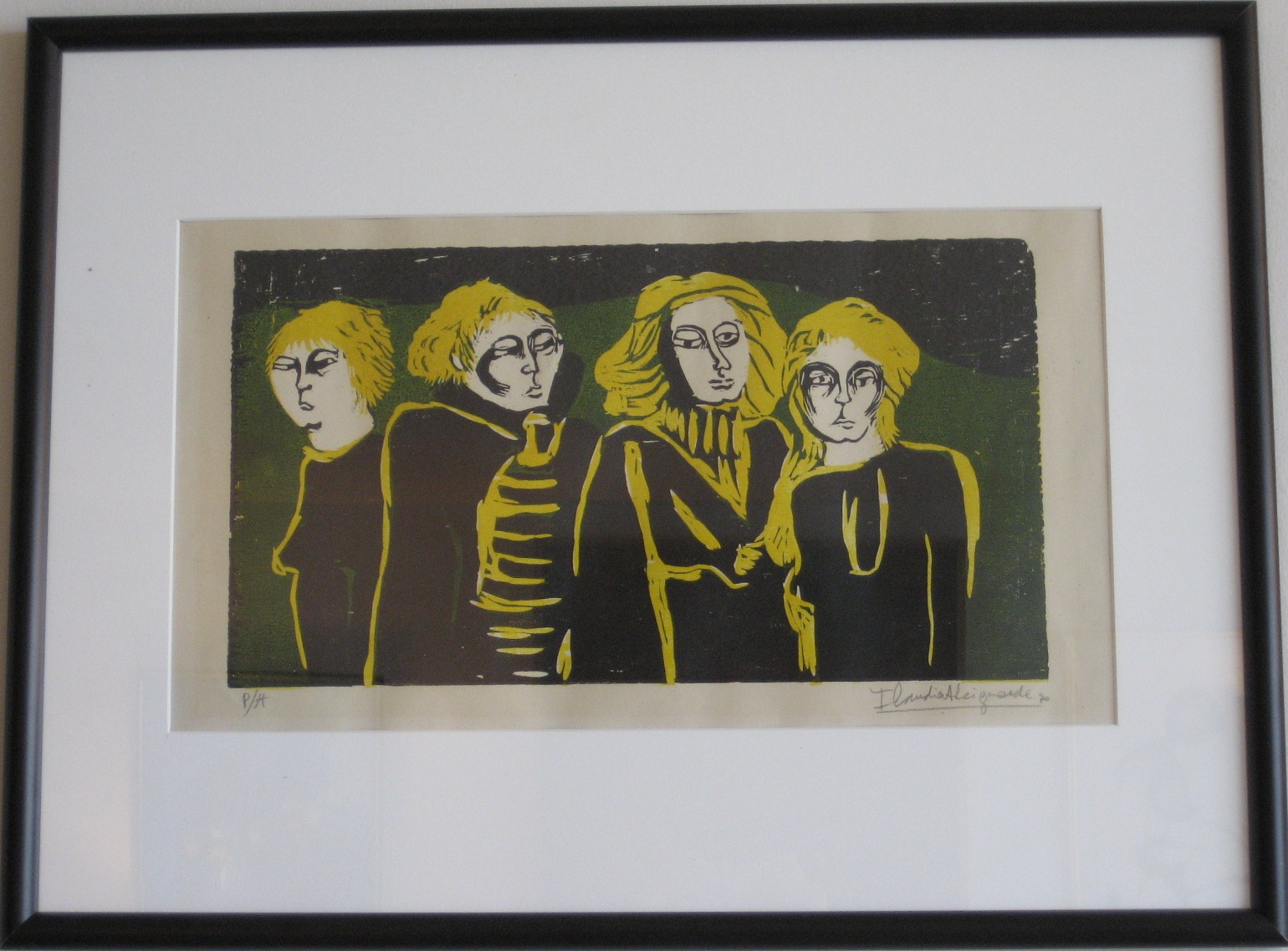
Paintings from Bolivia
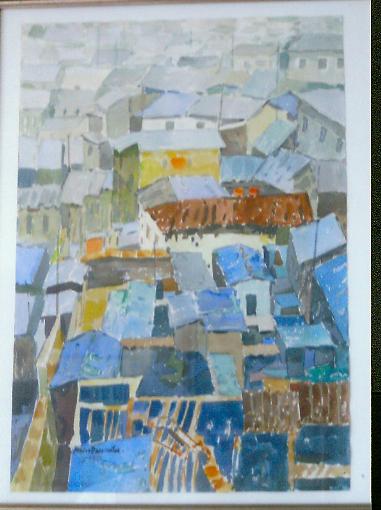
The water color above is from well-known
Bolivian painter Mhiro Barrientos, 15 in. by 22 in., 1972.
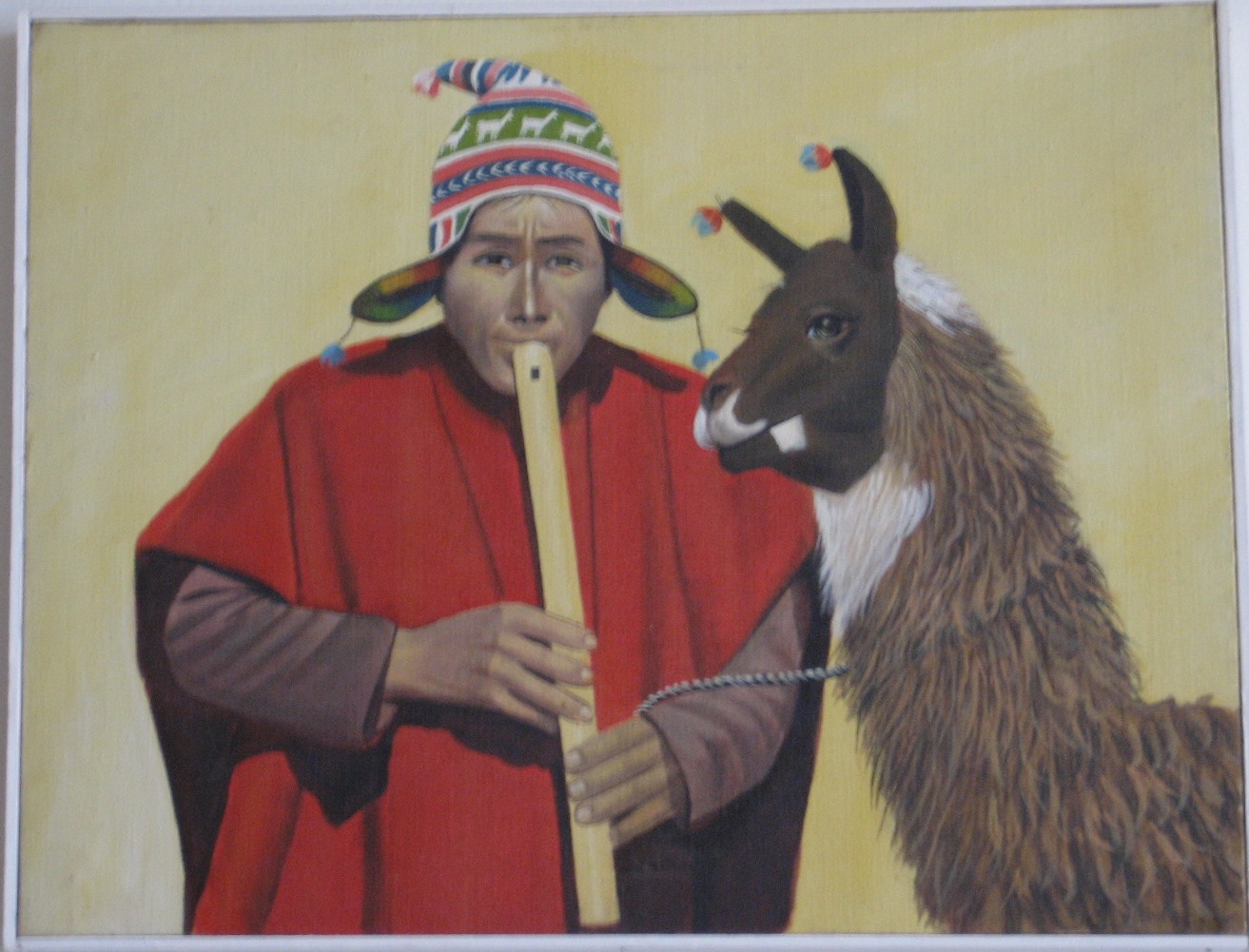
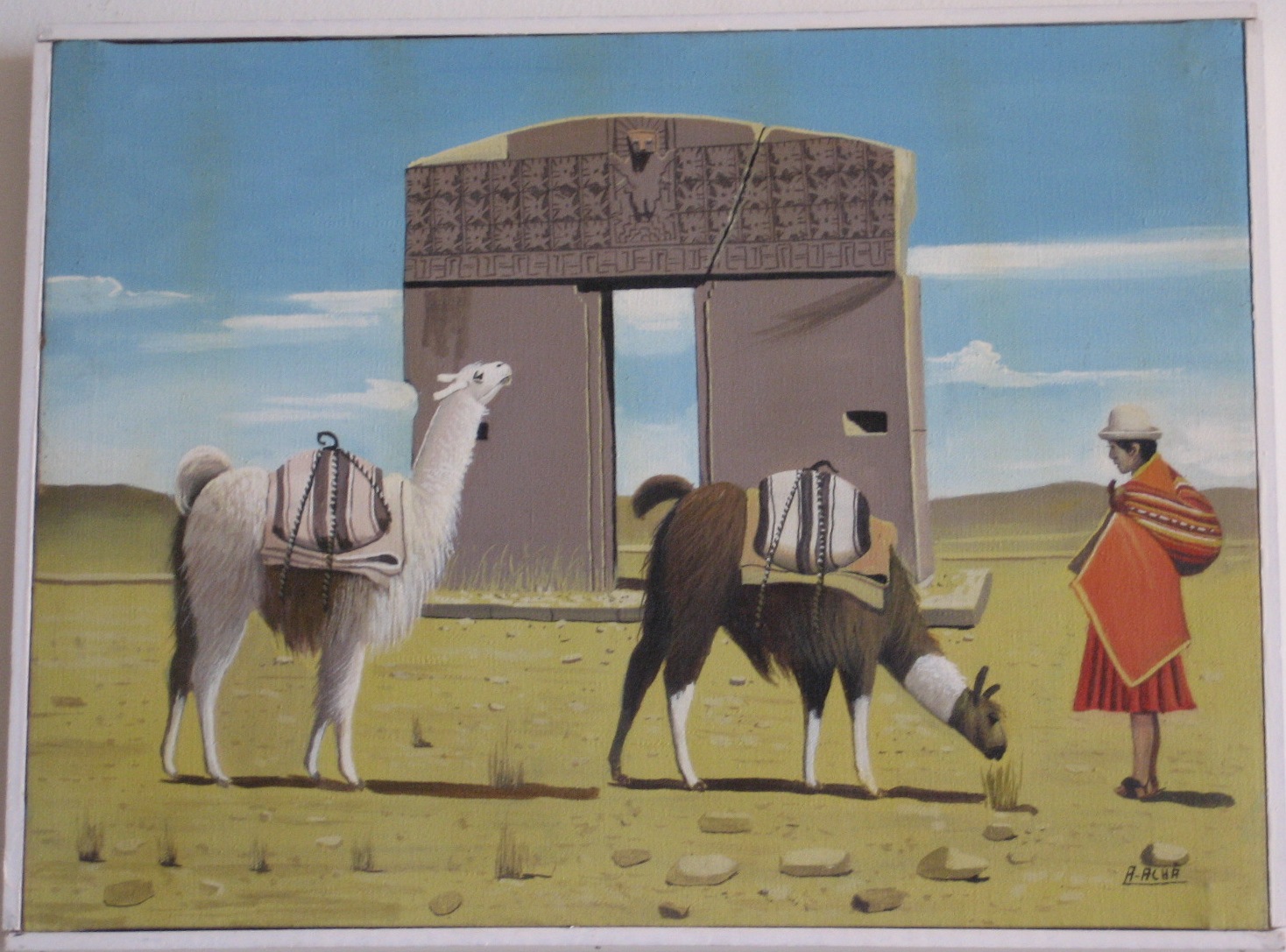
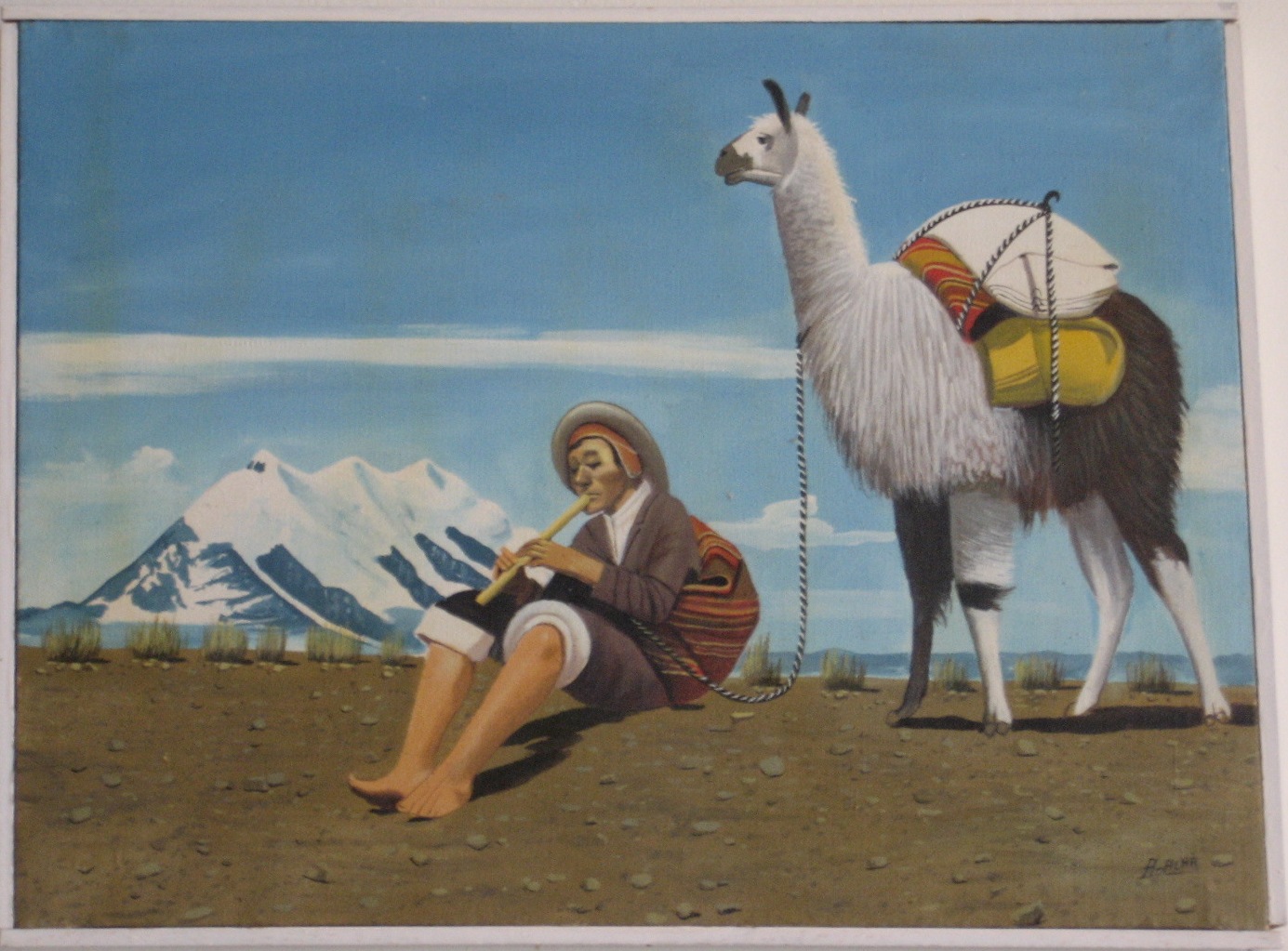
The three paintings above are from Bolivian
painter A. Acha. Oil on canvas, each measures 14 in. by 18 in., 1973.
Paintings from Honduras

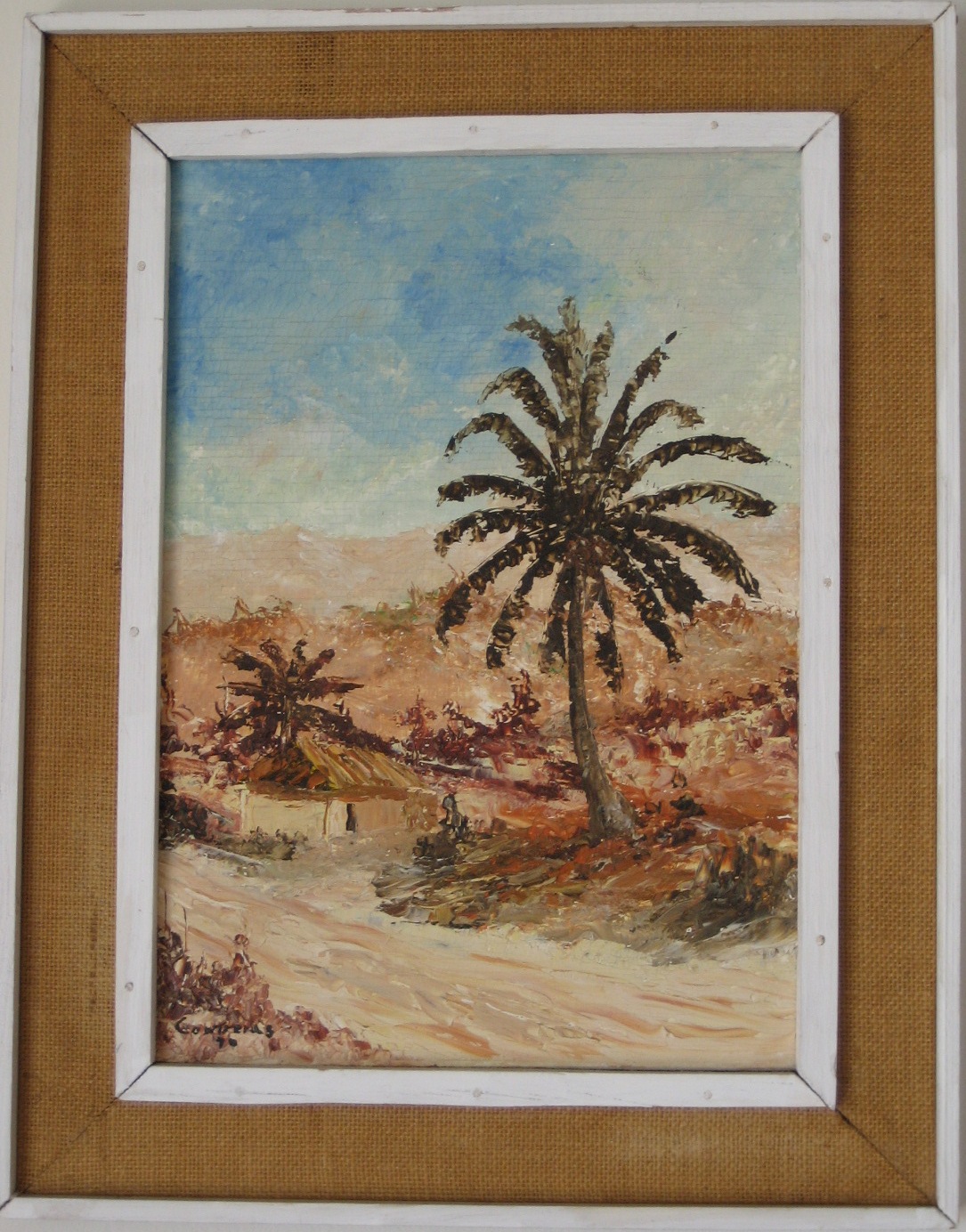
Of the above paintings, the one on the left is from
the artist Sergio Almendares. Oil on canvas, 18 in. by 24 in, 1972.The
painting on the right is from Contreras. Oil on wood, 8 ½ in. by 12 in.,
1970.
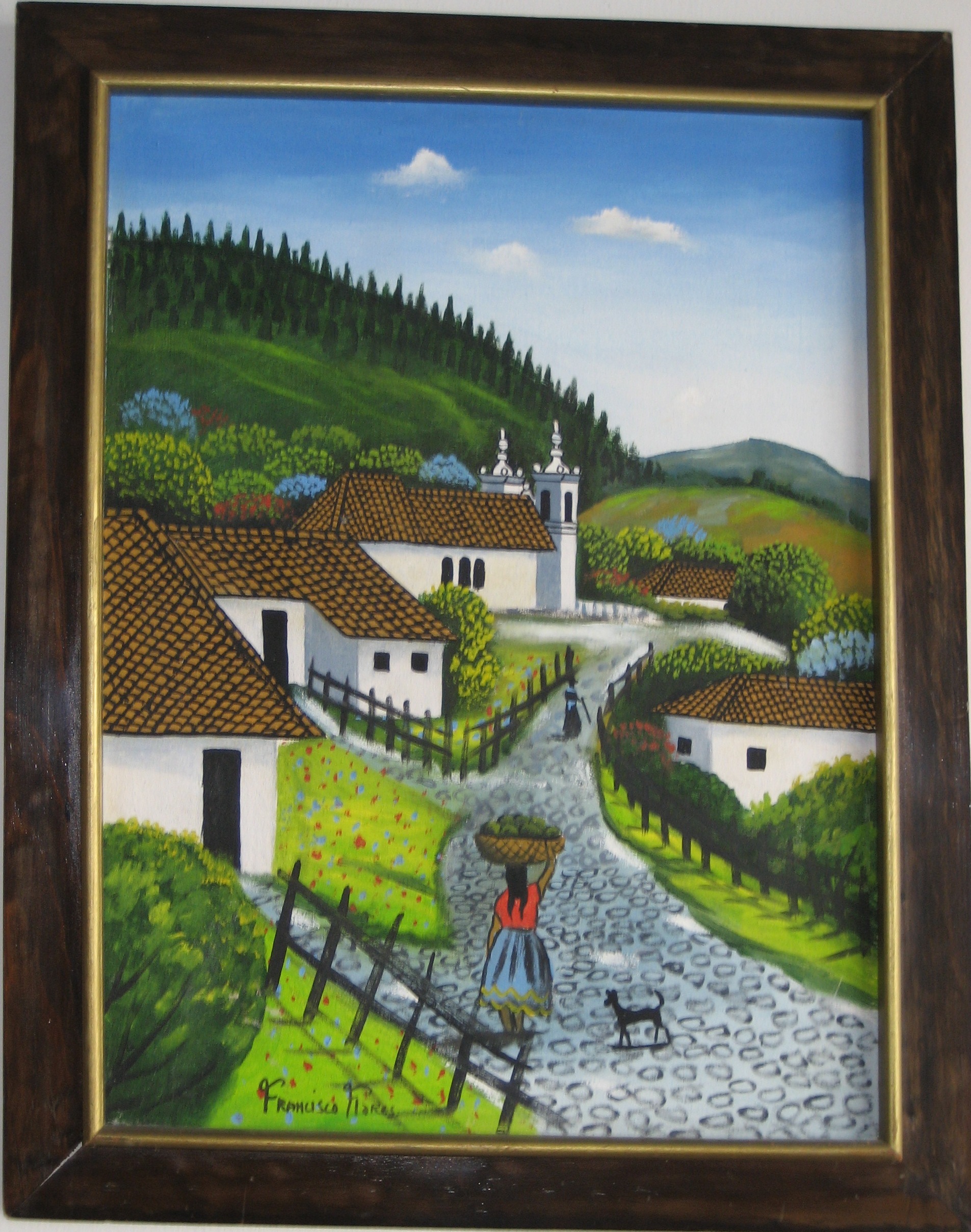

The
paintings above are by Francisco Flores, Oil on canvas, 18 in. by 24 in,
mid-1960s. The style of this painting originated in the 1960s with
famous Honduran artist José Antonio Velasquez. All of Velasquez painting
show a church, typical tile roofs, and a cat. He had a lots of imitators
and Francisco Flores was one of them.
Paintings by
Claude Dambreville
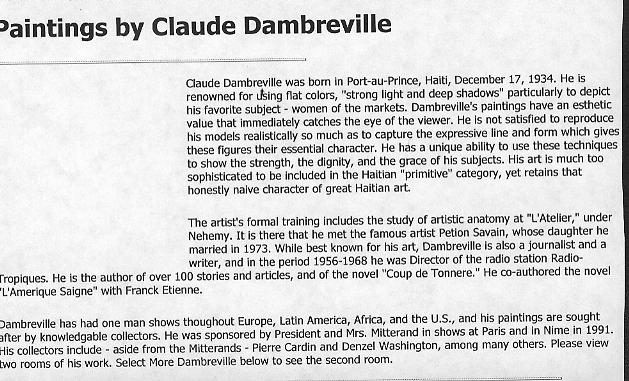
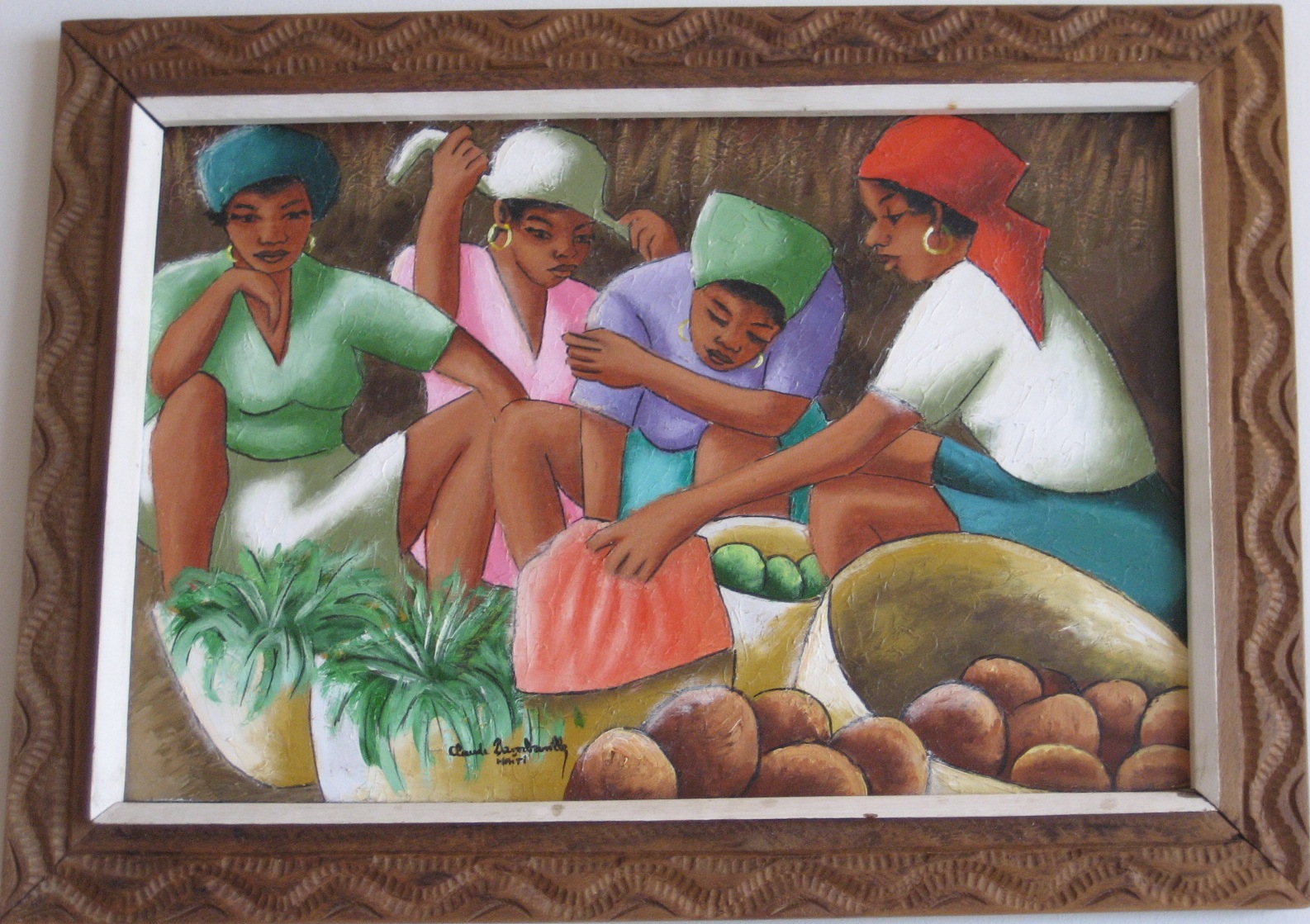
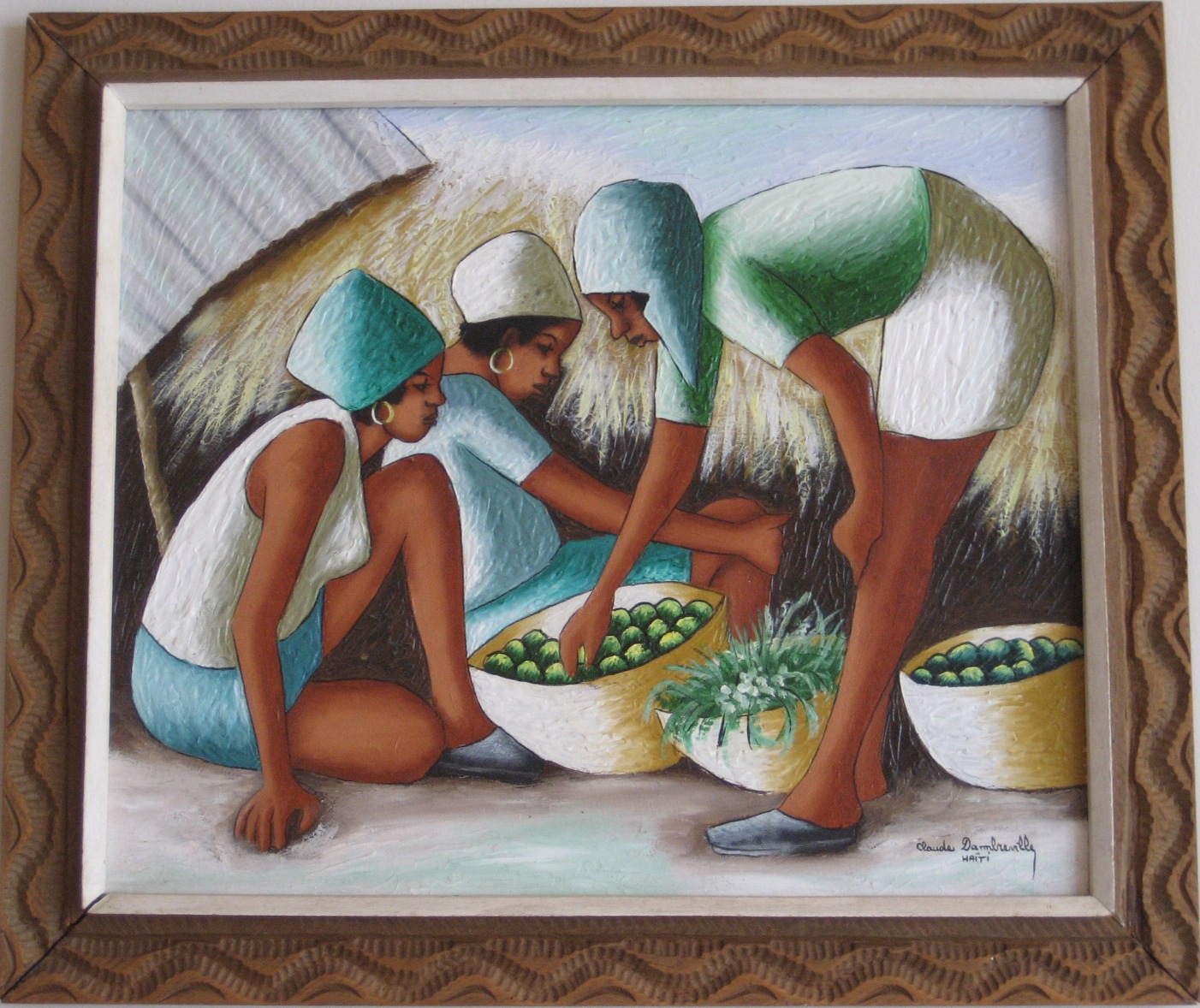
16 in. by 24 in., oil on canvas (1970s)
20 in. by 24 in., oil on canvas (1970s)
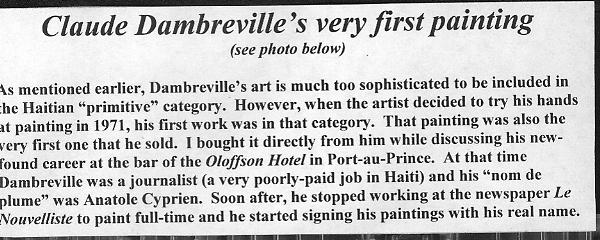
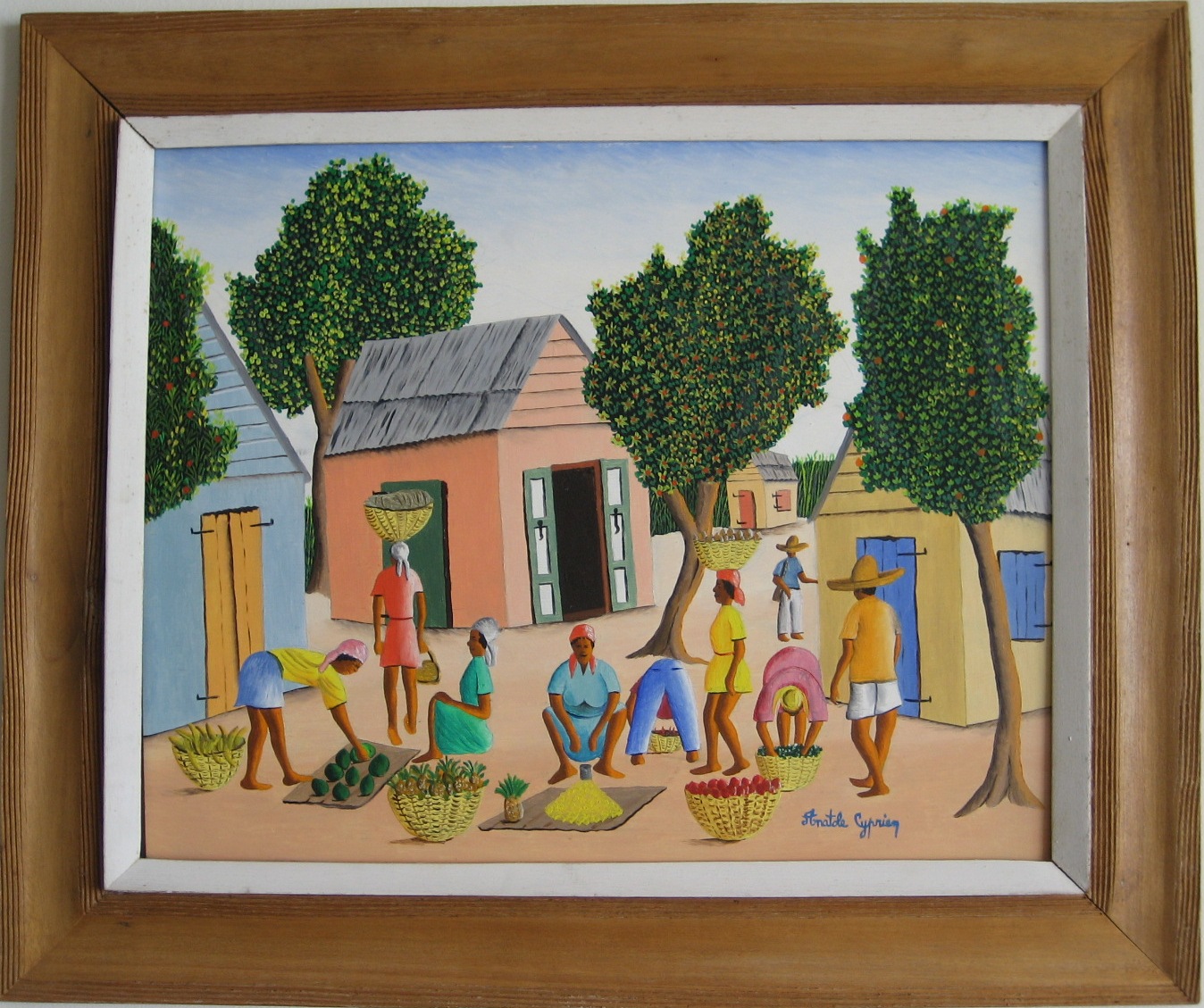
CLAUDE DAMBREVILLE (alias Anatole Cyprien), 16 in. by 20 in., oil on
wood (1971)
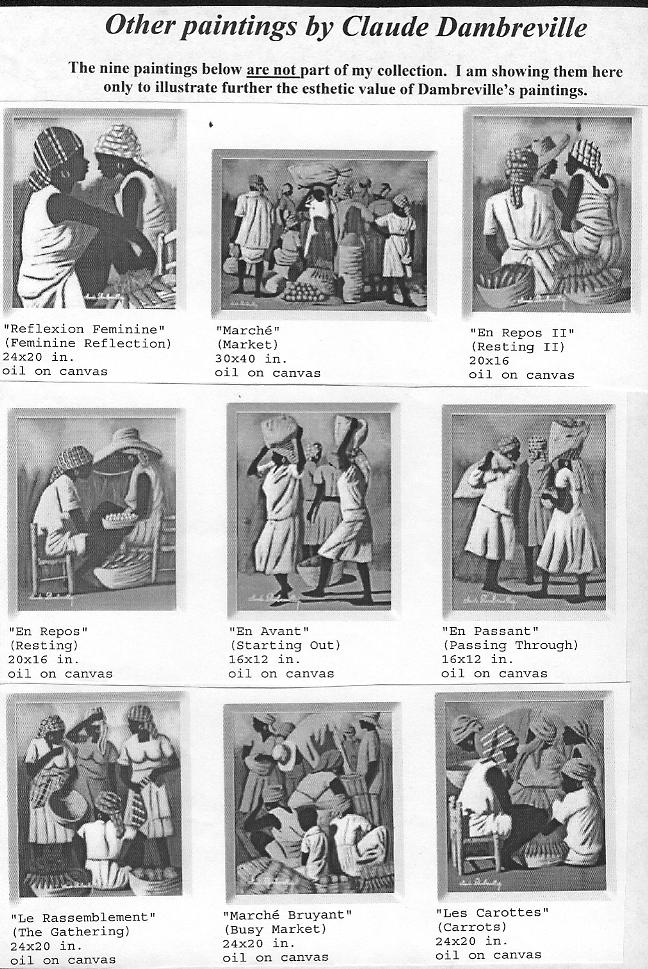
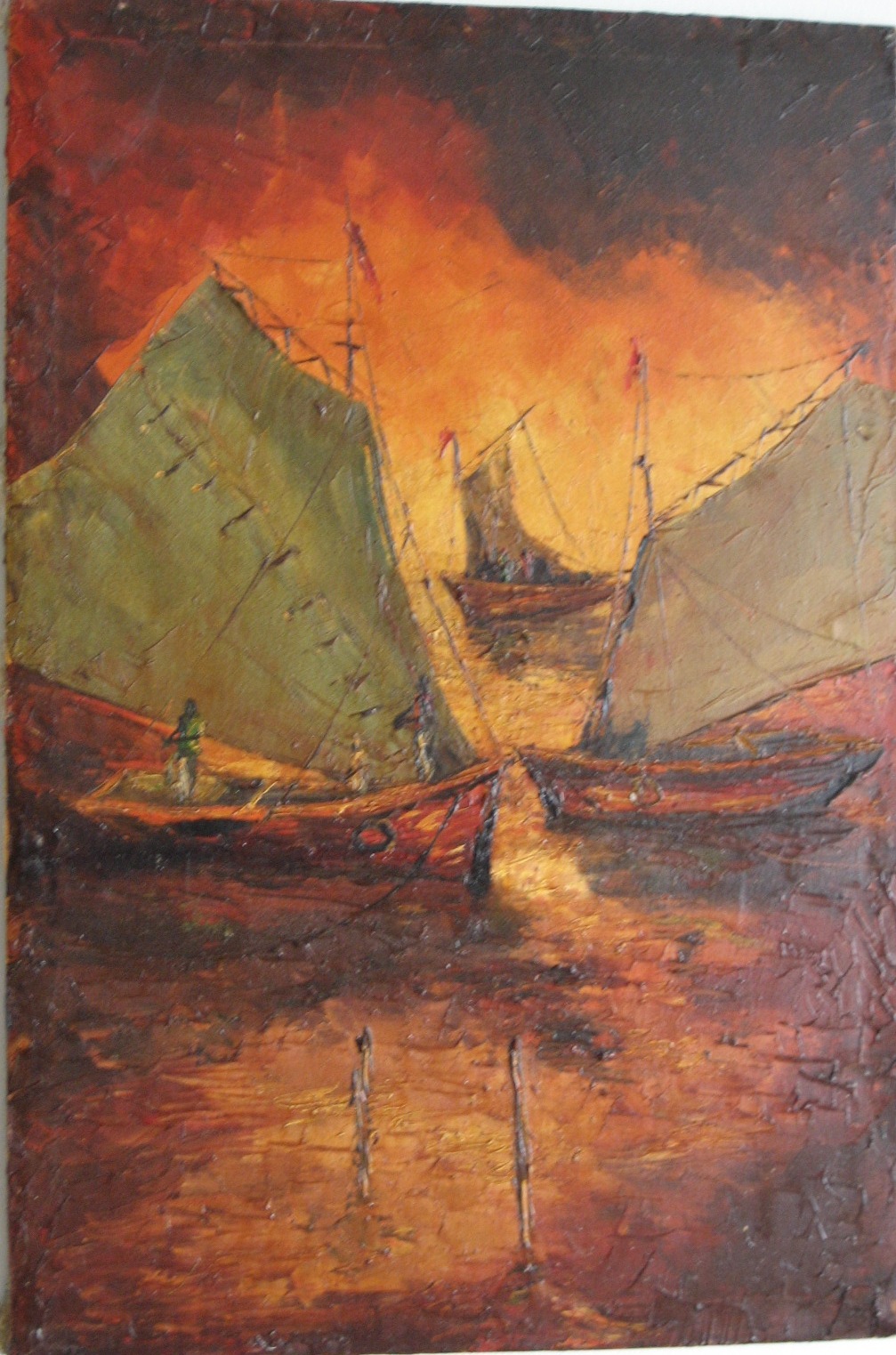
The above painting is the only Haitian one in my
collection in addition to the Claude Dambreville’s ones. It is a fine
example of Haitian “primitive art.” It is entitled “Boat people.”
Haitian primitive art may be in part a function of tourism, but there is
no doubt that it is genuine art. Although none of the Haitian
primitivists went to an art school (or probably because of it), their
highly decorative works are quite “naïve.” Since they are not concerned
with symmetrical details, their output can be prodigious. Anonymous,
Oil on canvas, 16 in. by 24 in., 1960s.
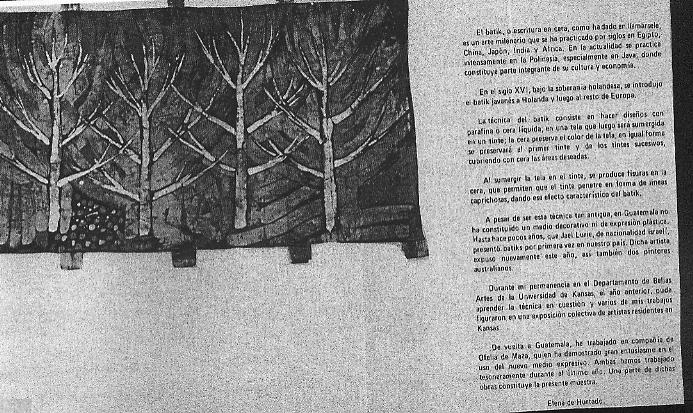
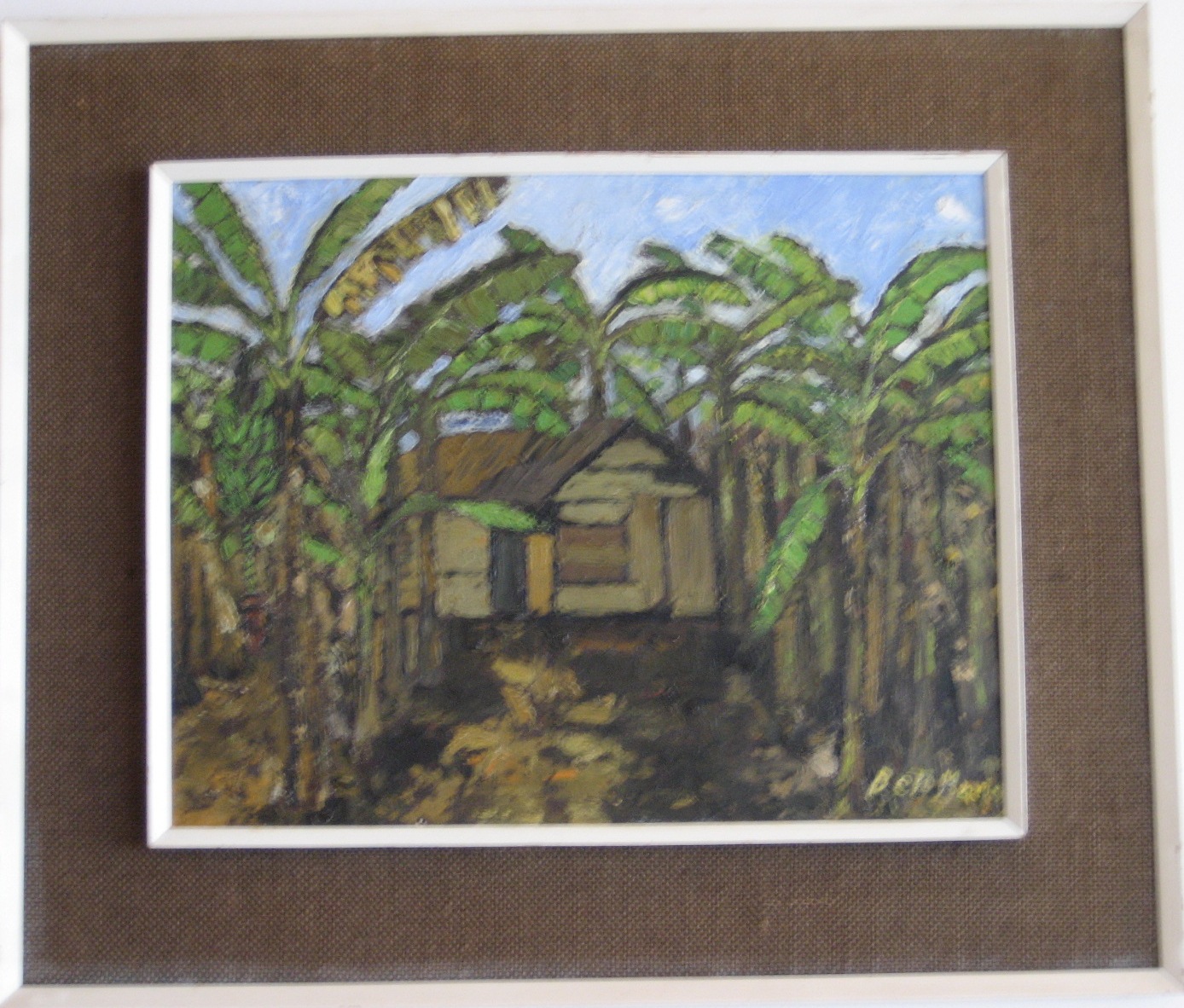
The work above is from a Costa
Rican artist, BETO MARIN, oil on wood, 14 in. by 18 in., 1970s.
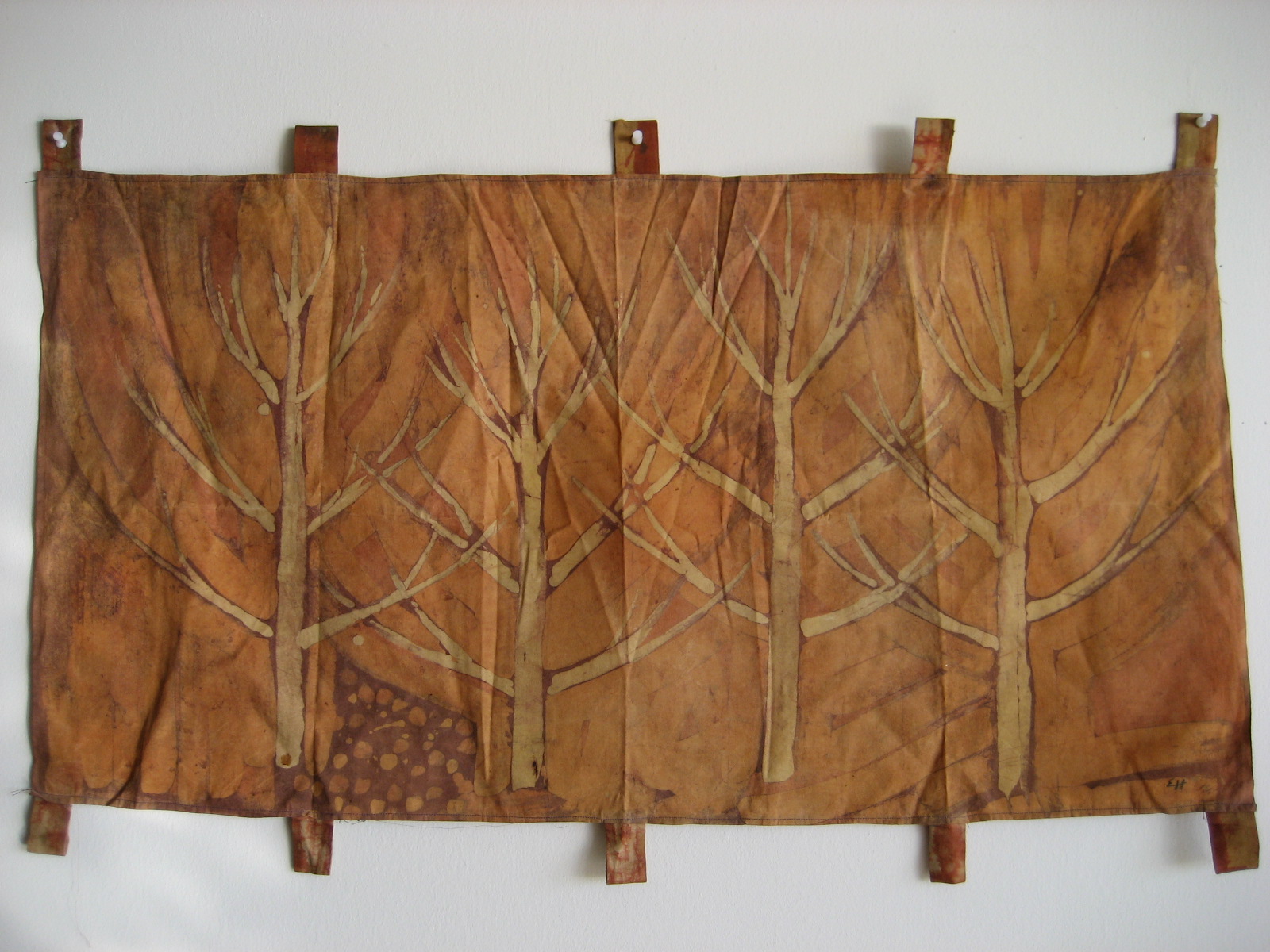
Above is a batik done by ELENA DE HURTADO, artist from Guatemala, batik
24 in. by 36 in., 1971. It was bought in the art gallery Enrique Acuña
in Guatemala City.
Paintings from
Nicaragua
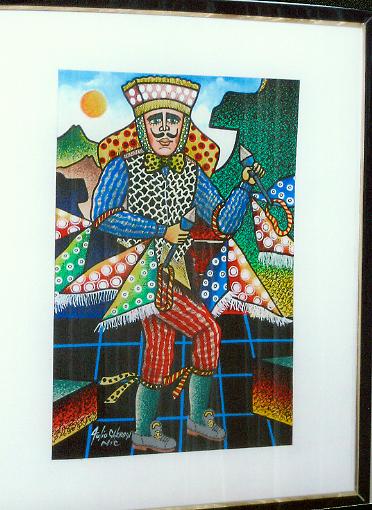
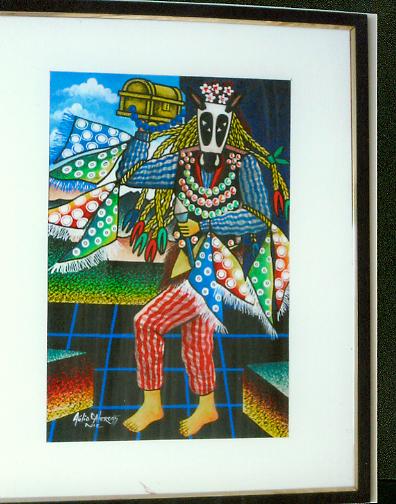
The two paintings above are from Nicaraguan
artist Julio Caleroy, push pin, each measures 10 in. by 14 in., late
1990s.
A painting from
Mexico
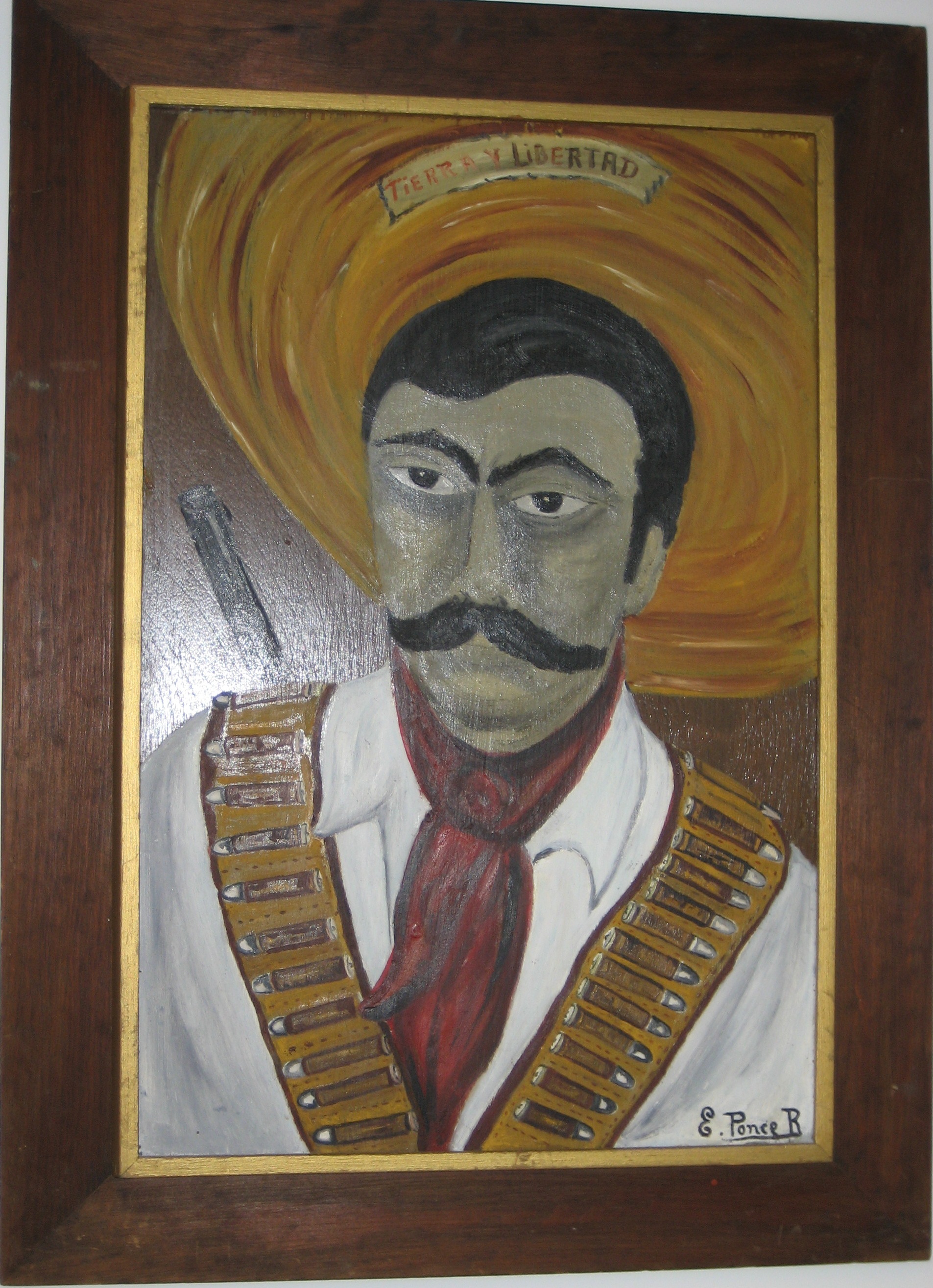
The painting above is a rare example of Mexican
Primitive art. The artist, E. Ponce B, paints most of his works on
wood. This is a rendering of the Mexican revolutionary Emilio
Zapata. This painting is in my office at Florida International
University. Oil on wood, 16 in. by 24 in., 1970.
A small painting from St. Martin

The above painting is a marvel of primitive art in
many of the Caribbean islands. This one caught my eyes during a visit in
the Dutch/French island. It is now in my office at Florida International
University. Oil on canvas, 11 in. by 15 in.
A
painting from El Salvador

The black and white work above is by El Salvadoran
artist C. Minero. It is entitled Juegos de niños. “Madera de hilo”,
13 in. by 29 ½ in., 1973.
A
painting from Barbados
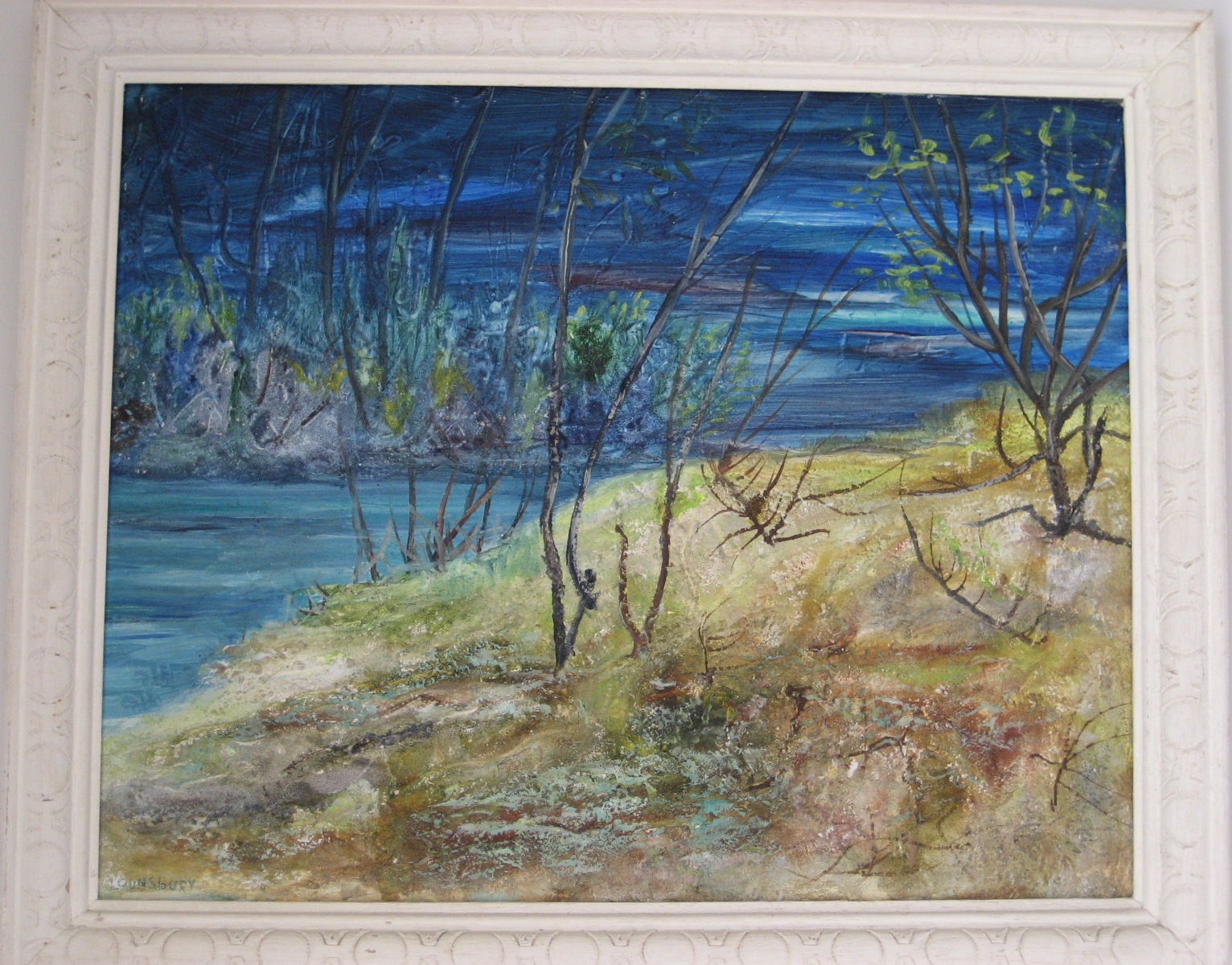
The painting above is from Lounburry. The artist
uses a unique technique. He puts sand from the beaches of his island to
create relief. Oil on wood, mixed media, 16 in. by 20 in., early 1970s.
Paintings from Colombia
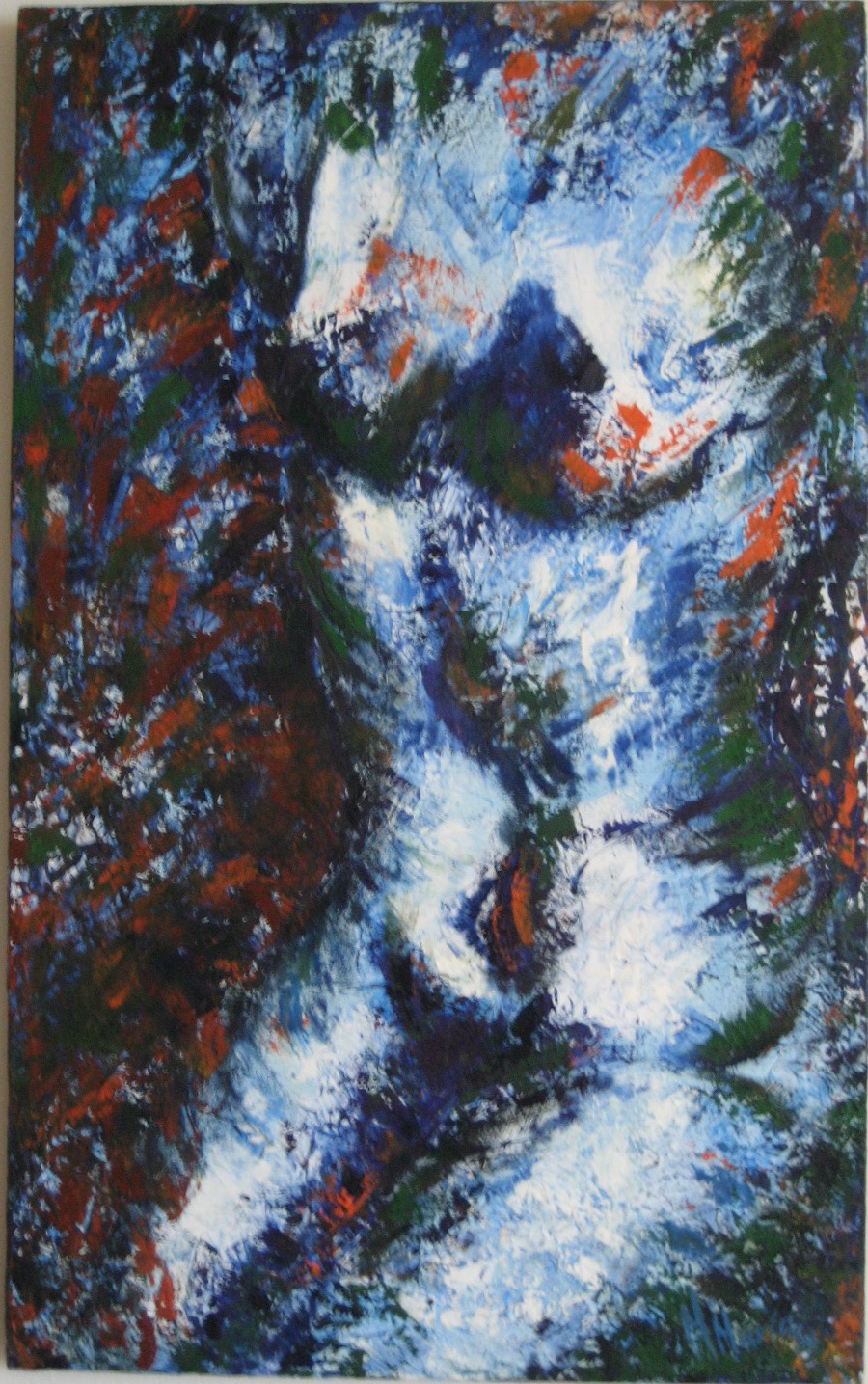

Of the two above paintings, the one on the left is a remarkable work from Monica Trejos Gomez. The artist is from Pereira. Oil and acrylic on canvas, 22
in. by 35 in., 2006. On the right is a digital painting by Colombian
artist Enrique Sierra who is a resident of Miami Beach. The work is
entitled “Blue Angel.” Digital painting, 3 in. by 5 in., 2002.
Digital
Painting
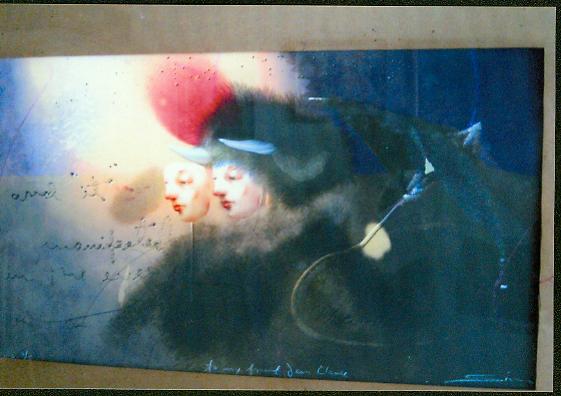
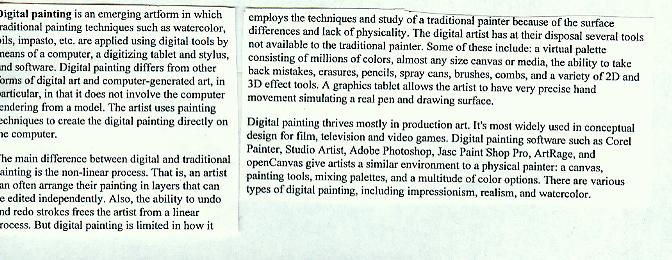
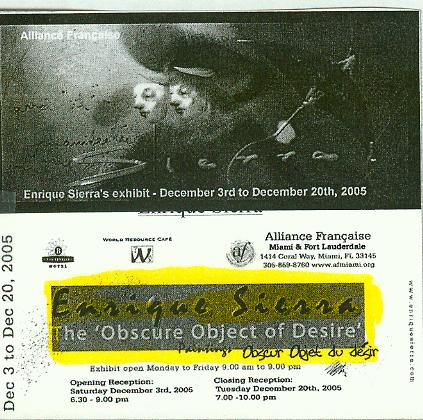
Paintings from United States
artists
A mural by Milton
Glazer
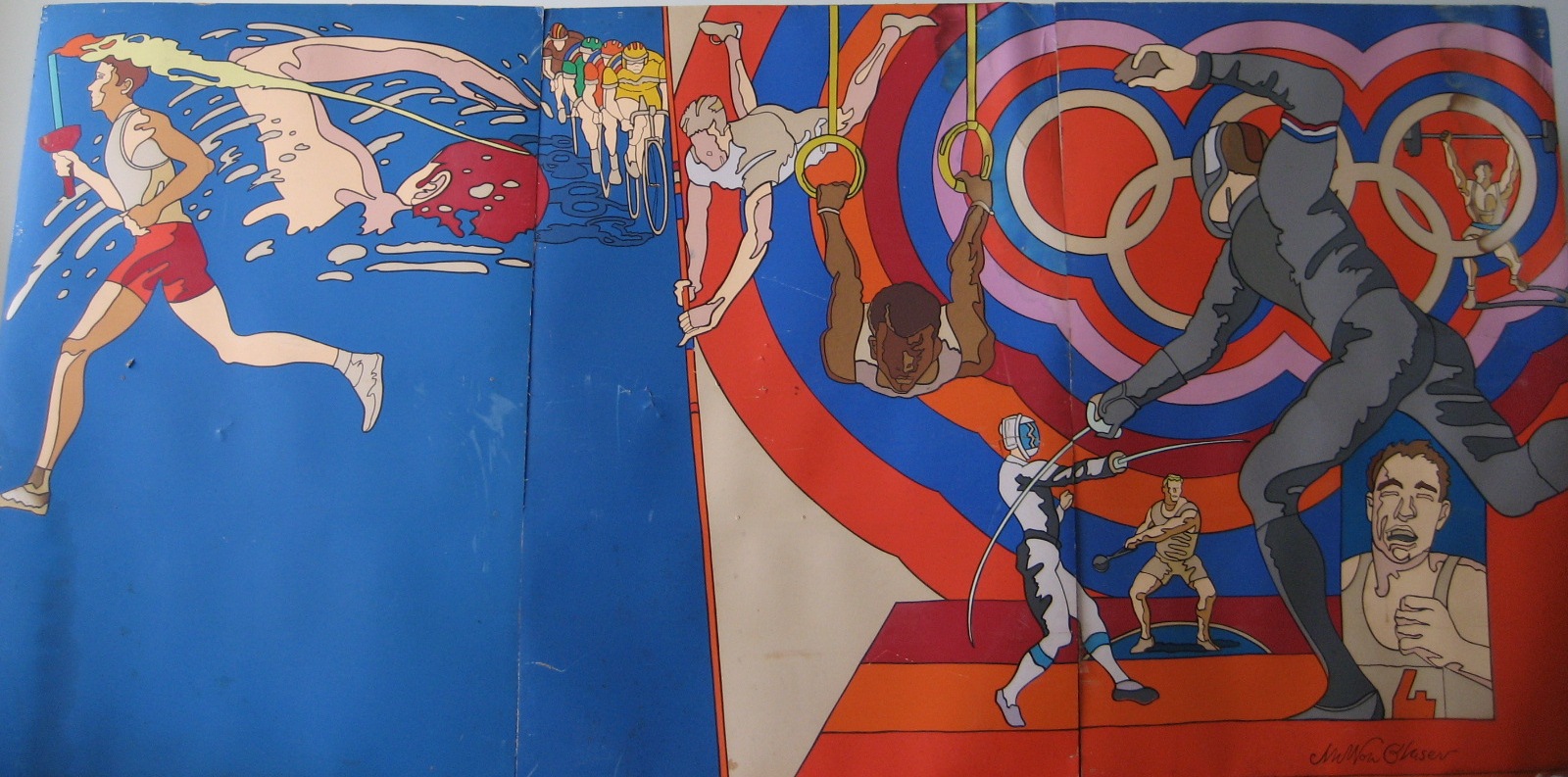
The mural above is the largest piece in my
collection (10 feet by 5 feet). I acquired it in Austin, Texas when I
was an Assistant Professor at the University of Texas at Austin. The
work was originally commissioned by Thom McAn Shoe Store for one of
their window displays in Dallas to salute the Olympic Games of 1968 that
were being held in Mexico. I was able to display it in my houses in
Austin, Texas and in Bethesda, Maryland. But because of its size, it
cannot be displayed in my apartment. It is presently in storage. After
the games, the store auctioned it. Push Pin graphic, 120 in. by 60 in.,
1968.
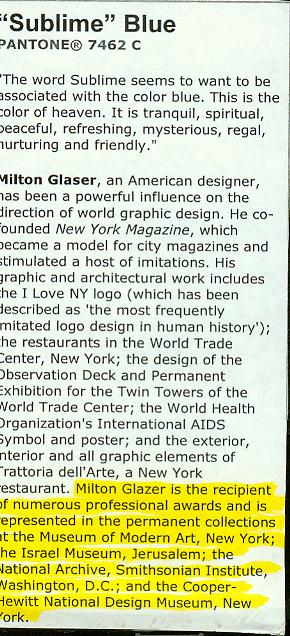
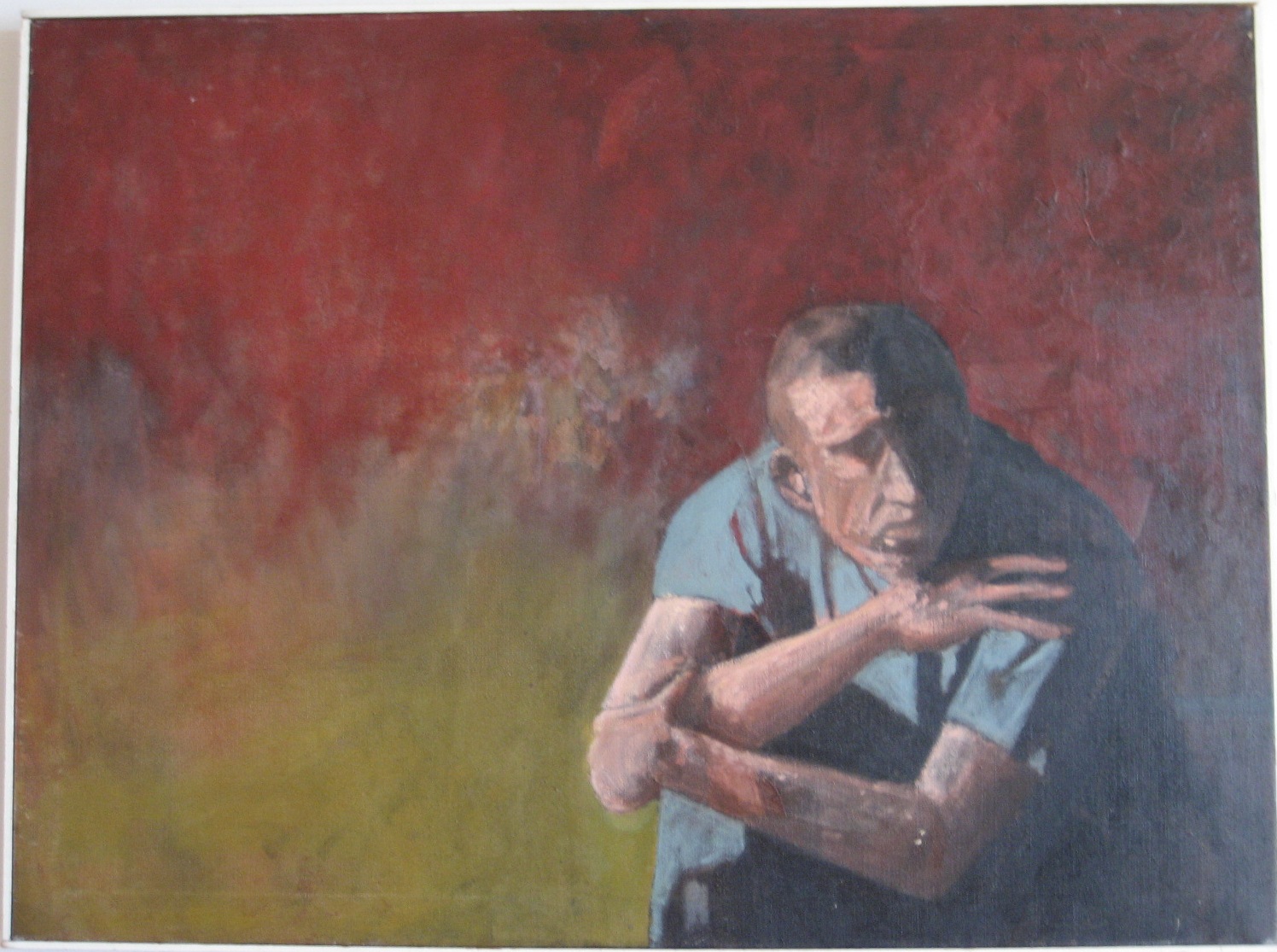
The painting above is the first of six large oil
on canvas that I got in Austin, Texas. The names of the artists
are not known but they may have been art students at the University of
Texas in the 1960s. The one above is of a man lost in his
thoughts. Oil on canvas, 30 in. by 40 in., 1960s.
The painting below is a study of women
underwear. It is too large to be displayed in my apartment in
Miami Beach. It is kept in storage. Oil on canvas, 60 in. by
50 in., 1960s.
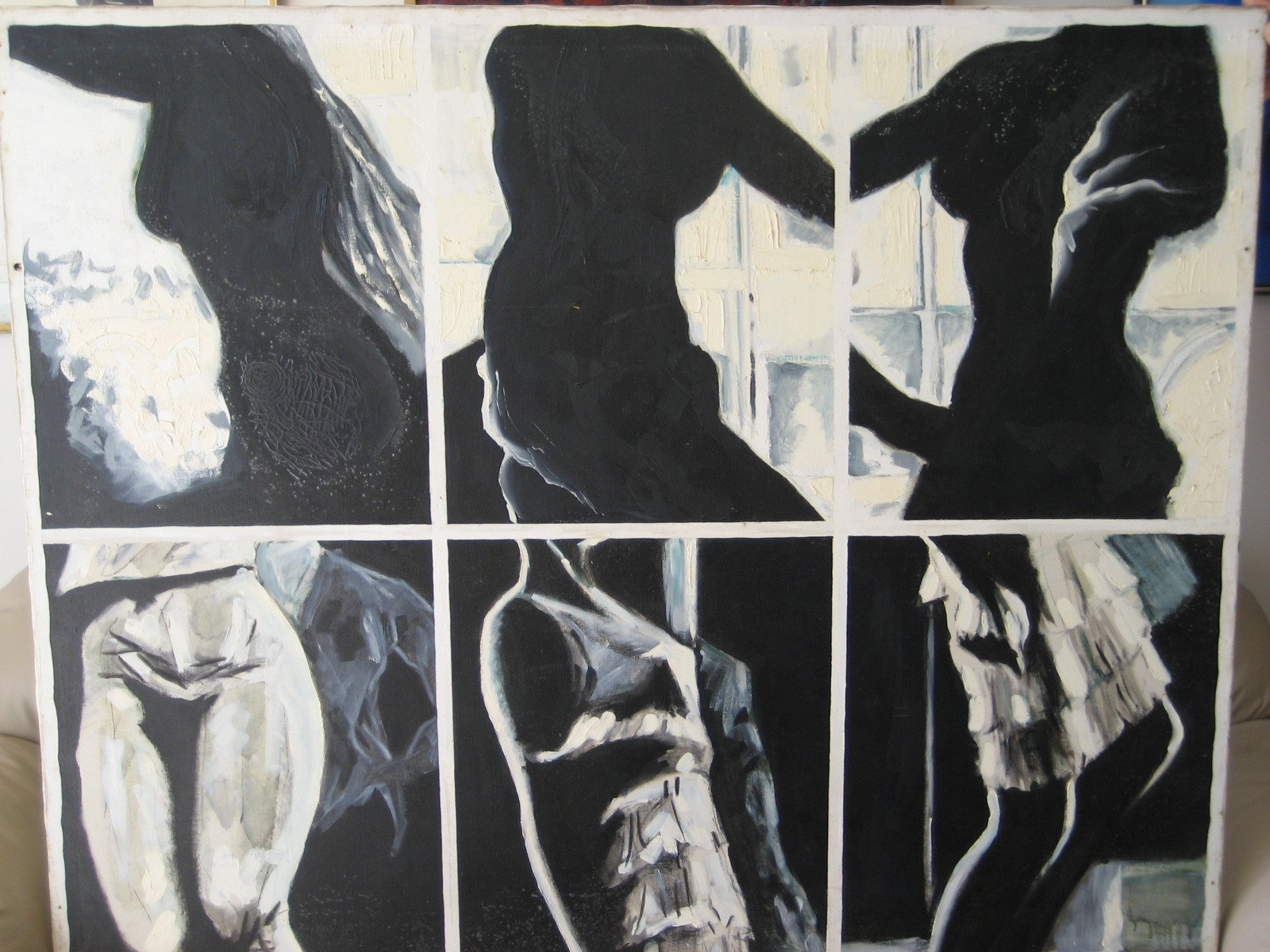
The painting below is full of symbolism. It
shows Martin Luther King. It was painted soon after his assassination
and the murders of the Kennedy brothers. The numbers and the stars
(including the unpainted one) have some meanings. The red X next to a
photo collage of King and the black paint dripping under “B & W” leave
the viewer guessing. The lone star flag is the official flag of the
state of Texas. Mixed media, 36 in. by 44 in., 1960s.
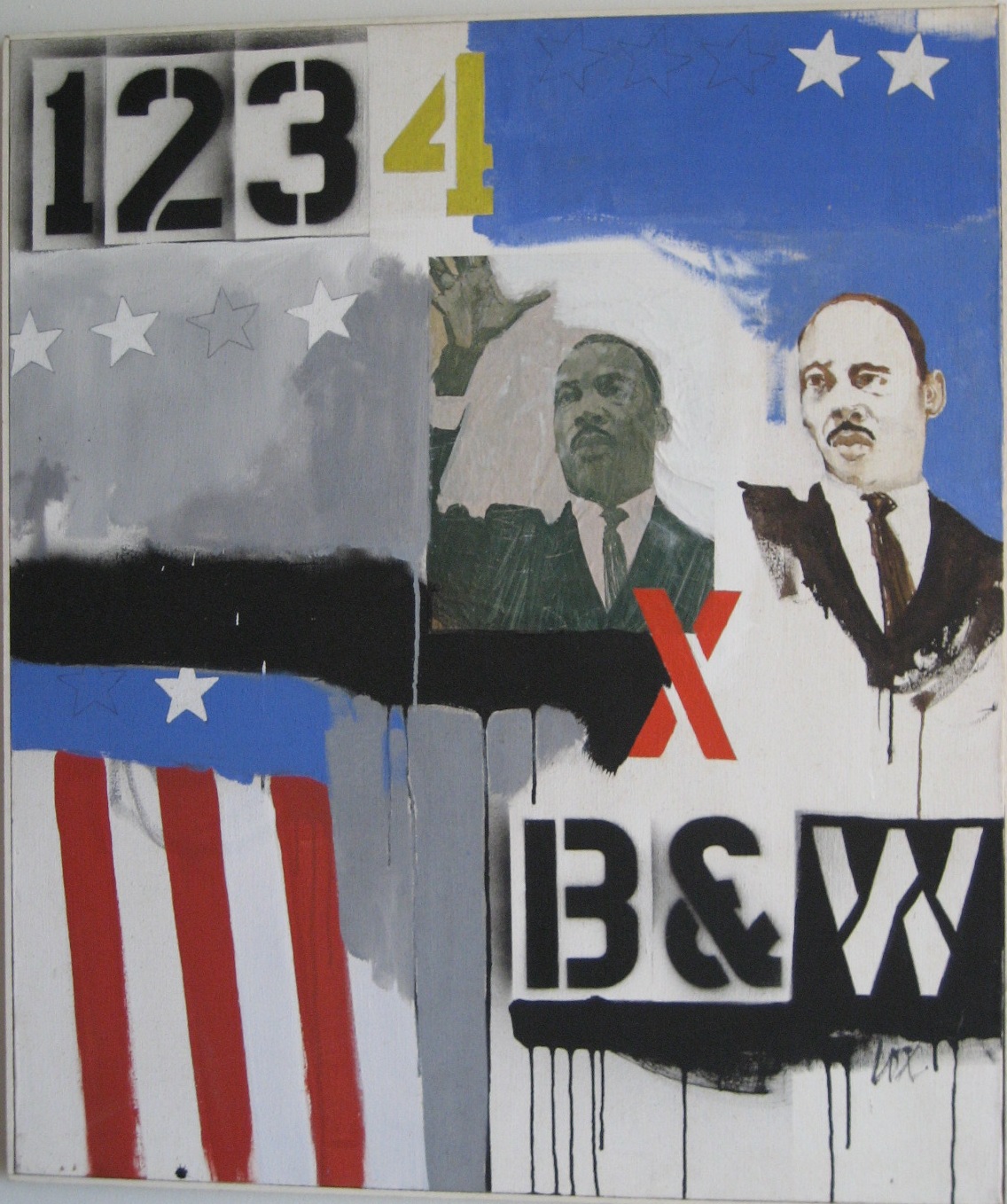
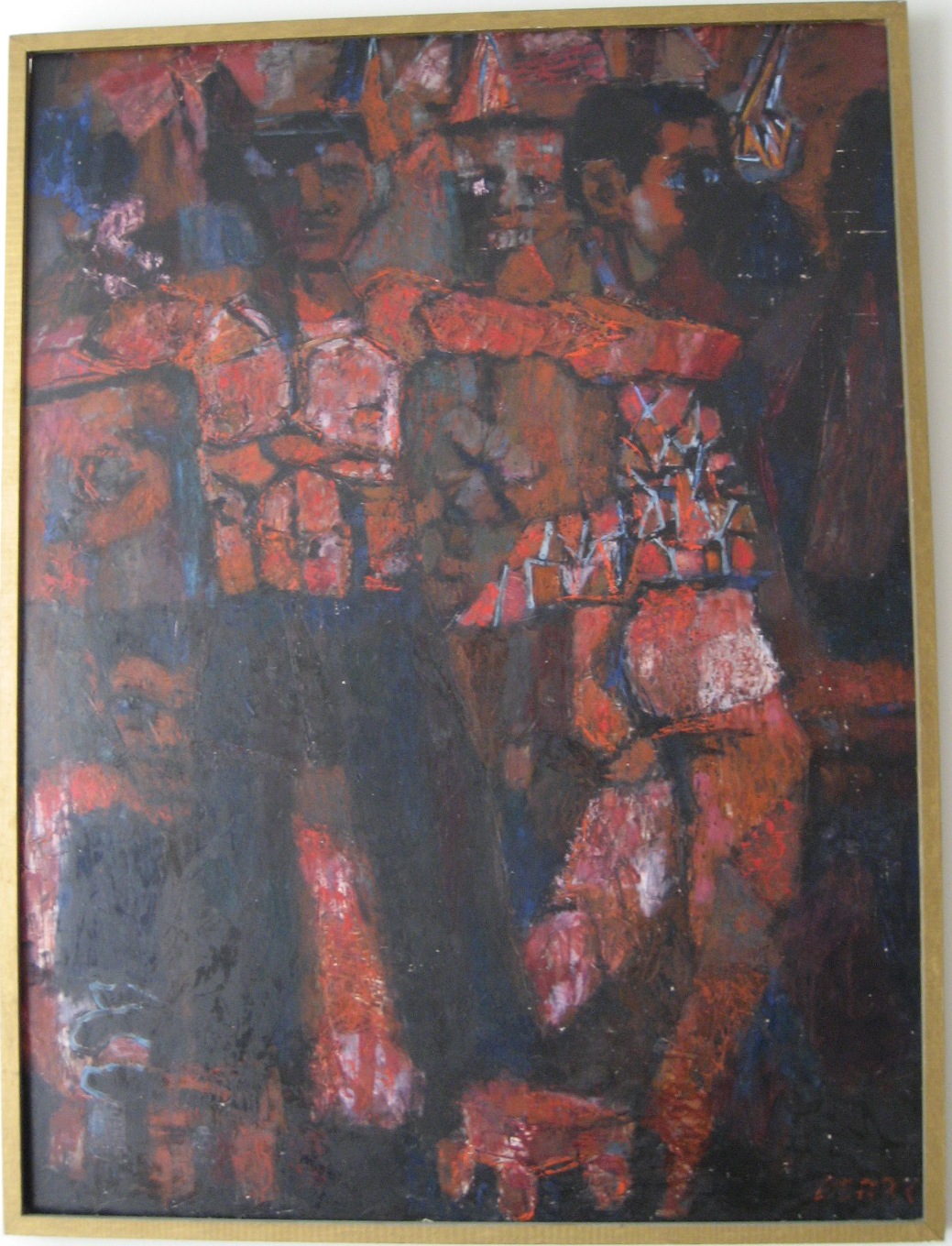
The painting above is signed Berry. It is also
quite intriguing. The viewer keeps on discovering new meaning to it. It
could be a scene of carnival in New Orleans or simply people at a
bar. Oil on wood, 36 in. by 48 in., 1960s.
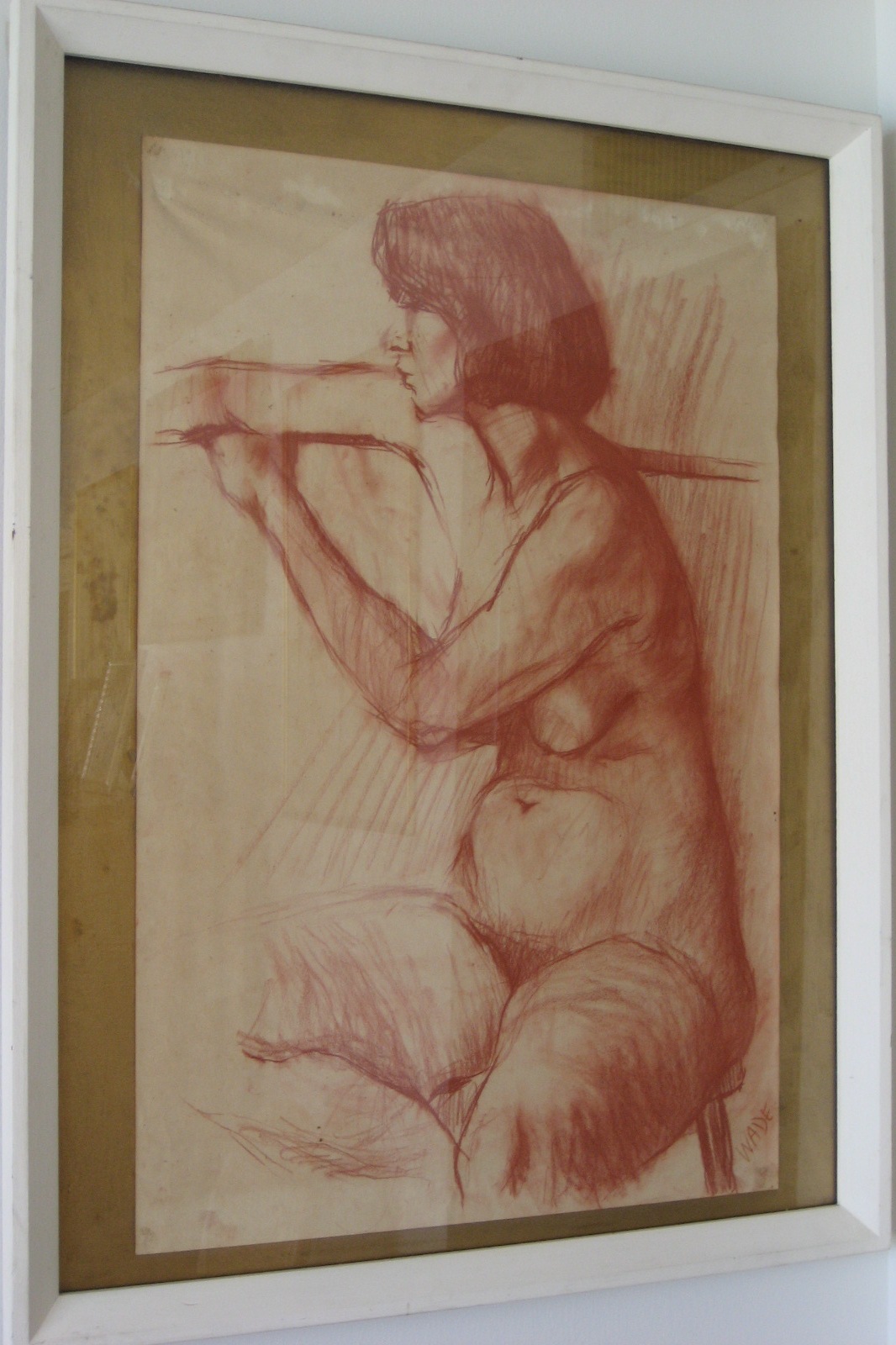
Above is a drawing by Bob Schrope Wade. Here is the only
one among the painters of the six large pieces I acquired in Austin,
Texas I was able to identify. Drawing, 24 in. by 36 in., 1960s.
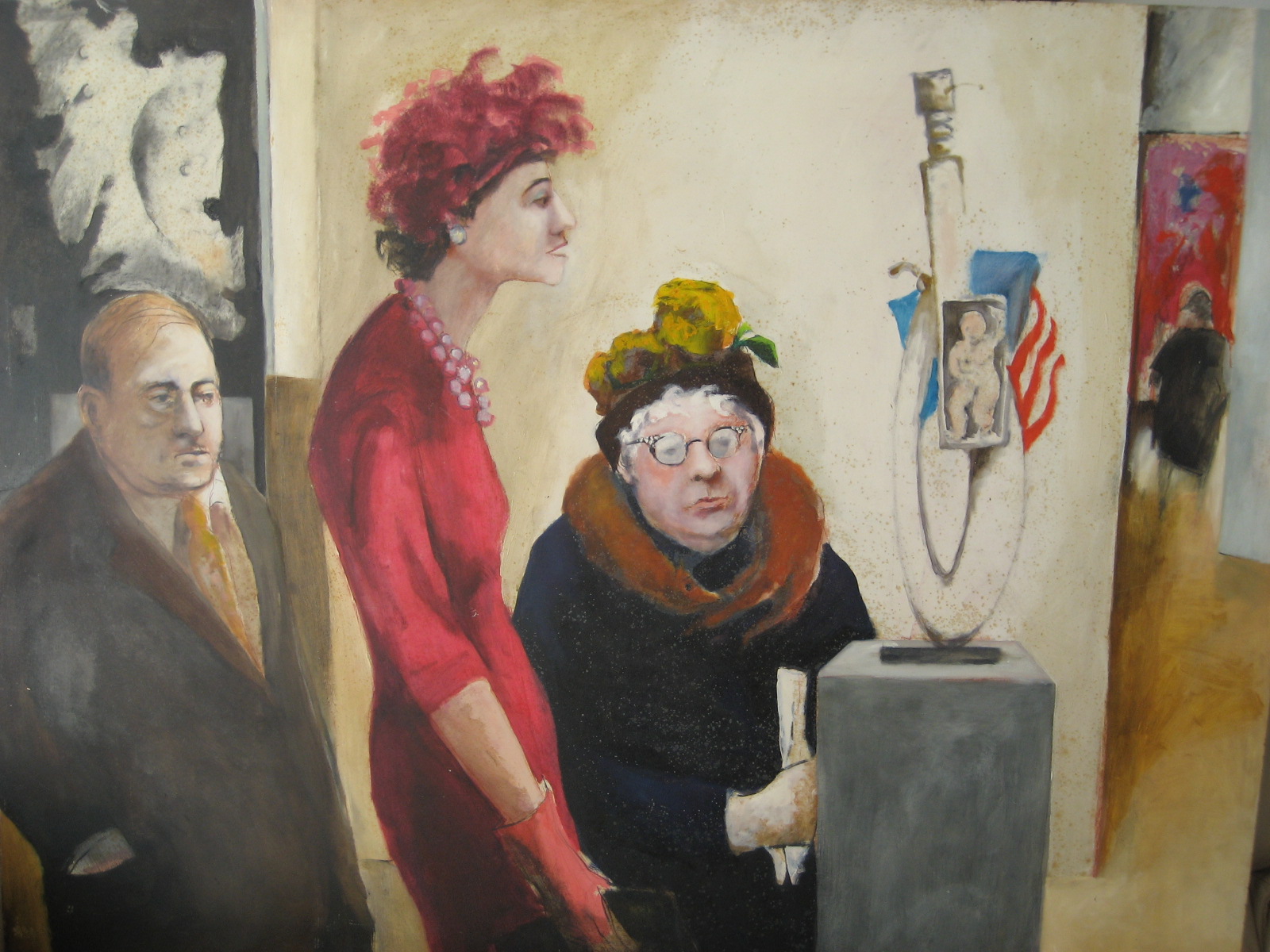
The above painting is a very large painting on
cardboard. Because of its size, it cannot be displayed in the apartment
in Miami Beach and is also kept in storage. It could be a scene of
people waiting in line or of visitors wandering around in a museum. Oil
on cardboard, 48 in. by 60 in.,1960s.

RICHARD CHIRIANI painted the
above watercolor on
plywood, 10 in. by 63 in., 1960s, New York.
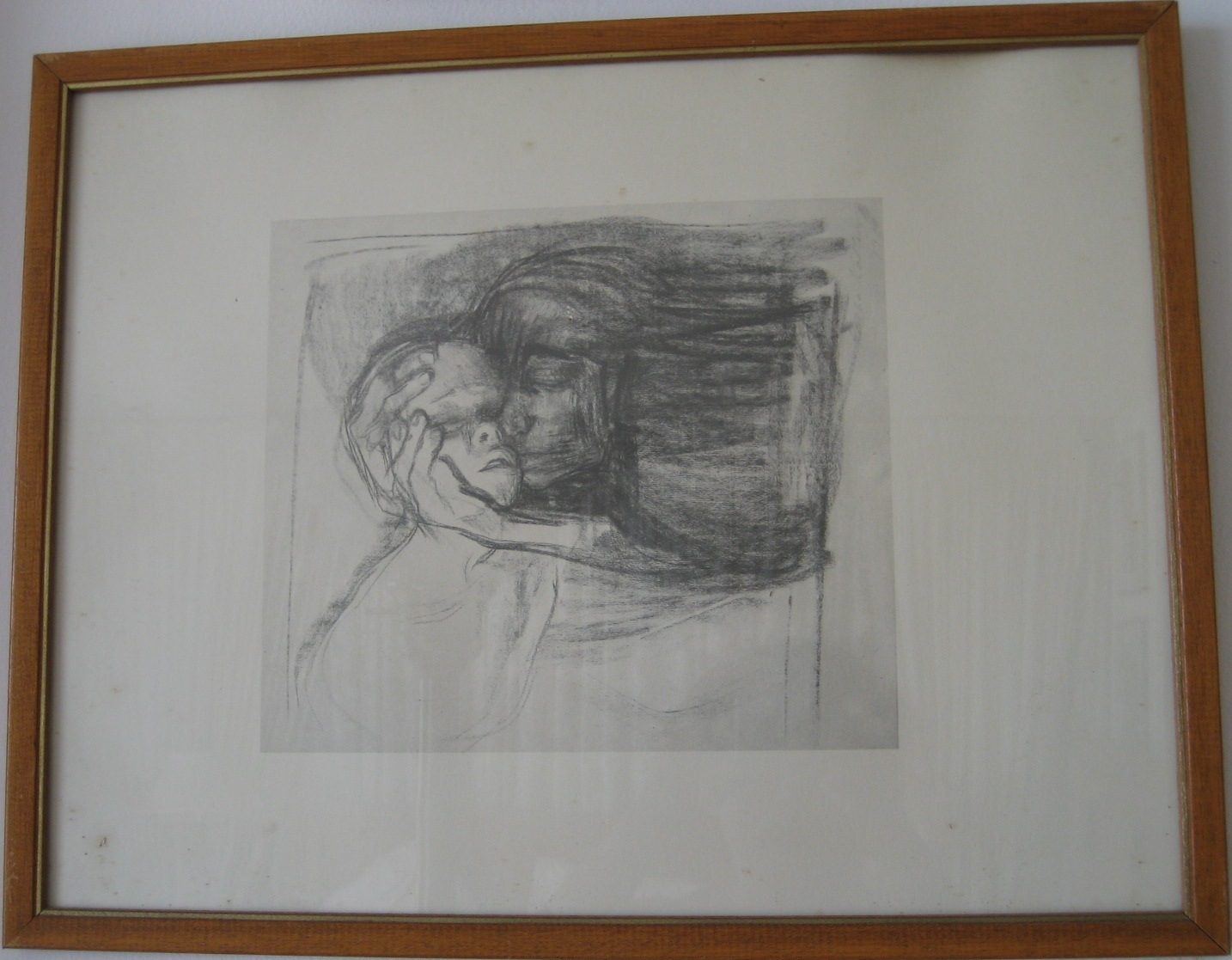
The pencil drawing above is by an unknown
artist, 9 in. by 10 in., 1970s, Bethesda, Maryland.
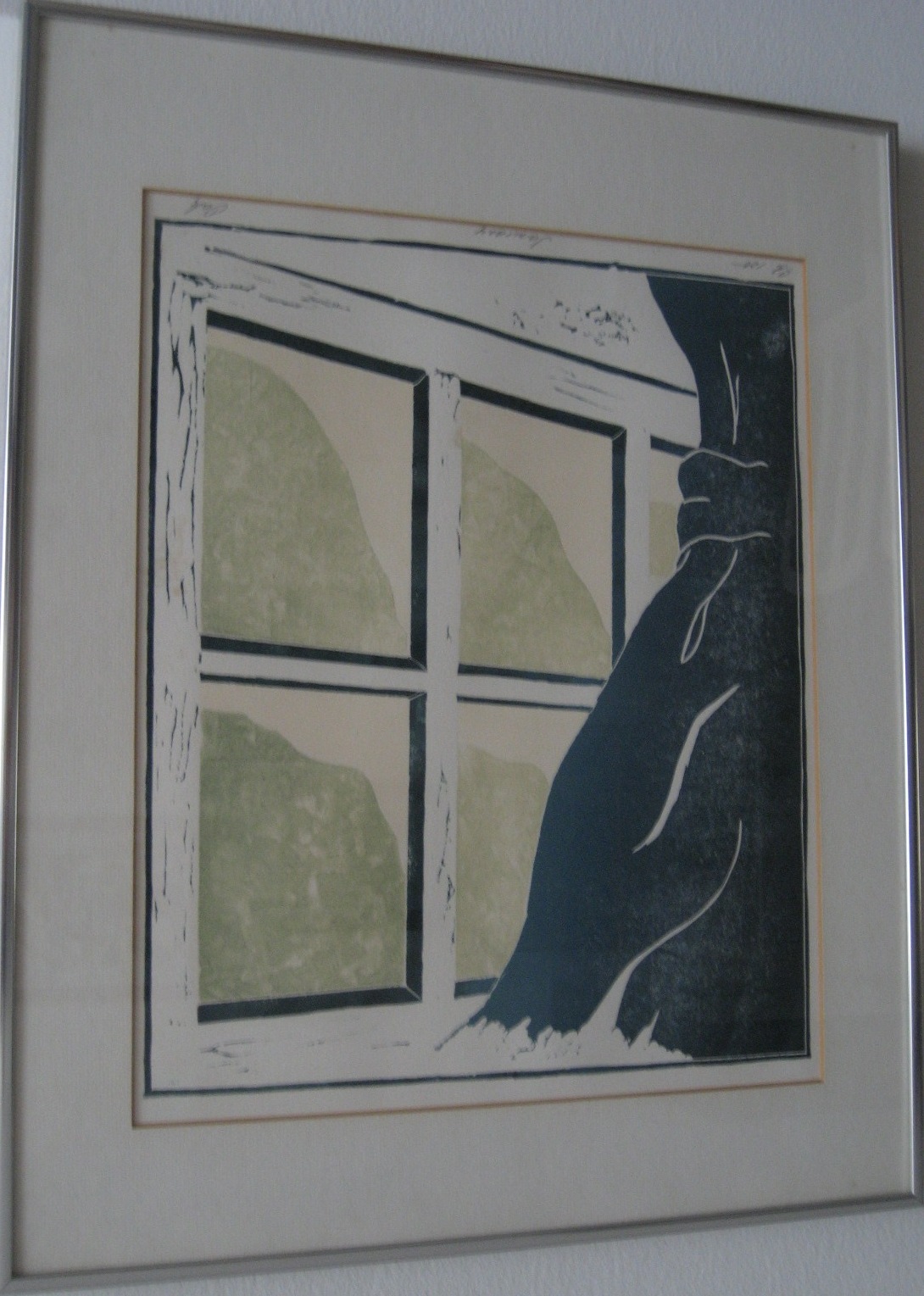
Above is a
drawing by artist
Judith Oak-Andraka titled
Out My Window

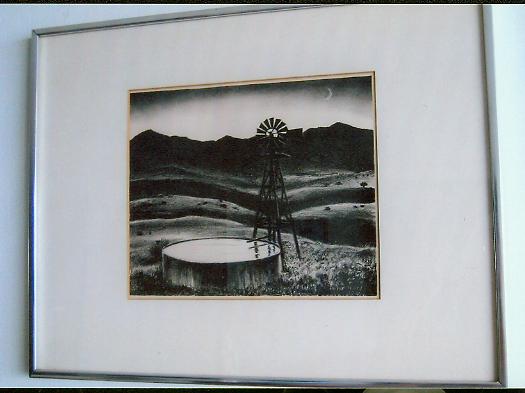
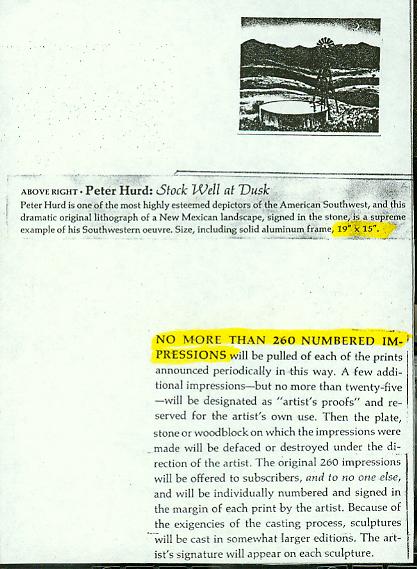
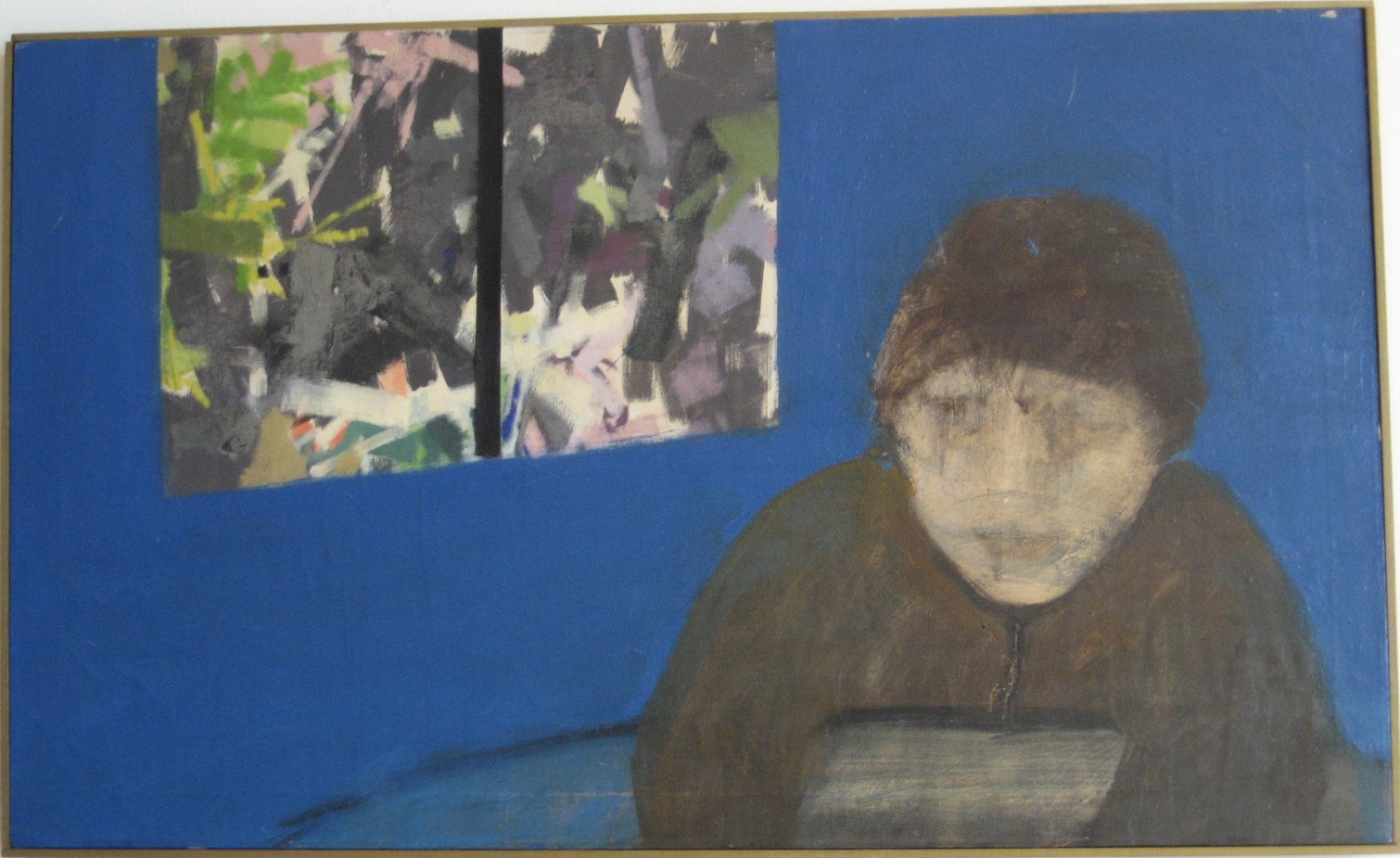
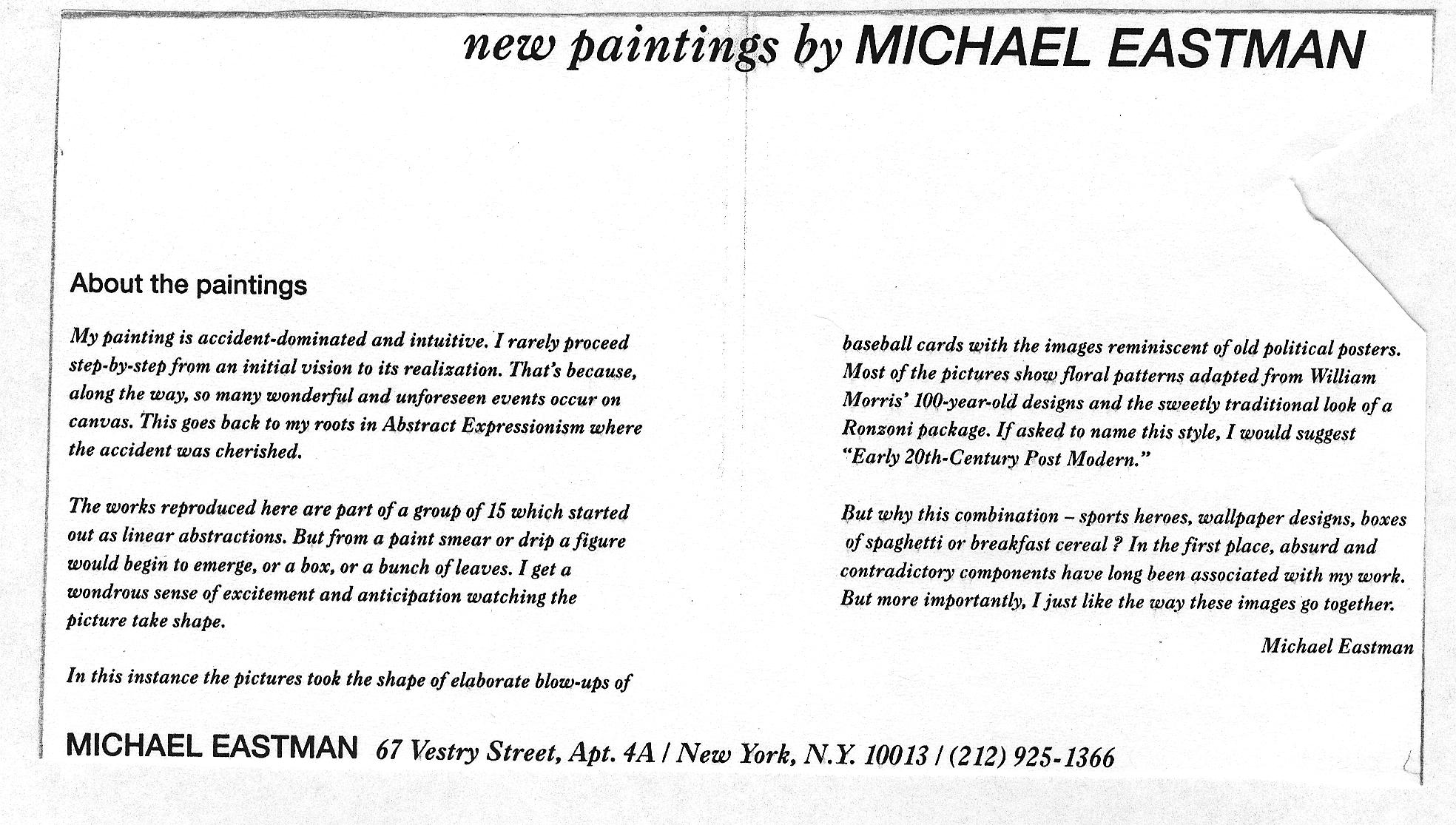
The following two paintings are from
New York artist W. Satter. They were painted In the 1970s. Both
are oil on wood. The small one on the left is 12 in. by 20 in. The
one on the right is 36 in. by 24 in.
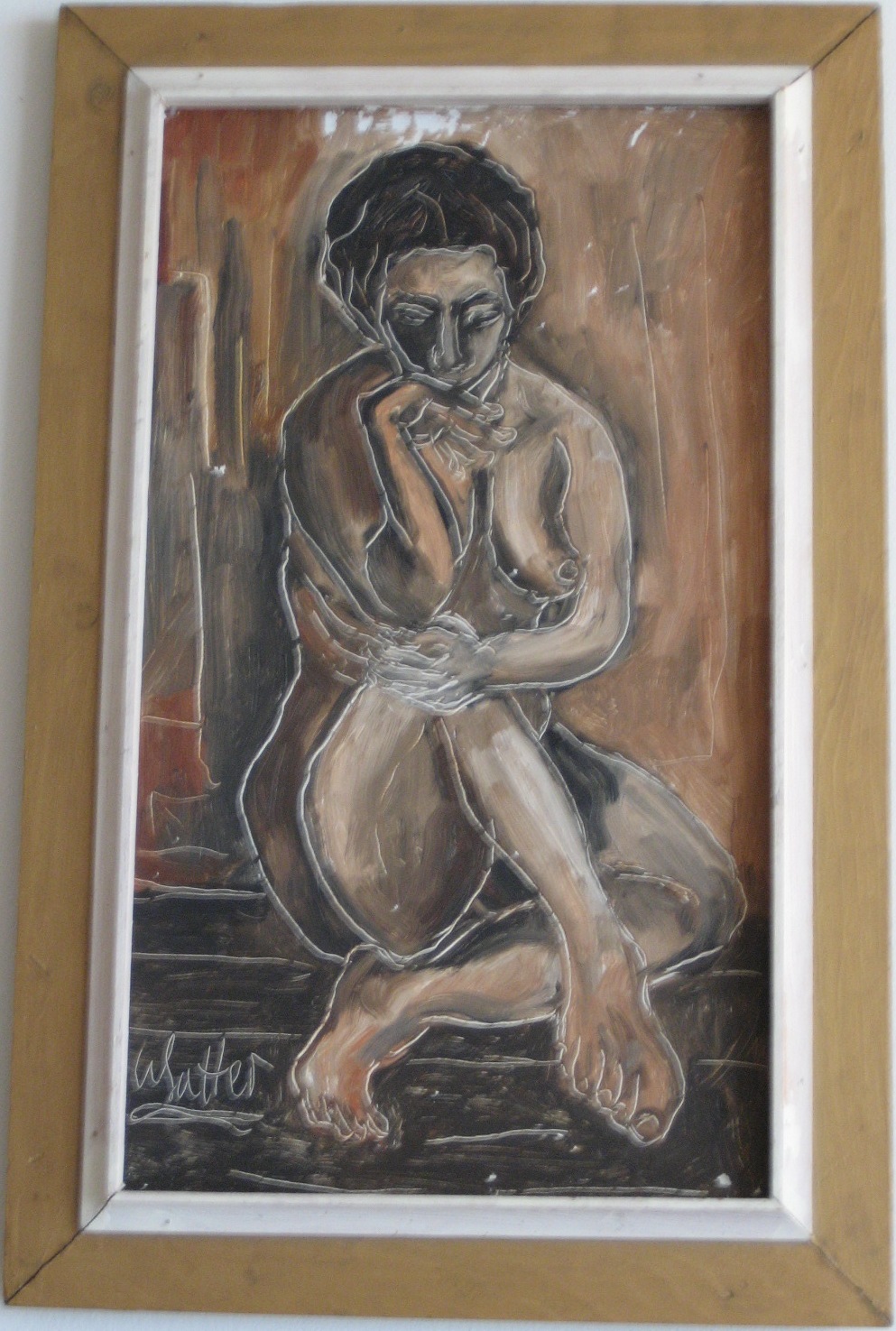
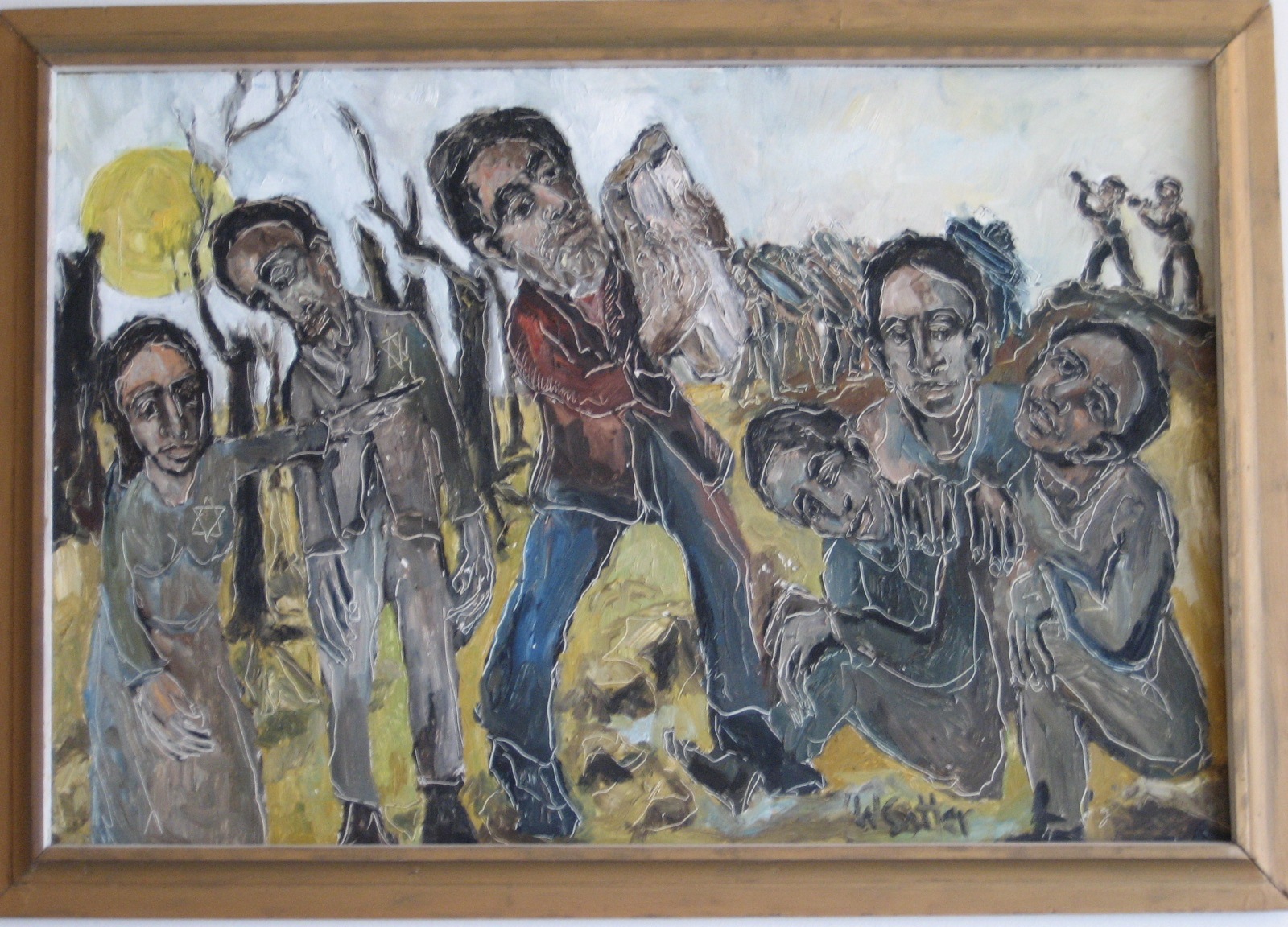
Both paintings below are from Christabel Zamor.
They are both OIL ON CANVAS. The first is 16 in. by 20 in. She wrote on
the frame in the back “Christabel – Father’s Day 1988.” The second is 12
in. by 16 in. On the frame in the back is written “Christabel –
Christmas 1988.”
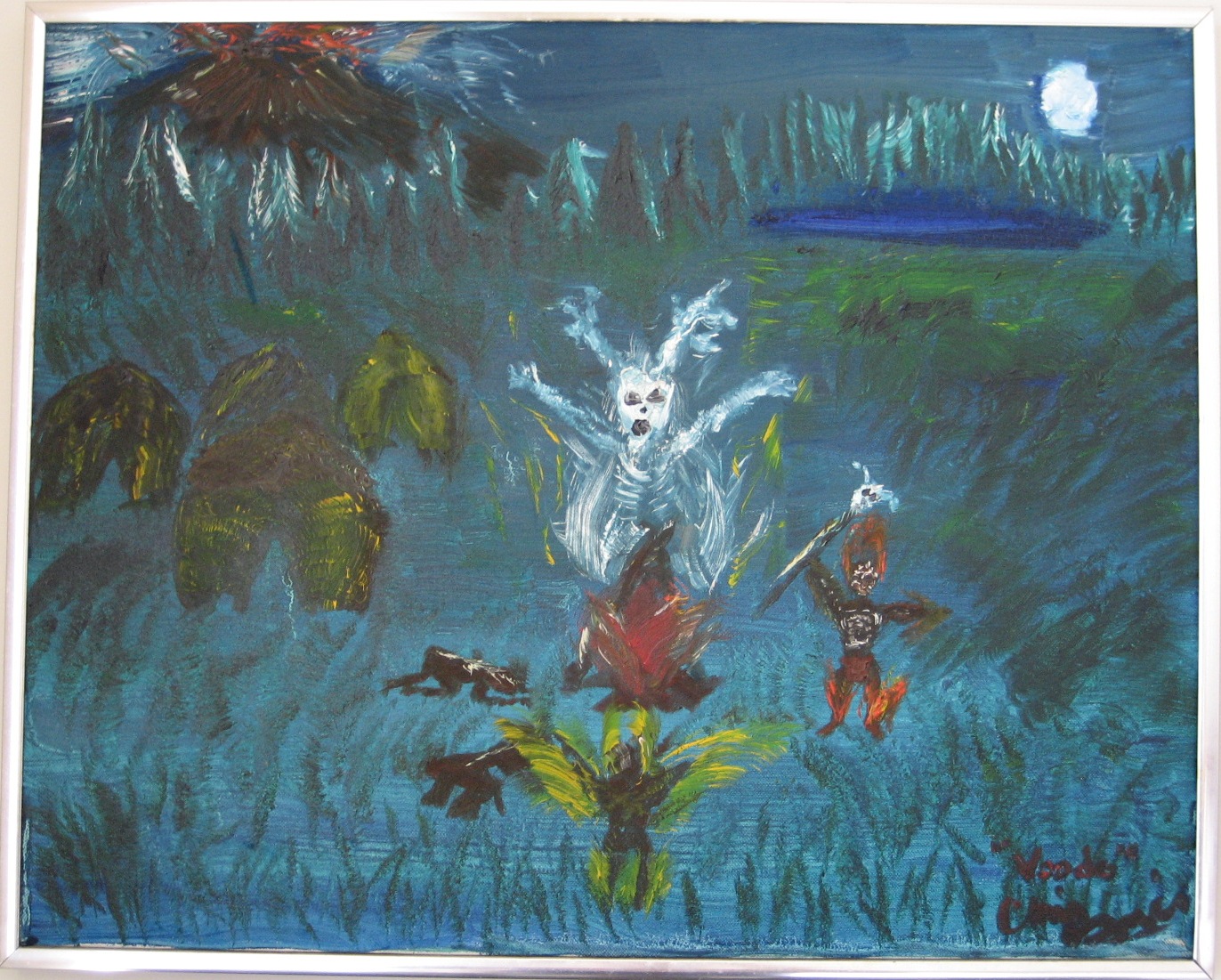
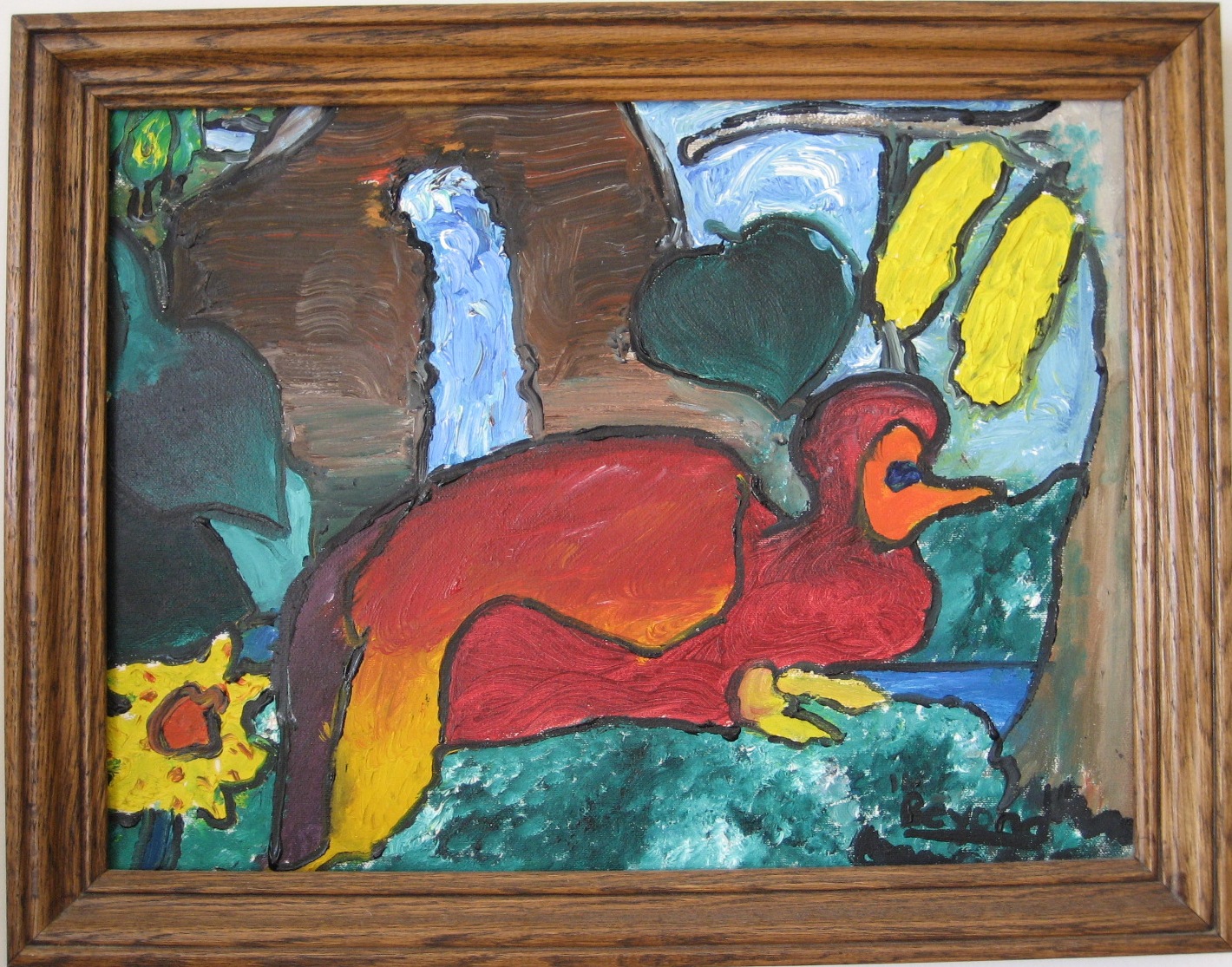
The painting below was done by Christabel Zamor,
watercolor, 9 in. by 12 in., 1998.
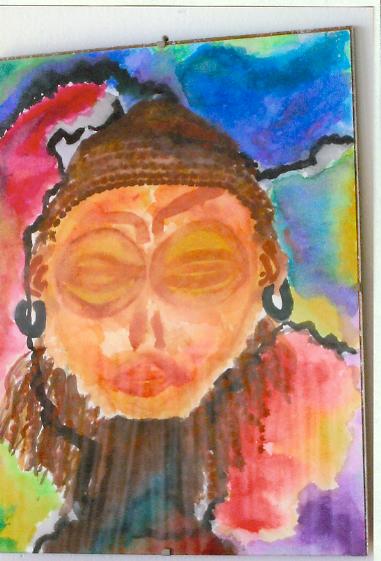
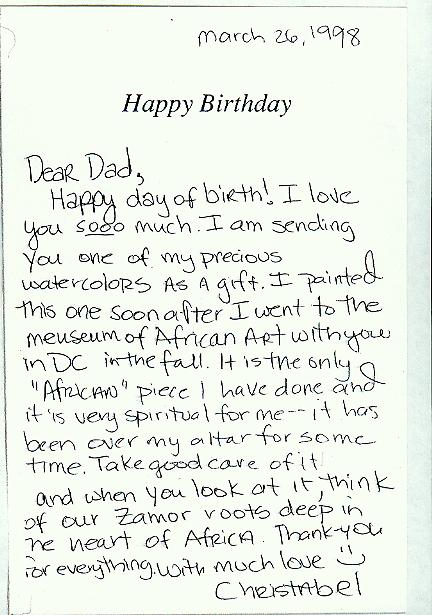
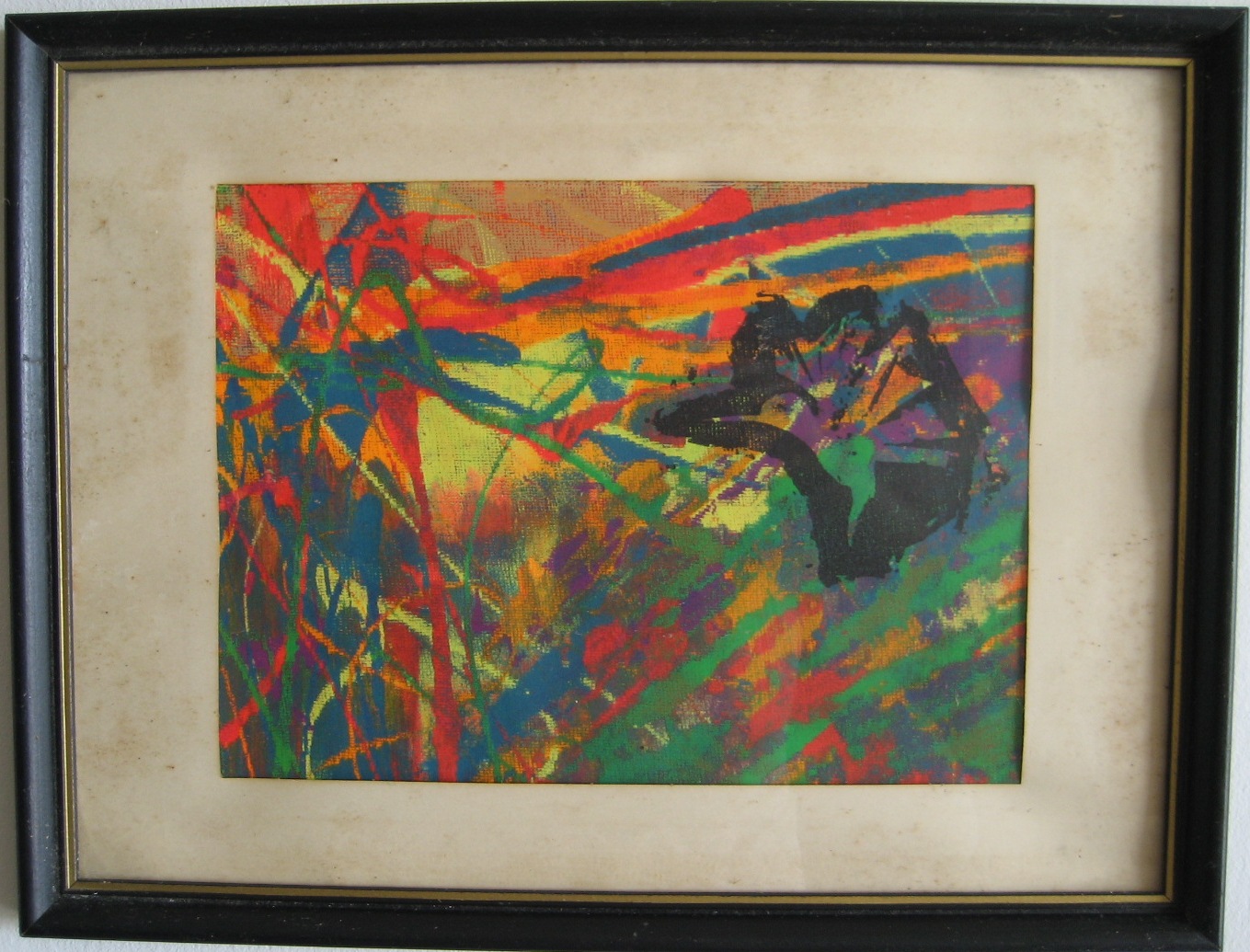
JOEL MAGRUDER painted the above picture titled "The Revolution".
Acrylic on paper,
12 in. by 15 in., 1960s, Rio Piedras, Puerto Rico.
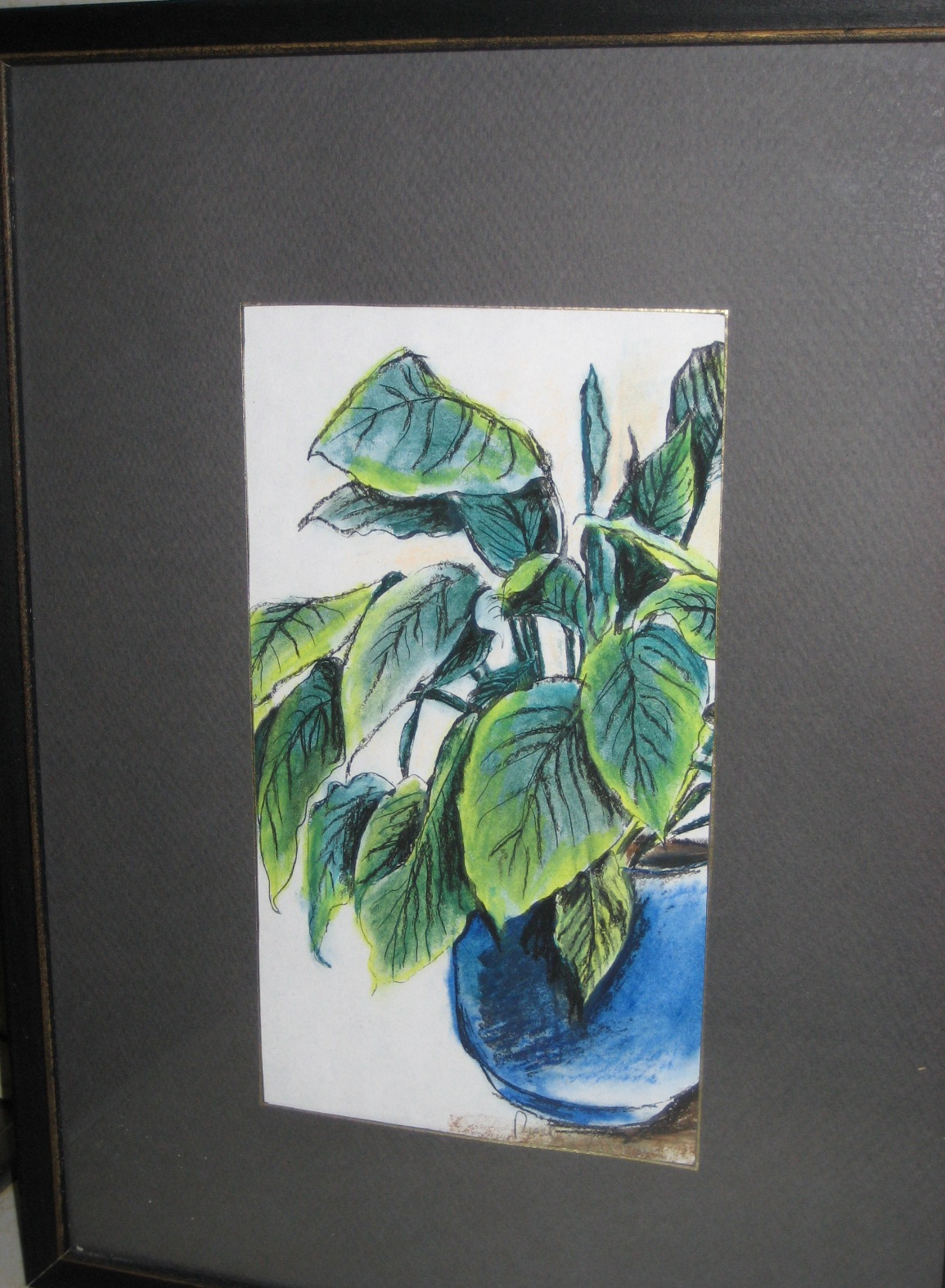
DIANE
BUECHLER, originally from Canada, painted the above watercolor,
6 in. by 10 in, 1990.
The artist now resides in Miami.
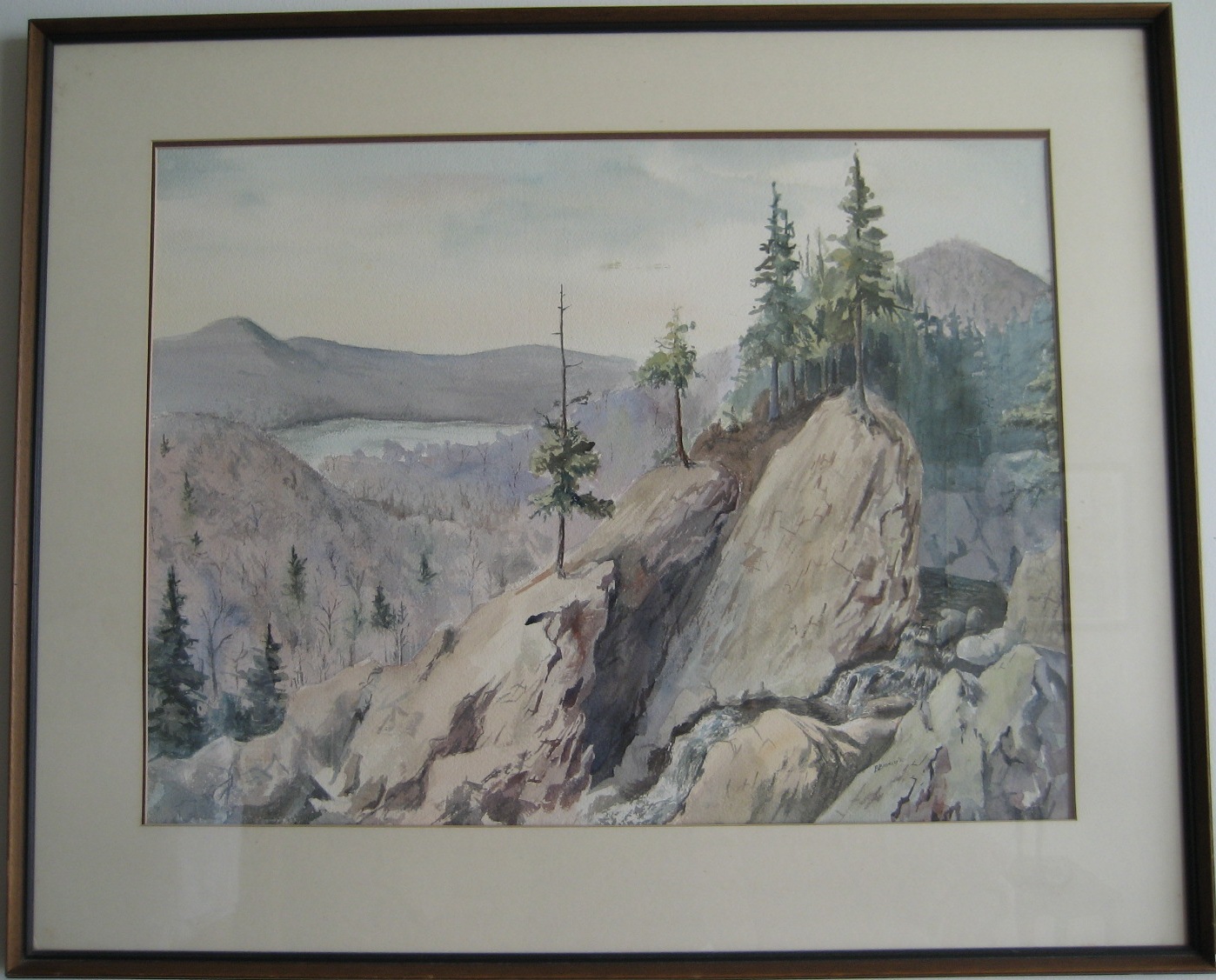
The large watercolor above is by Bernie Bromley,
a Bethesda, Maryland artist. It is 21 in. by 28 in and was painted in
1980.
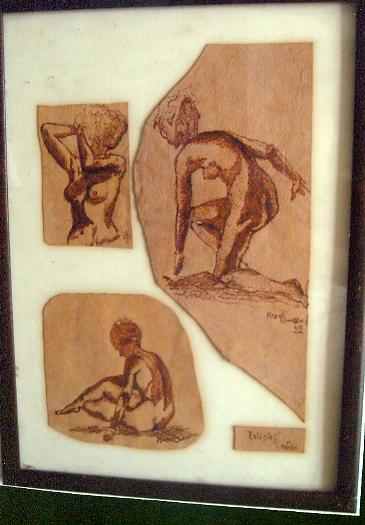
The three small framed “etchings on leather” in
the picture above are from artist Madel-Socorro Diamond. A native of
Mexico, Madel-Socorro is now a U.S. citizen and resides in Chicago.
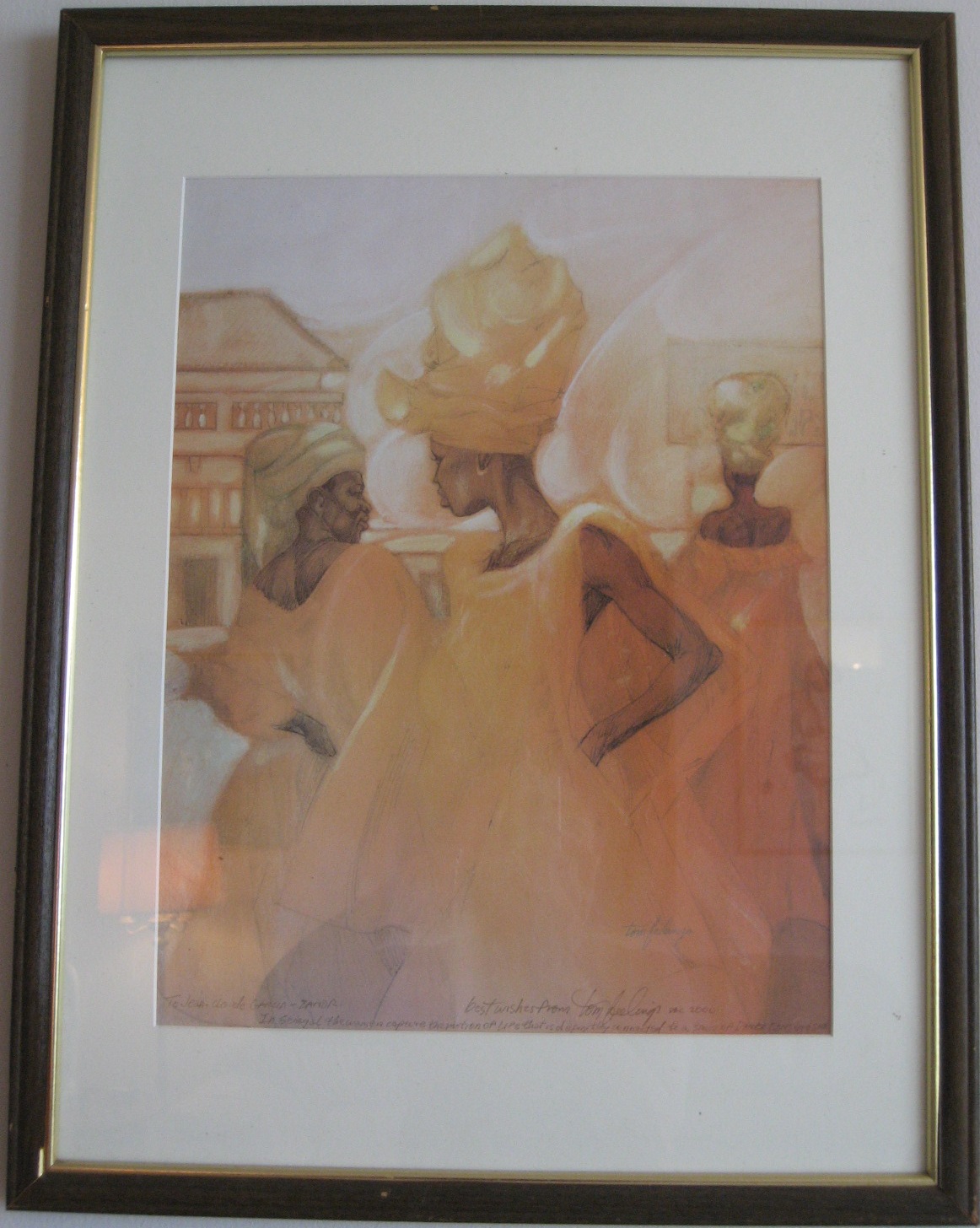
Above is an original work by TOM FEELINGS signed by the
artist, 14 in. by 18 in., 2000. In addition, the artist wrote
“To Jean-Claude Garcia-Zamor, Best wishes from
Tom Feelings, Dec. 2000. In Senegal the women capture the motion of life
that is definitely connected to a sense of dance consciously.”
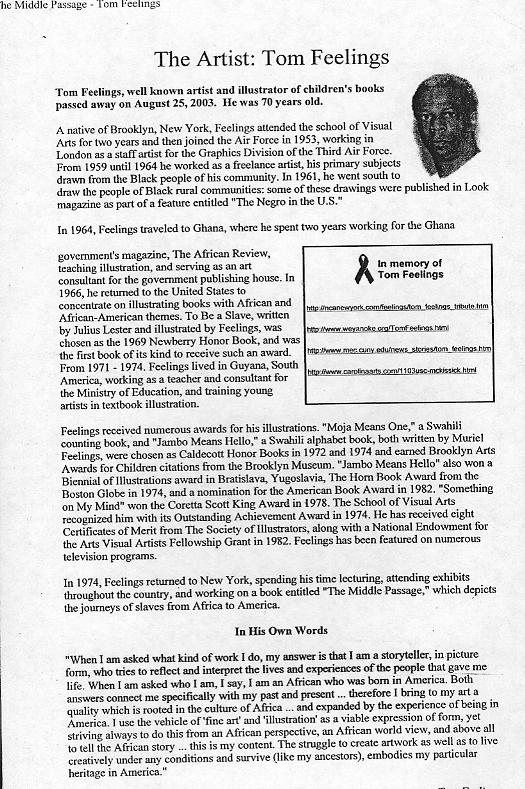
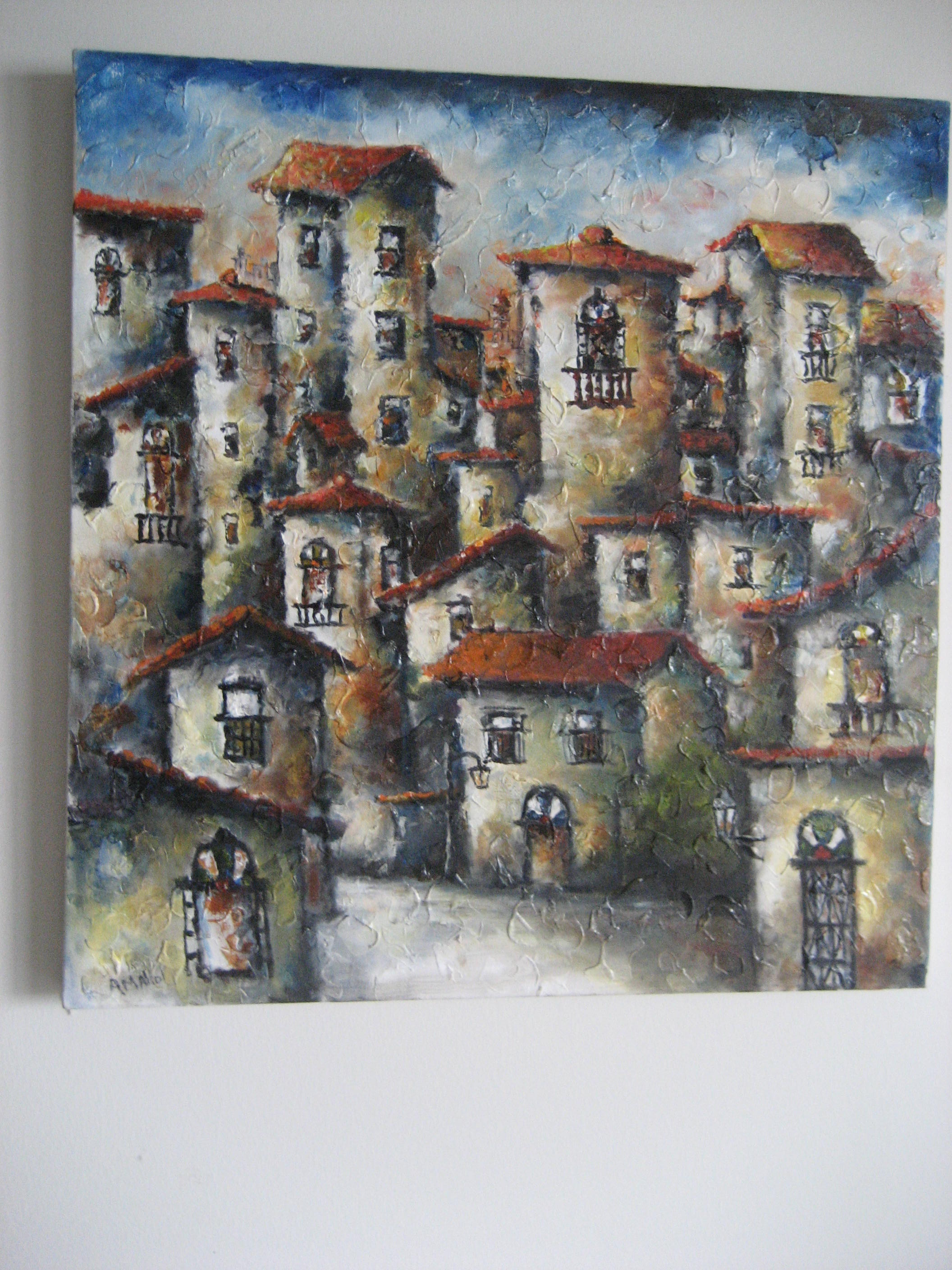
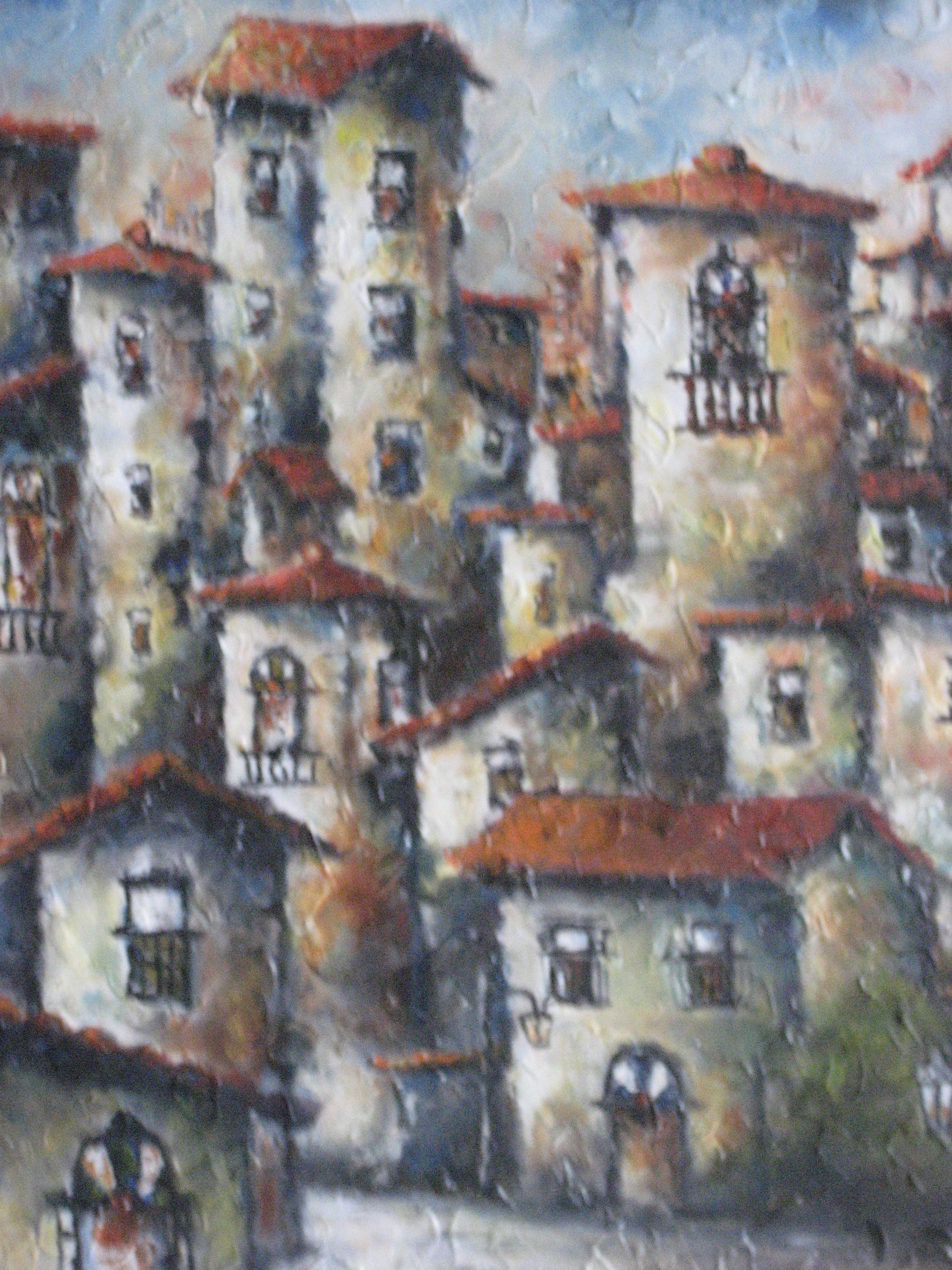
Above painting by Adolfo Mallol - 2014 (Calle Ocho Cuban artist), (30 in. X 32 in.)
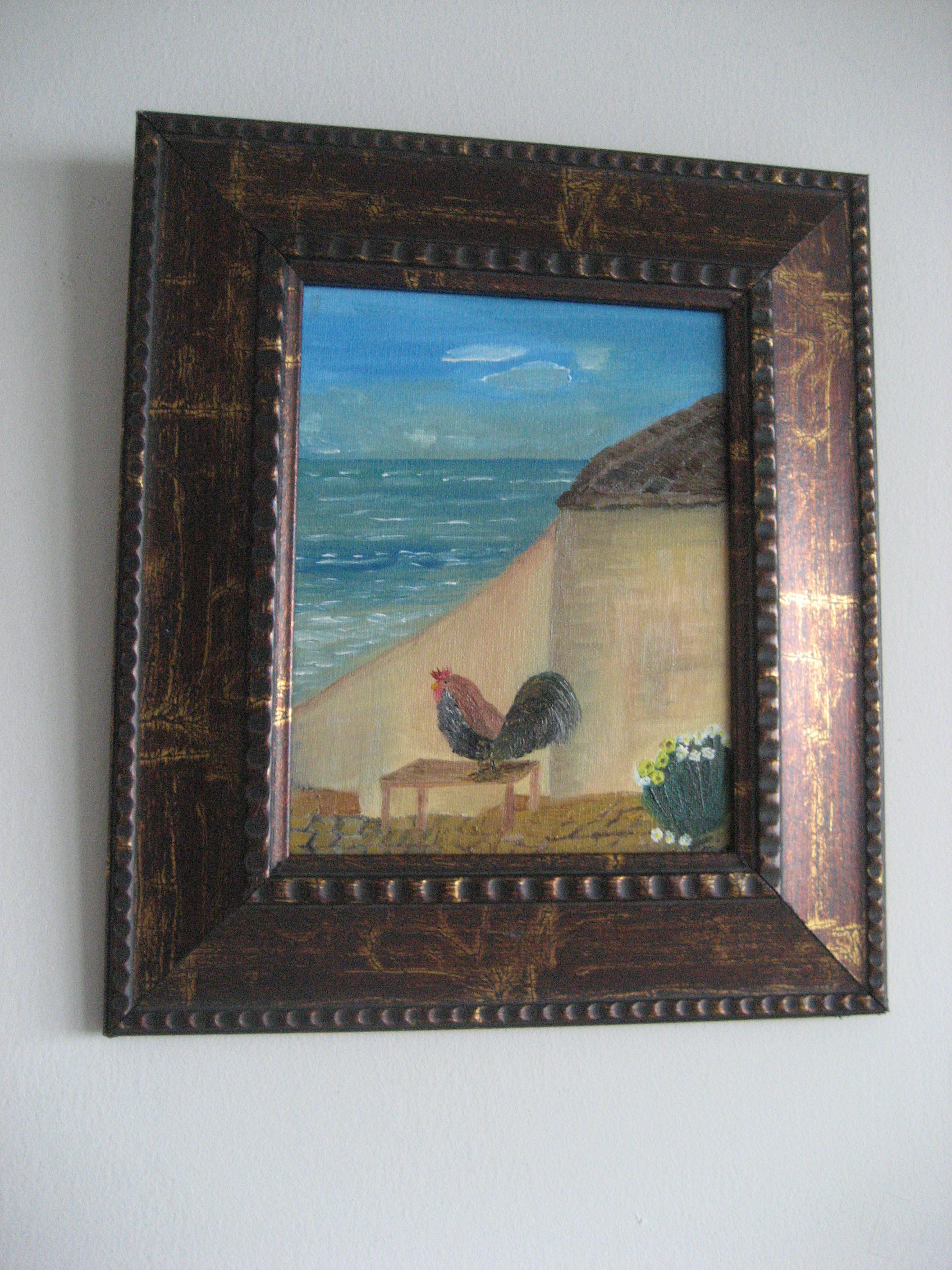
No. 1 (8 in. X 10 in.) : Painting by Tania - 2015 (Calle Ocho Cuban artist)

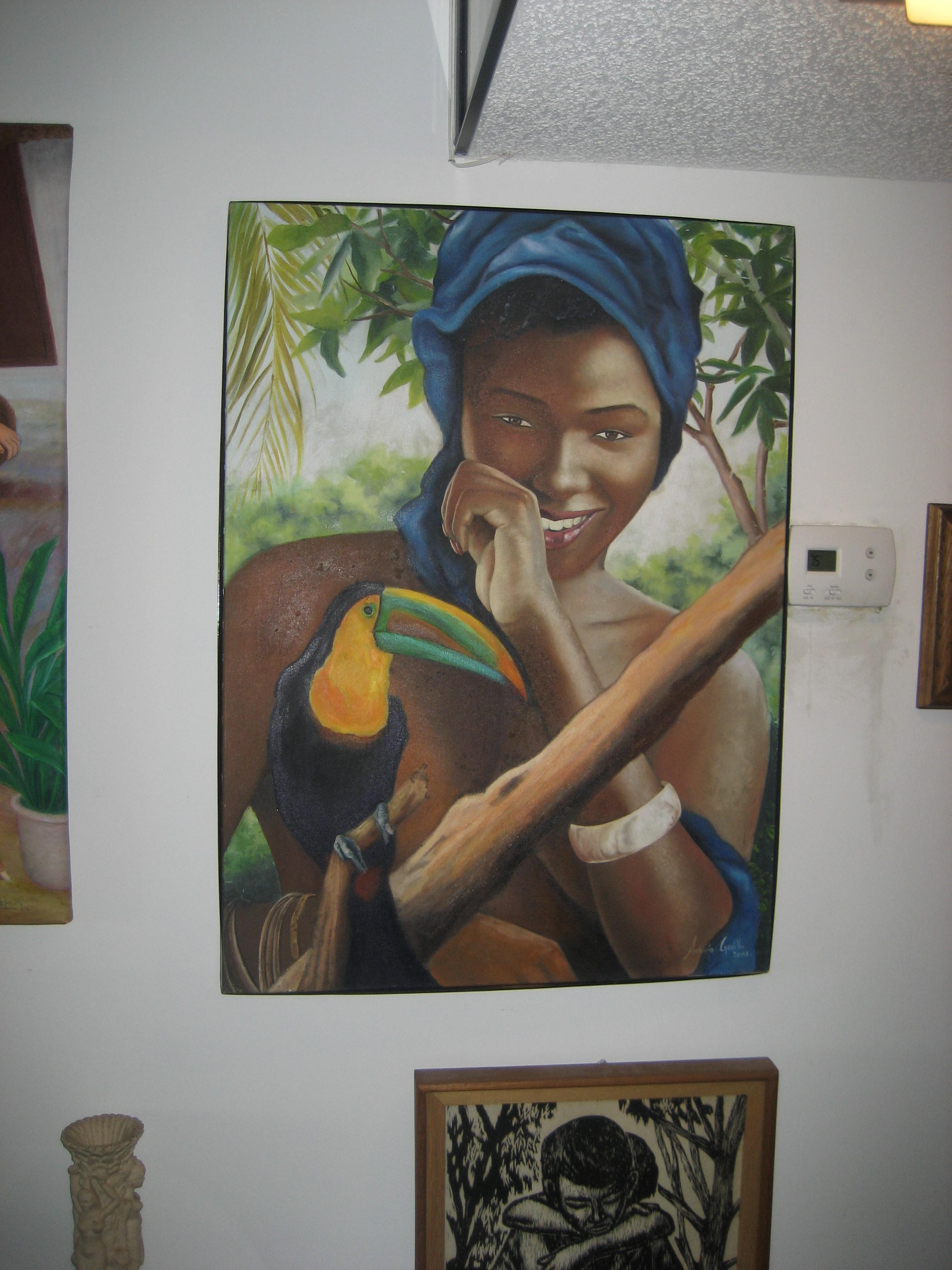
Above painting by Antonio Garrillo - 2002 (Calle Ocho Cuban artist), (26 in. X 35 in.)
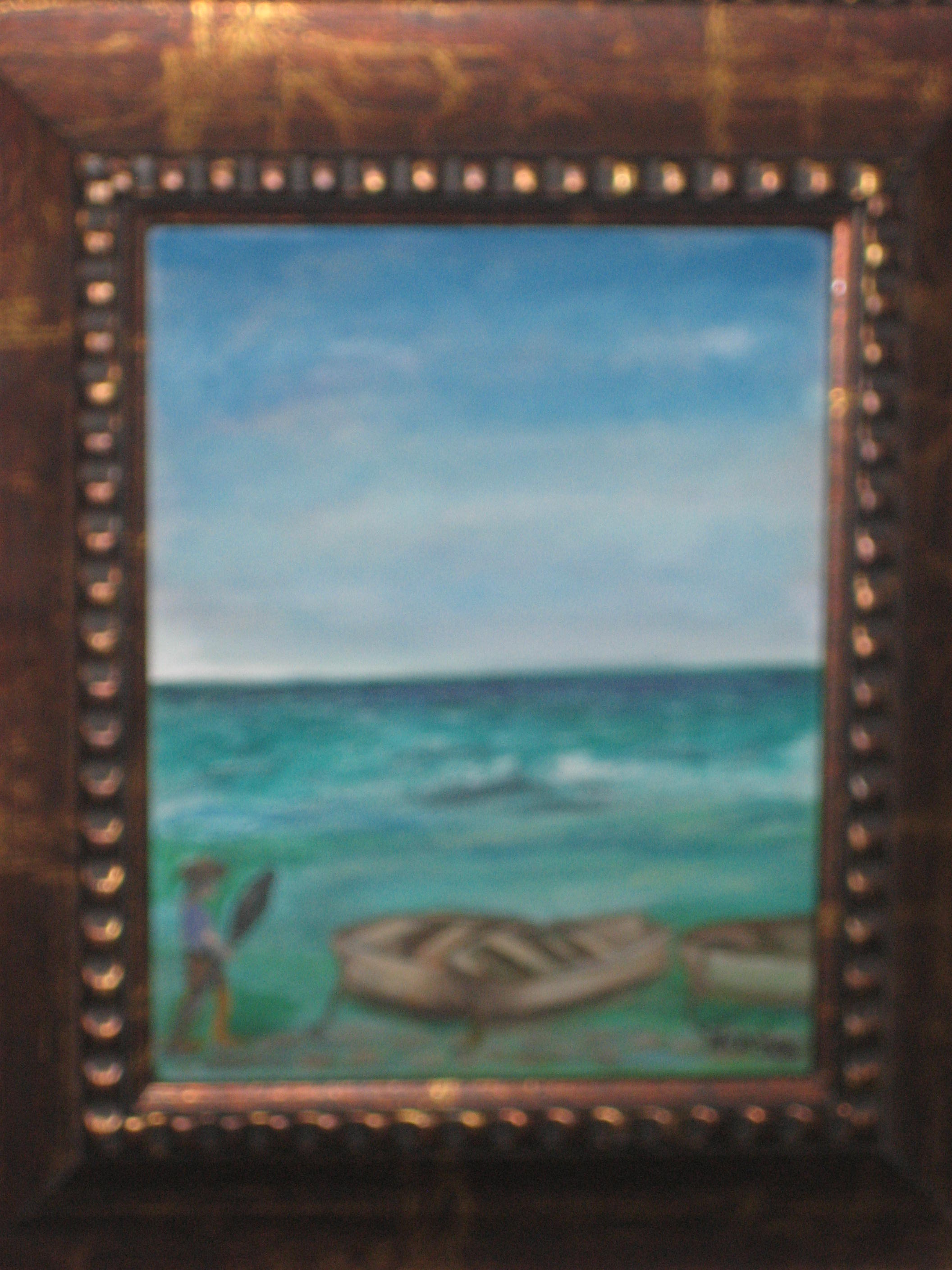
(8 in. X 10 in.)
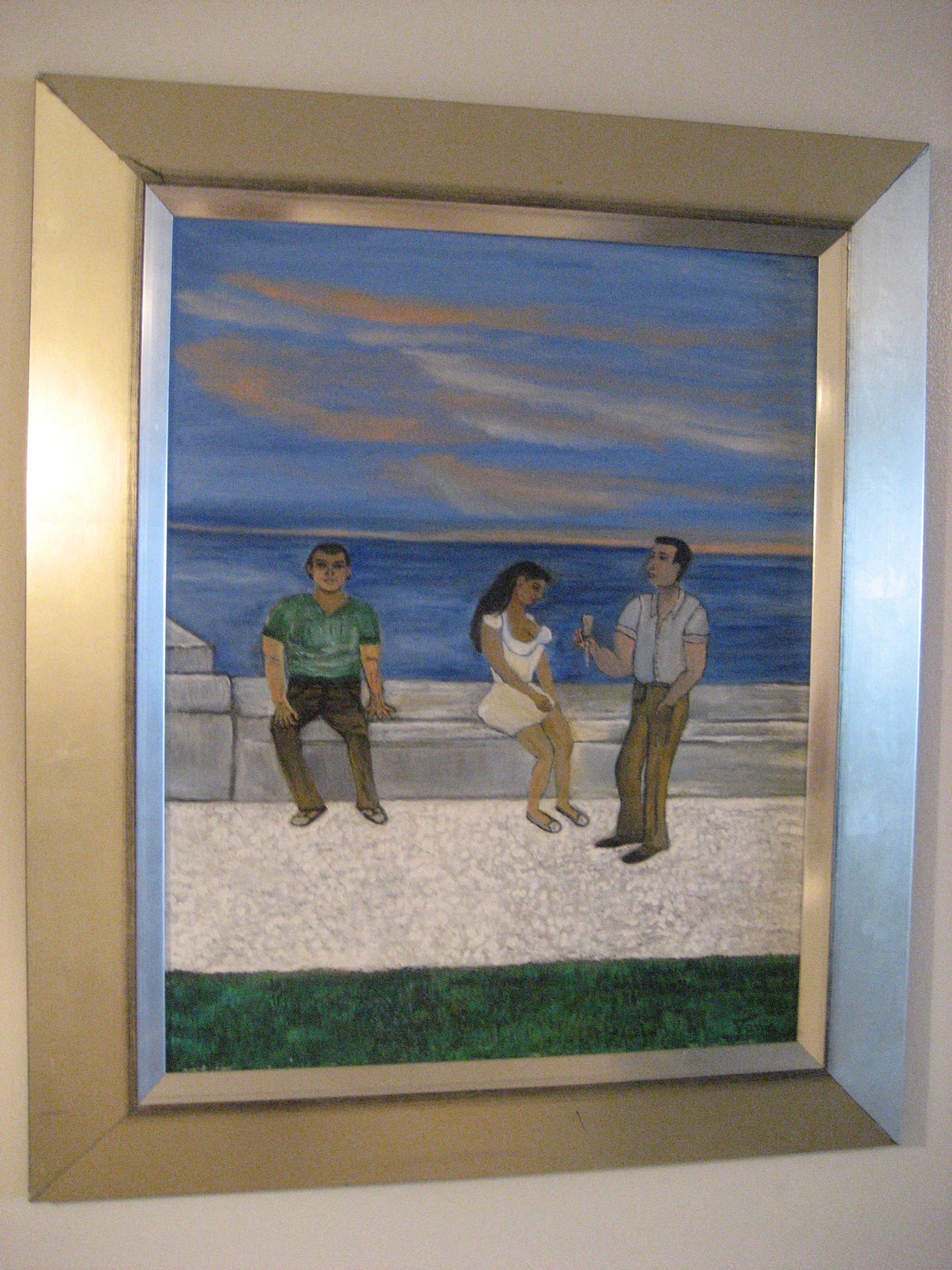
(16 in. X 20 in.)
Above: Two small paintings by Tania -2014 (Calle Ocho Cuban artist)

Painting by Aniel La Rosa Abascal - 2015 (Calle Ocho professional Cuban artist), (24 in. X 30 in.)
This painting can be better seen among the first ones the artist has in his website: aniel-art.blogspot.com
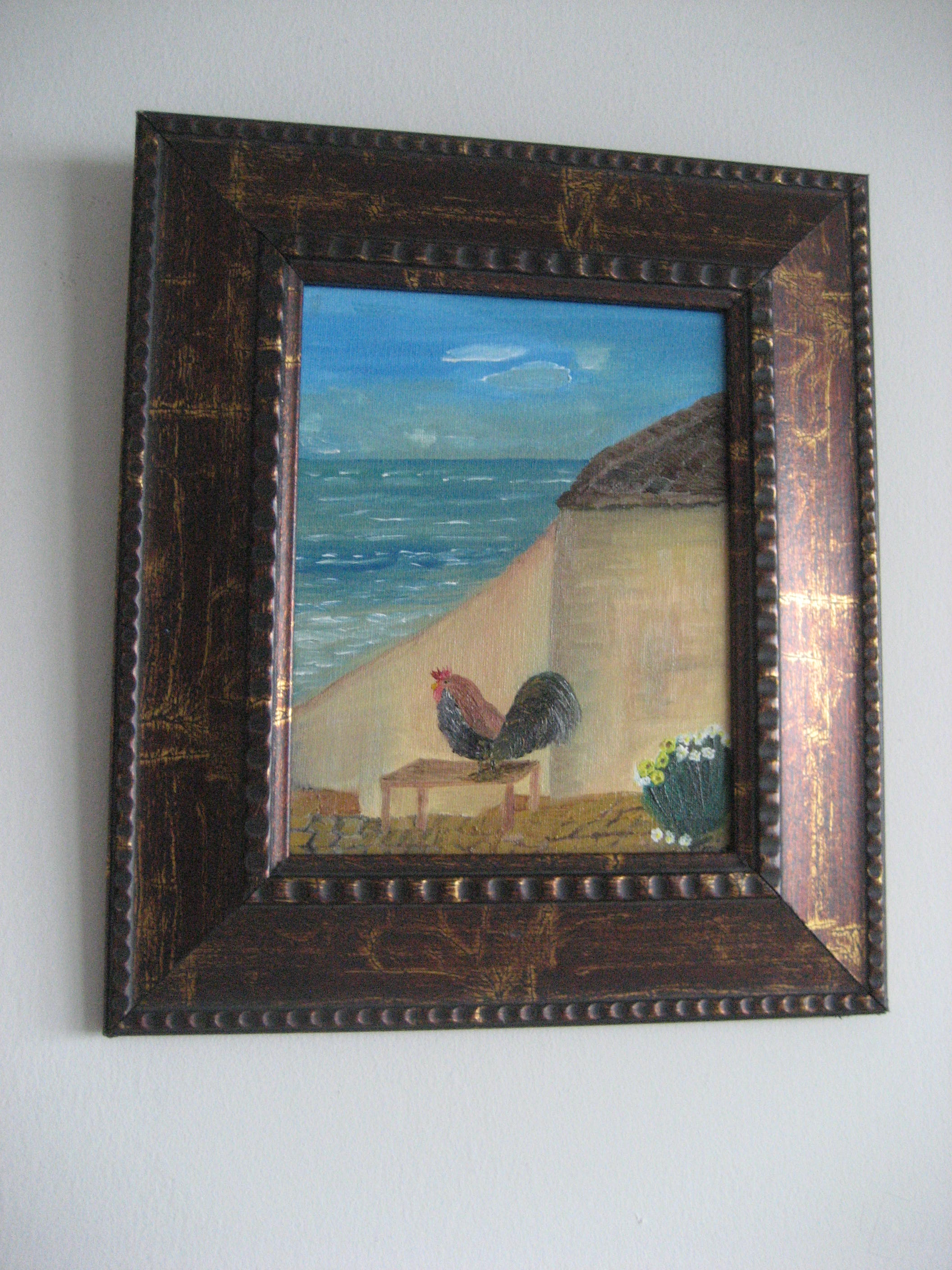
Painting by Tania - 2015 (Calle Ocho Cuban artist), (8 in. X 10 in.)
Paintings from Africa, Europe,
and Asia

Two handmade wood carving creations from Bali, Indonesia (12 inches high)
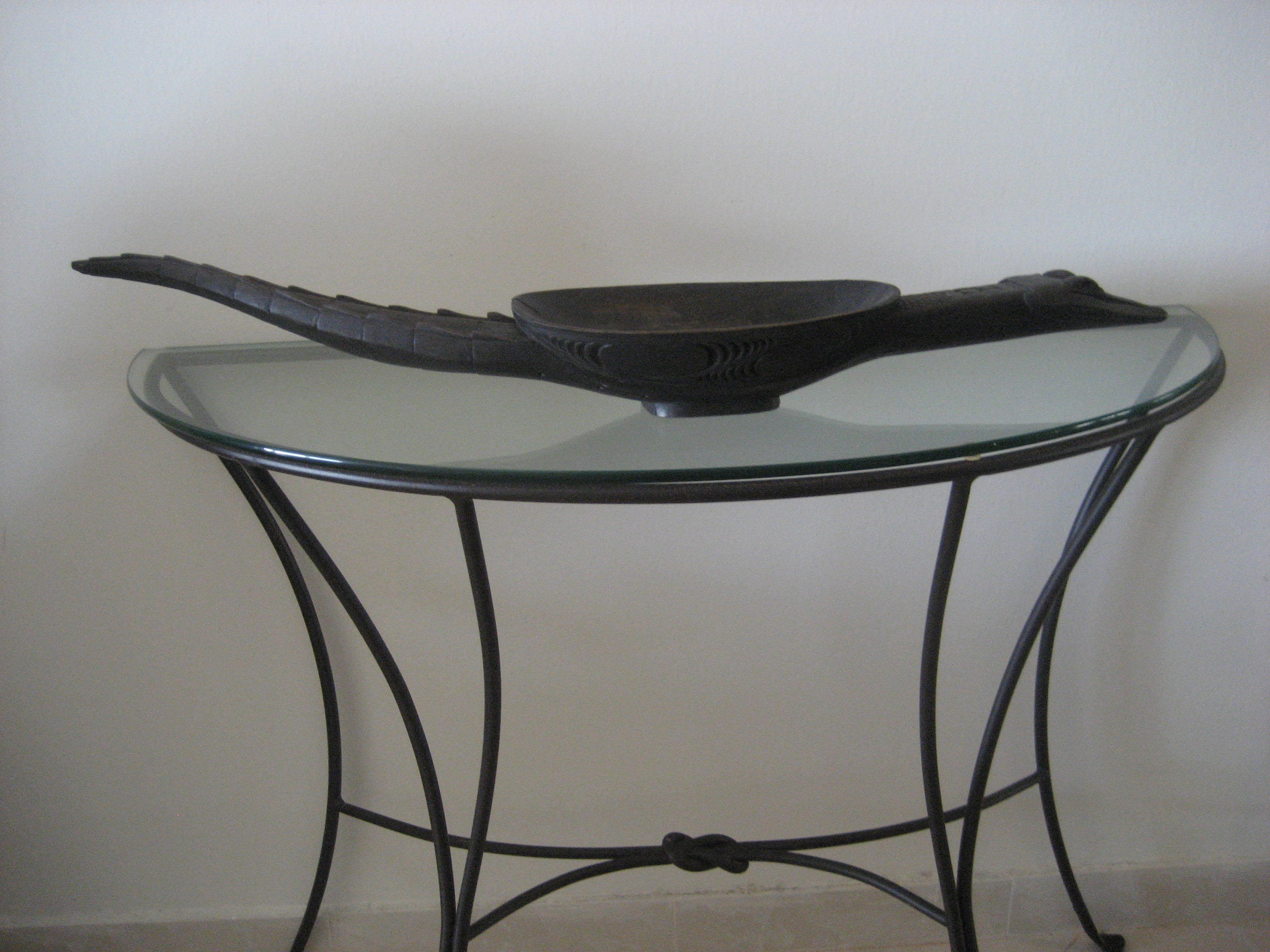
Hand carving from Africa on a table near the entrance door. The bowl in its center is used to place business cards. It shows a serpent that would keep away undesirable visitors (34 inches long).
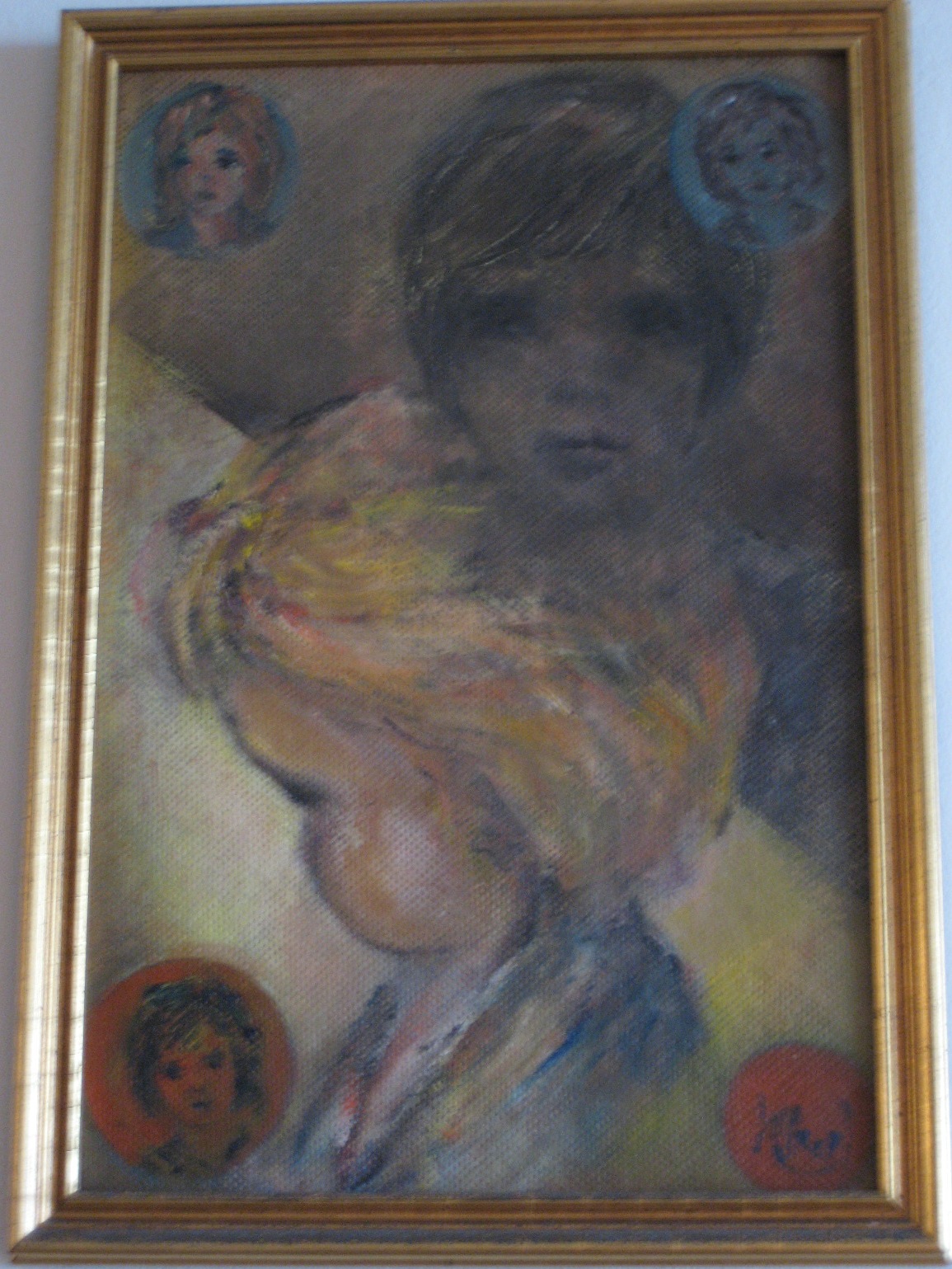
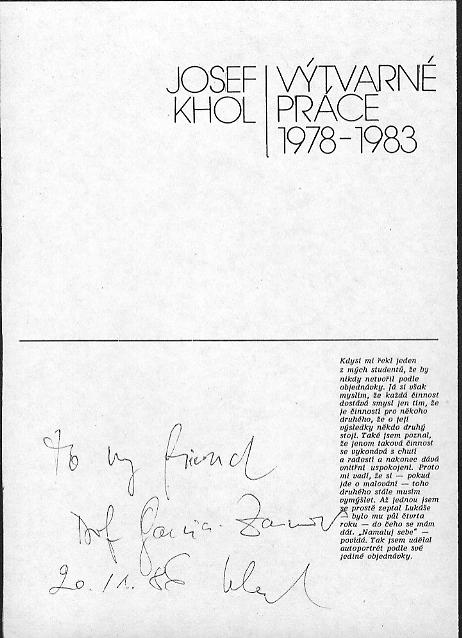
In 1986, I spent a
week in Prague, Czechoslovakia (now the Czech Republic) visiting with
the former Czechoslovakia Academy of Sciences. The painting on the left
is from Dr. JOSEF KHOL who was then the Director of the Academy and a
member of the Supreme Politburo (Governing Council of the country under
Soviet rule). In addition, Dr. Khol was the Vice-Director of the
Institute of Psychology. According to Wikipedia, he was only one
of 31 citizens from Czechoslovakia to have received the title of “Hero
of the Czechoslovak Socialist Republic” (an honor established in 1955).
An accomplished artist, he has held several one-man exhibits in
Czechoslovakia. The first day of my visit at the Academy, I saw him in
his office and told him how much I liked the paintings on the wall. I
asked him who the artist was. He proudly told me he was and gave me a
program of his latest exhibit that had several photos of his paintings
(copy of the first page of the program is shown above). On the last day
of my visit at the Academy, he surprised me by giving me the original
painting on the left. It is an OIL ON CARDBOARD, 9 ½ in. by 14 in.
Since during the Communist rule it was prohibited to take original art
out of the country, he inscribed on the back of the painting “To J-C
Garcia-Zamor, Josek Khol, September 18, 1986”. The little children on
the paintings (center and in the medallions in each corner) are all his
grandchildren. In giving me the painting he said to me “Since I cannot
go and visit Washington, I am sending my grandchildren there.” I never
understood what he meant. I told him then that his painting will always
prominently displayed in my house. Staff at the U.S. embassy in Prague
who had warned me about his anti-Americanism were quite shocked by this
incident.
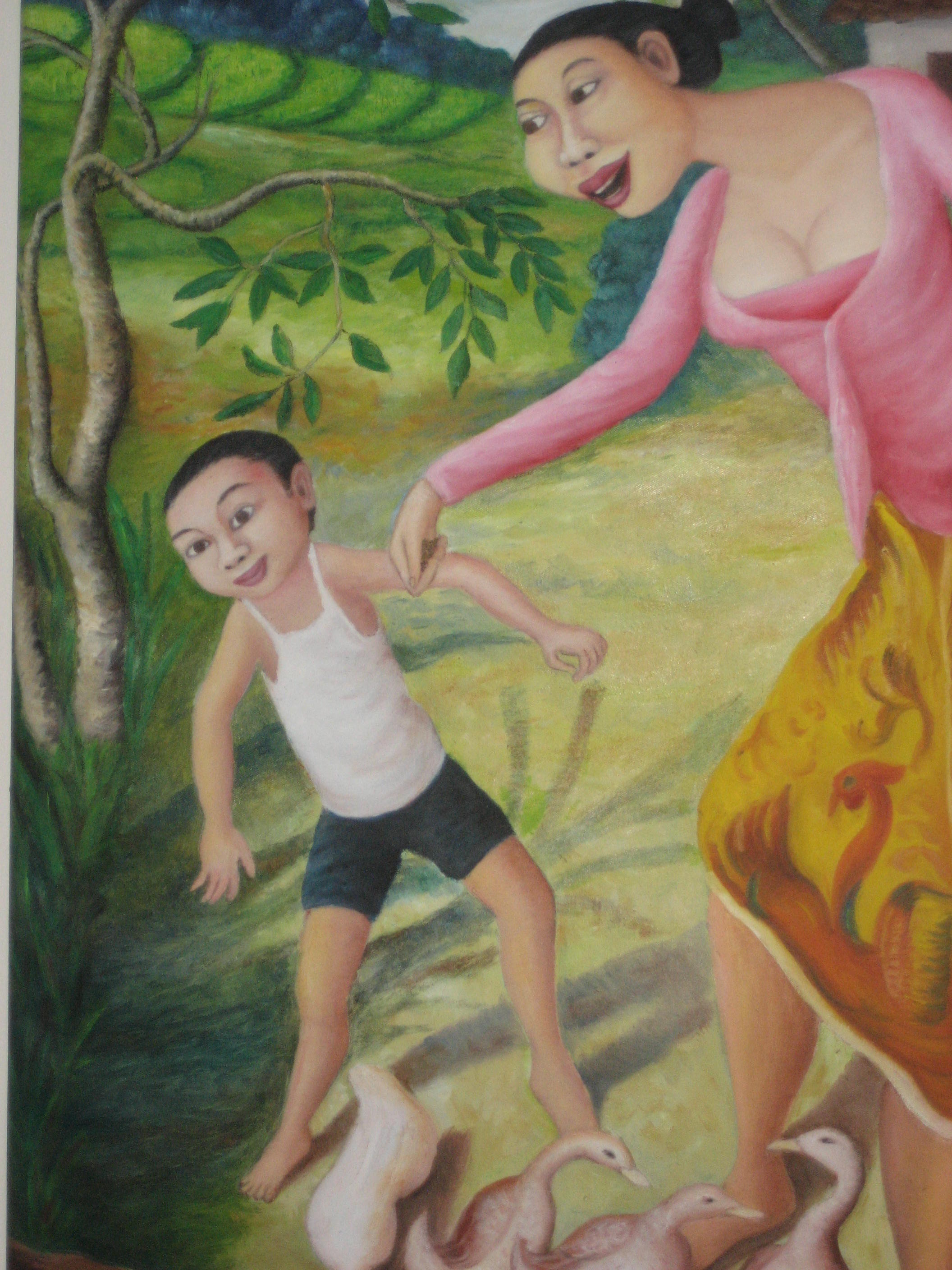
Painting by Dzimin - 2014 (Bali, Indonesia artist - a gift from Christabel), (26 in. X 34 1/2 in.)
Art from Germany
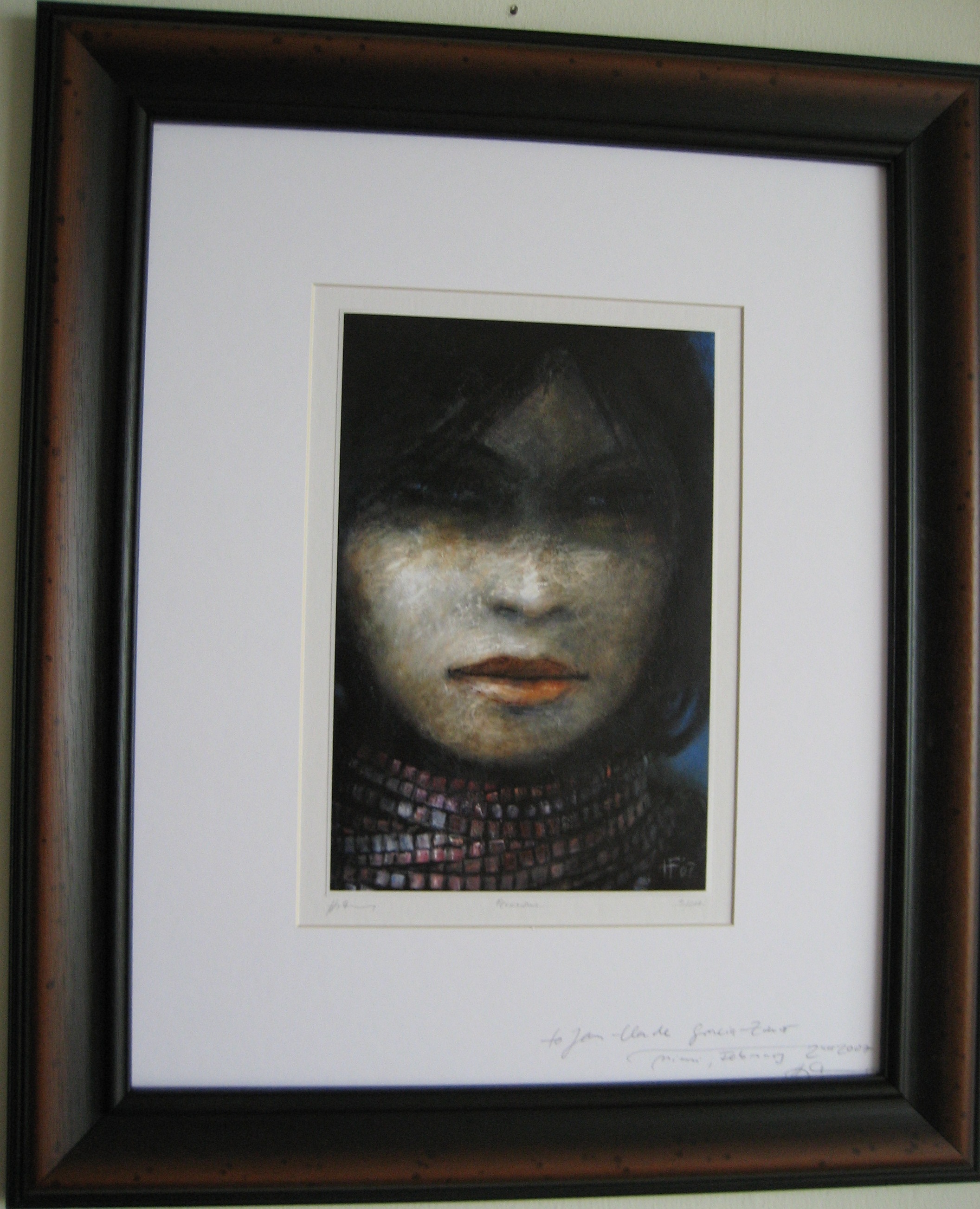
The above hand-reproduced print, numbered 3/100 and
signed by the artist, is a remarkable work. The artist, HANS FEYERABEND,
resides presently in Miami but he was born and raised in East Berlin. He
was living literally in the shadow of the Wall and could not avoid
seeing it everyday of his life. He used to be dreaming of what life
would be on the other side. He came to Miami in 1998. In addition to his
signature on the print, the artist also autographed the above work for
me on the matting frame on February 2, 2007 when I bought it at his
one-man show at the Alliance Française of Miami (see announcement
card on the opposite page). The work is 8 in. by 12 in. and is
displayed in a 16 in. by 20 in. frame, 2007.
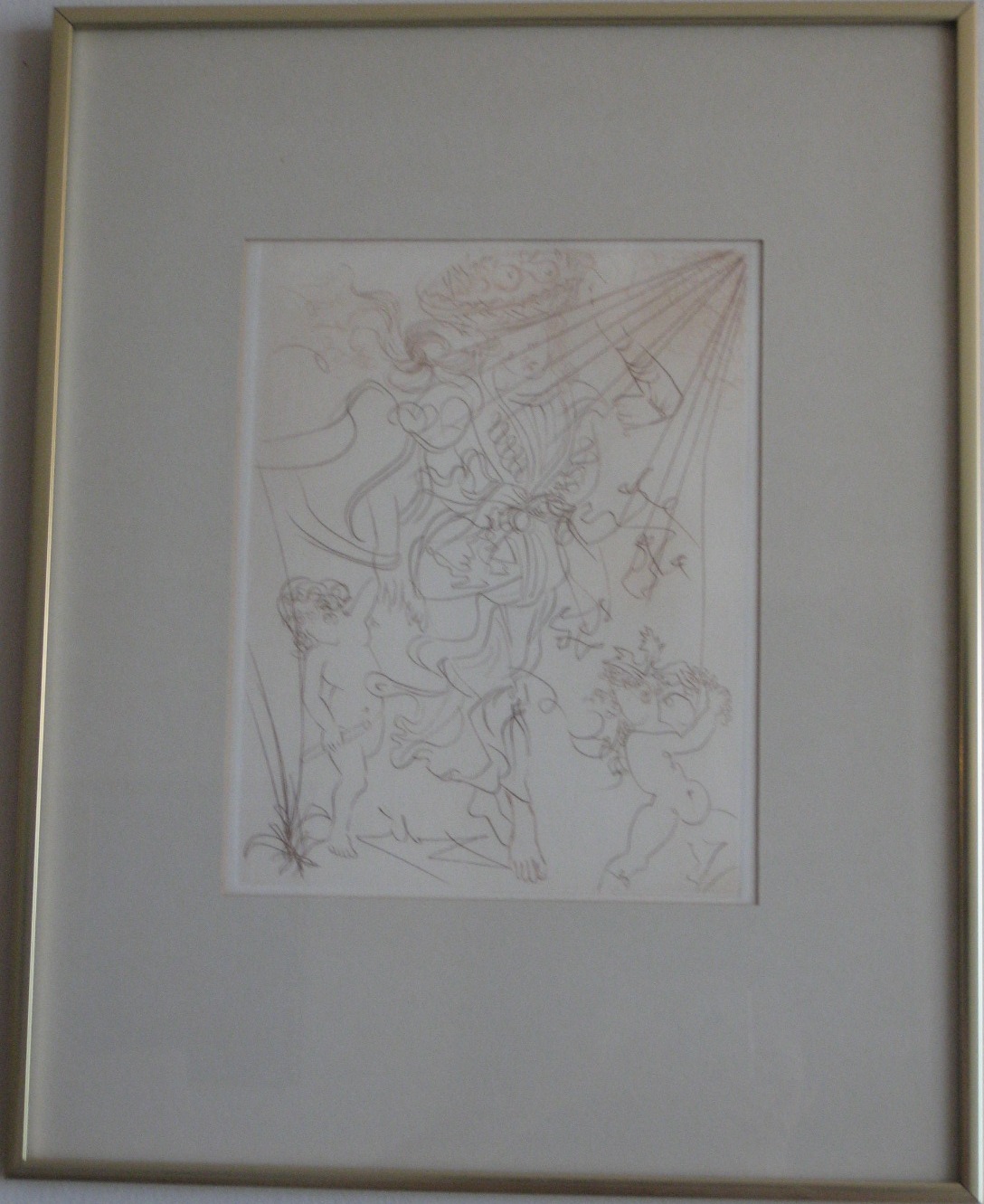
SALVADOR DALI did the above lithograph, 9 in.
by 11 in., 1960s.
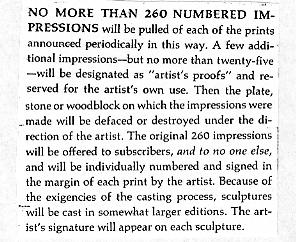
Art from France

RICHARD AIDAN made the above collage with discarded
posters after the French national elections. The faces of the two major
candidates are superimposed over each other. 16 in. by 20 in., 1993.
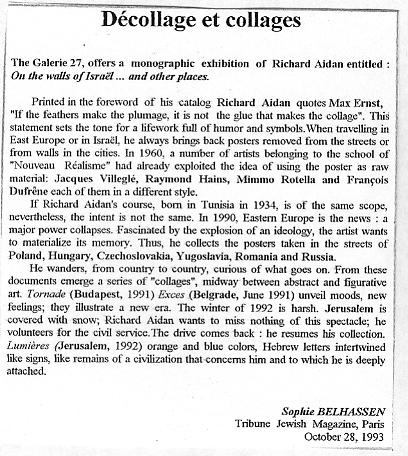
The following four works by the French artist
FRANÇOIS were made in 1970. Each one measures 18 in. by 24 in., Mixed
Media: colored pencil and collage (with classified ads of French
newspapers).
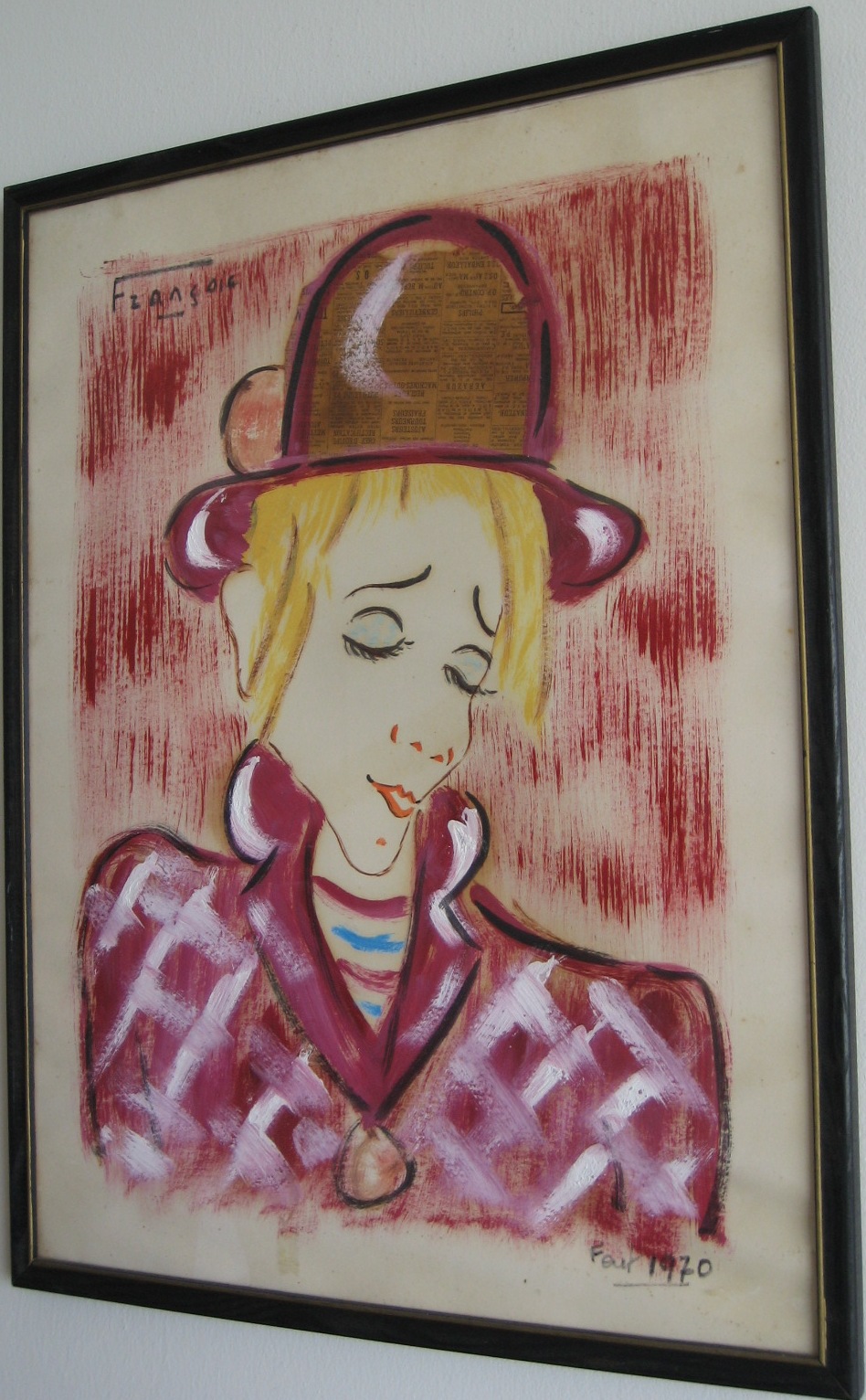
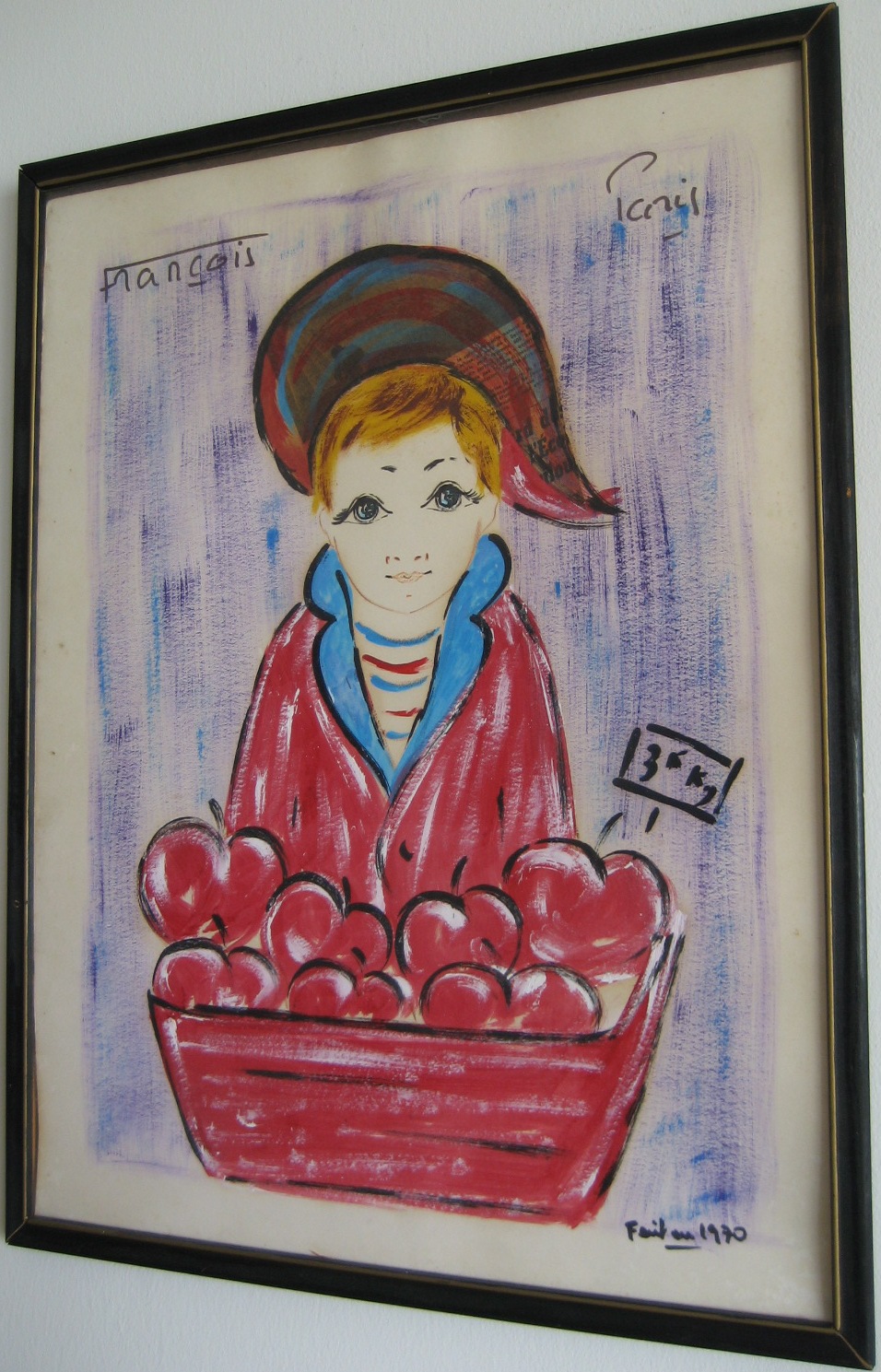
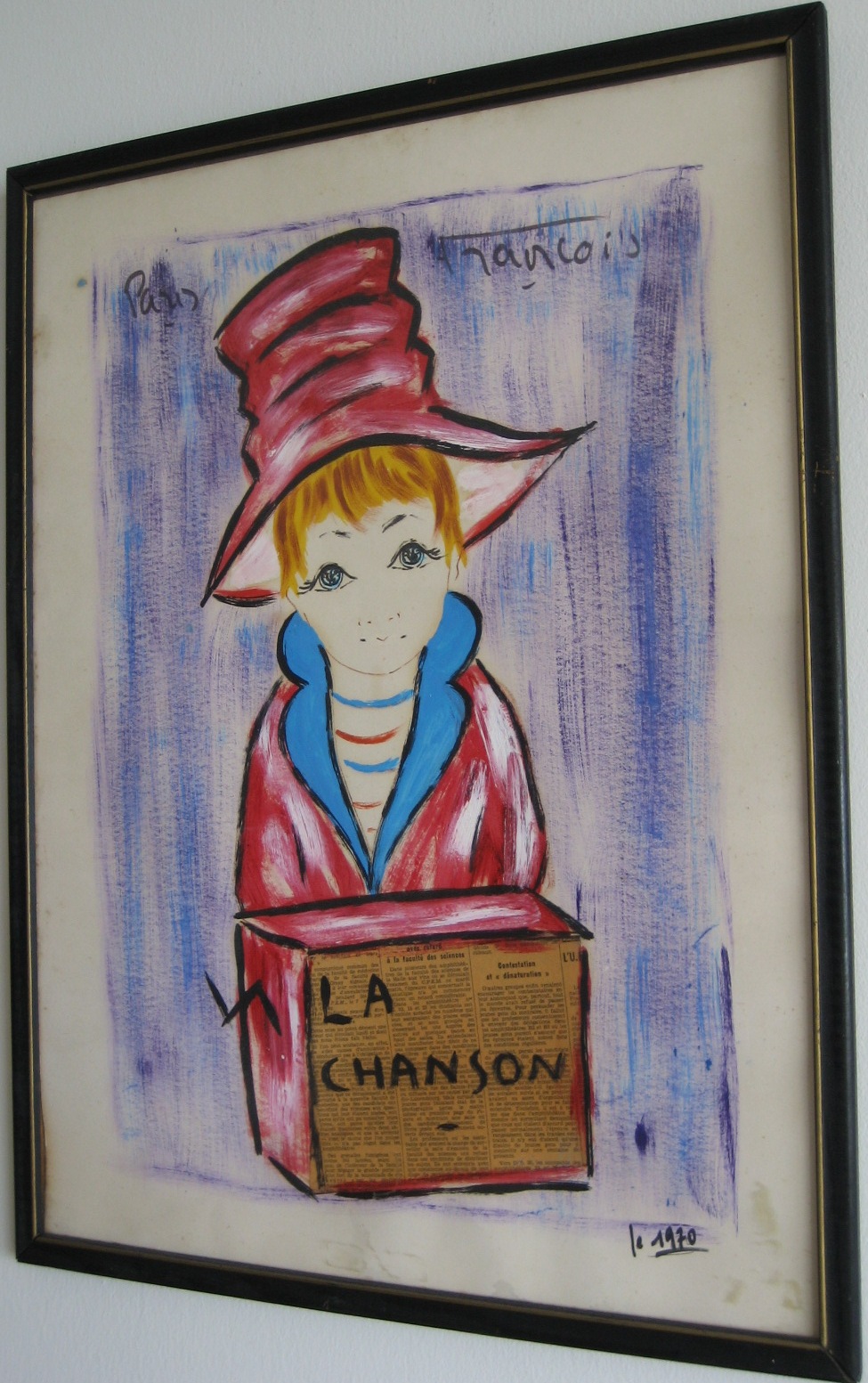
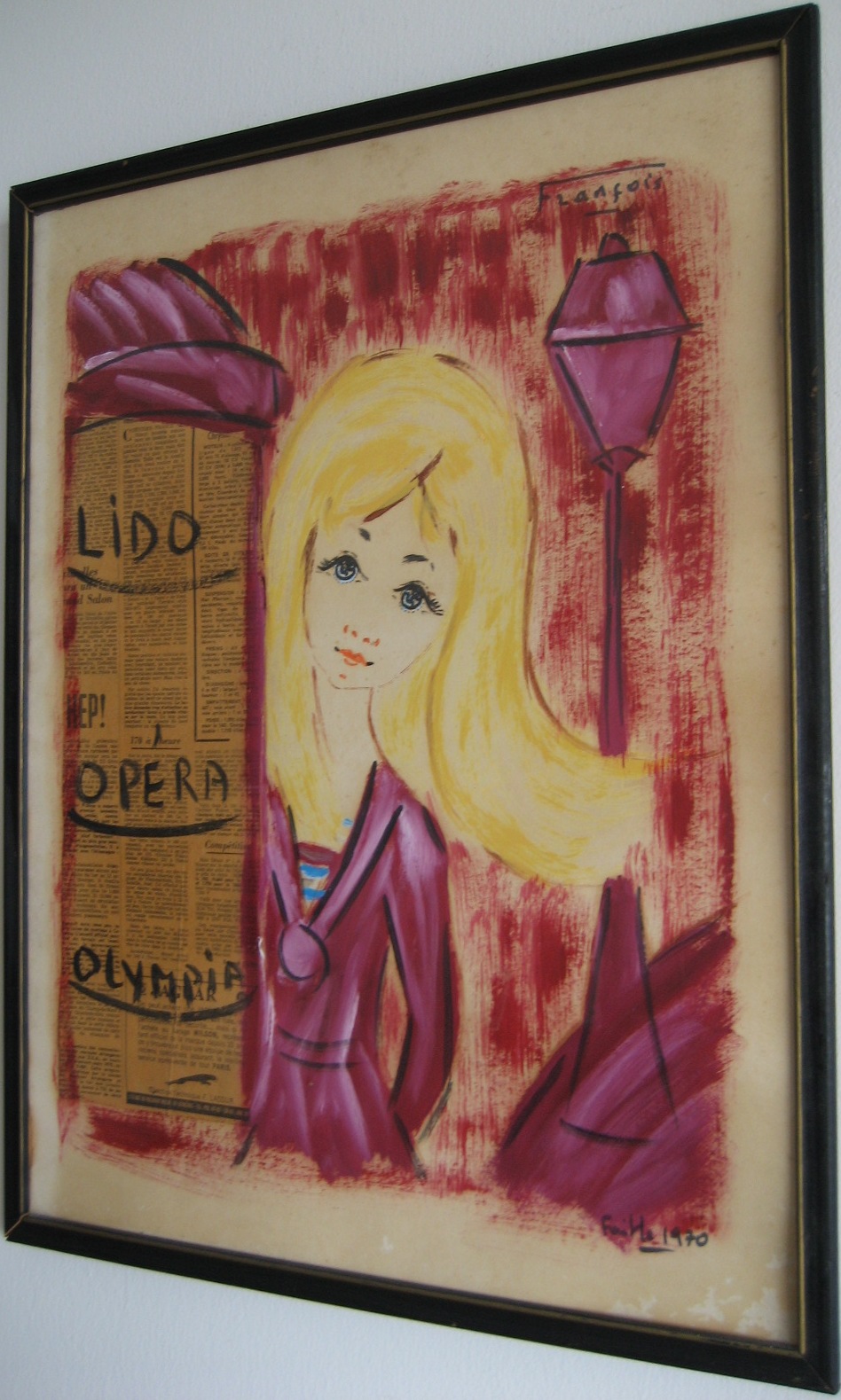
Below is a “sculptured painting” from
French artist Yves Martin. The three musicians are made out of papier
maché and protrude from the frame. Mixed media: oil on wood,
collage, 18 in. by 24 in., 2003.
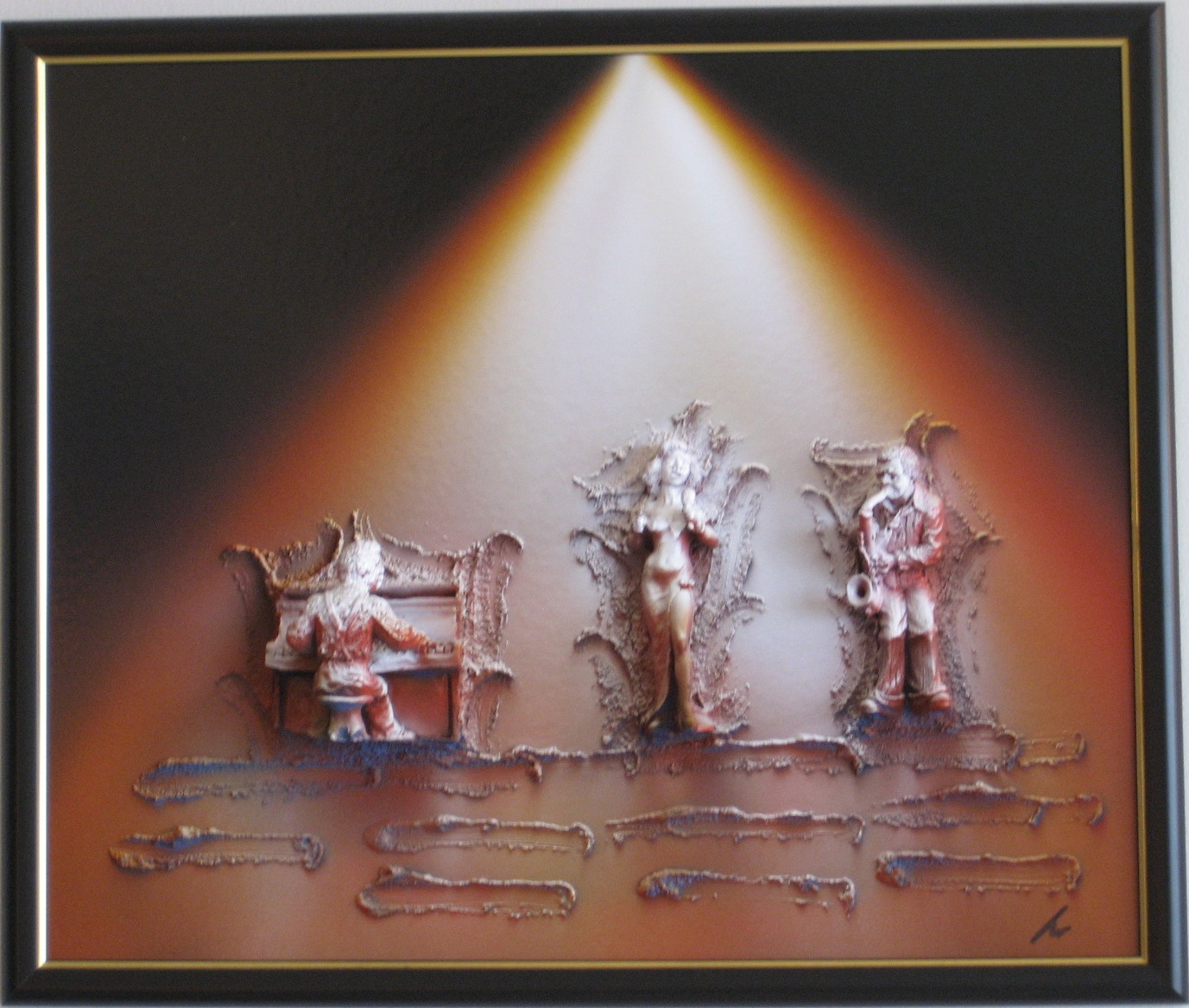
Two Paintings from Africa:
Guinea-Conakri and Uganda
Of the following two paintings, the one on the left is from an artist from
Guinea-Conakri, ANTHONY THEA, oil on canvas, 24 in. by 36
in., 1995. The painting on the right is from an unknown artist from
Uganda. It is in my office at Florida International University,
watercolor, 18 in. by 24 in., 2002.
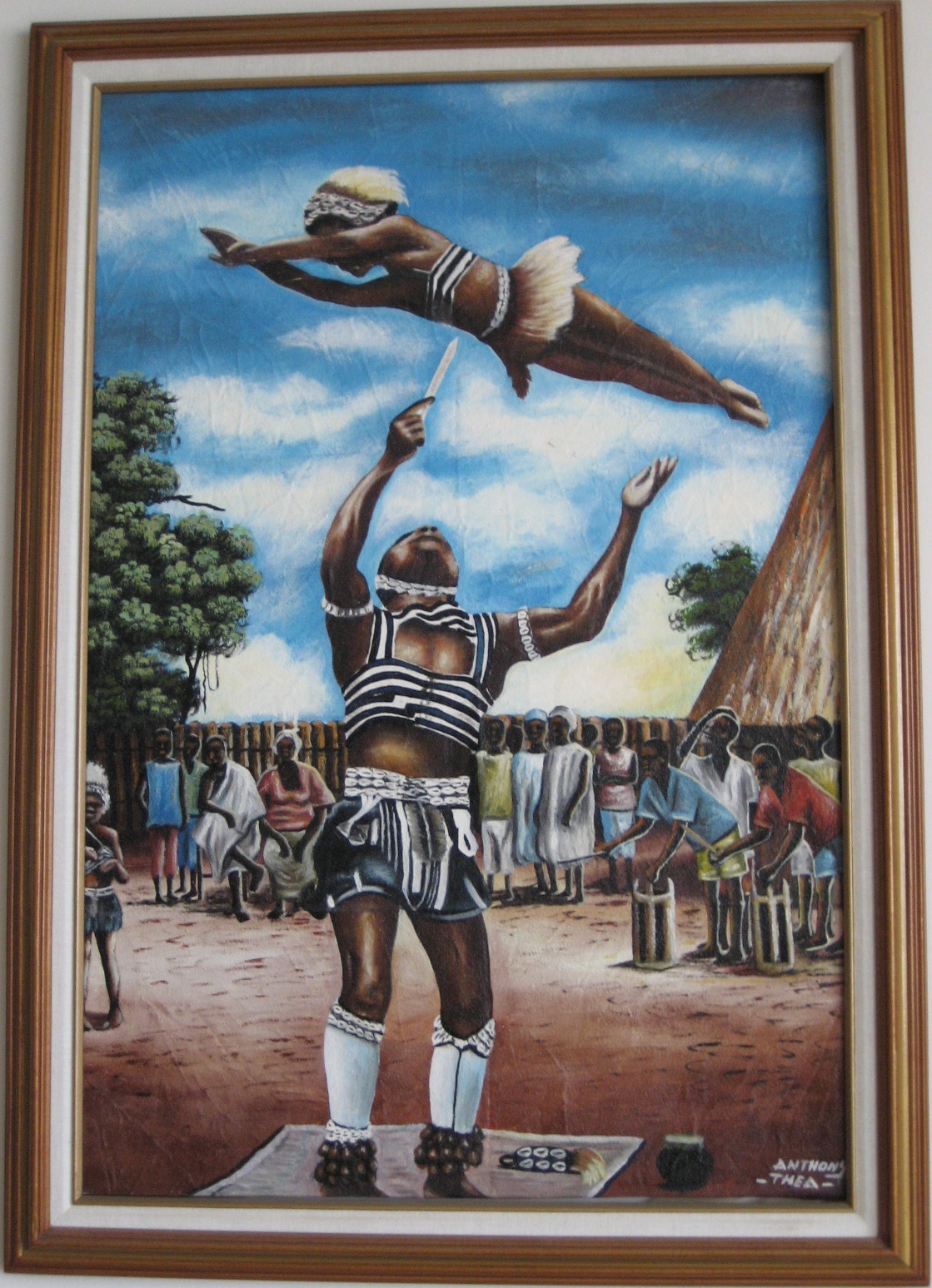
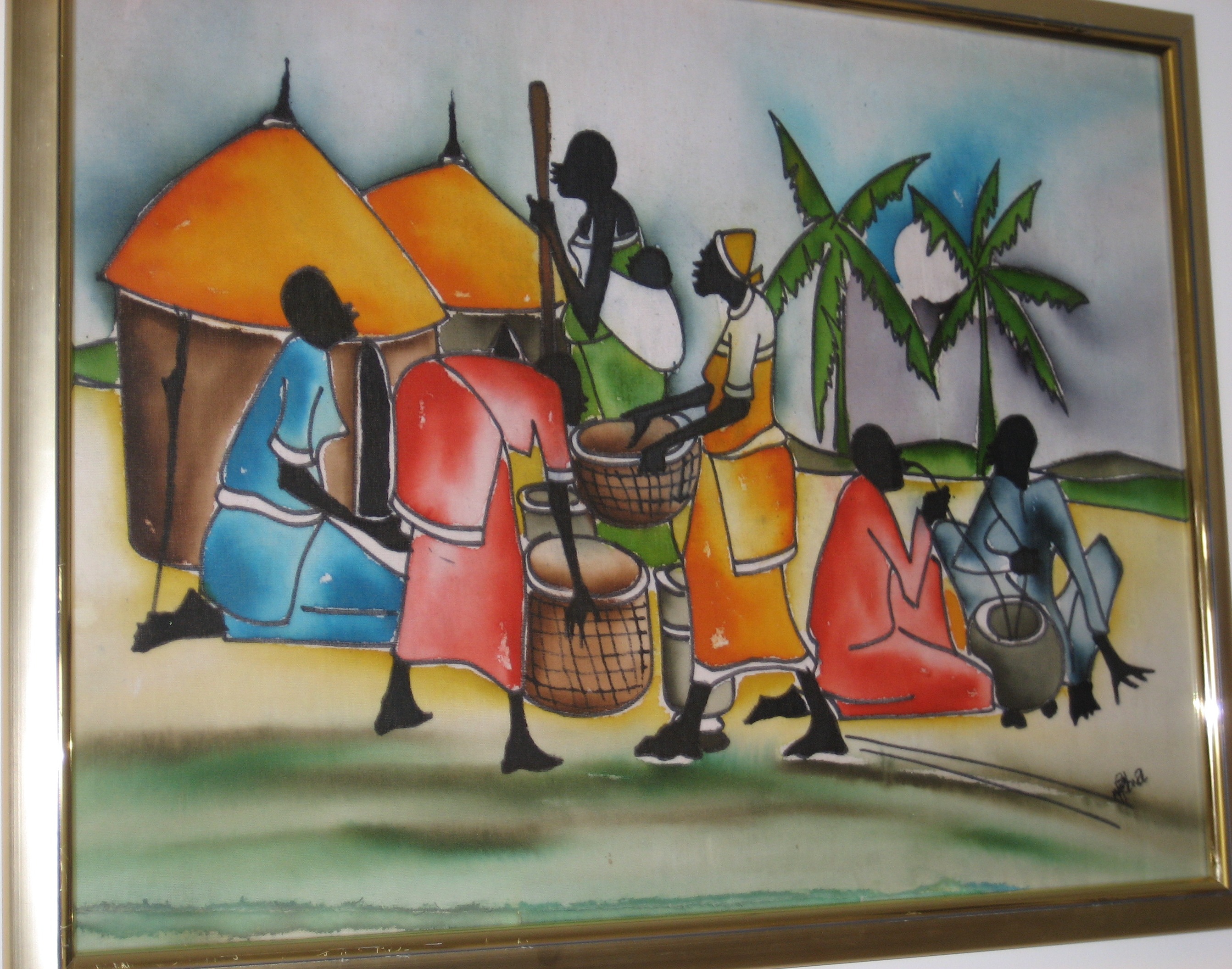
Painting from Africa:
Democratic
Republic of Congo (Zaïre)
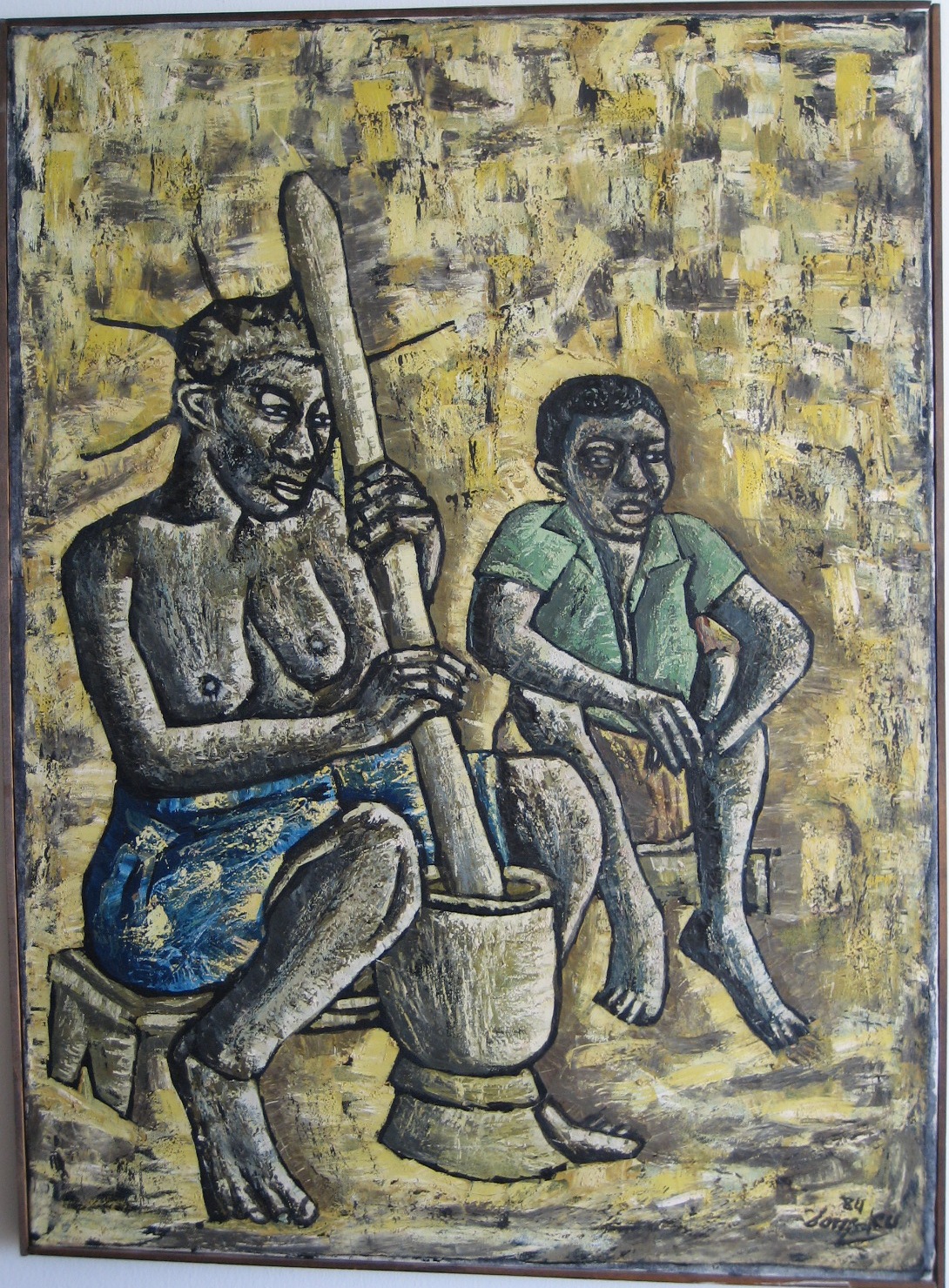
The above painting by BOMKU is an oil on canvas, 30 in. by
40 in., 1984.
Wood carvings, soap stone sculptures, masks,
metal works, and some handicrafts

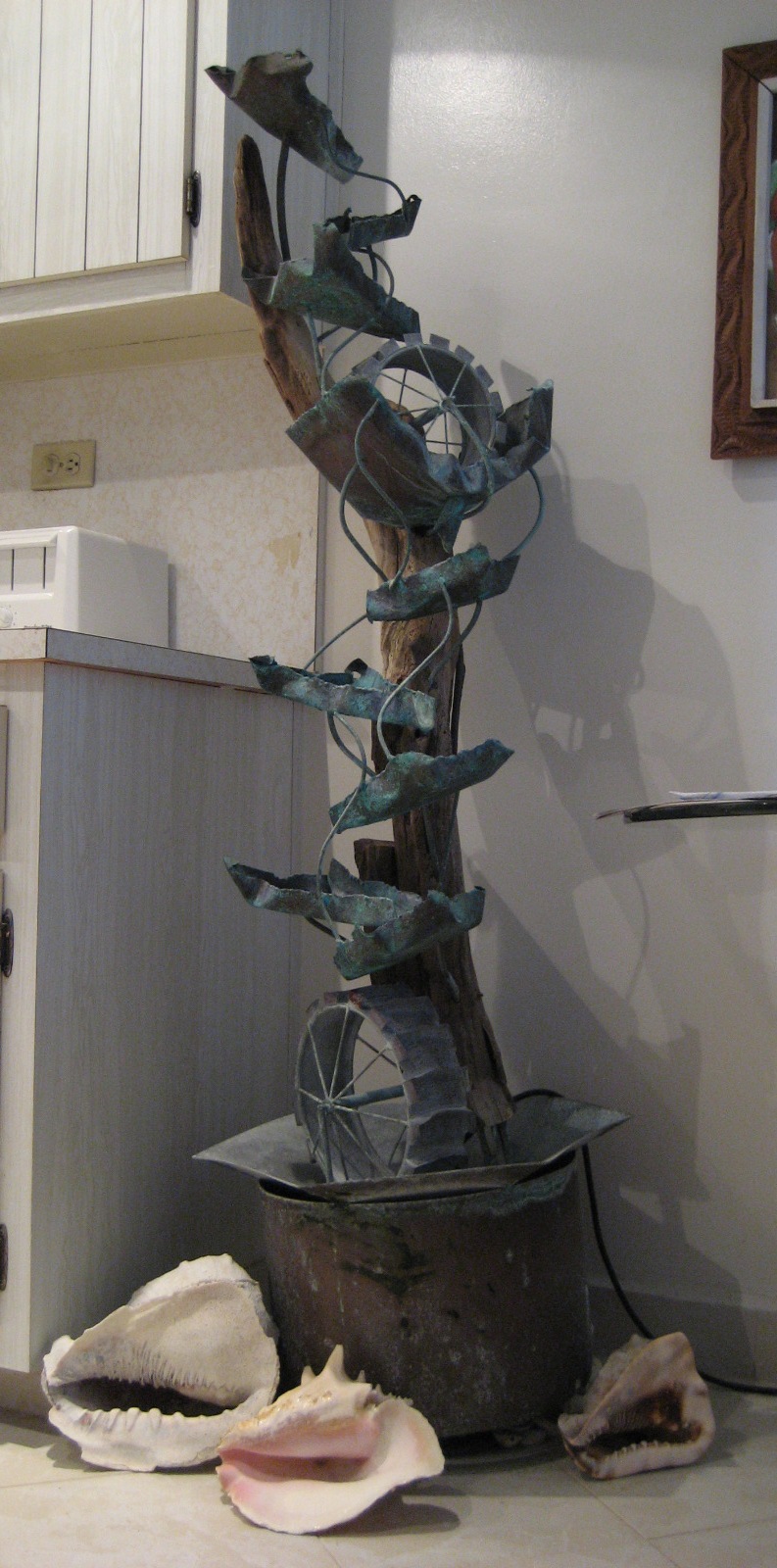

I bought the above ceramic vase in Tunisia. It is 13 in. tall. It was
made in the mid 1980s.
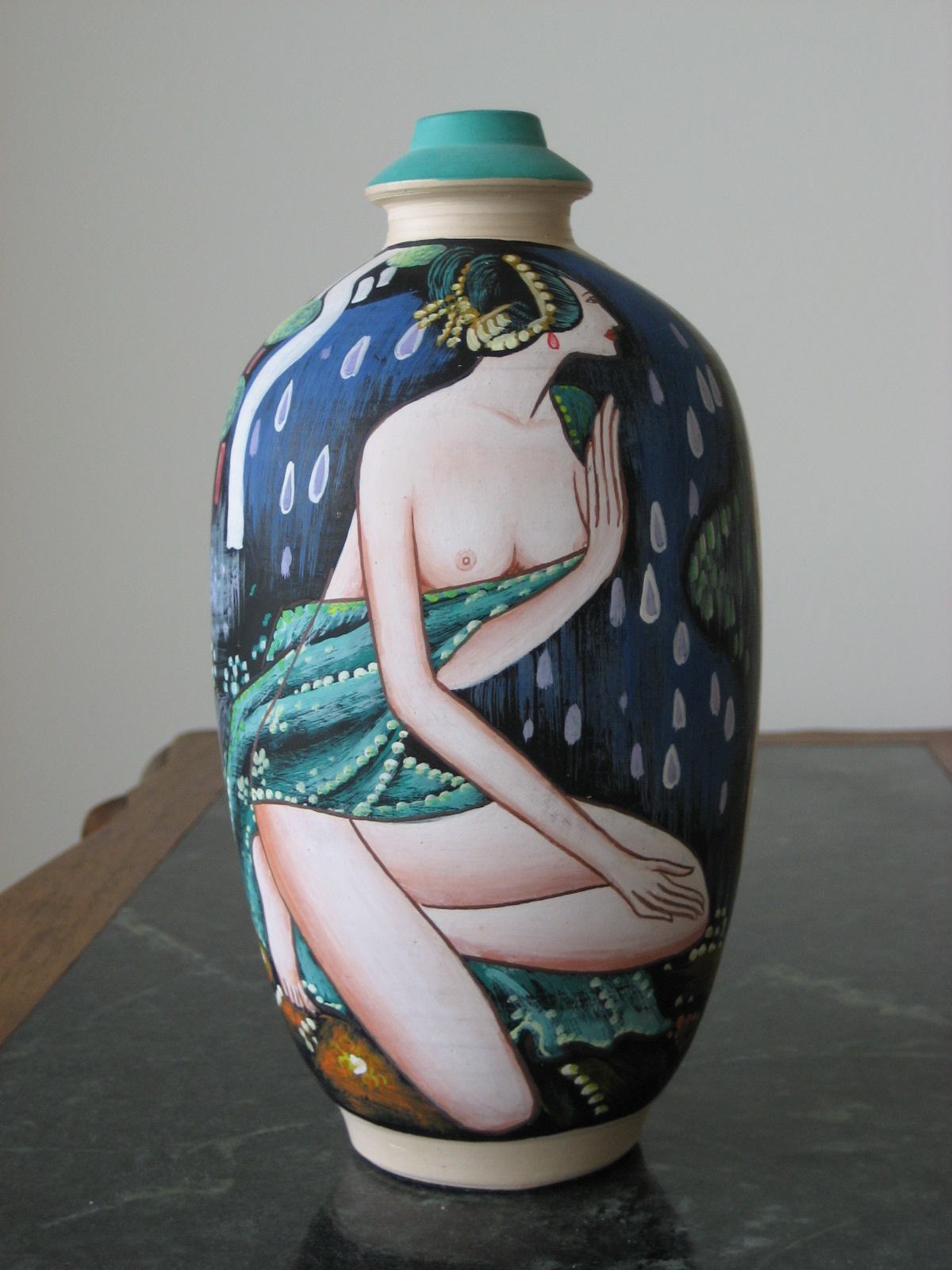
The above hand-painted vase was bought in the People’s Republic of China in
2001. It is 9 in. tall.
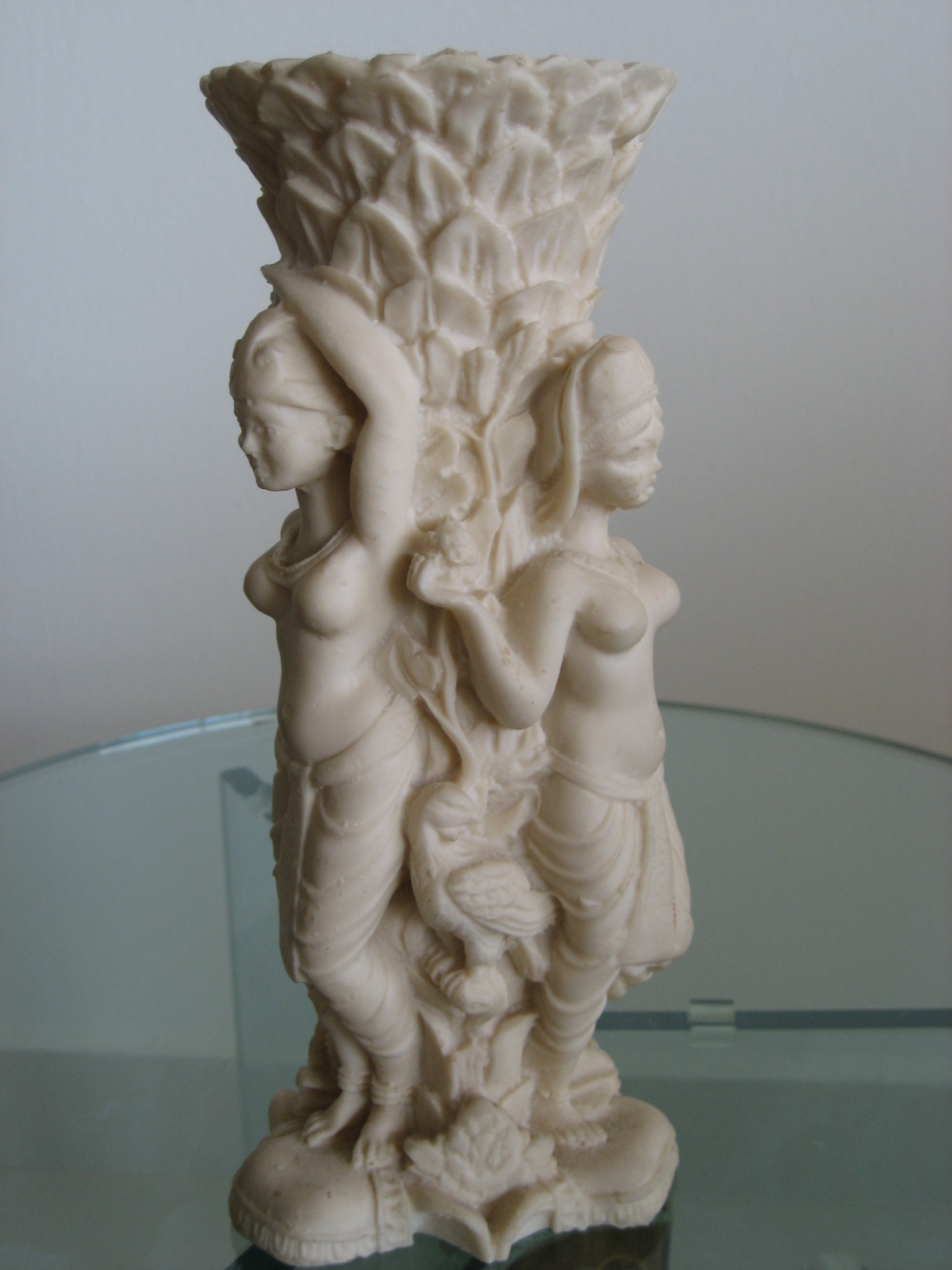
I bought the above ivory vase in the Ivory Coast in Africa. It was made in
the 1970s. It is 8 in. tall
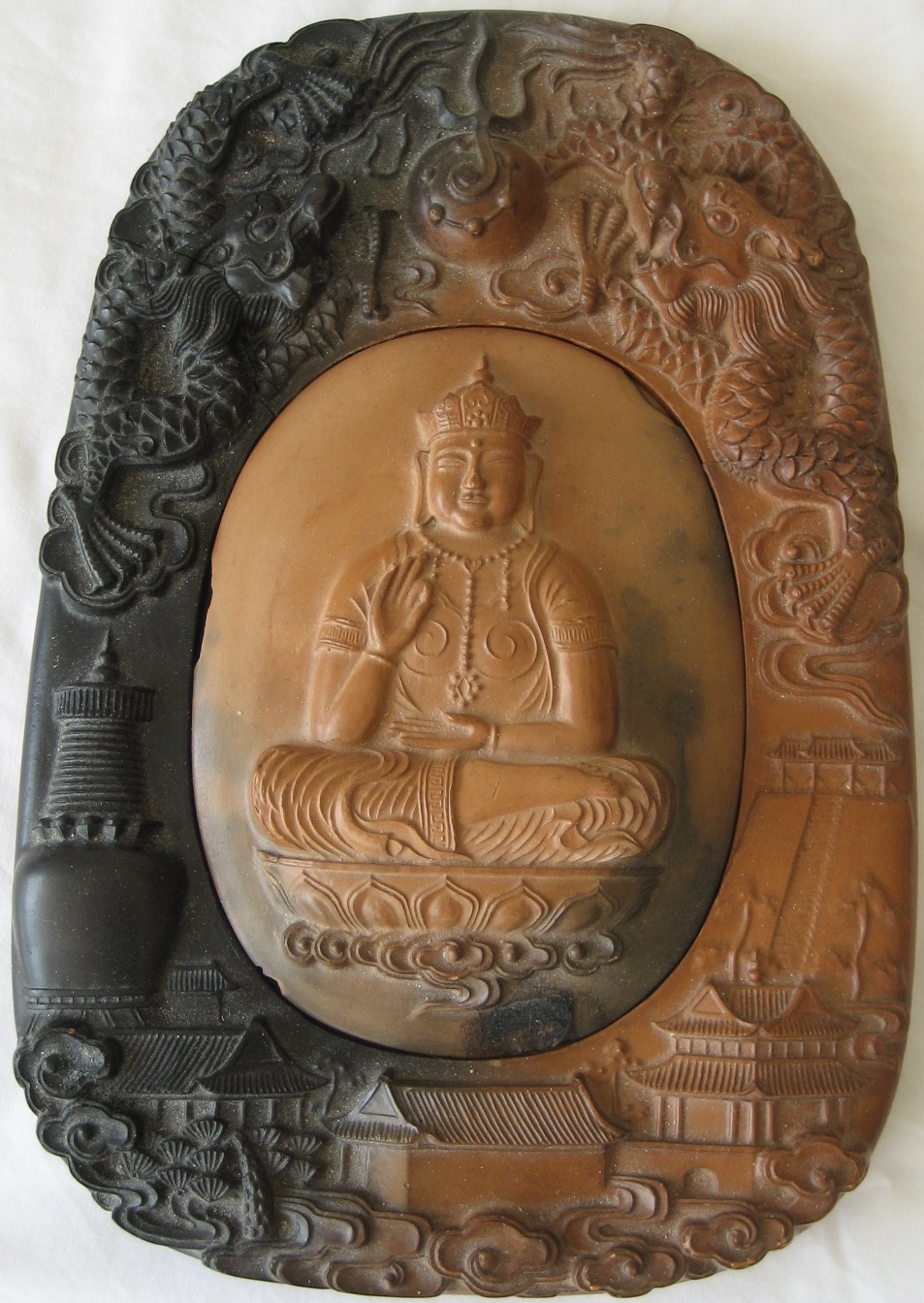
The above
ink holder was bought in China in 2001. The center piece can be removed
to fill the interior with ink. It is
made of terra cotta and is 10 in. long.
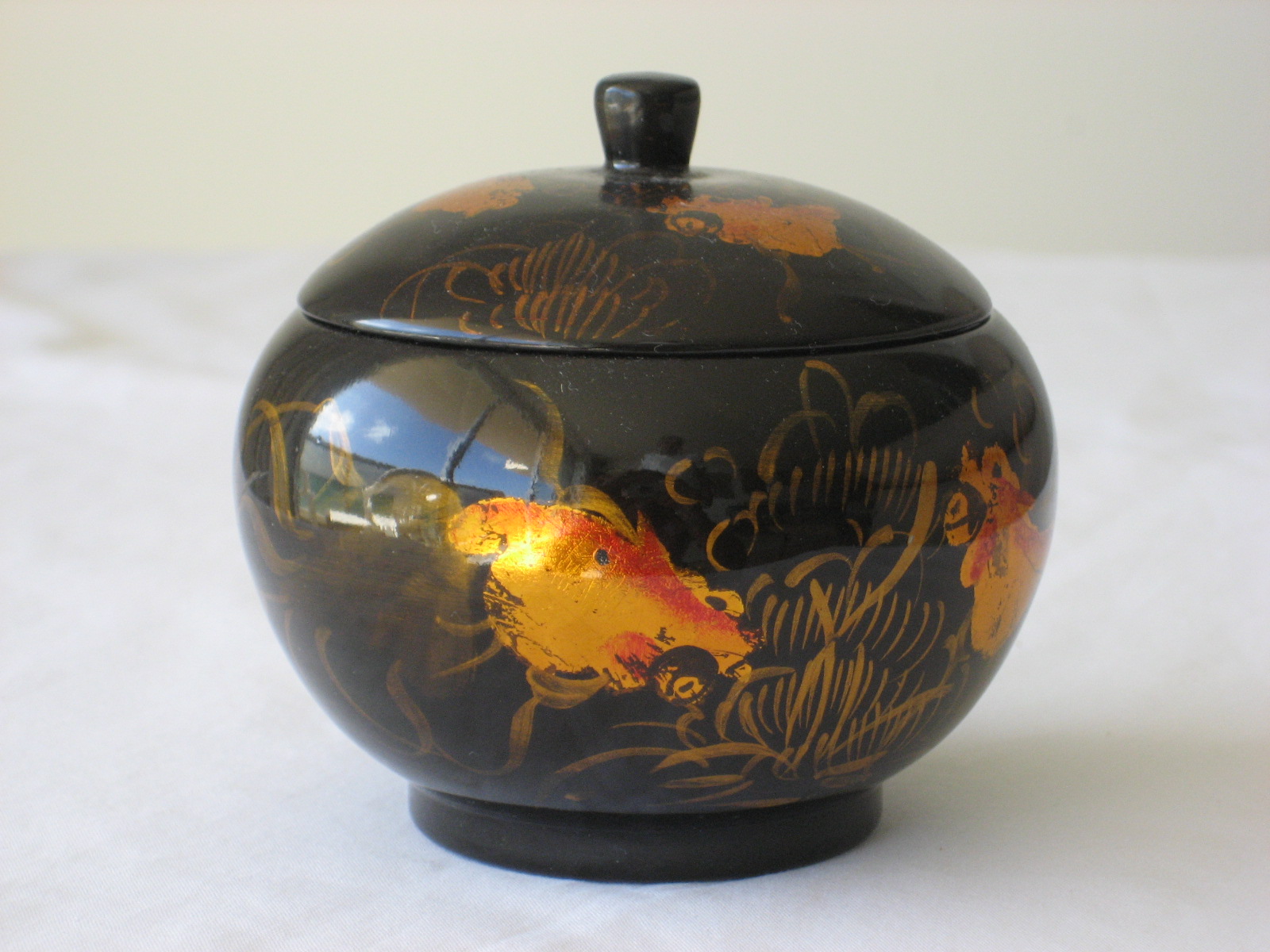
Above is a small container from Vietnam and is 3 ½ in. tall. It is made
of shell.

Above is a drum to summon people.
The tusks of the two elephants are made of ivory. It is presumably from
Burma or from India and was made in the 1950s. It is 16 in. tall.
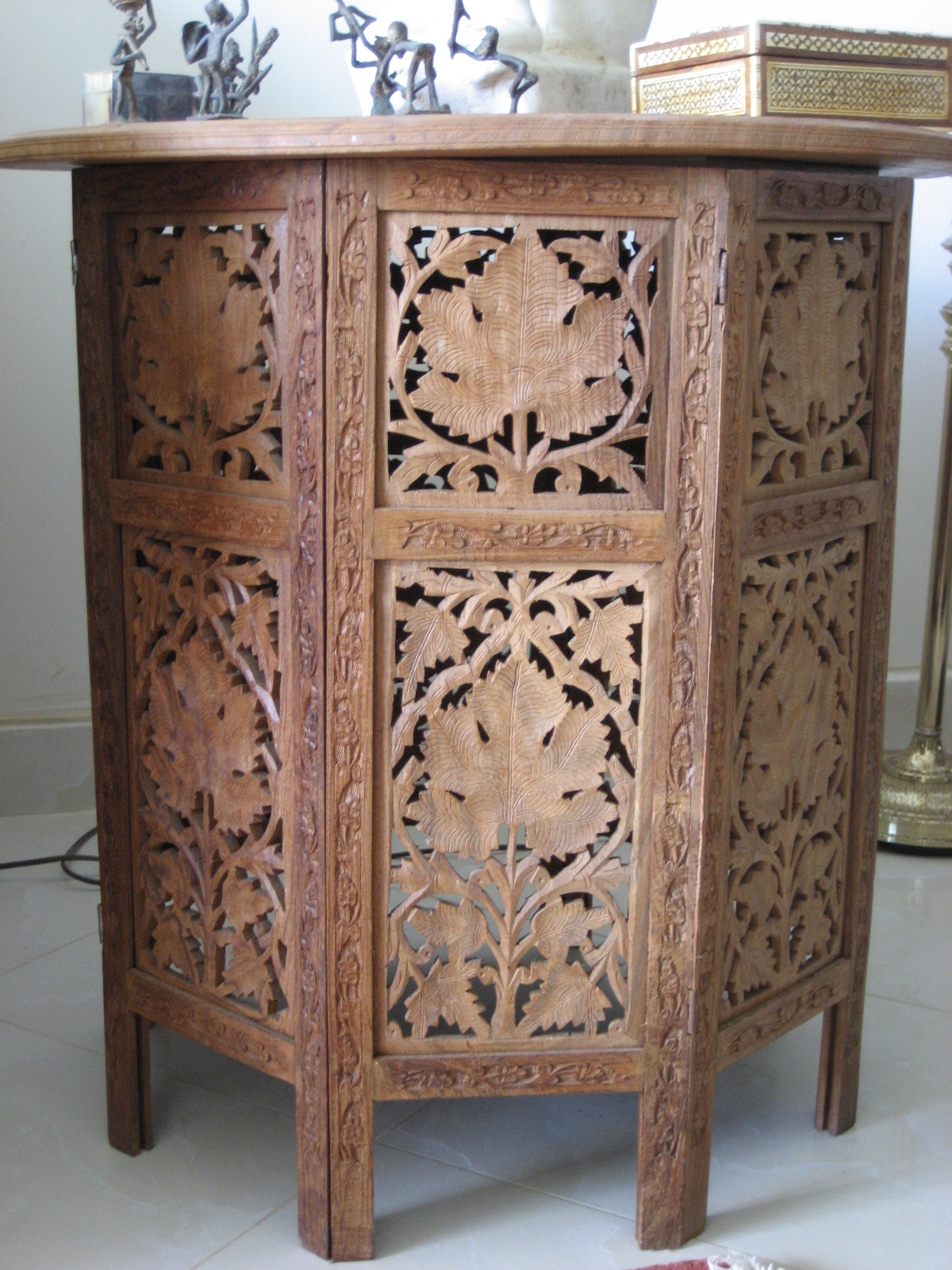
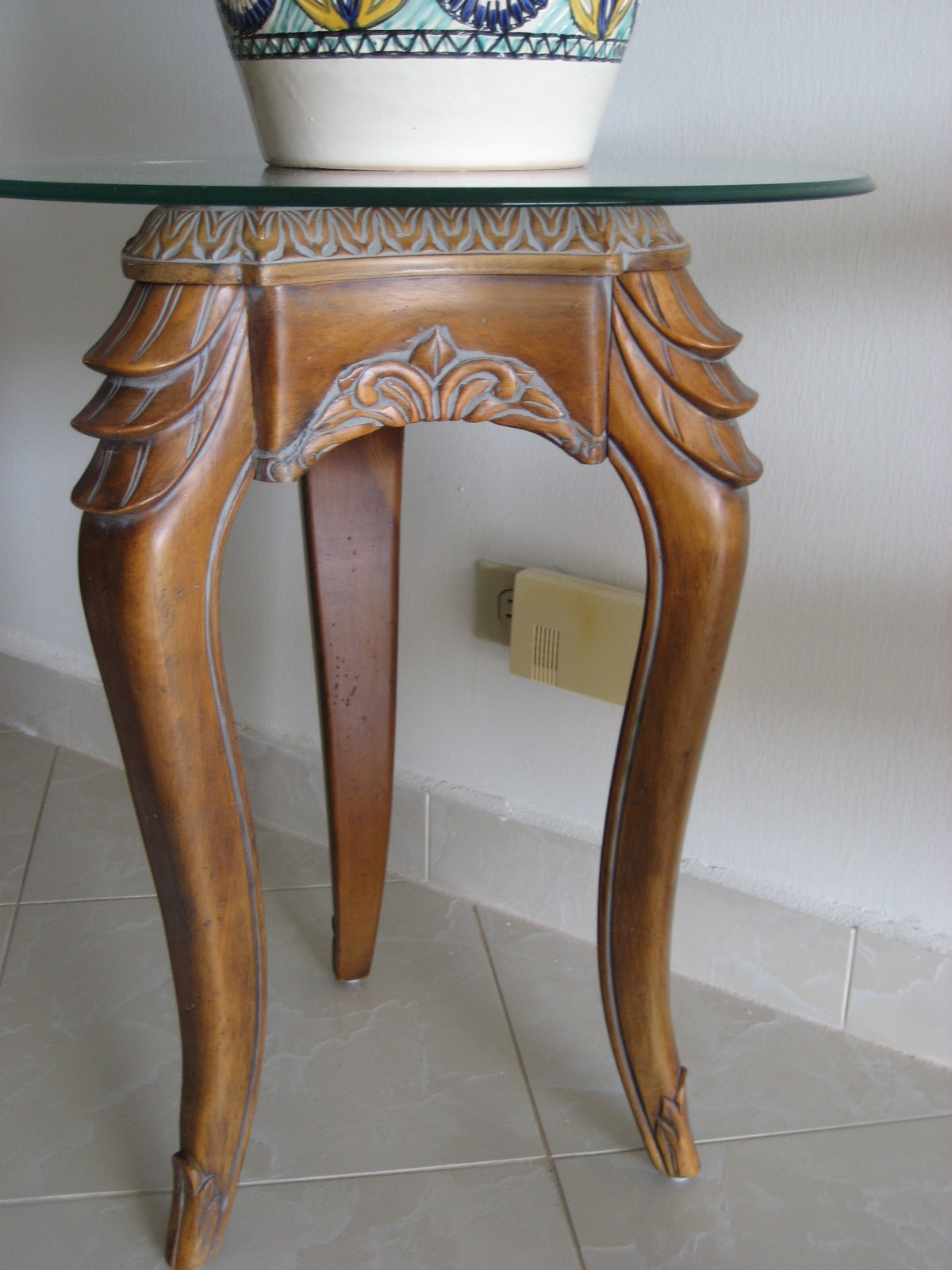
The two hand-carved tables above are from India, circa mid-1960s.They are
both 25 in. tall.
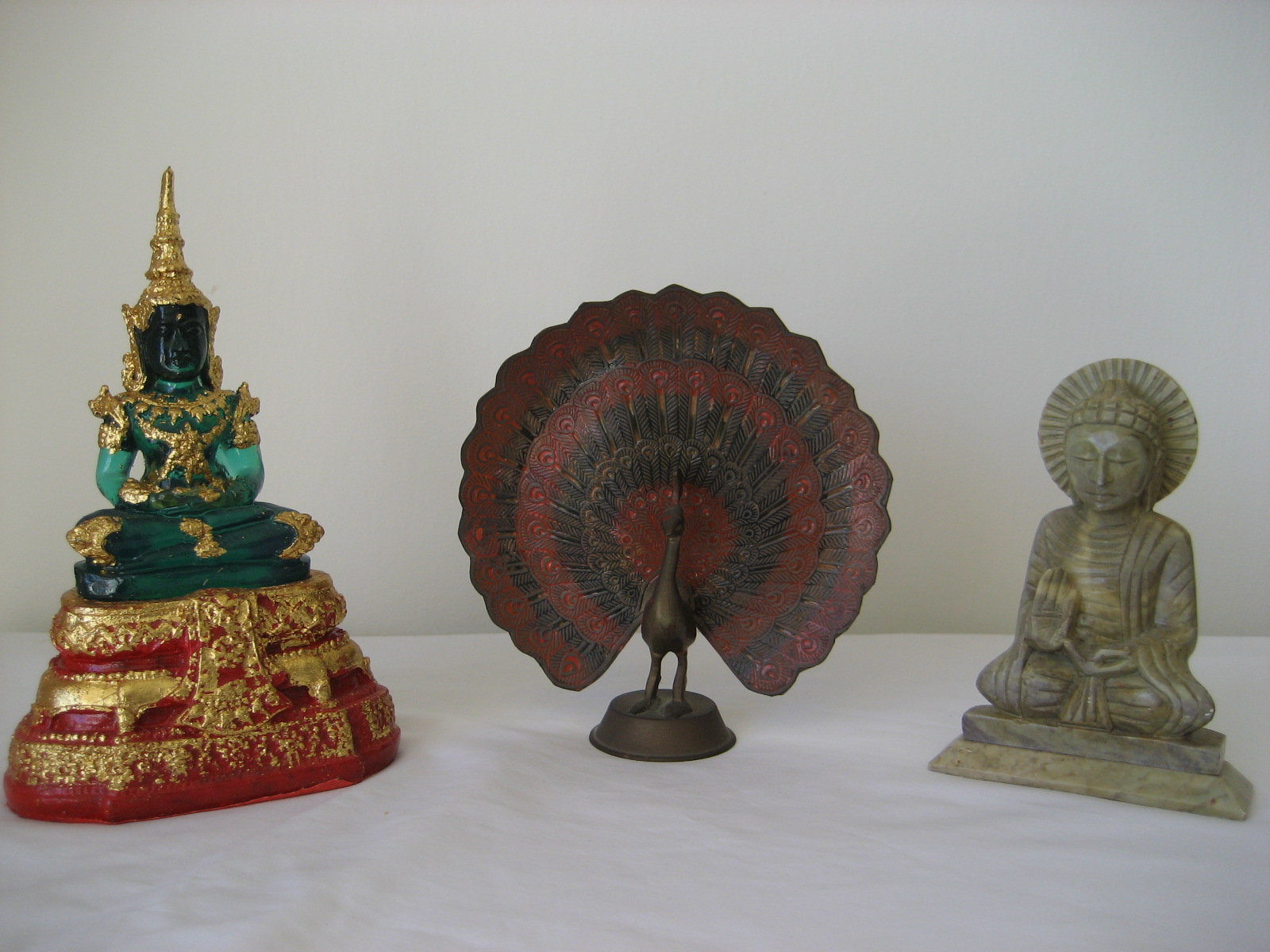
From the picture above, I bought
the Emerald Buddha (in the left) in Tailand in 2001. It is made out of
glass and is 8 in. tall. The metal peacock (in the middle) is from
India. It is 6 ½ in. tall. The smaller Buddha (in the right) is made of
stone. I bought it in India in 1989. It is 5 ½ in. tall.
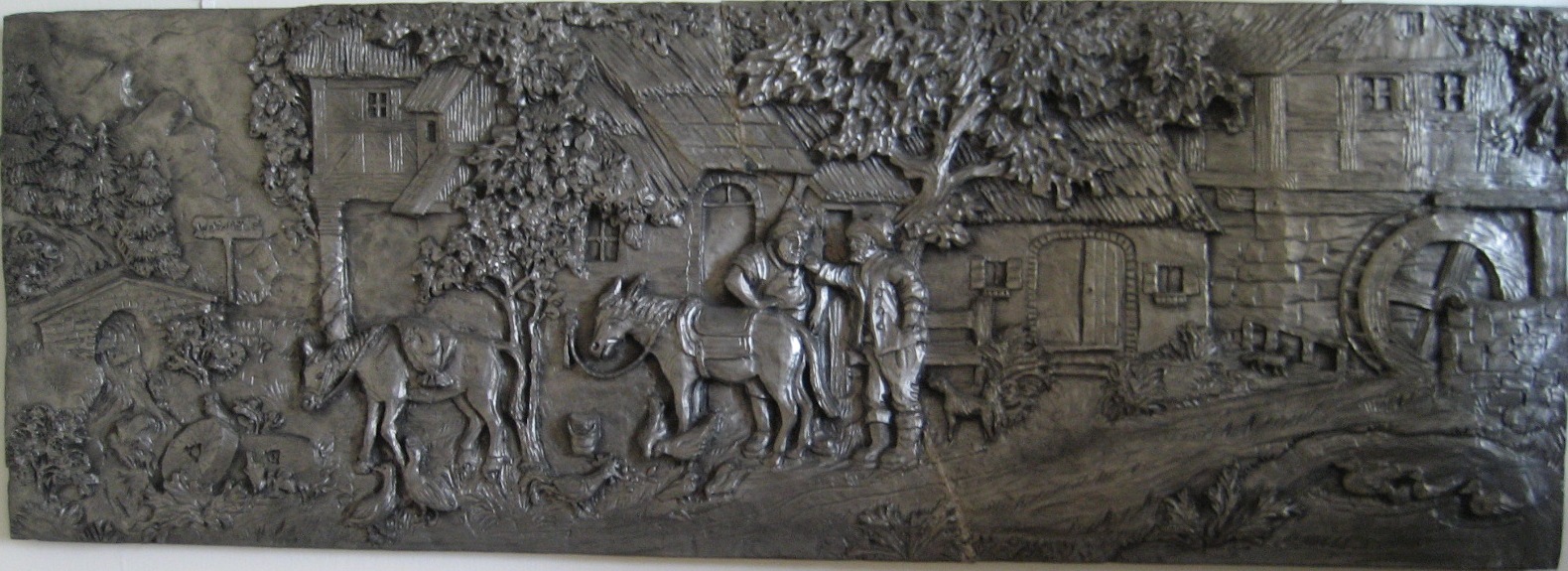
The
remarkable panel above is hand-carved in Germany with plaster covered with
zinc metal. I bought it in the former East Germany in 2000. It is 15 in.
by 43 in.
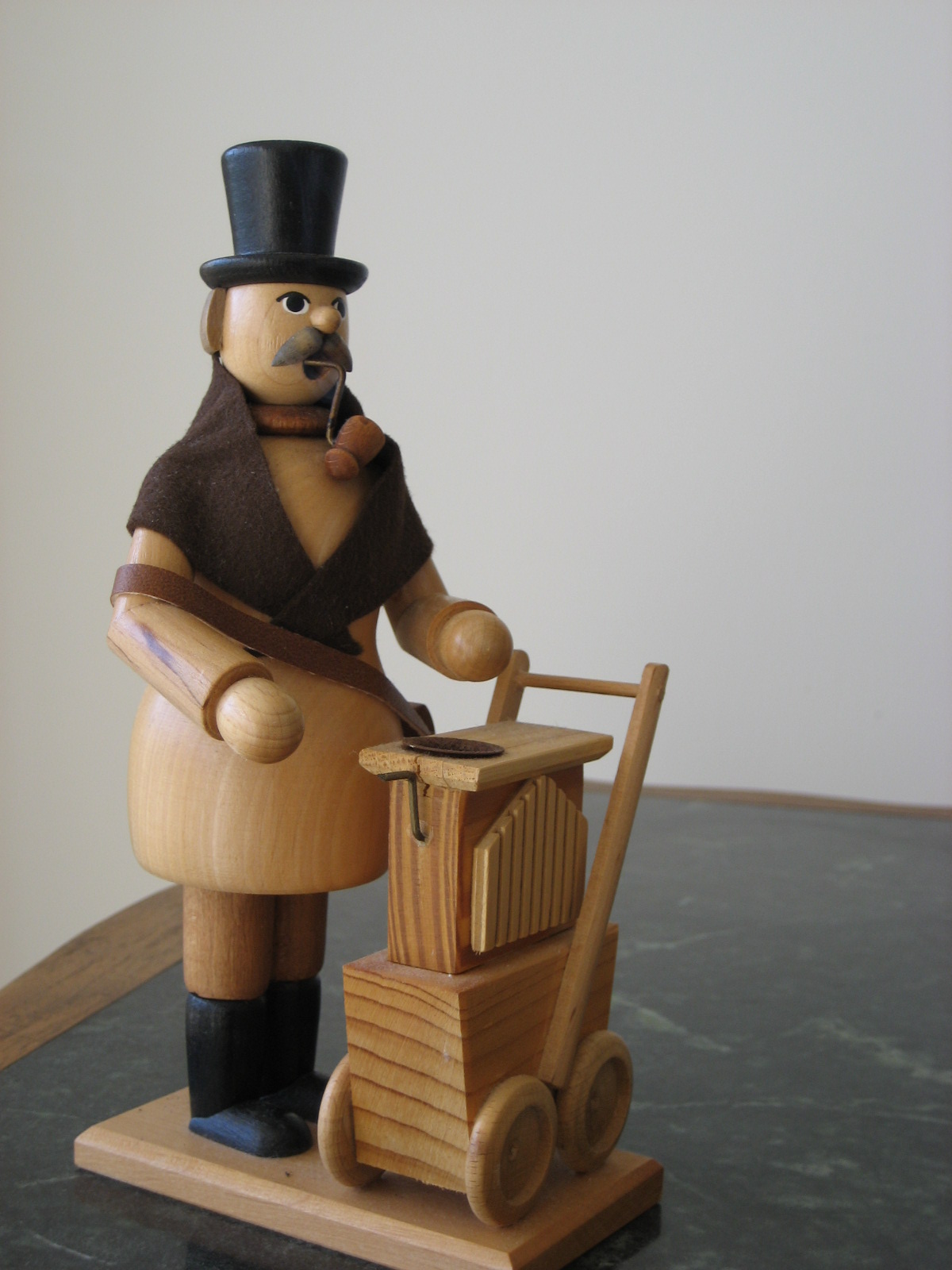
The above handmade music box
man is handmade in the former East Germany in a small town near the
border with the Czeck Republic. I bought it there in 2001.
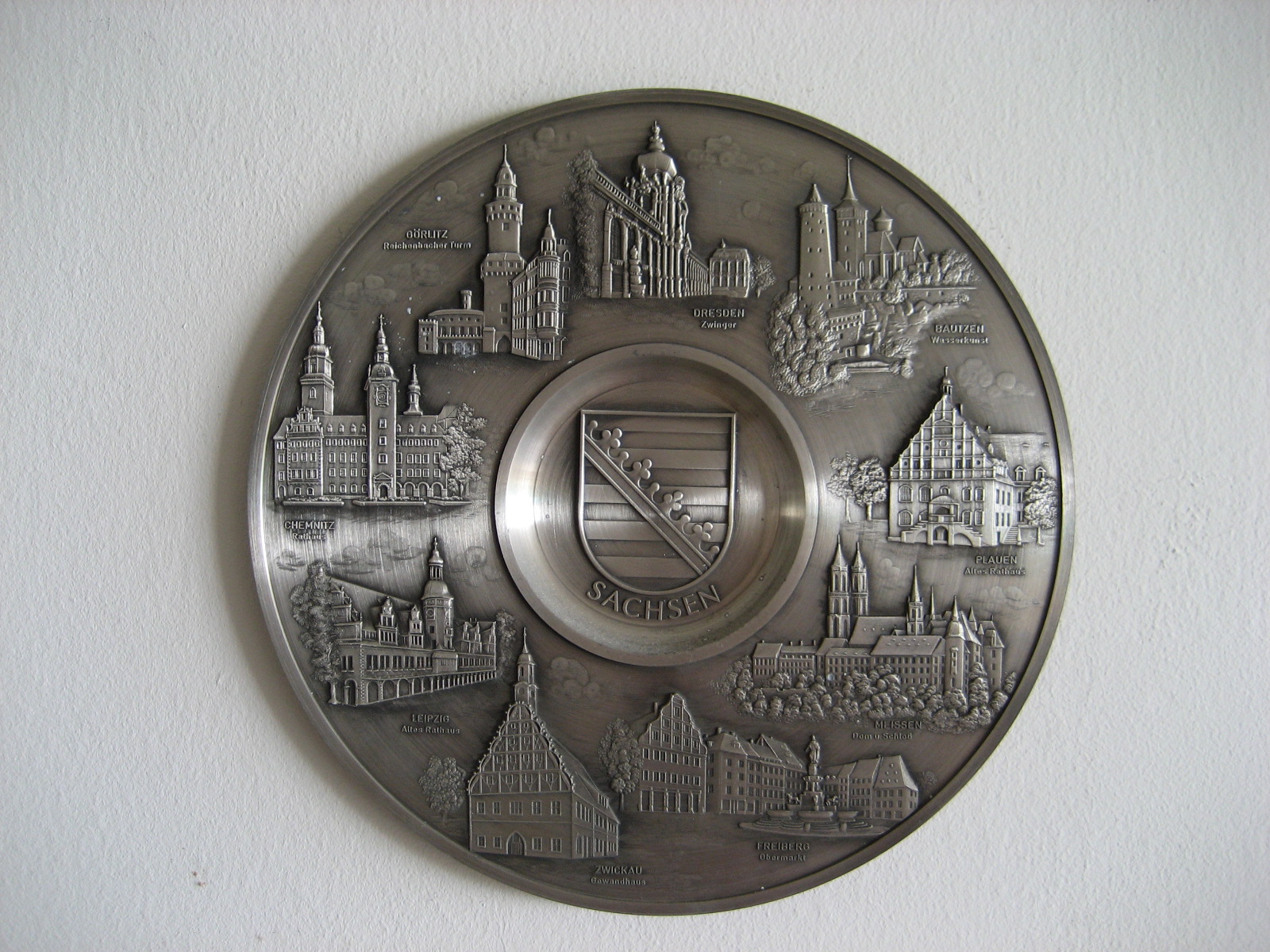
The above carved metal
plate shows the best-known monuments of some of the main cities of the
state of Saxony, in the former East Germany. It has a diameter of 10 in.
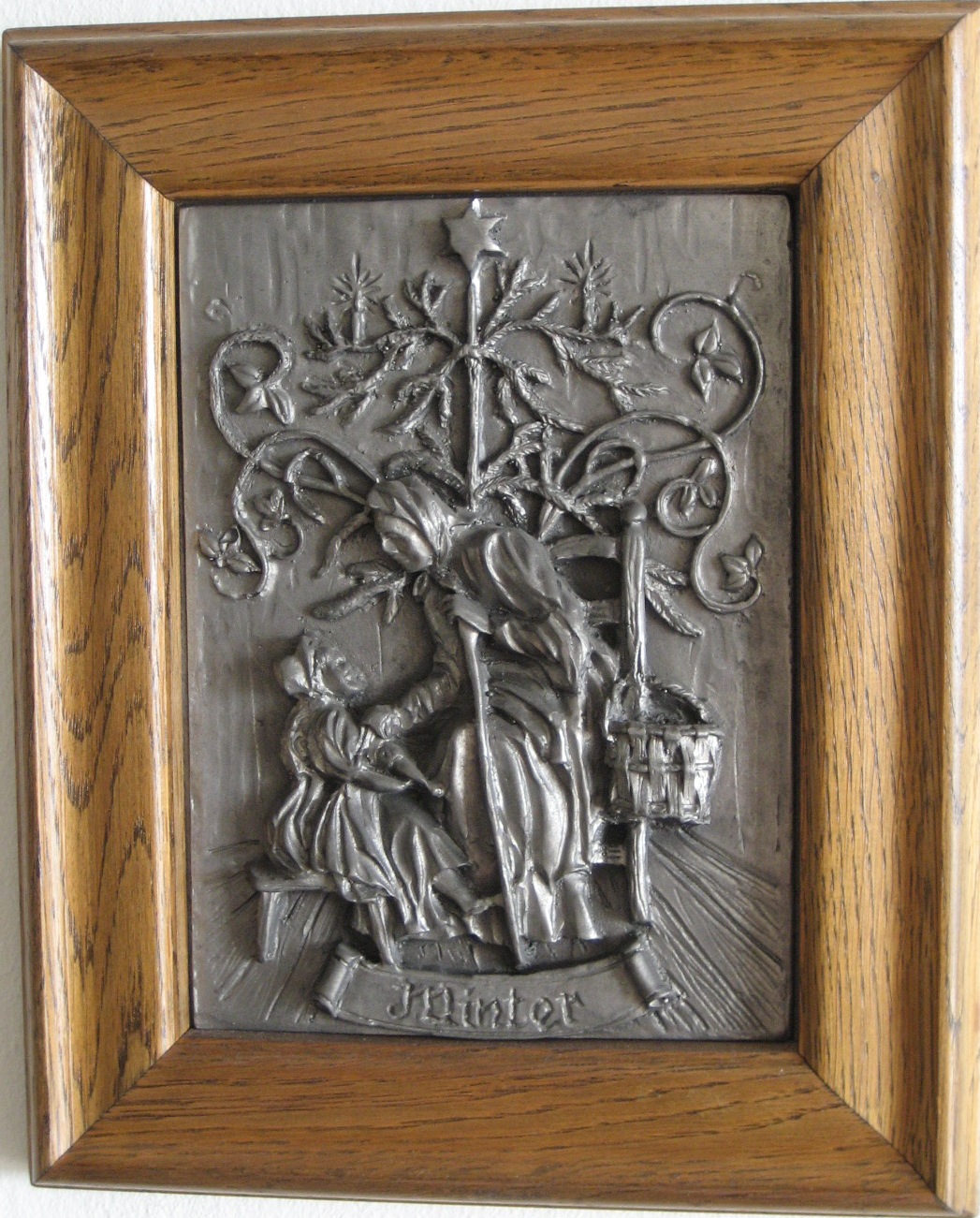
The framed metal
sculpture above is called “Winter.” It is 5 in. by 7 in. I bought it in
Leipzig, Germany.
The Bride's Cup of Nuremburg
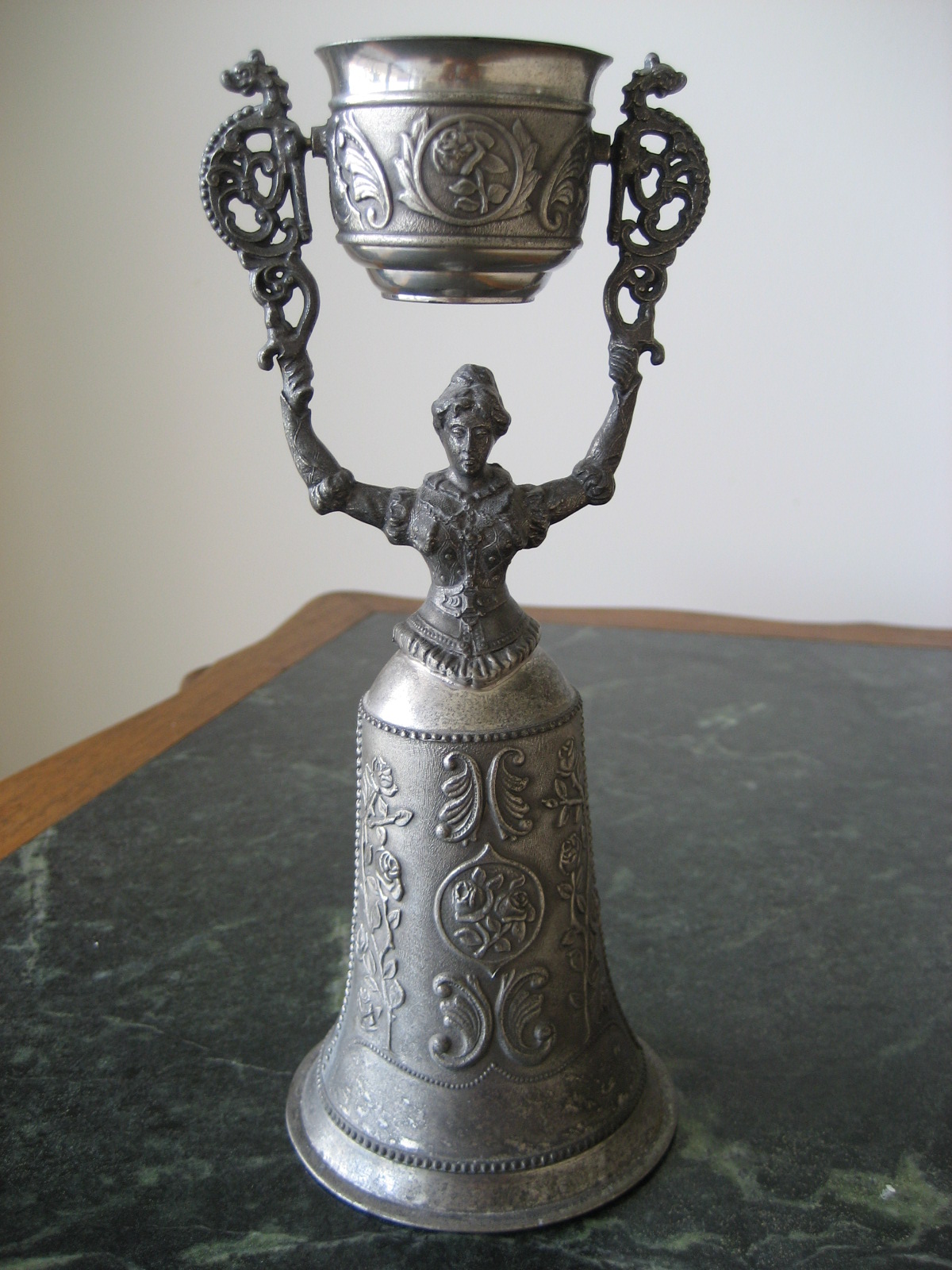

Some masks

The mask above
is from Chichen-Iza, a Mexican city located in the state of Yucatan.
This city has been identified as the main territory of the Mayas.
According to the ancient Mayan chronicles of Chilam Balam, this area
first peaked during the Classic Period between 300-900 A.D. when
its inhabitants built Old Chichen. A second cultural and architectural
peak occurred during the Post-Classic era between 900-1200 A.D. under
Itzaes. This area became one of the most important in Meso America and
was later named Chichen-Iza meaning “edge of the Itzaes” in reference to
the nearby Sacred Cenote. The mask is 7 ½ in. by 12 in.
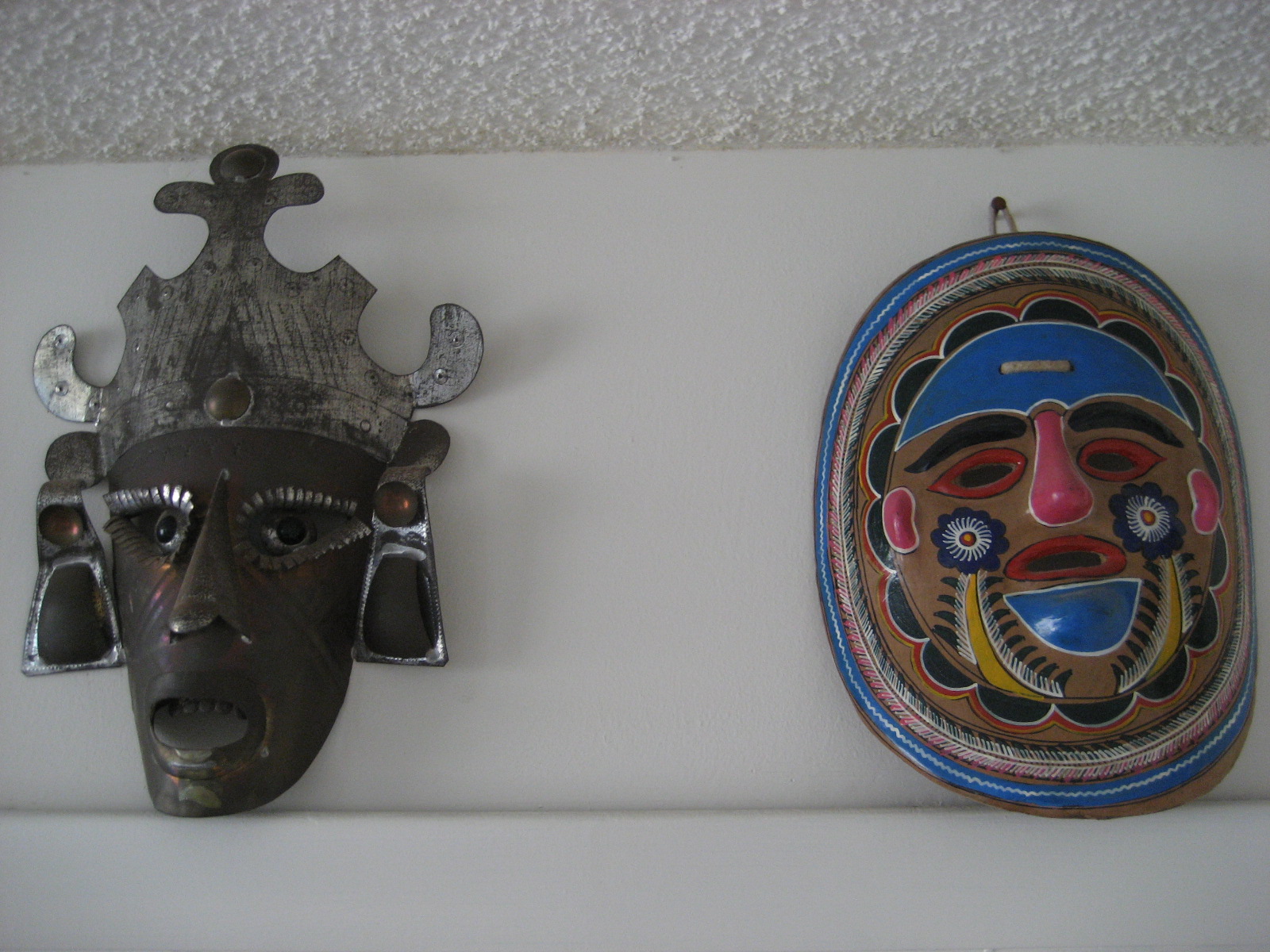
Of the two masks above, the one on the
left is a metal mask made of
cans with marble eyes from MEXICO, 12 in. tall, 1960s. The second mask
is a ceramic mask also from MEXICO, 10 in. tall, 1970s.
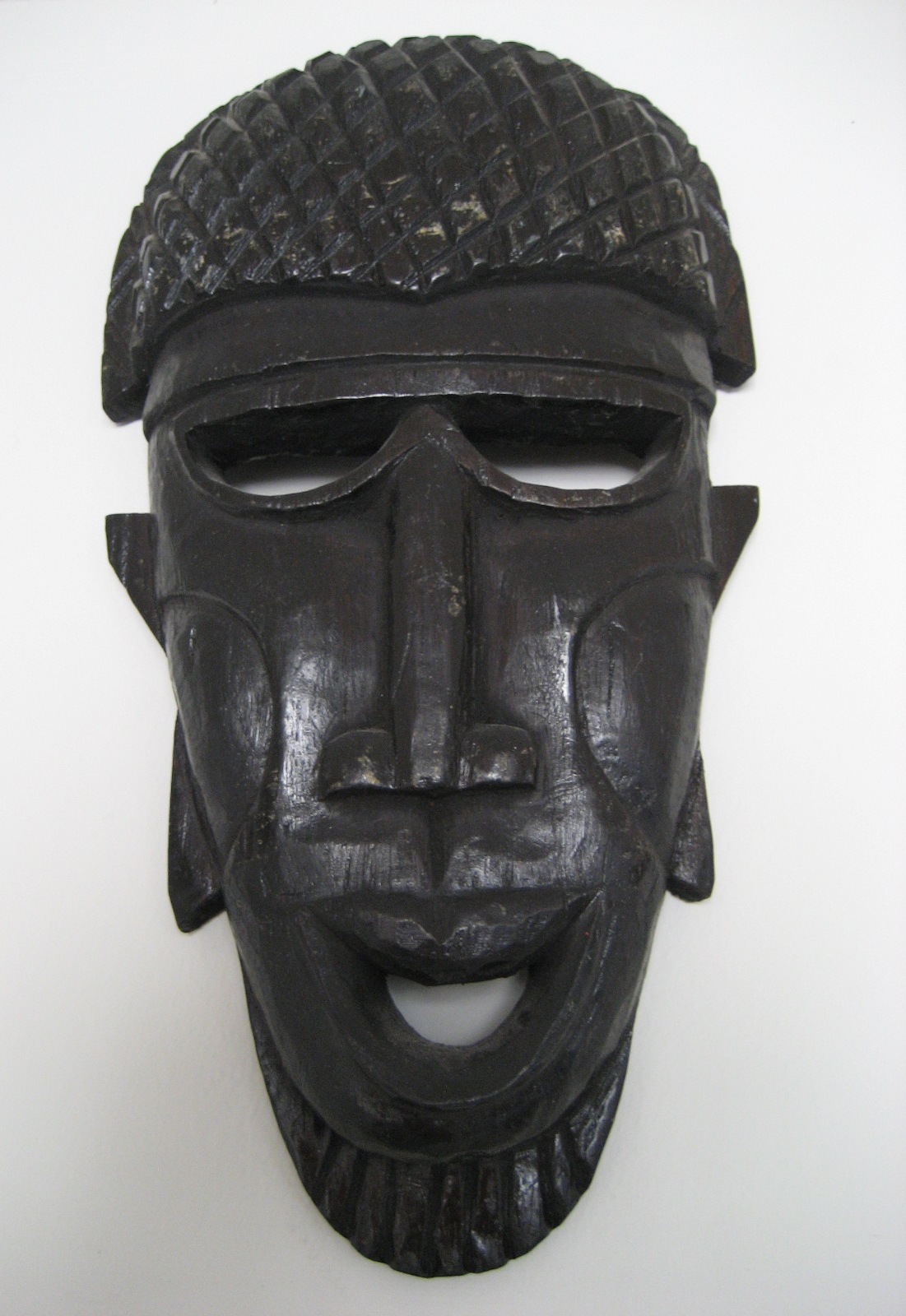

Of the two masks above, the one on the
left is an African mask from
GUINEA-BISSAU, 10 in. tall, 1980s. The second mask is from HAITI, 13 in.
tall, 1990s.
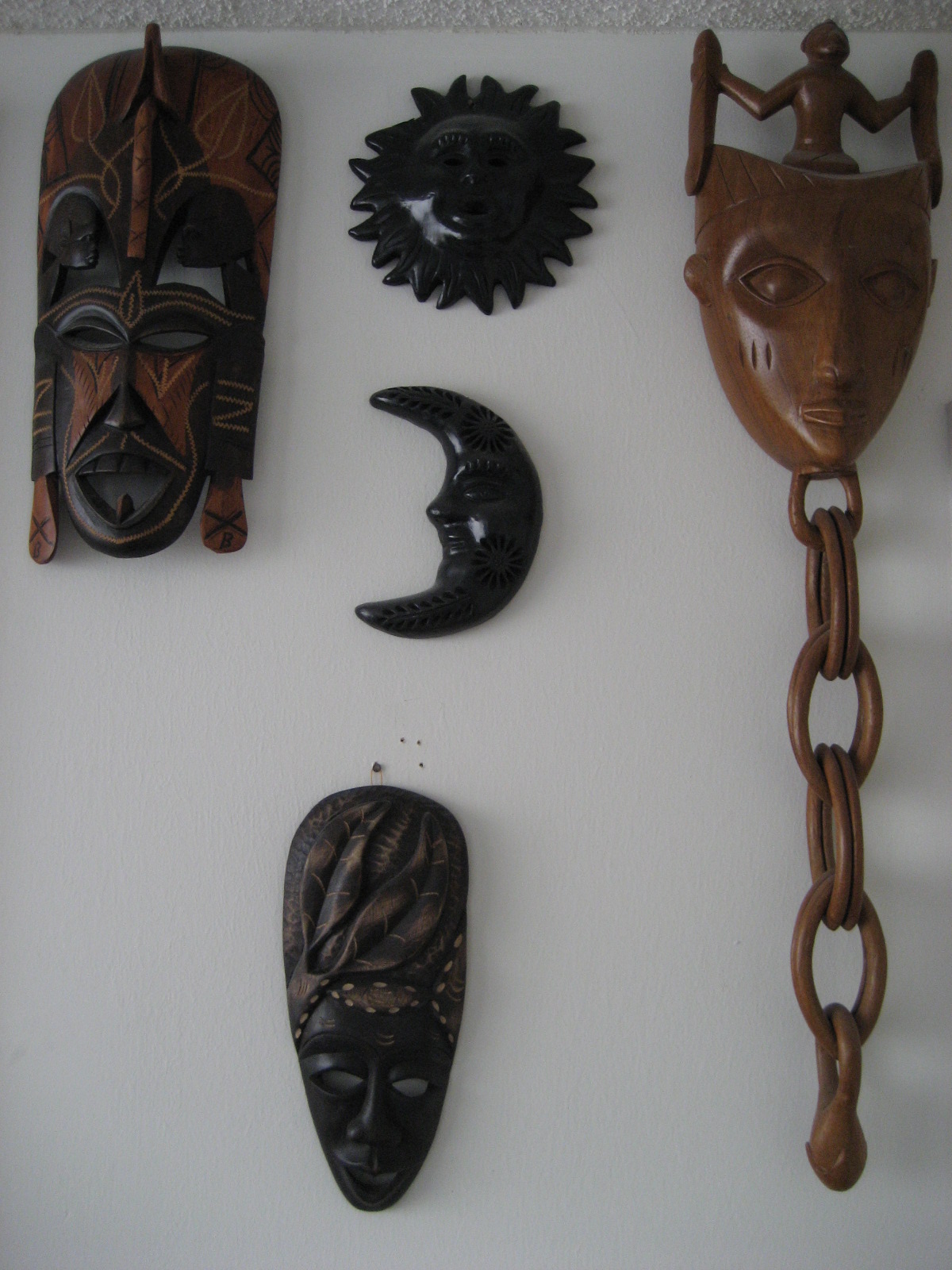
In the above picture, there are 5
masks. The first is an African mask from KENYA, by Jambo, 17 in. tall,
1987. The second mask is a ceramic “Sun mask” from MEXICO, 8 in. tall,
1990s.The next one is a ceramic “Moon mask” from MEXICO, 8 in. tall,
1990s. The next mask is an African mask from GUINEA-BISSAU, 10 in. tall,
1980s. The last is an
African
mask from SENEGAL, 34 in. tall, 1970s.
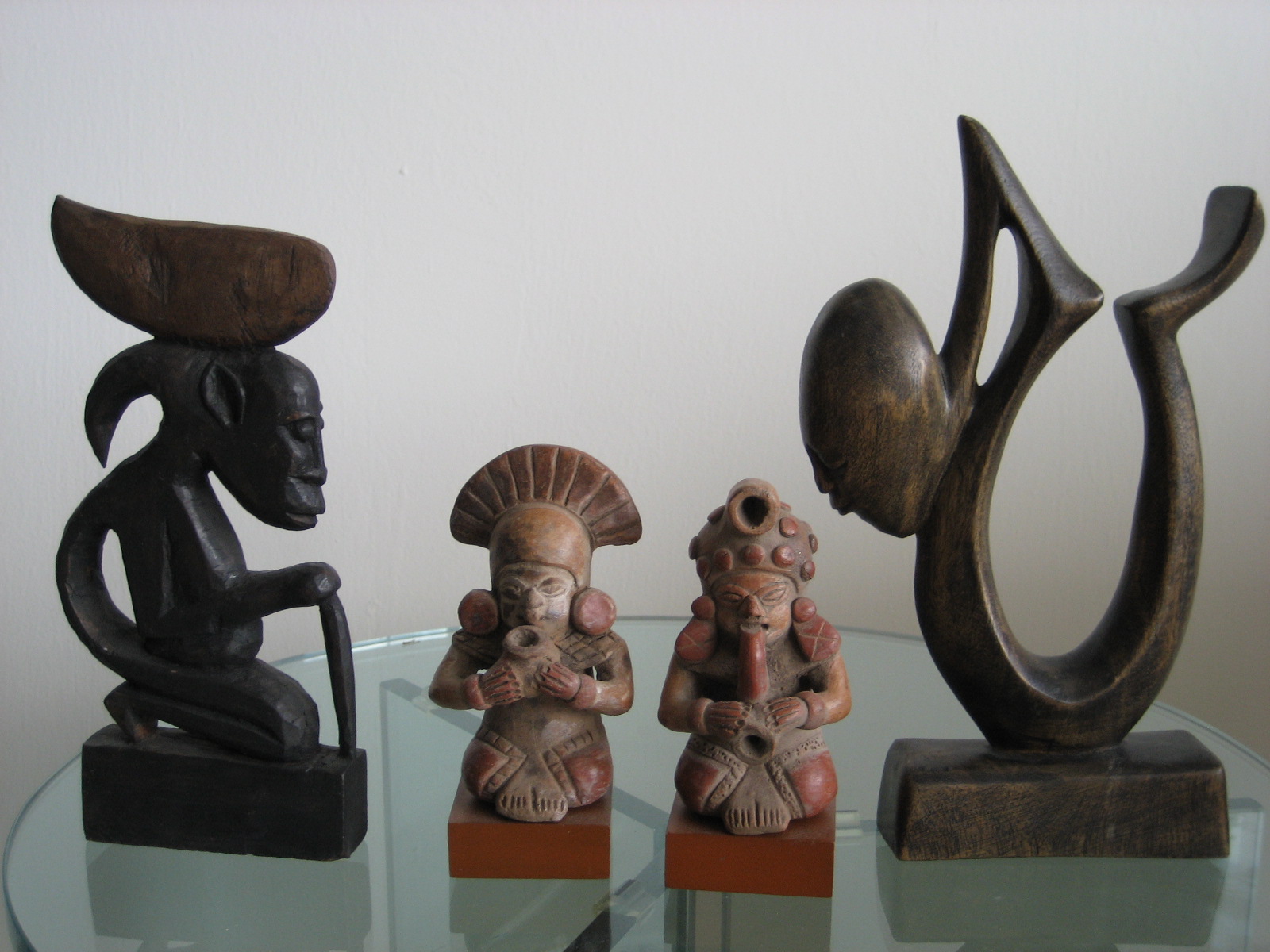
From the
picture above, the first wood carving is from GUINEA-BISSAU, 8 in.
tall, 1980s. In the middle
there are
2 terracotta works from ECUADOR, 5 ½ in. each, 1990s. The last
object is a wood carving from HAITI, 9 ¼ in. tall, 1970s.
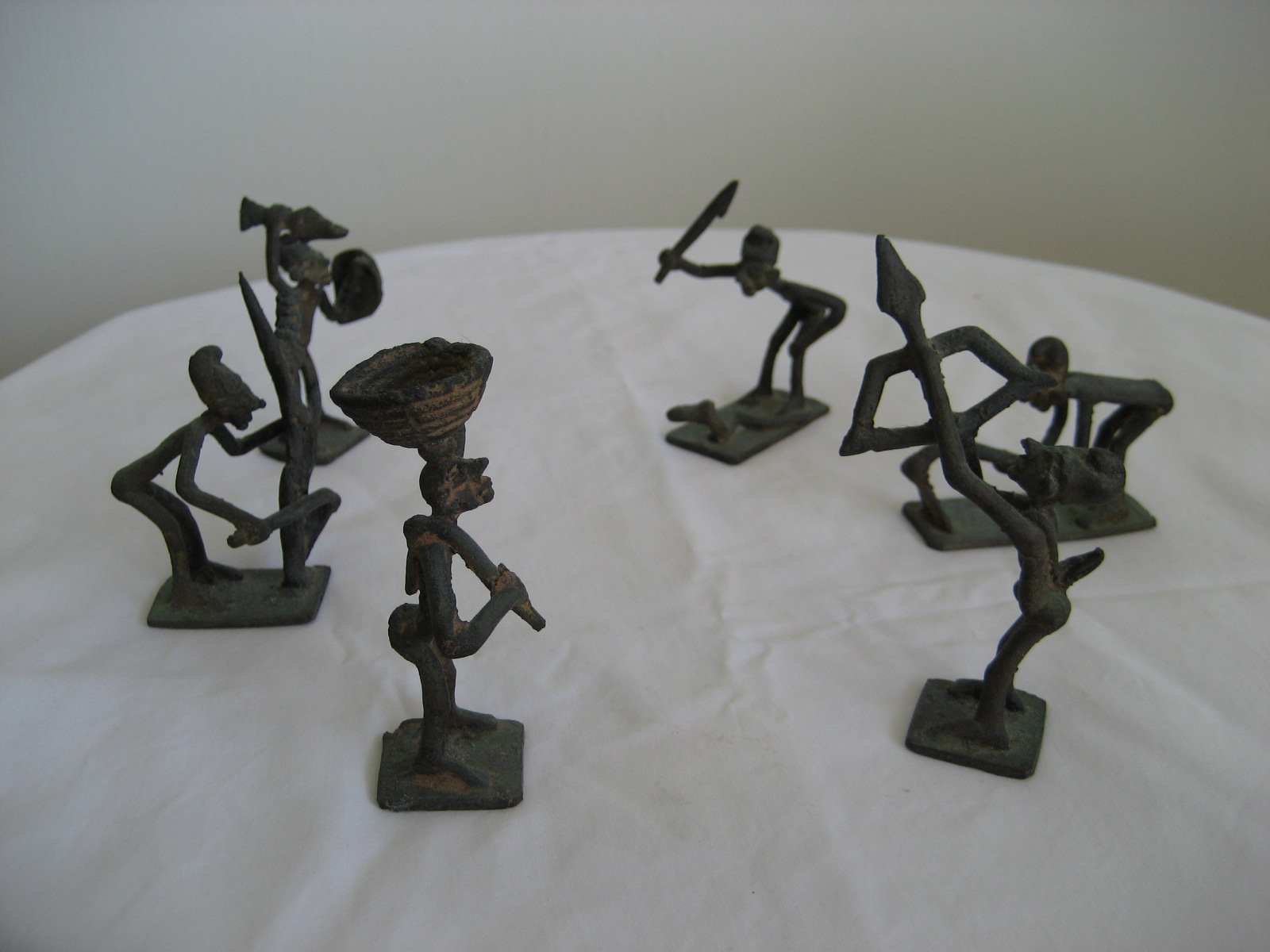
The above picture shows 6 small bronze
sculptures representing African villagers working at their different
trades. They are between 2. in to 4 in. tall, TOGO, 1980s.
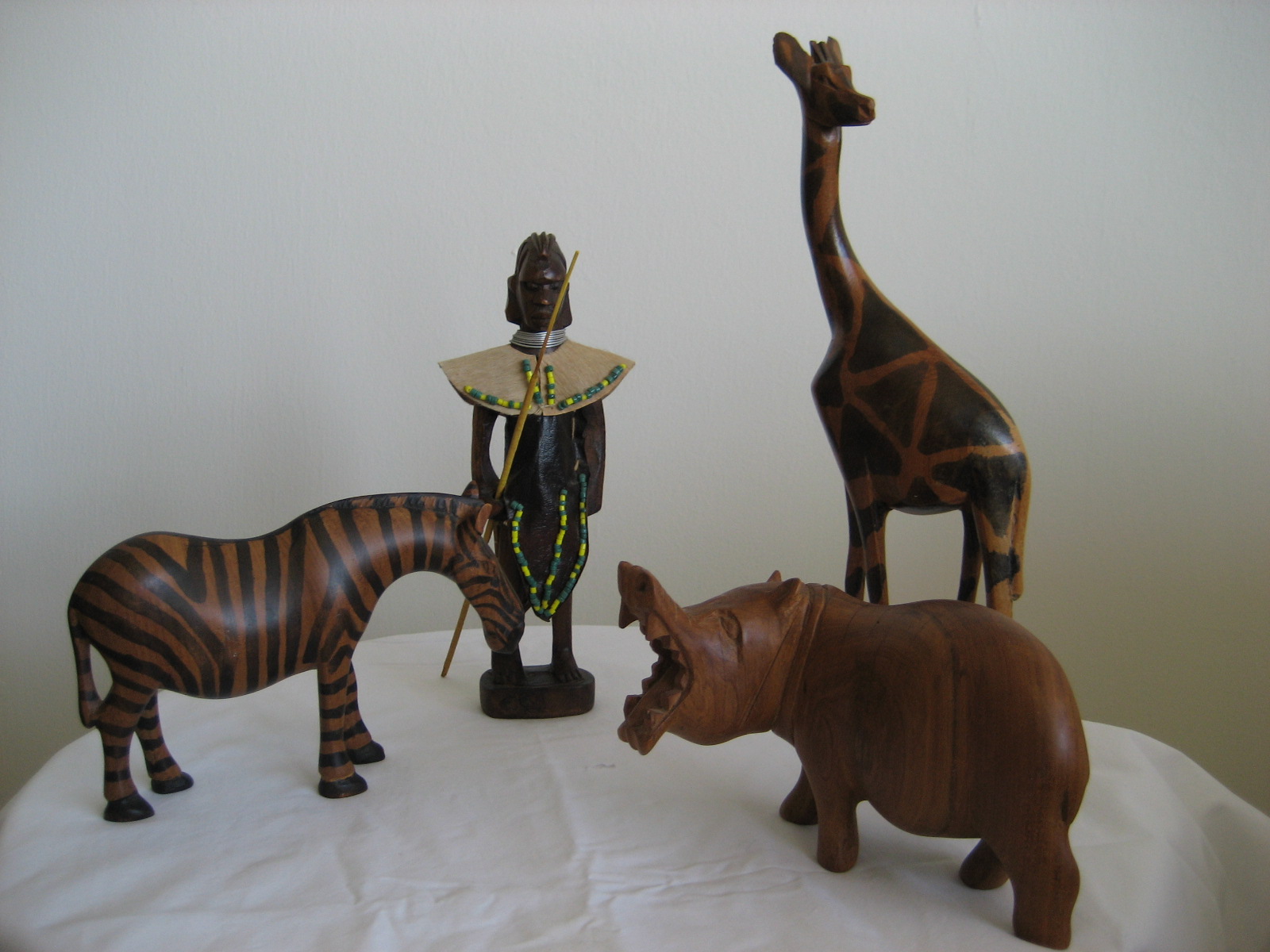
Above are 4 wooden carvings from KENYA. They are between 4 in. to 12 ½ in.
tall, 1980s.
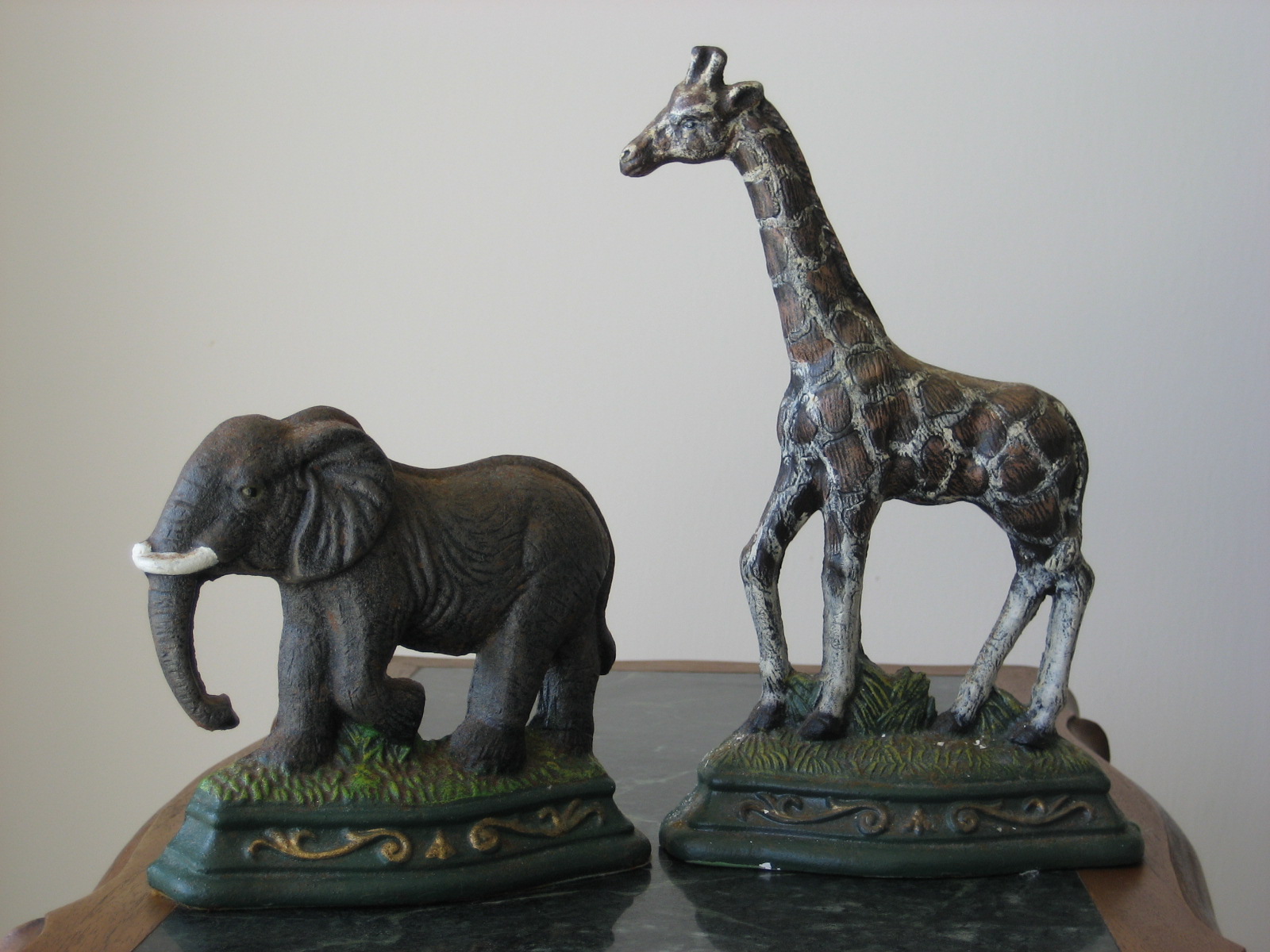
Above are two metal door stoppers from INDIA. They are 6 in.
and 10 in. tall, 1990s.
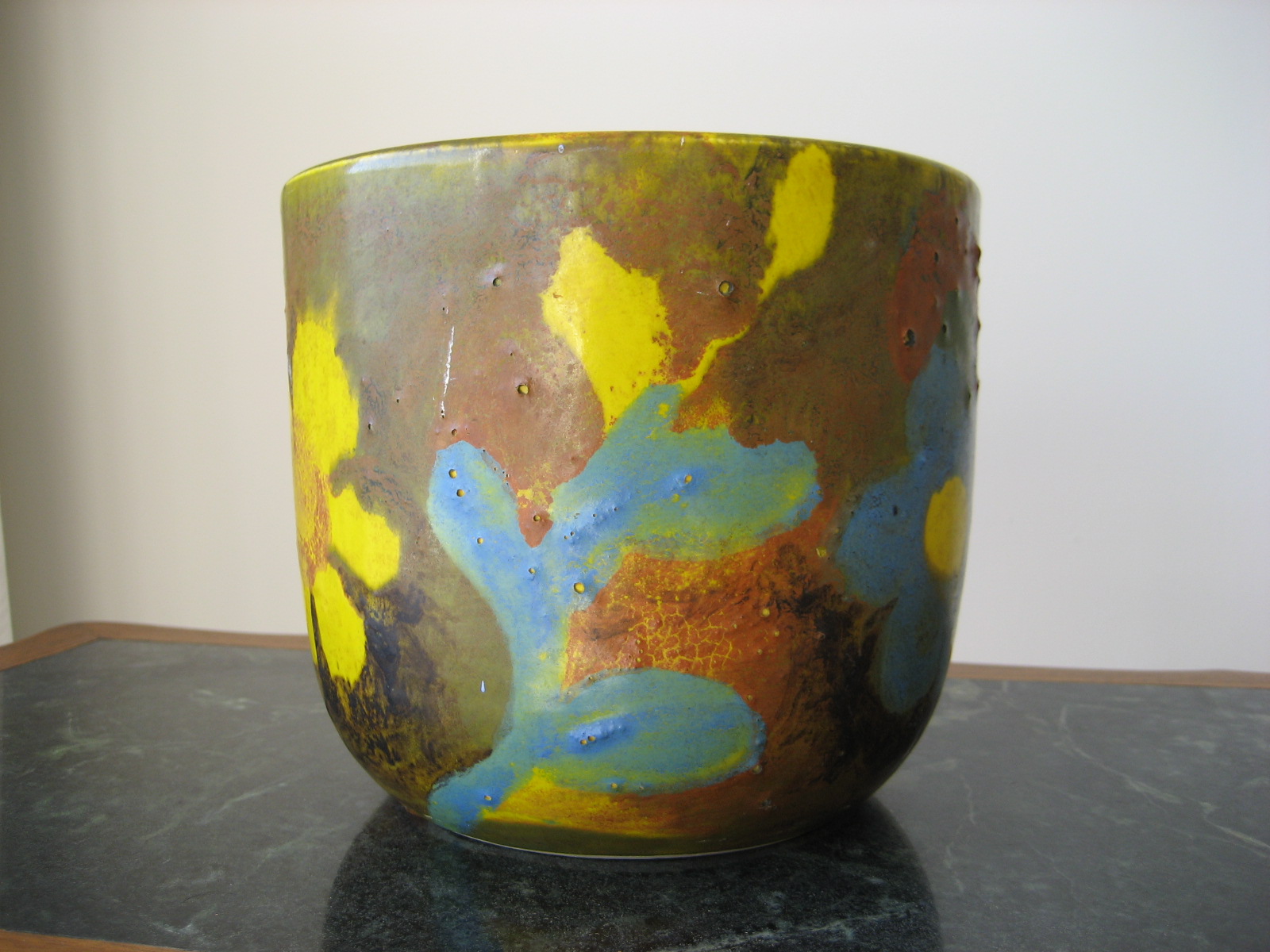
The ceramic vase above is from ITALY, 1960s.
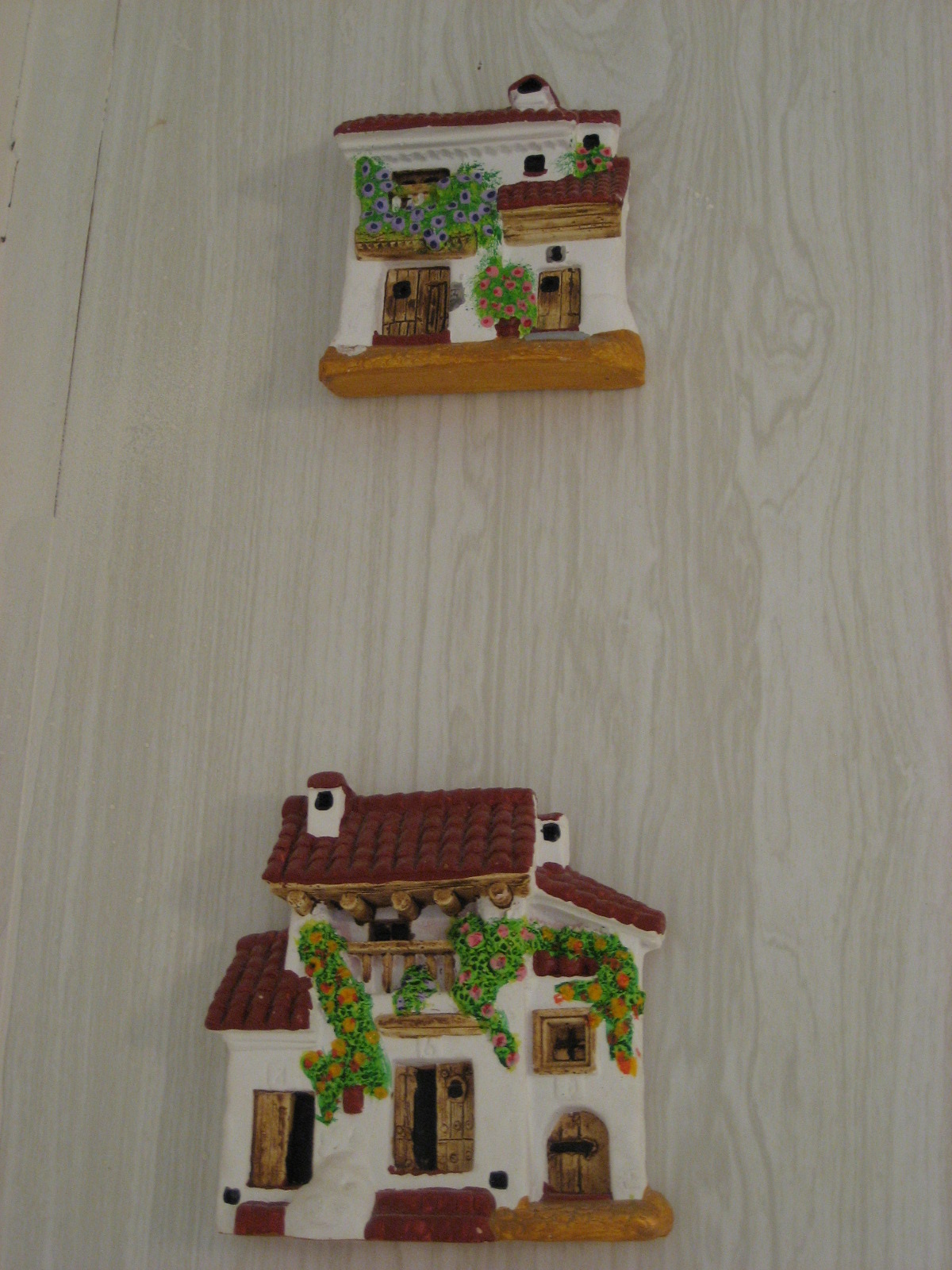
Above are two small ceramic houses from SPAIN, 1990s.

Above is a Carib Indian basket from the
commonwealth of Dominica.
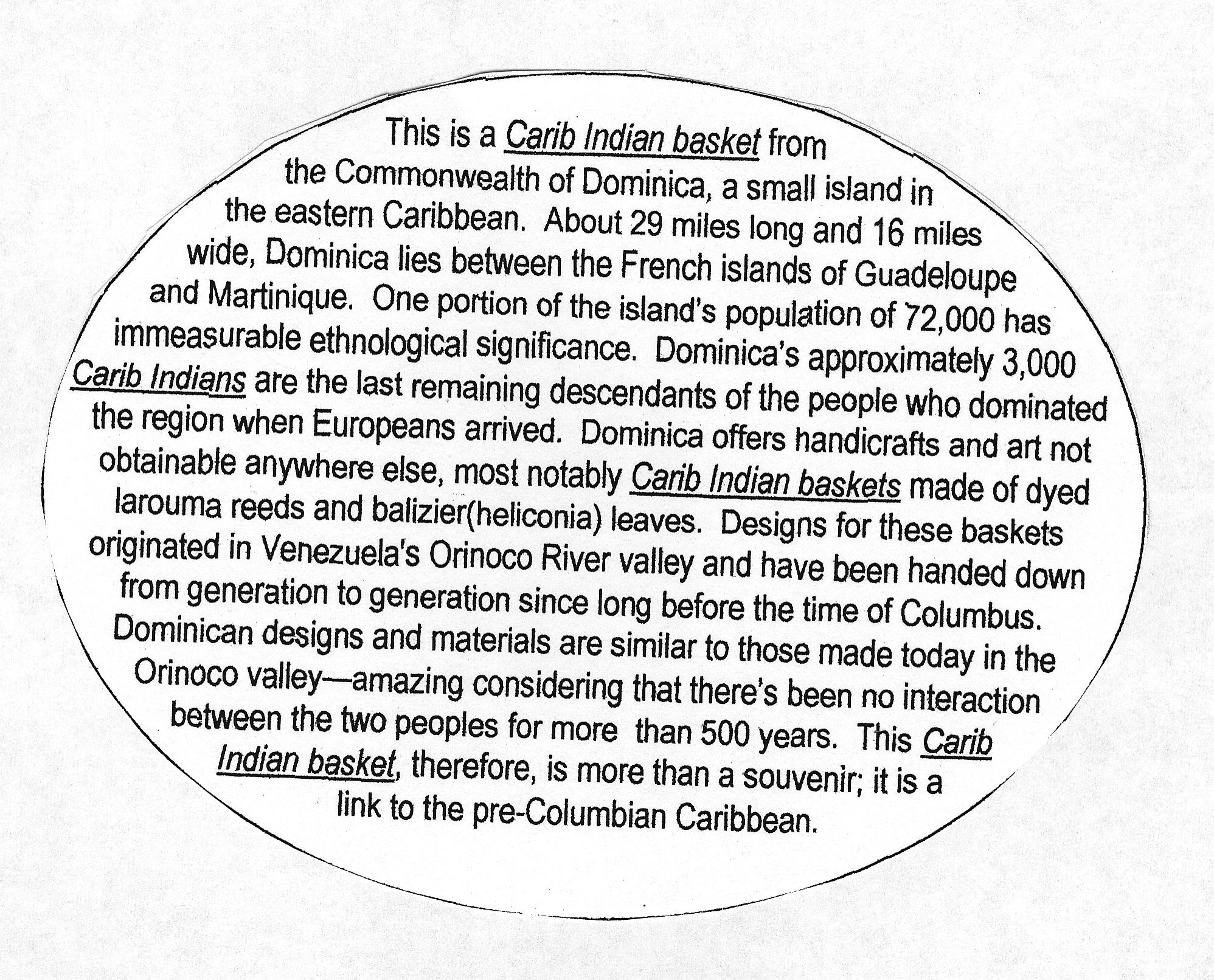
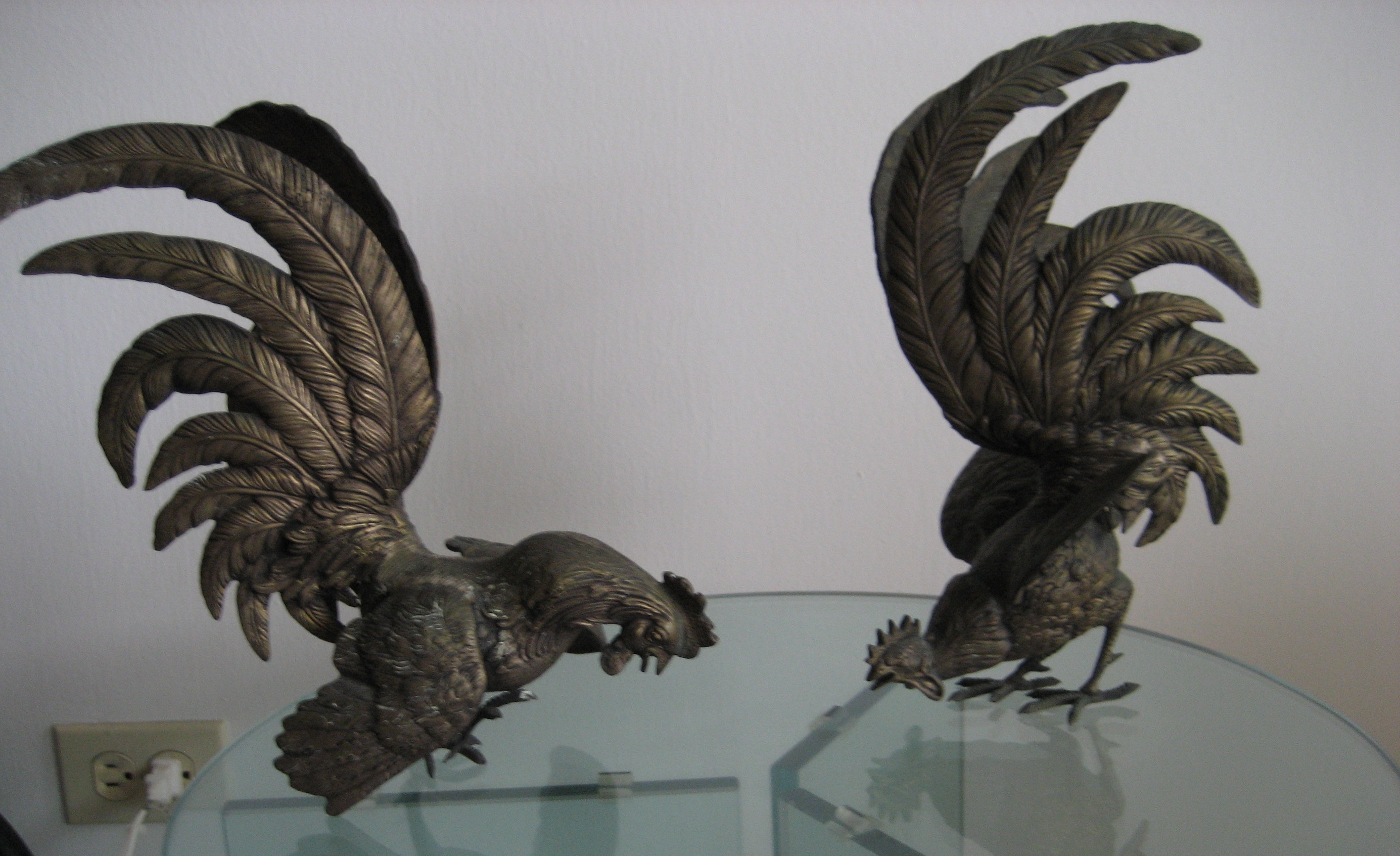
Above are two silver fighting roosters from ARGENTINA, 12 in. tall each, 1960s.
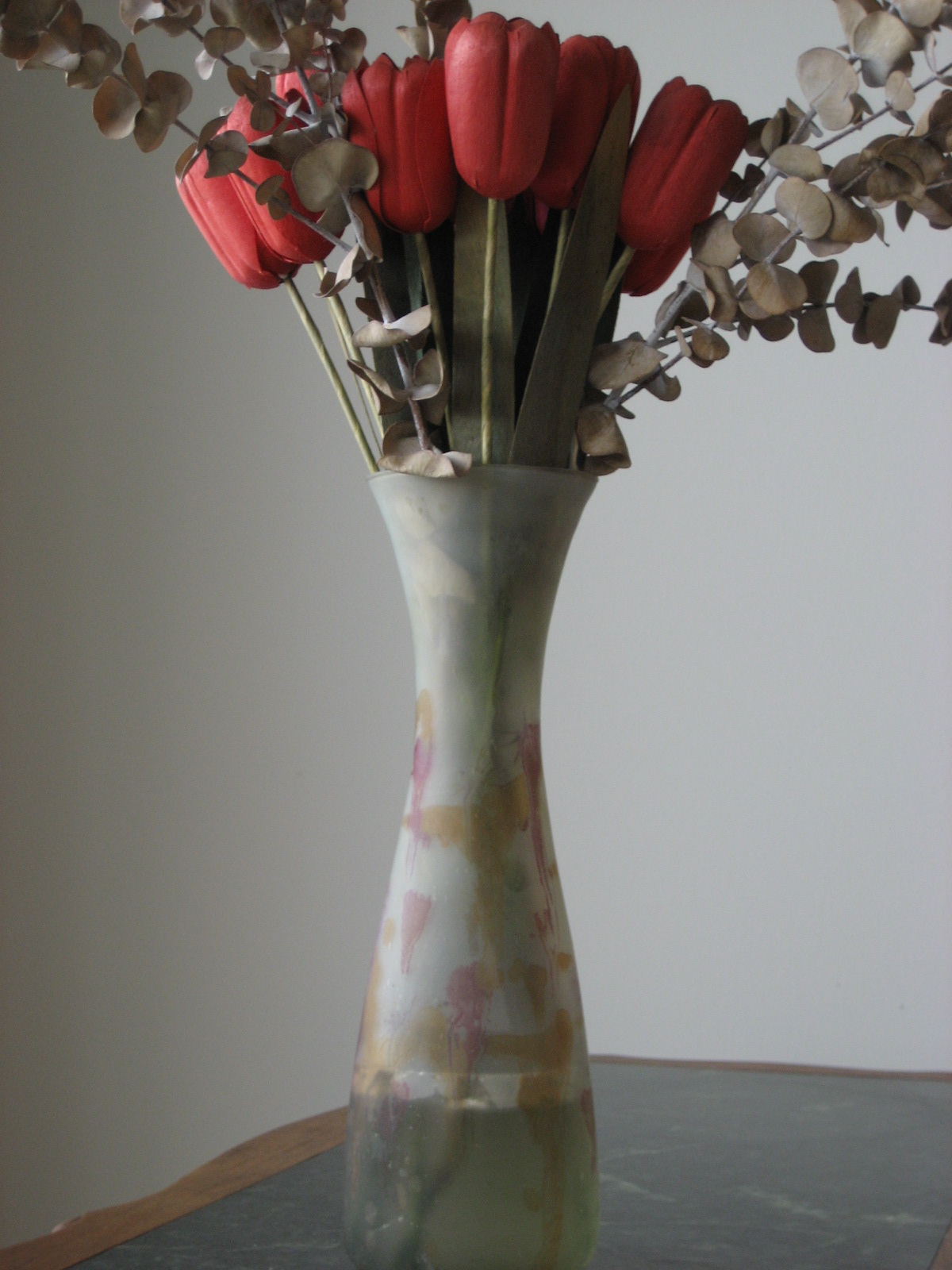
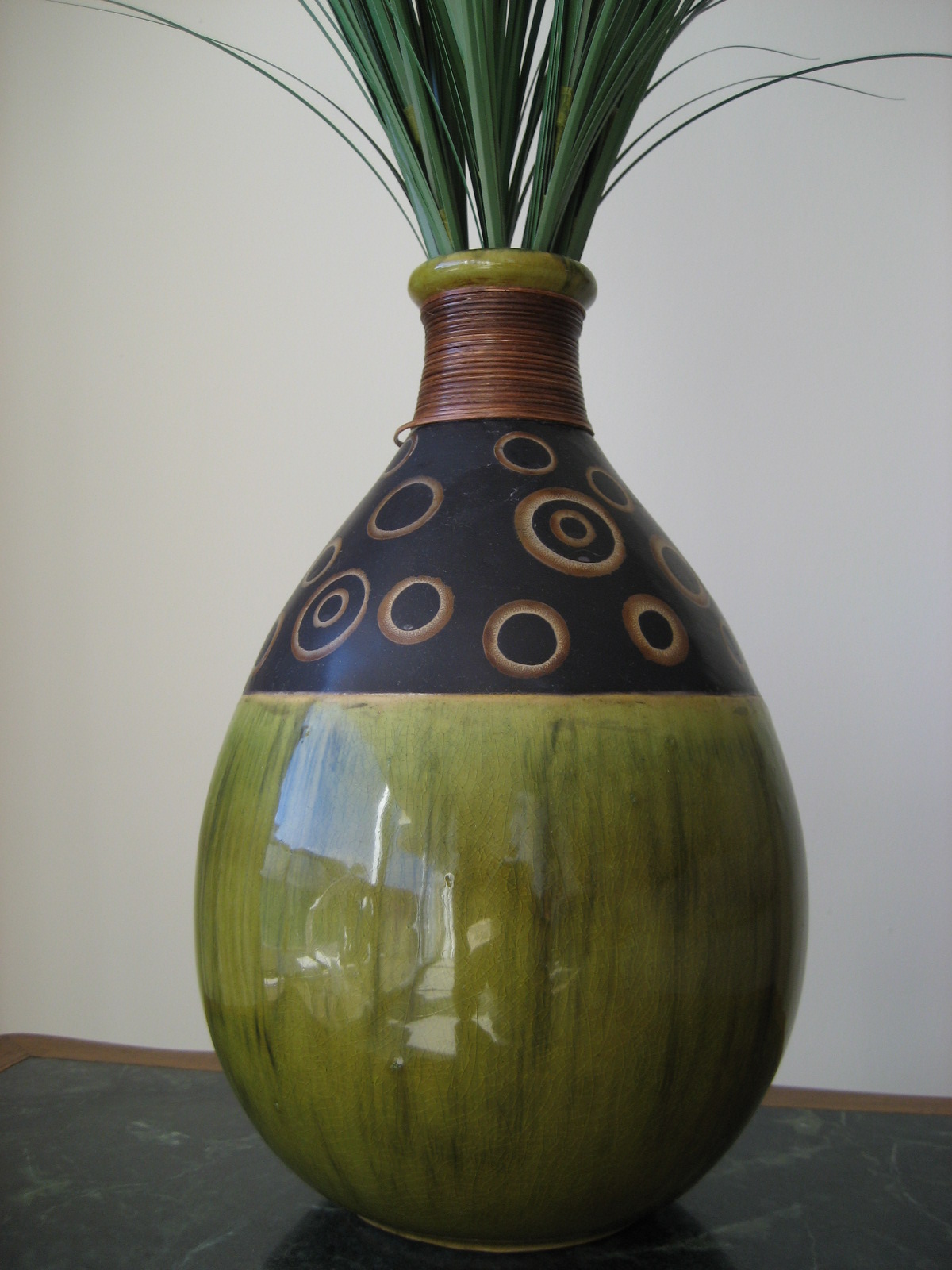
From the 2 vases above, the one on the
left is a
handmade ceramic flower pot from ISRAEL, 11 in. tall, 1970s.The second
is a flower vase from CHINA, 13 in. tall, 2000s.

This stone bunny above is an original
creation from ATLANTA (USA) artist, Telle M. Stein. It is hand cast and
hand finished, 6 in. tall, 2000s.
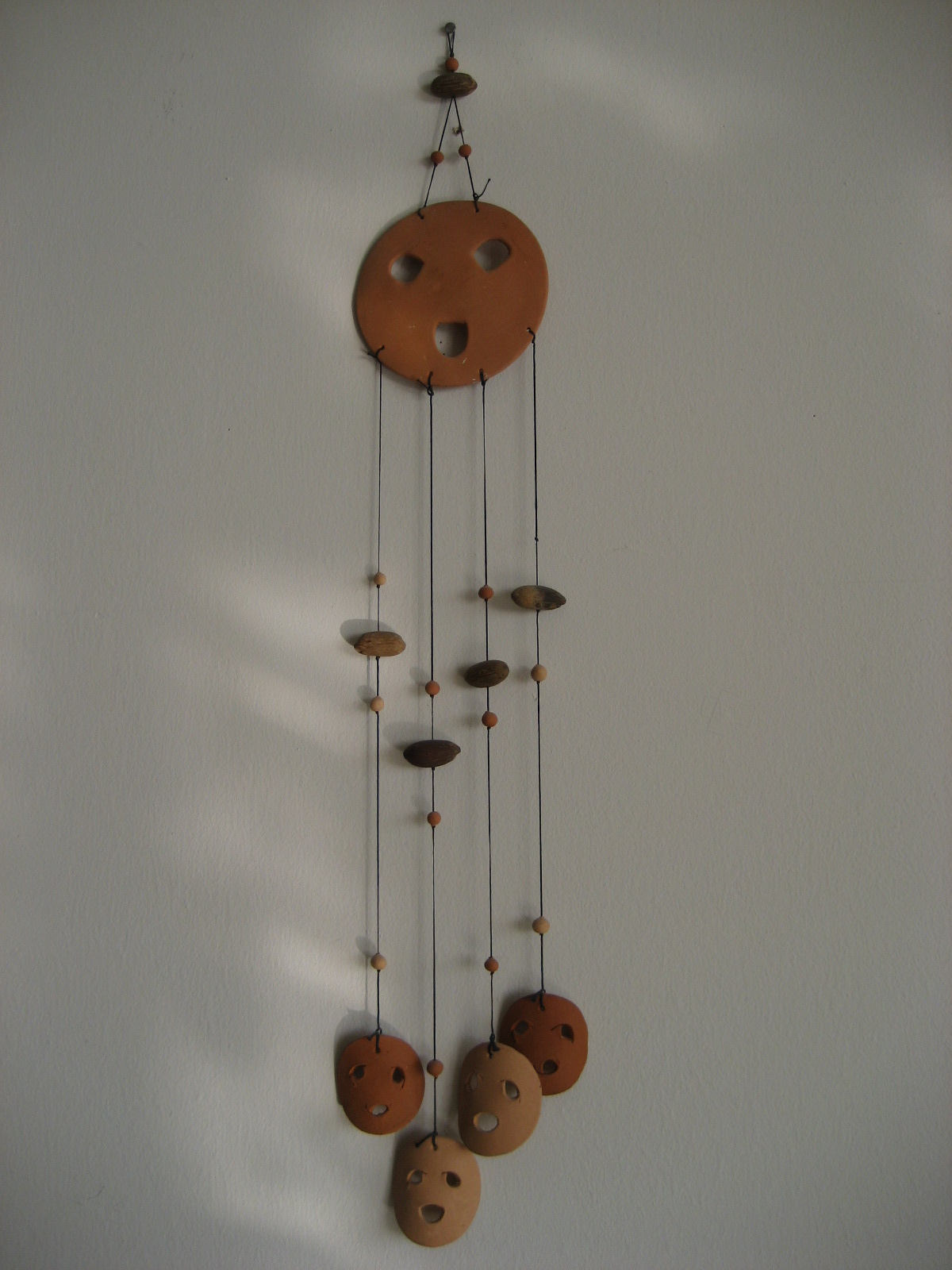

The ceramic wind
chime above and on the left is from COSTA RICA has one large mask, 5 ½ in. tall, and four smaller
ones, 2 ½ in. tall each, 1980s. The one on the right is
The next 6 wood sculptures are from HAITI made in the 1970s. The
first one is 36 in. tall. The second is 42 in. tall. The third is 30 in.
tall. The fourth is 14 in. tall.
The fifth sculpture is 12 ½ in. tall. Lastly, the sixth
sculpture is 20 in. tall.
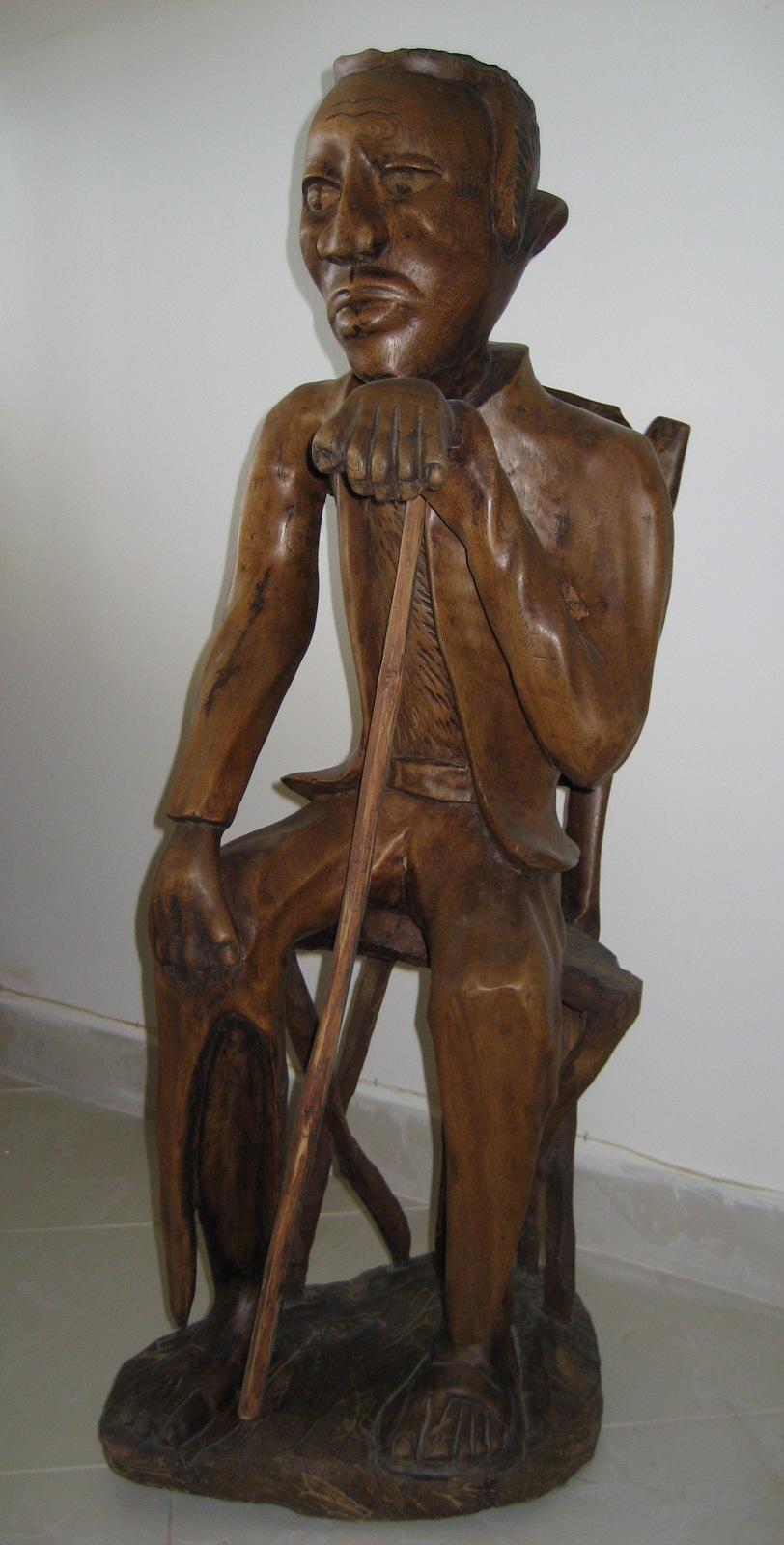
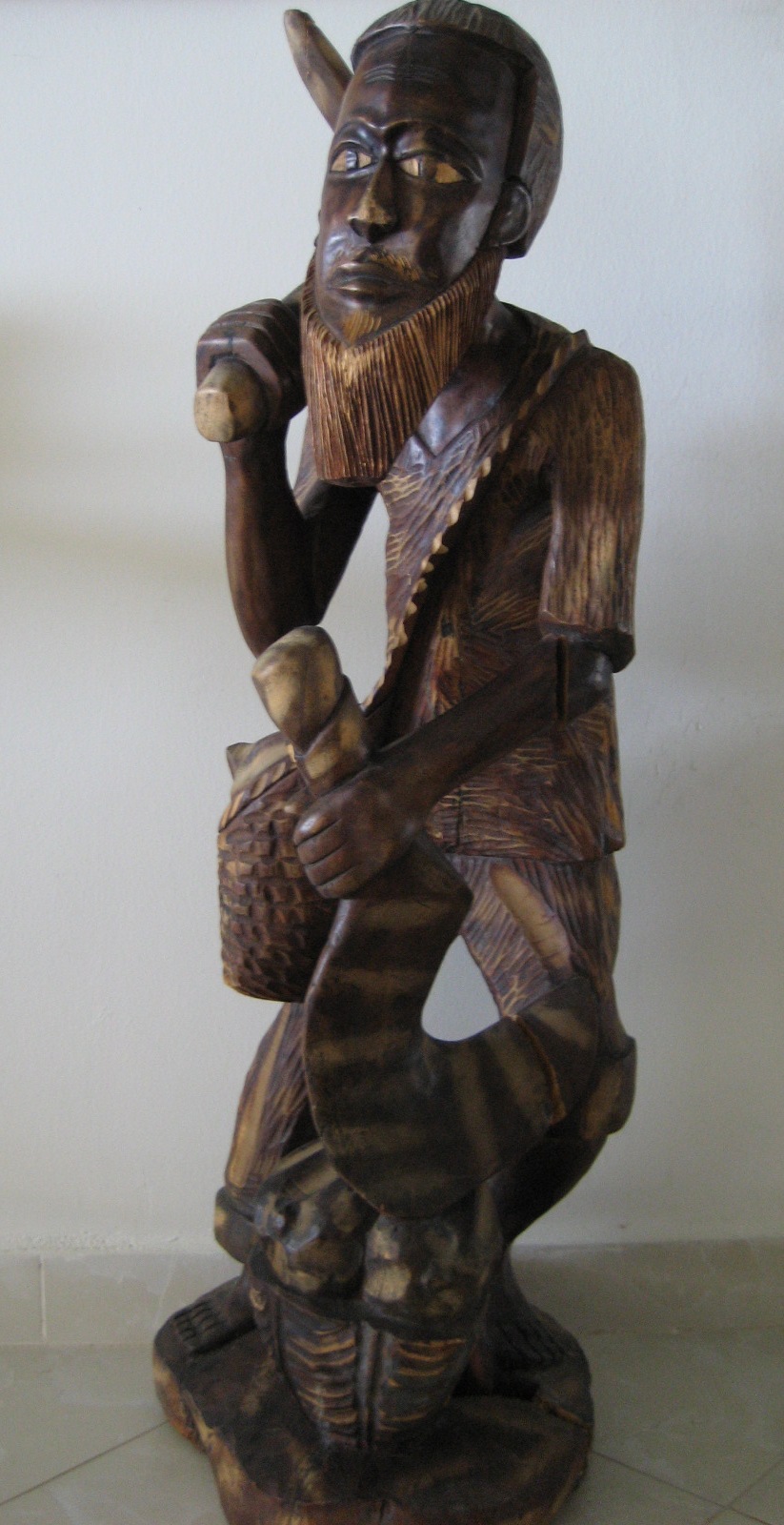
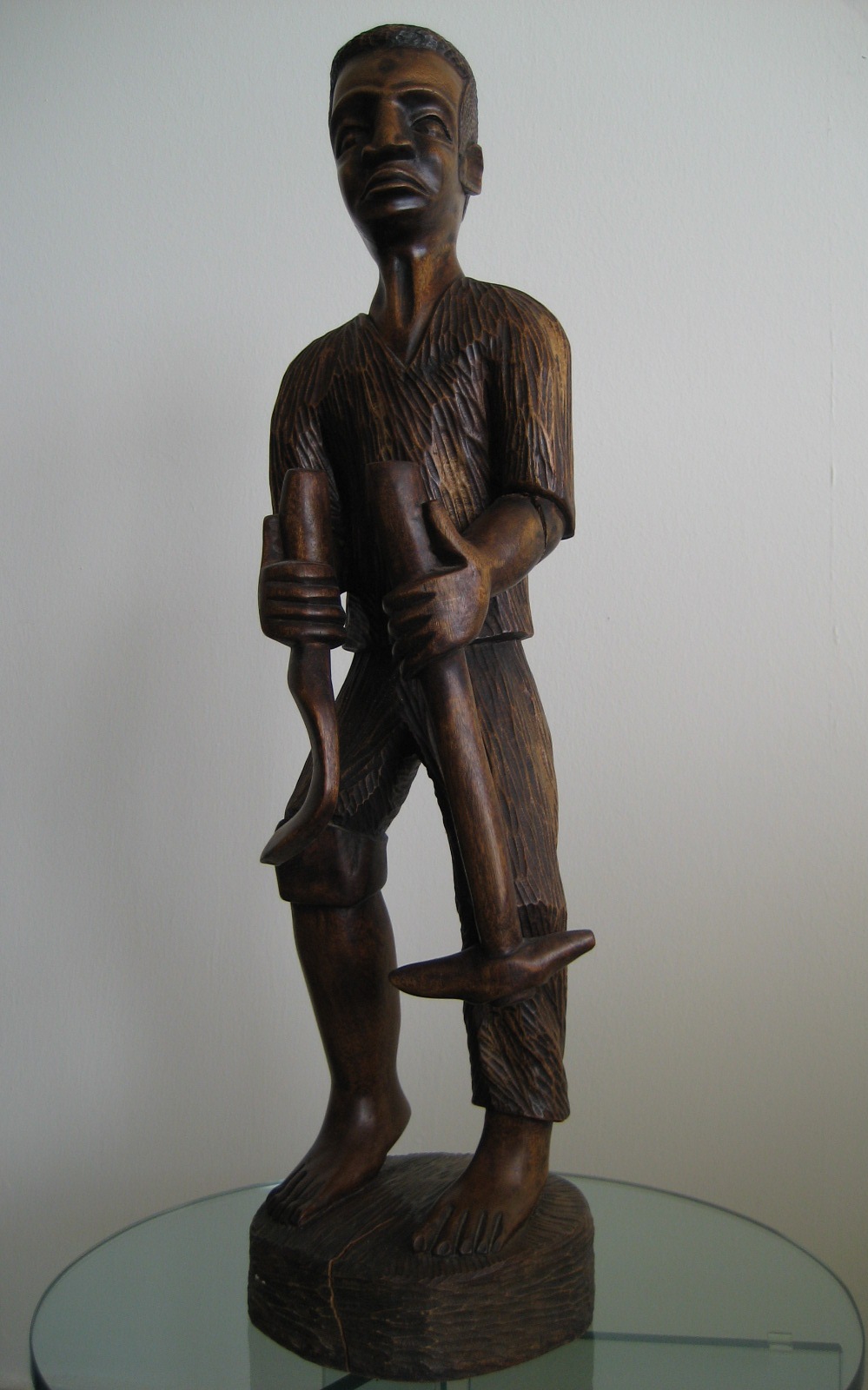
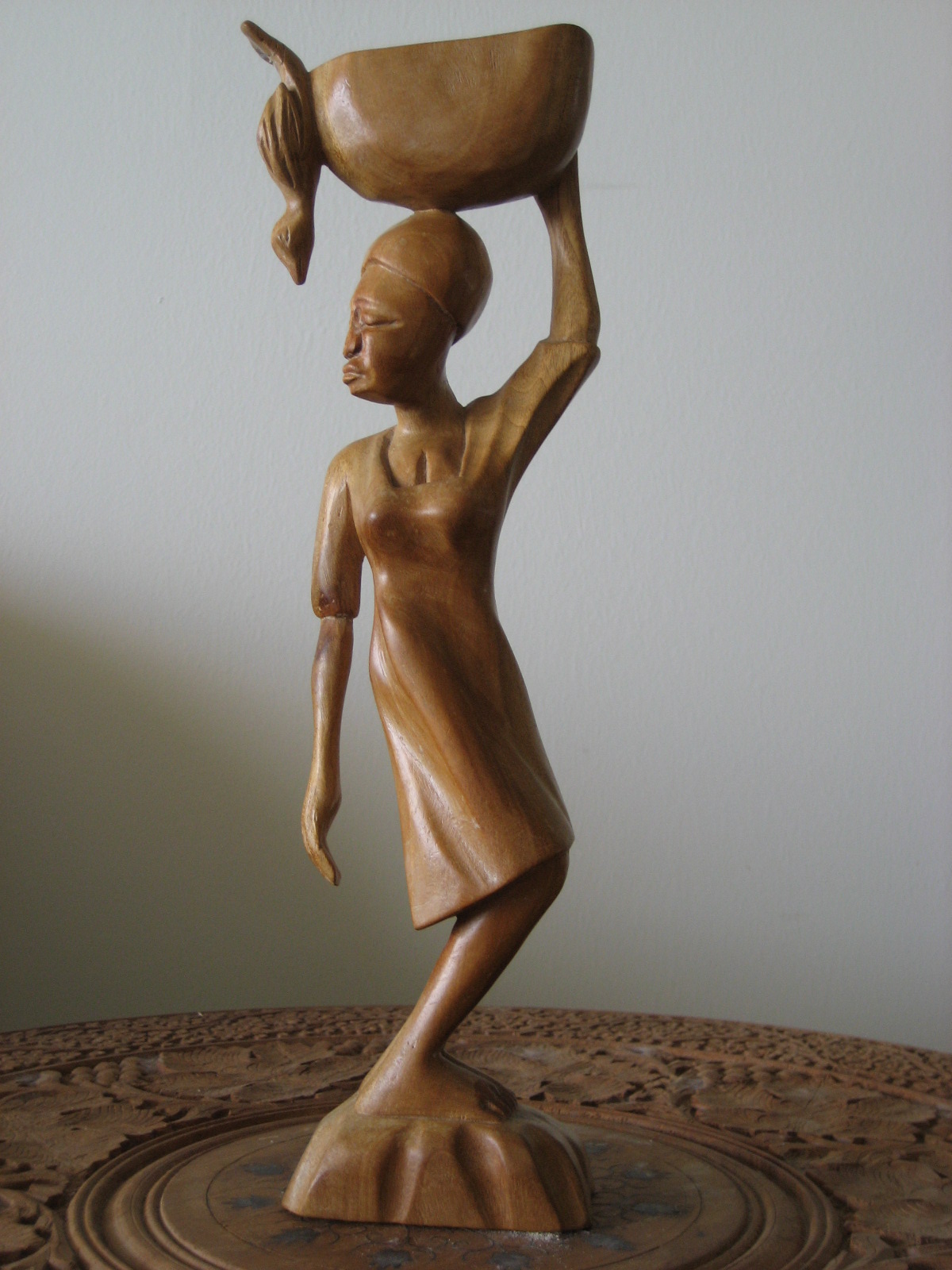
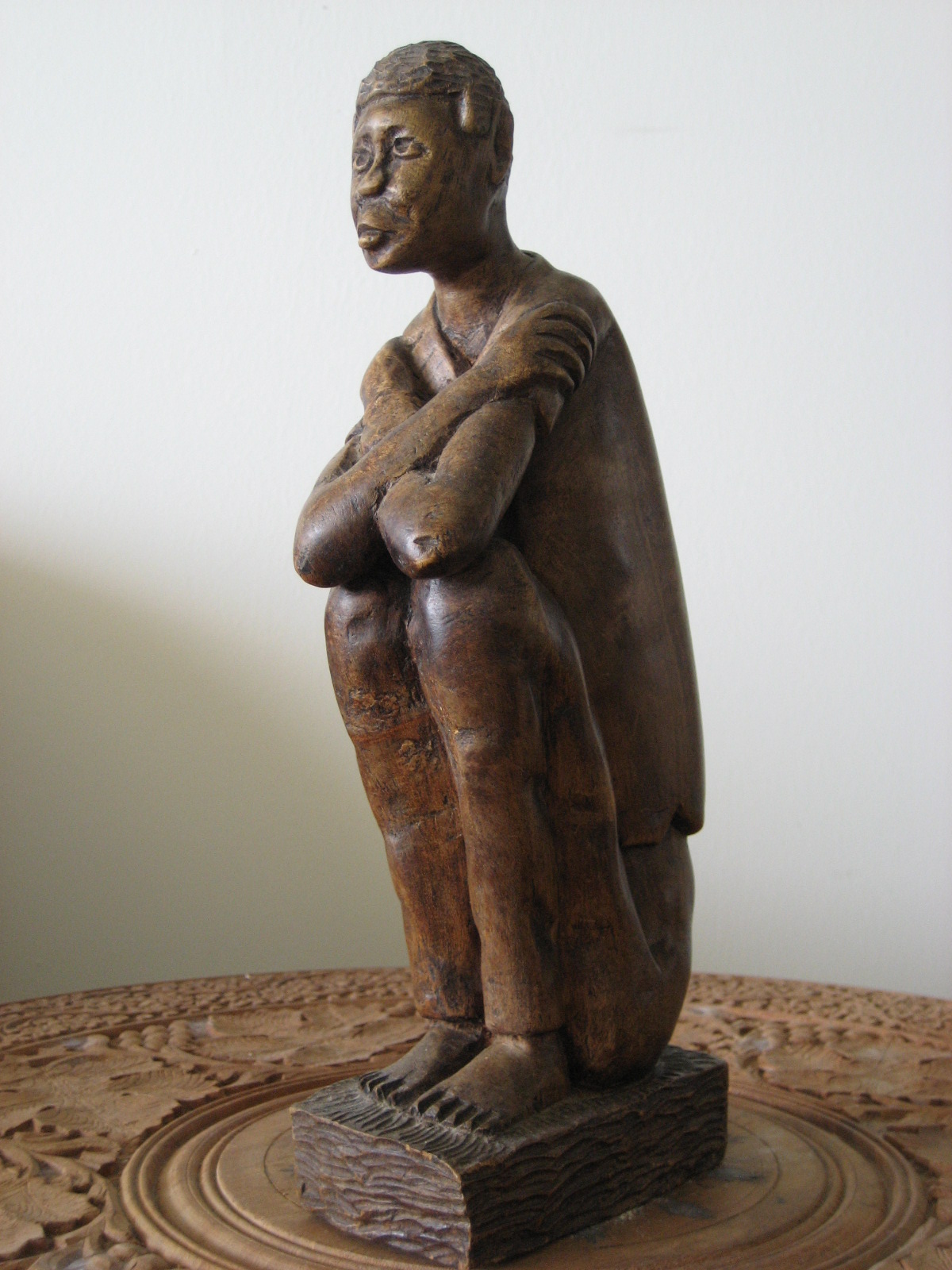
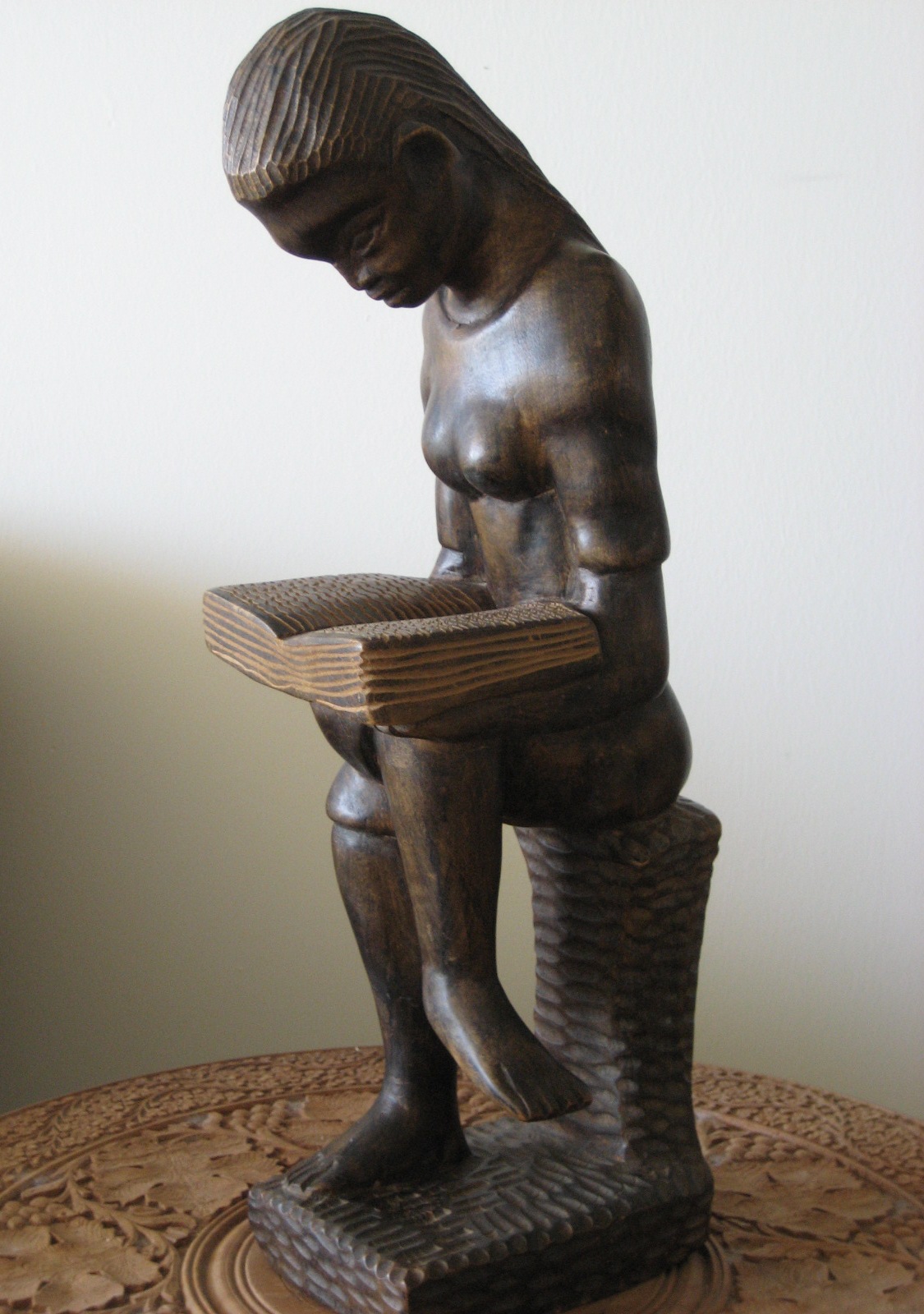
The following wood table with carvings
on top is from HAITI. It has a glass top and is 25 in.
by 45 in., 1970s.
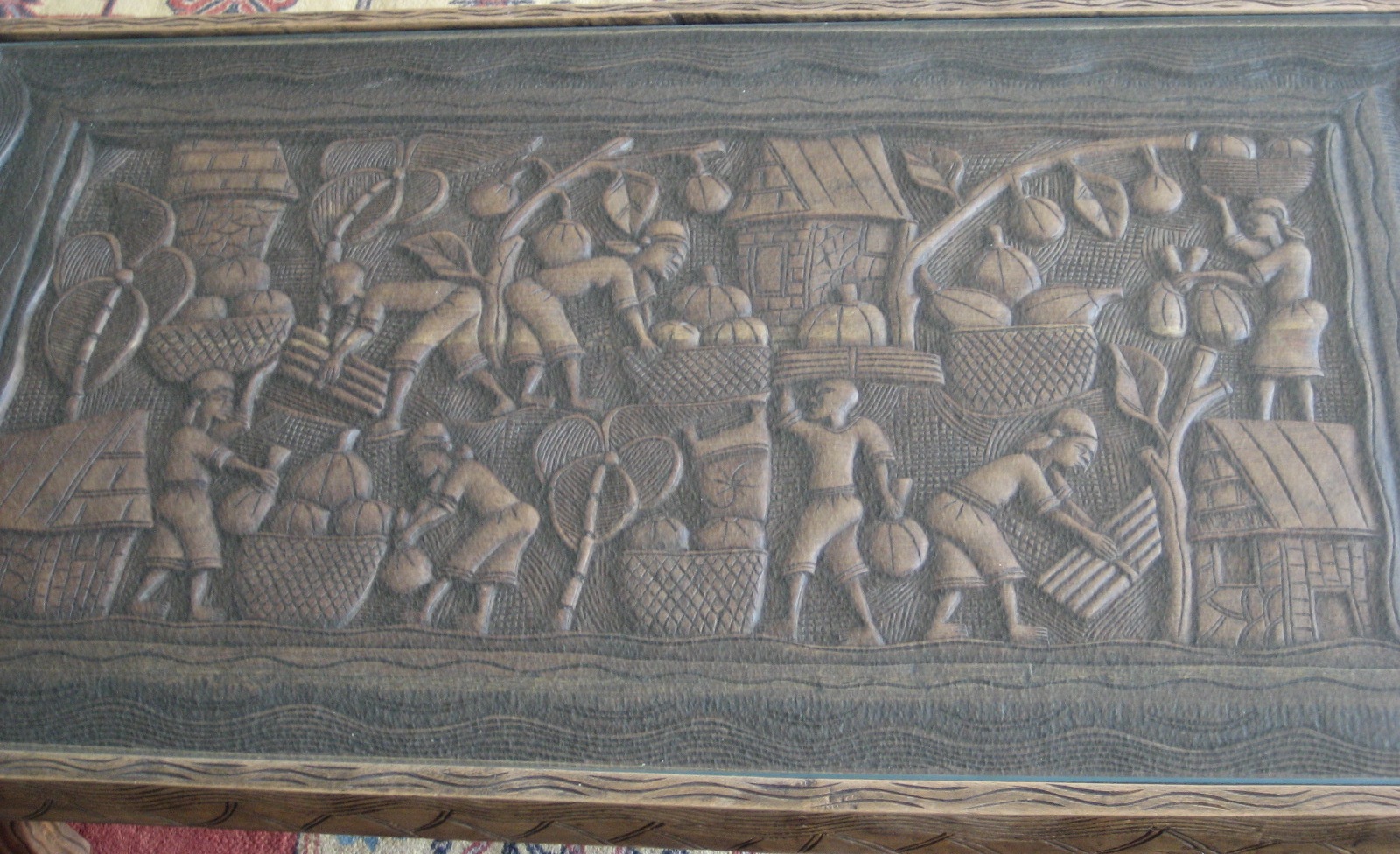
The following 3 wood carvings are from
HAITI in the 1970s. The first one is 17 in. tall.
The second is 24 in. tall. The third 25 in. tall.

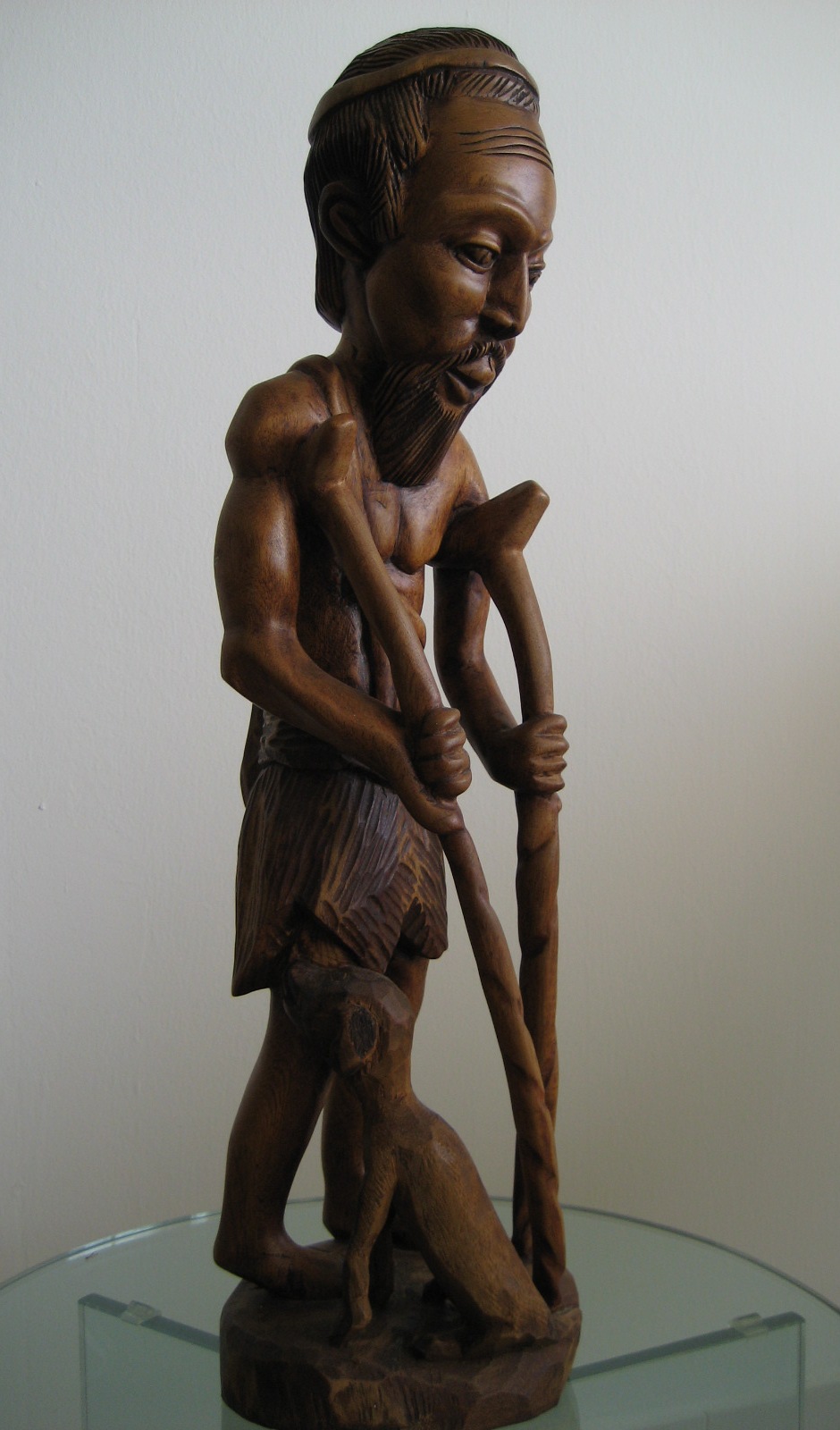
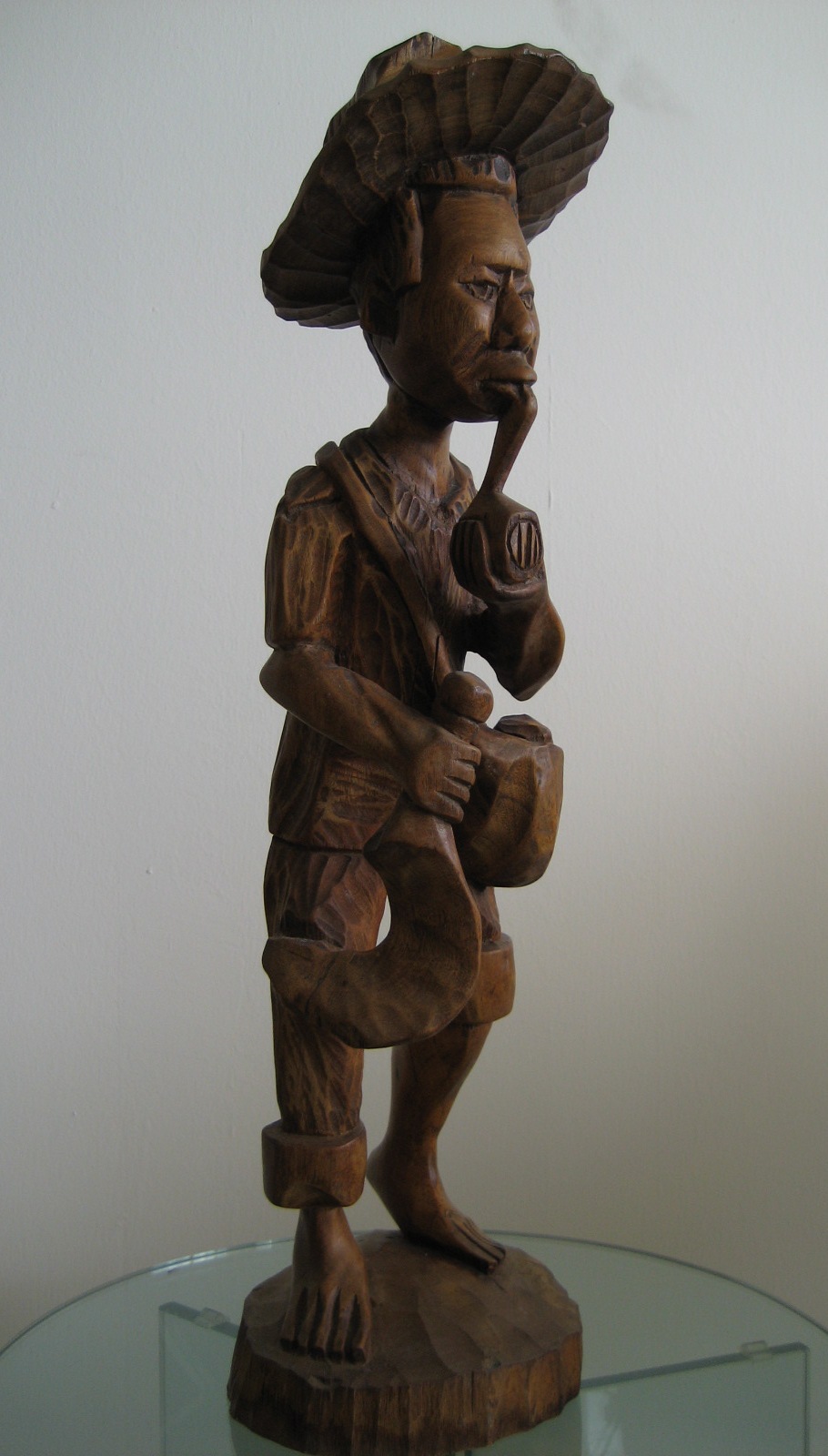
The following is a typical collection
of 7 dolls (inserted into each other) from RUSSIA. I bought the set in
St. Petersburg in 2003. The bigger one is 9 ½ in. tall and the smallest
one is 1 ½ in. tall.

From the following 3 items, the first is a wood sculpture from
GUINEA-BISSAU, 32 in. tall, 1980s.
The second is a soap stone
carving from Haiti. It is only 22 in. tall but it weights 36 pounds,
1970s. The last is a replica of Degas’
ballet dancer, 13 in. tall, 1970s.
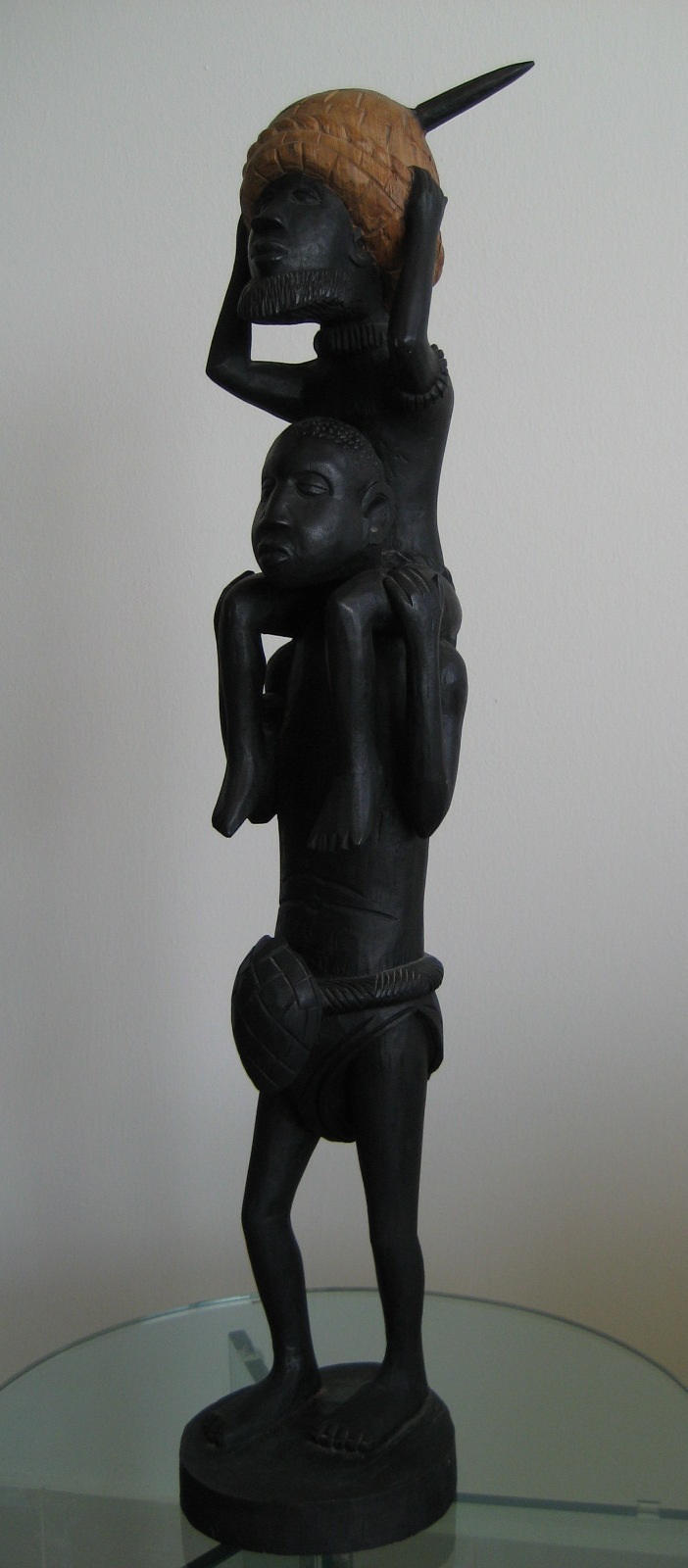
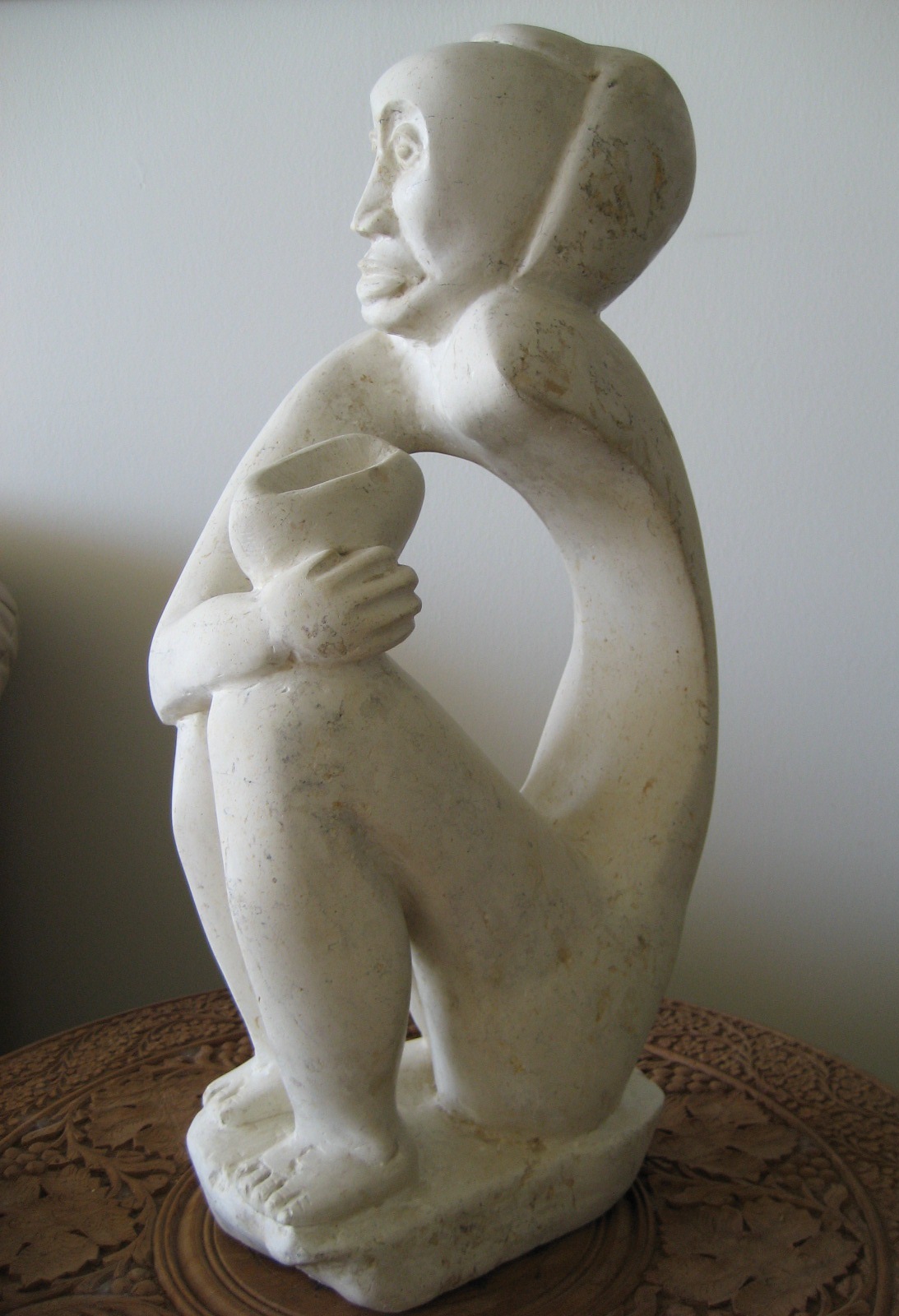
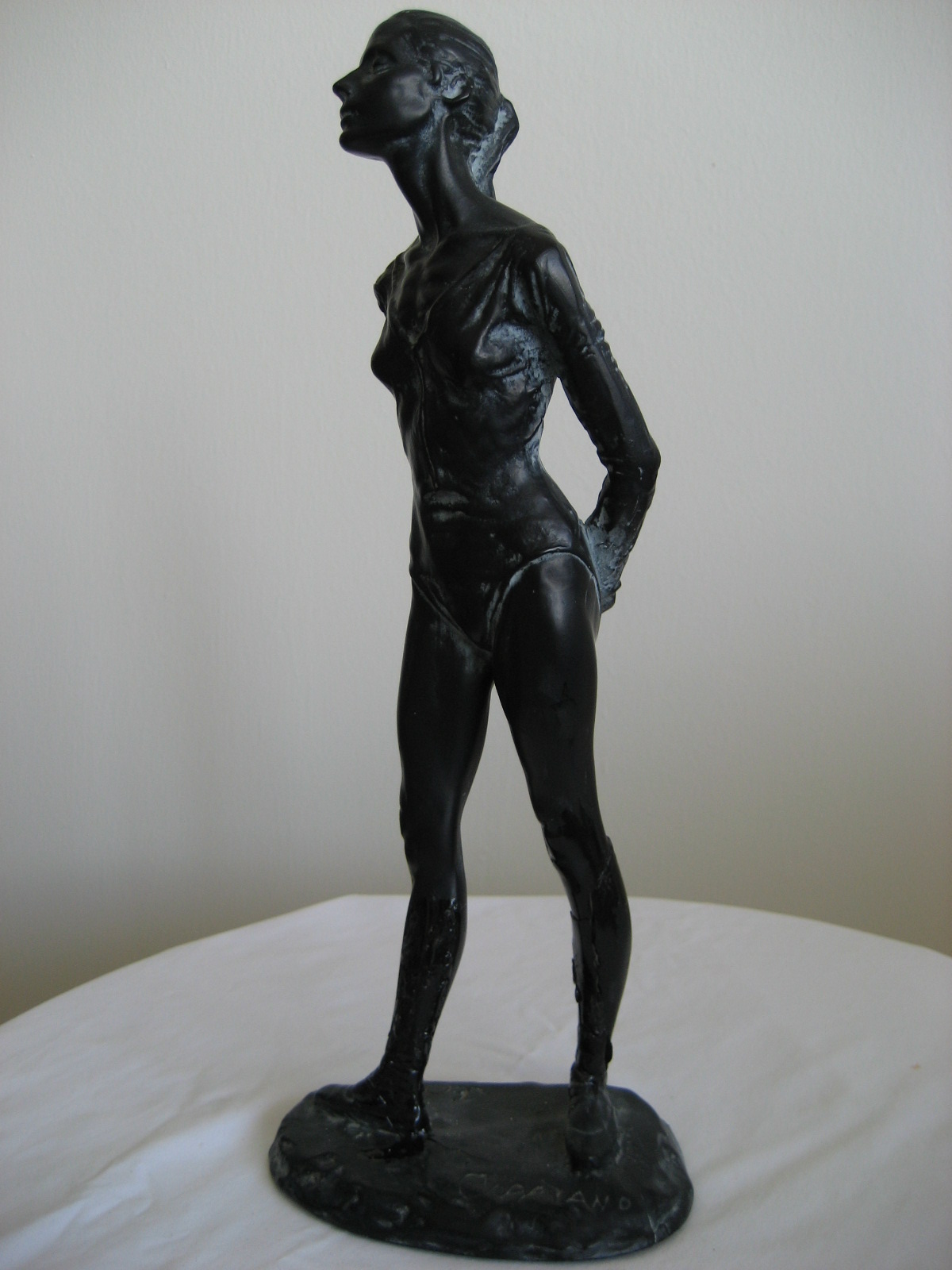
The following two items are replicas
of a Beethoven bust, 15 in. tall and a replica of Rodin’s
“The Thinker,” 12 in. tall, respectively. Both were made in the 1960s.
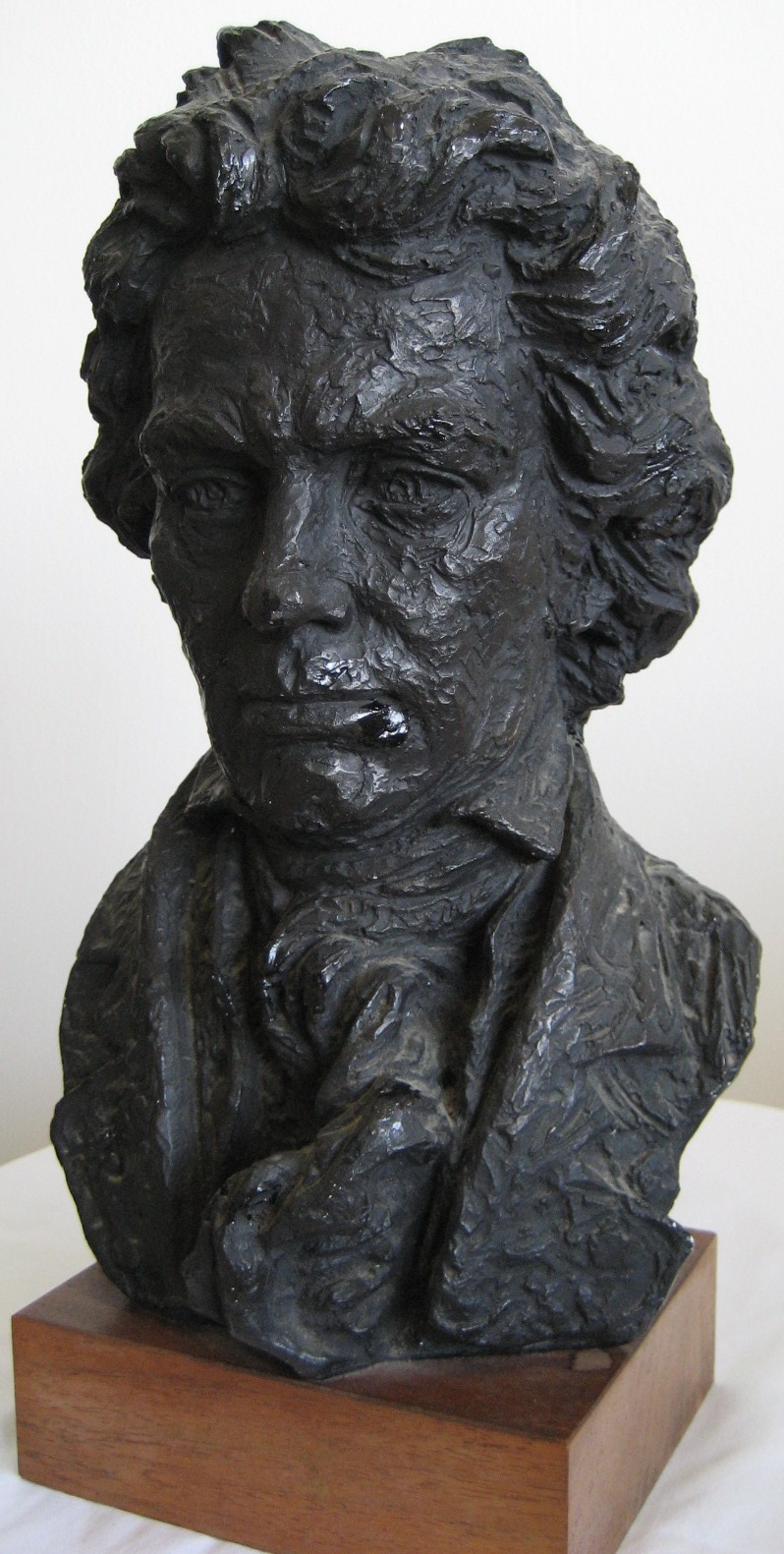
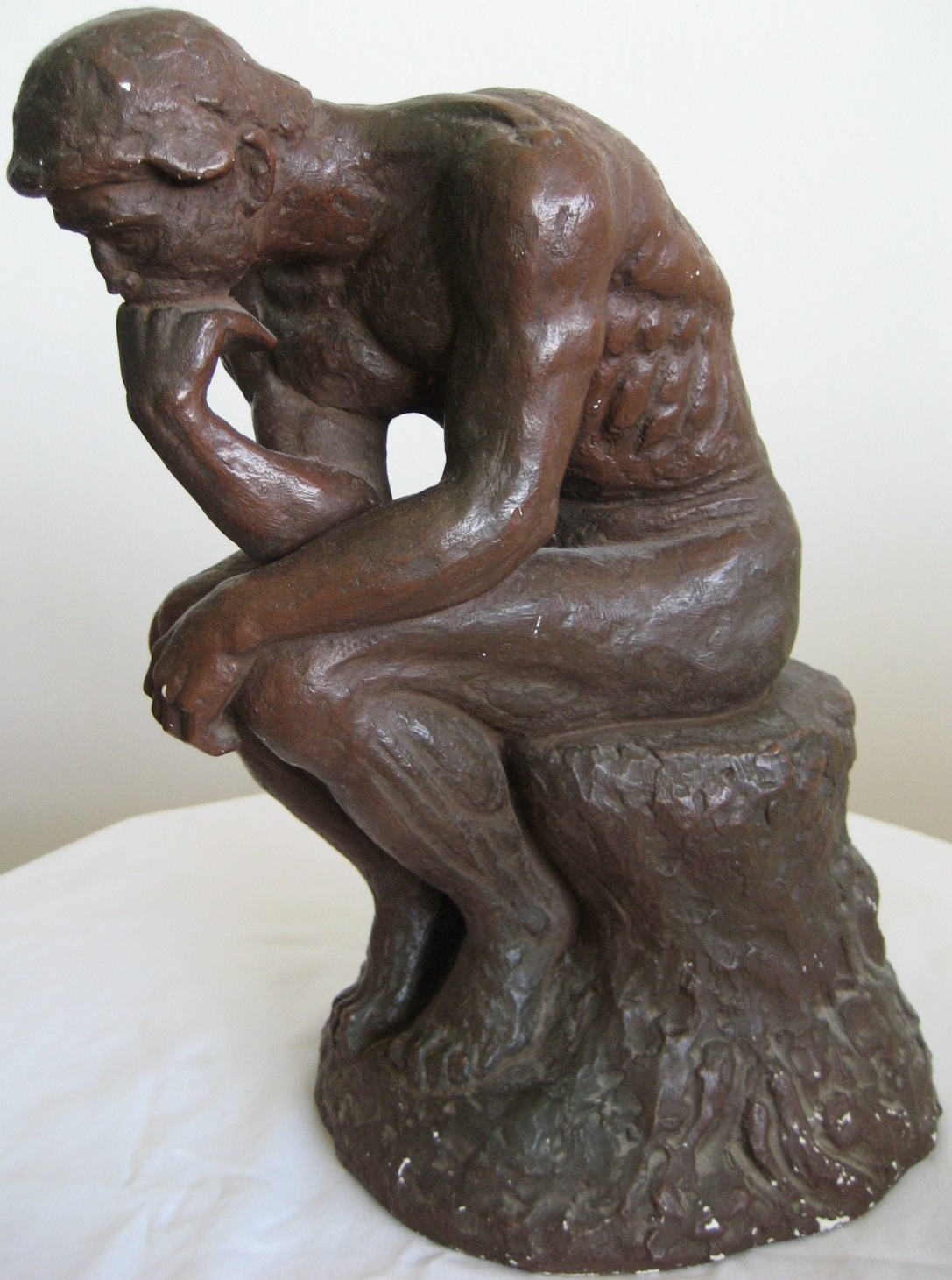
In the following
picture, there are two encrusted jewelry boxes from EGYPT. The large one
is 7 ½ in. by 11 in. The small one
is 4 ½ in. by 6 ¼ in., 1980s.
